

Cheapest Backpacking Destinations – Updated for 2023

It’s time to dust off your backpack and think about where to go next. If you’re on a budget, you may be wondering about the cheapest backpacking destinations in the world. The thing is, e specially if you’ve been aching to get back out there, ‘budget travel’ can be a bit of an oxymoron. People go traveling to see something new, and once you’re on the road, the last thing you want to do is restrict yourself.
The way to travel on a budget without feeling too limited is to go backpacking destinations where food, accommodation, and transport are cheap. This will allow you to stretch your budget and splurge on the occasional special activity to get the most out of your trip. The good news is, after you figure out a cheap way to get to your destination , it is possible to travel around some of the most beautiful destinations on earth for less than $20 a day. Believe it or not, it can sometimes be cheaper to be on the road than to stay at home considering your normal rent and daily expenses!
So without further ado, here is our updated list of the cheapest backpacking destinations for 2023.
Bulgaria – The best Eastern European country for budget travel
Even though Bulgaria is the cheapest backpacking country to visit in Eastern Europe, it has an abundance of gorgeous landscapes that rival its neighbors. During our 5 days in Bulgaria were able to see Alpine mountains, forested countryside, sandy beaches on the Black Sea, plus beautiful cities like Sofia and Veliko Tărnovo.
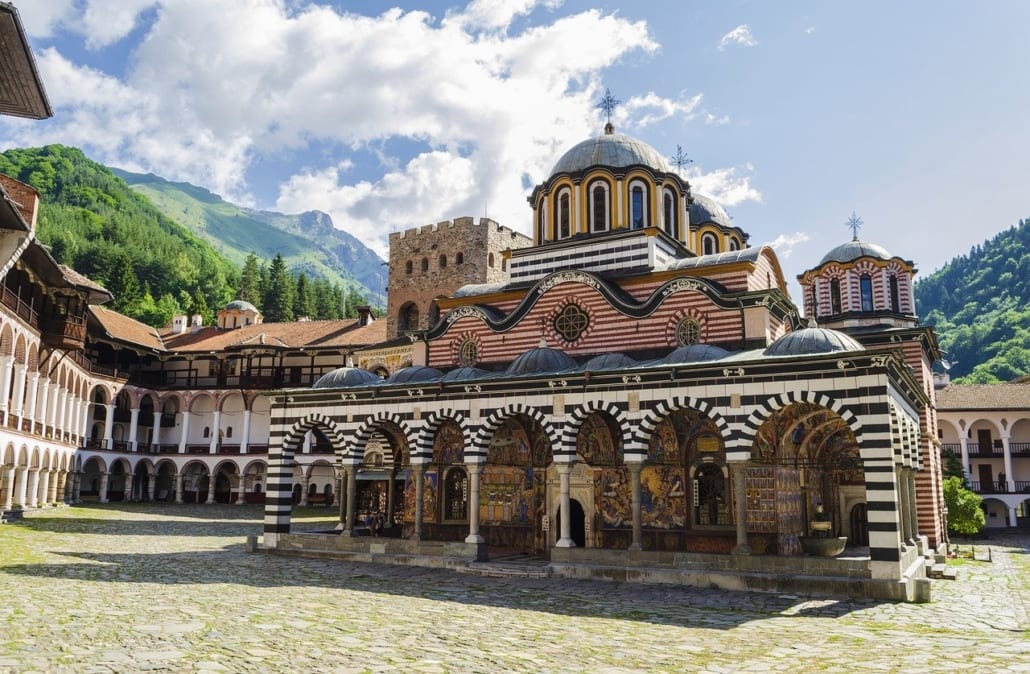
The Rila Monastery near Sofia, Bulgaria
Because we were traveling in the off-season, we were able to splurge on the occasional high-end luxury accommodation for less than $100 a night. Of course, you can always find cheaper hostels in Bulgaria . Food and drink are also super affordable, with the average price of a beer being about a dollar.
Learn more: Backpacking in Bulgaria
India is one of those countries where budget travel is almost entirely dependent on your willingness to haggle. If you strike the right tone, India can be one of the cheapest backpacking destinations in the world.
When booking guesthouses, you’ll most certainly get a better price by booking directly with the guest house versus booking online through an agency. Transportation-wise, it is super cheap to get around in India. In the big cities, we recommend using Uber — it’s actually much cheaper than the prices you’ll be quoted for a tuk-tuk ride. For intercity travel, trains cost between $8 – $30, and you can even find flights within that price range!
Learn more: Backpacking in India
Portugal – The cheapest backpacking destination in Western Europe
Portugal is a great option in Western Europe for travelers on a budget. You’ll be able to experience the vibrant European culture as well as world-famous food and wine at a fraction of the cost of what you’d pay in France or Spain.
Learn more: Backpacking in Portugal
Cambodia has so much to offer , and you can travel there for about $20 a day. Private rooms in a nice guesthouse will cost you about $10, and tuk-tuk rides are a savvy way to get around. Our guest house helped us arrange a private tuk-tuk driver to help us visit the many temples of Angkor Wat for just $12! You can even get a 30-day SIM card with 1.5 GB of data for $2.

Ta Prohm Temple in the Angkor Wat Temple Complex
Learn more: Backpacking in Cambodia
With medieval fortresses, majestic mountains, and friendly locals, the country of Georgia should be much higher on the list of top backpacking destinations. And with delicious meals starting at $3, and $1 local buses, it’s one of the best countries for budget travel. You don’t have to withhold on the cultural activities here, since most entrance tickets cost around $2.
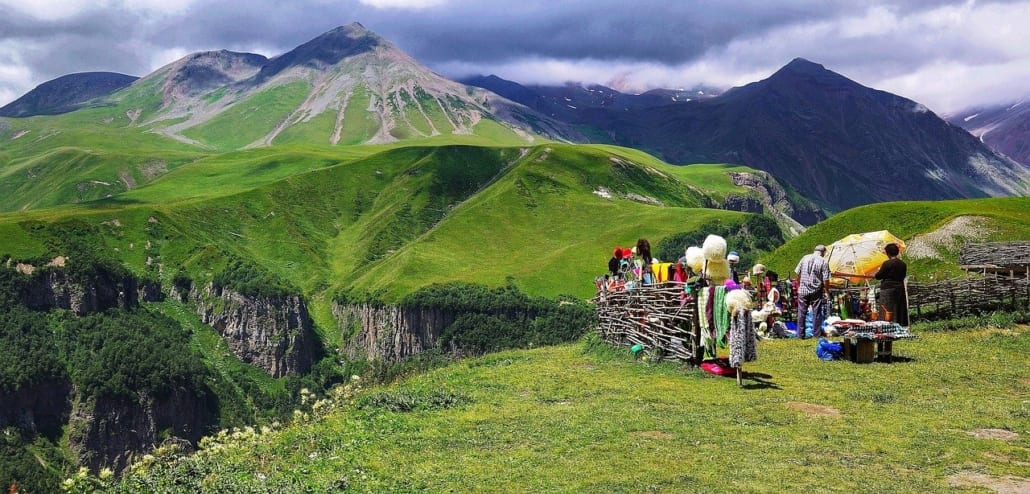
The Caucasus Mountains in Georgia
Learn more: Backpacking in Georgia
In the Czechia, the old trope ‘beer is cheaper than water’ is actually true. While Czechia boasts much of the same beauty as its neighbors like Germany and Austria, it’s possible to travel here at a fraction of the cost.
Learn more: Backpacking in Czechia
Bolivia – the cheapest backpacking country in South America
Bolivia is one of the cheapest backpacking destinations in the world and is very popular with adventurers. Here, it is possible to get a 3-course meal for less than $2. Accommodation in a hostel dorm room costs between $8-$12 a night, and local and long-distance buses are a cheap way to get around. Even the most famous backpacker destination in Bolivia, the Uyuni Salt Flats , won’t break the bank, costing around $200 for 3 days, which is relatively cheap for this bucket-list destination!
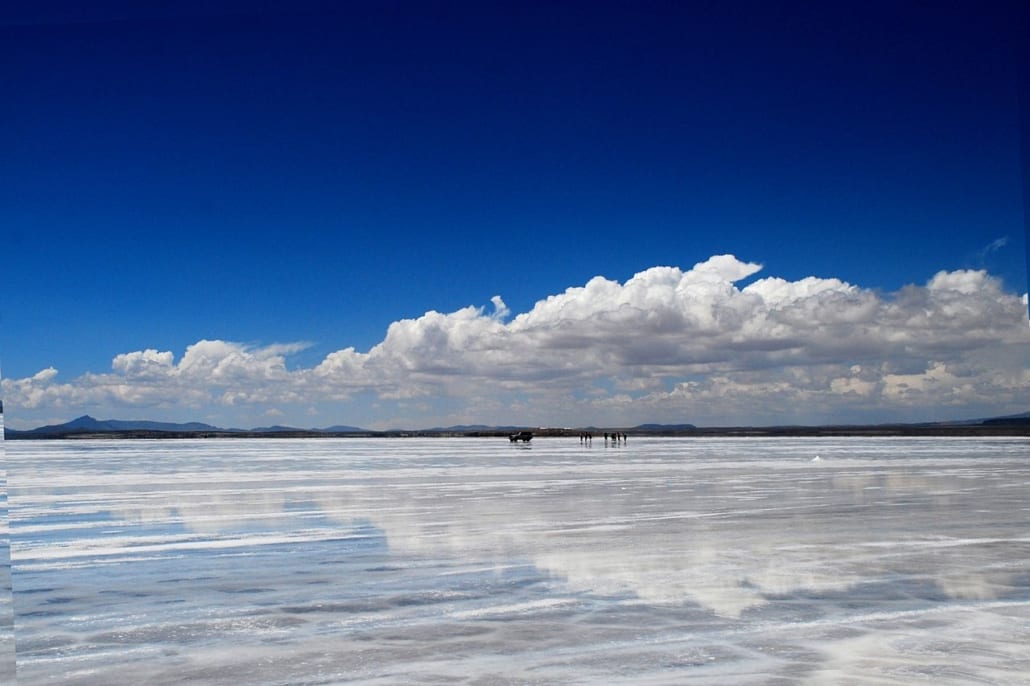
Salar de Uyuni Salt Flats in Bolivia
Learn more: Backpacking in Bolivia
Trekking in Nepal doesn’t have to cost as much as you might imagine. Other than the Everest Base Camp Trek (an exorbitant expense), there are plenty of beautiful Himalayan treks where it is possible to go by yourself. The Short Annapurna Circuit, for example, is well-marked with guesthouses along the path for about $5 a night, so you won’t have to carry tons of gear. (If you want to go all the way to Annapurna Base Camp, you’ll need to go with a guide ). Food and drink in Nepal are also very affordable, with meals costing between $2-$3.
Learn more: Backpacking in Nepal
Sri Lanka is certainly one of those countries where you can travel on a budget or live in the lap of luxury for relatively affordable prices. Their infamous train system (a bucket-list item in itself) is the cheapest way to get around the country. Or, you could hire a private taxi to travel between cities with a few other people from your hostel . Keep a special travel budget set aside for entrance fees to nature reserves and UNESCO Heritage sites!
Learn more: Backpacking in Sri Lanka
Colombia is one of our favorite backpacking destinations because of the friendly locals, diverse landscapes, and of course, affordability. You could easily backpack in Colombia for a month with just $1000 in your bank account. By taking long-distance buses, staying in hostel dorm rooms, and cooking your own food in the hostel kitchens, you can visit destinations like Medellín, Cartagena, and Salento on a budget.
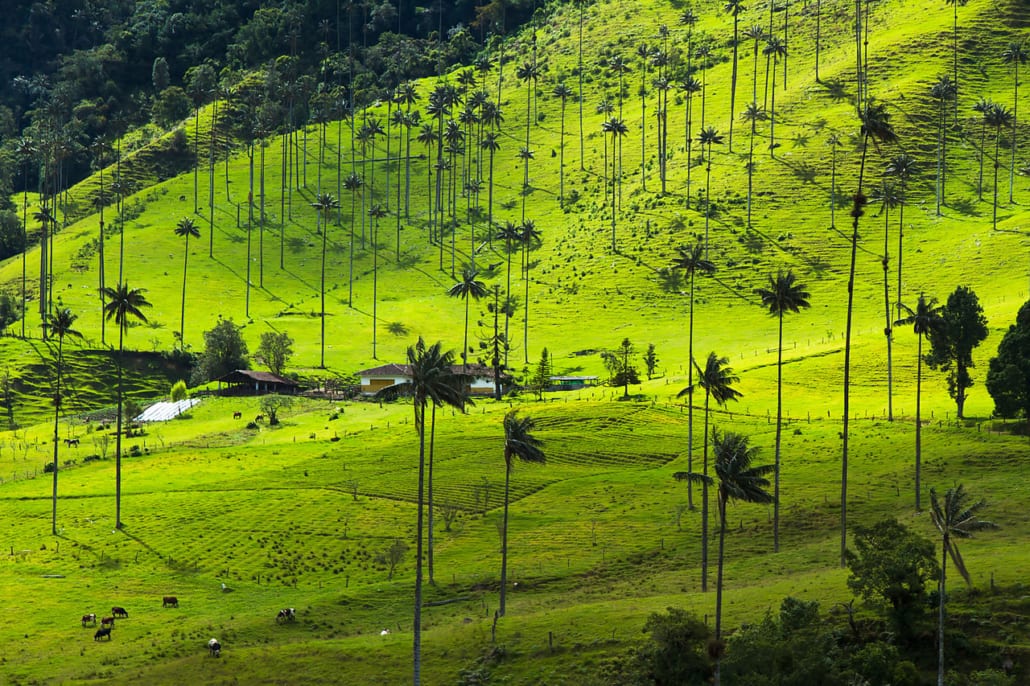
The Cocora Valley near Salento, Colombia
Learn more: Backpacking in Colombia
Honorable Mention
This country certainly doesn’t scream ‘budget travel’ but it’s the cheapest destination in Scandinavia. If visiting this part of the world has been a dream of yours, we can definitely recommend Denmark in comparison with its more expensive Scandinavian neighbors Norway, Sweden, or Finland.
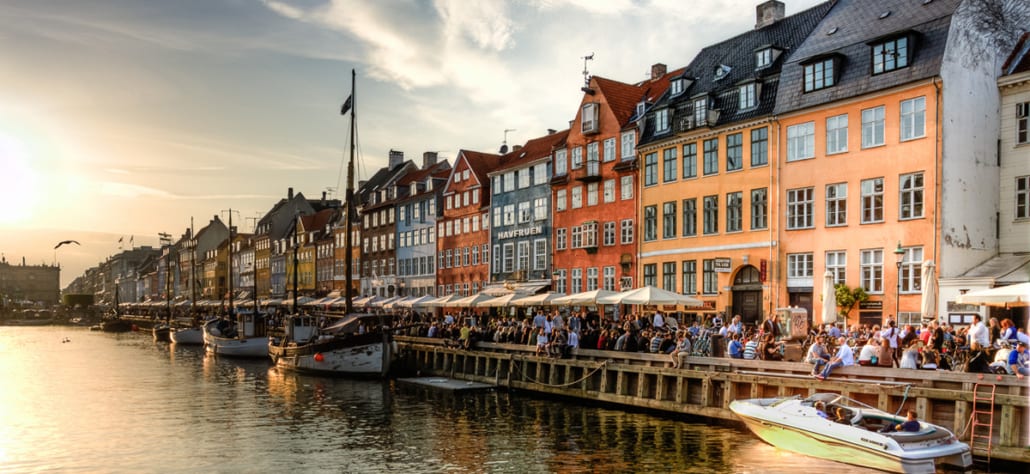
Nyhavn Canal in Copenhagen, Denmark
Learn more: Backpacking in Denmark
About the author
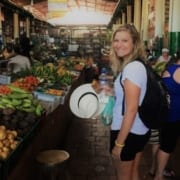
Monica Woerner
Monica is an avid traveler and backpacker who seeks to inspire others to embark on great adventures off the beaten path. Originally from California, she has travelled to over 60 countries, most of which she explored while backpacking or camping.
- 3 Days in Berlin - an Insider's Guide to See It All
- How to Travel the USA by RV - Expert Tips & Itineraries
- Backpacking in India - Our 2 Week Route
- My Field-Tested Packing List for a Safari in Tanzania
You might also like
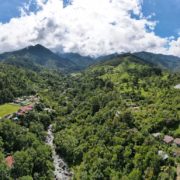
Eurolines can be an awesome way to go, for a few Euros we went from Riga to Vilnius in the luxury back part, spacious, free wifi and a breakfast box! And they run on time
Leave a Reply
Leave a reply cancel reply.
Your email address will not be published. Required fields are marked *


Backpacking on a Budget: Best Cheap Backpacking Gear of 2024
Looking for budget outdoor gear that won’t break the bank? Here is the best cheap backpacking gear plus top tips for buying quality, inexpensive gear.

When I first started Bearfoot Theory in 2014, backpacking was one of the ways that I became immersed in the outdoor world. Each backpacking trip I went on pushed me to grow beyond my comfort zone and I always came back with a greater perspective.
I believe that these experiences in the outdoors should be accessible to all people, regardless of who you are and where you come from. So over the years, I’ve asked many people about what obstacles stand in their way of getting outside more. A good majority of the answers I received revolved around one thing: money .
I get it, money is a real and necessary part of our society, but I don’t want it to stop you from exploring our public lands and beautiful places. While there are certain items necessary to stay safe and comfortable on a backpacking trip, it’s not always necessary to buy the newest, most high-tech outdoor gear on the market.
Below is my list of the best cheap backpacking gear to help you acquire the necessary gear you need to stay safe and feel comfortable without breaking the bank .
Budget Backpacking Essentials
Backpacking tent.
The REI Co-op Trailmade 2 is a great 2-person budget backpacking tent option that’s under $200. At 5lb 7 oz, it’s not as lightweight and full of features that more expensive backpacking tents have, but it has everything you need for several nights out on the trail. I love the mesh top, which provides great ventilation as well as stargazing on clear weather nights with the rain fly off.
This tent has two doors and two vestibules so you and your partner each have your own entry/exit and gear storage space. Plus it even comes with a footprint, which is an extra purchase for most tents. If you’re also in the market for a sleeping bag, you can buy a Trailmade Tent + Sleeping Bag bundle and save additional money.
Shop REI Co-op Trailmade 2 at:
See additional options: Best Backpacking Tents
Sleeping Bag
A 20-degree bag for under $100 is hard to beat which is why the Stoic Groundwork Sleeping Bag is our top pick for budget backpacking sleeping bags.
This mummy-shaped bag has a draft collar at the neck level to help keep warmth in on cold nights and its water-repellent shell sheds dew and moisture to keep you dry. It’s important to note that even though this bag is rated for 20 degrees, it’ll likely be too cold for temperatures under 30F (a 10 degree comfort difference is common for sleeping bags).
Shop Stoic Groundwork Sleeping Bag at:
See additional options: Best Backpacking Sleeping Bags
Backpacking Pack
The REI Co-op Trailmade 60 is a solid budget backpacking pack that offers a great combination of functionality, durability, and affordability. This pack has a streamlined design with plenty of pockets and compartments for storing all of your gear and includes a built-in rain cover, making it perfect for all-weather adventures.
It’s hard to find a backpacking pack with as many features as this one at such a reasonable price point. While it’s not the heaviest backpacking pack on the market, it’s not the lightest either, weighing 3 lb 4oz.
Shop REI Co-op Trailmade 60 at:
If you want a slightly lighter pack and don’t mind spending a little more money, the REI Co-op Flash 55 is another solid budget-friendly pack option that we see out on the trails often.
See additional options: Best Backpacking Backpacks For Women
Sleeping Pad
The NEMO Switchback Sleeping Pad is a classic favorite for many backpackers. It’s super lightweight and doubles as a seat or a yoga mat while you’re out in the backcountry.
This budget sleeping pad provides moderate insulation between you and the ground and the aluminized surface is designed to reflect your body heat back onto your sleeping bag to keep you warm.
For easy storage, just fold it up like an accordion and strap it to your pack. At less than 60 bucks, this closed-cell foam pad is ideal for any lightweight backpacker looking to save some money on cheap backpacking gear.
Shop NEMO Switchback Sleeping Pad at:
If you prefer something with a bit more cushion, the Therm-a-Rest Trail Scout sleeping pad is a comfy self-inflating budget choice. It’s lightweight and has a higher R-value than the foam pad above, so it will keep you toasty on cold nights.
Bearfoot Theory community member Mary Kathryn used this sleeping pad on all of her backpacking trips for many years and loved it. While it doesn’t compress as small as other pads on the market, it’s a solid option for an inexpensive and comfortable sleeping pad. It also comes in three lengths: regular, long, and short.
Shop Therm-a-Rest Trail Scout Sleeping Pad at:
See additional options: Best Sleeping Pads For Backpacking
Budget Kitchen Gear
Backpacking stove.
The Snow Peak GigaPower Stove isn’t the cheapest option out there, but it is the most reliable budget backpacking stove — and that is really important! A cheaper stove might save you money in the beginning, but you’ll pay for it over time with broken parts or by it failing in the backcountry.
At $50, the GigaPower stove is a personal favorite for a lot of backpackers because it’s lightweight, compact, and easy to use. In just 3 minutes your water will be boiled and ready to brew that morning cup of coffee or tea.
I recommend this lightweight, affordable backpacking stove for all your backcountry cooking. Plus, it fits in the palm of your hand so it’s the ultimate space saver, something that can’t always be said for most budget gear!
Shop SnowPeak GigaPower 2 at:

If the Snow Peak stove is out of the budget, the next-best option is the GSI Outdoors Glacier Camp Stove for $30. It’s designed for fast cooking and can hold a pot up to 5 inches in diameter, although it gets mixed reviews on the longevity of the product.
See additional options: Best Backpacking Stoves
Cooking Pot
The TOAKS Titanium 750ml Pot is an ideal choice for backpacking due to its ultralight weight, durability, and efficiency. Despite its durable construction, it’s still a budget-friendly choice under $30, perfect for those looking to save money without compromising on quality.
Shop TOAKS Titanium Pot at:
Water Filter
The Sawyer Mini Water Filter is hands-down the most affordable and efficient choice for around $25. Weighing in at just 2 ounces (yep, 2 ounces), it’s super compact and lightweight. This 0.1-micron filter removes 99.99% of all bacteria, including salmonella, cholera, and E.coli as well as 99.99% of all protozoa like Giardia and Cryptosporidium.
It comes with a 16 oz squeeze pouch to fill with water to filter, but many reviewers note the pouch is hard to fill up and breaks easily, so we recommend packing a plastic Smart waterbottle (which the filter thread attaches to).
Then just filter water right from the bottle into your hydration bladder or clean water bottle – it’s that easy. You can even attach the filter to your hydration bladder hose so you can sip away while you hike.
If you want something with a higher flow rate that can filter more water at once, the Sawyer Squeeze is another budget-conscious option.
Shop Sawyer Mini at:
See additional options: Best Backpacking Water Filters And Purifiers
Eating Utinsel
The humangear GoBites Uno Spork is an excellent cheap backpacking utensil due to its lightweight and compact design, plus it comes in a ton of fun colors! With a spoon on one end and a fork on the other, you’re covered for all types of meals in the backcountry.
Additionally, the durable and BPA-free nylon material ensures that it can withstand the rigors of outdoor use and is easy to clean.
Shop humangear GoBites Uno Spork at:
Cheap Backpacking Clothing & Accessories
Trekking poles.
The Montem Ultra Strong trekking poles are well-made and built to withstand rugged adventures in the backcountry — plus they’re half of the cost of other trekking poles. With 99.9% 5-star reviews, you know these are legit.
I’m a big fan of trekking poles to maintain balance and protect my knees while hiking. It’s like having four legs on the ground instead of just two. So, your body weight gets dispersed more evenly across the four points of contact.
See additional options: Best Trekking Poles For Hiking & Backpacking
Hiking Boots
Ok, I’m not going to lie. These are not “budget” hiking shoes, but that’s because I don’t believe you should ever skimp on your hiking footwear. Investing in proper footwear is essential to prevent injuries and blisters on the trail and keep your feet happy.
If you have a pair of worn-in tennis shoes, that’ll get you by in a pinch, but I truly believe that investing in a good pair of hiking shoes is a worthwhile investment. My go-to hiking boot brand is Oboz, and I love the Oboz Sypes Hiking Boots. They’re extremely comfortable, require little break-in time, and will hold up for hundreds of miles.
Shop Oboz Sypes hiking boots at:
See additional options: Best Women’s Hiking Boots & Shoes
Insulated Jacket
The REI Co-op 650 Down Jacket 2.0 is a great budget buy for backpacking due to its excellent warmth-to-weight ratio and affordable price point – you’d be hard-pressed to find another down jacket under $100 that feels this good! This is BFT team member Courtney’s jacket of choice and it’s super warm and comfortable.
The 650-fill-power down insulation provides ample warmth while still remaining lightweight and compressible, making it a space-saving option for backpackers.
Shop REI 650 Down Jacket 2.0 at:
Hiking T Shirt
The lightweight and breathable REI Co-op Sahara T Shirt is a hiking shirt that will last you season after season without breaking the bank. Made from a blend of polyester and spandex, this shirt is both moisture-wicking and quick-drying, making it perfect for hot and humid weather. It also comes in a ton of fun colors!
Shop REI Co-op Sahara T-Shirt at:
Hiking Shorts
BFT team member Courtney has been rocking the REI Co-op Trailmade Shorts this season and they’ve quickly become a favorite on and off the trail. Made with a blend of polyester and spandex, these shorts offer flexibility and comfort on the trail and have a comfortable elastic waistband with an elastic cord for fit adjustment. They also have ample pockets for storing small items like your phone, keys, and other essentials.
Shop REI Co-op Trailmade Shorts at:
Just because the sun goes down, doesn’t mean the night’s over: headlamps are essential for nighttime hangouts and that late-night bathroom run. The Petzl Tikkina Headlamp is an important addition to your backpacking gear collection and will only set you back $25. It delivers 250 lumens of brightness and has three white lighting settings: proximity, movement, and distance, and runs on AAA batteries.
The only thing I don’t love about this headlamp is that it’s not rechargeable (unless you use rechargeable AAA batteries).
Shop Petzl Tikkina at:
See additional options: Best Headlamps For Backpacking
Factors to Consider While Shopping for the Best Budget Backpacking Gear
Buying the best backpacking gear comes down to a few key factors: weight, comfort, durability, and price. Generally, the higher the quality, the lighter weight the gear will be. But, there are exceptions to this rule with a few reputable outdoor gear brands. As I said, I’m a believer that you don’t need the top shelf, most expensive gear, though there are some important things to keep in mind when you’re bargain shopping for affordable backpacking gear.
One common beginner backpacking mistake is overpacking and carrying a way-too-heavy pack. While this may not make much of a difference on a short walk to the campsite, it definitely makes a difference on a rigorous trail and in long-distance backpacking.
What’s in your pack and on your back can make or break your experience. The guideline for backpacking is that your total loaded pack weight should be no more than 20% of your body weight .
Regardless of how many nights you’ll be out, you’ll need to keep this in mind when it comes to what you pack. Shopping for lightweight backpacking gear is a wise thing to consider – your future self will thank you. For tips on how to shave off some weight, check out this blog post .
This one’s a no-brainer. You want to be comfortable even in uncomfortable moments, right? Buy gear and apparel that fits well and feels good not just while you’re trying it on in the store, but also when you’re hiking uphill or scrambling over a rocky section.
It’s smart to get fitted for items that you’ll be wearing on your body, like a backpack. Backpacks are not universal; each brand designs its packs differently, so what works for one person might not work for another person. Wearing a backpack that doesn’t fit properly can hinder your experience and performance on the trail. To prevent this, head to the nearest outdoor gear outfitter, like REI, and get fitted for a backpack so you know what brand and size works well for your body.
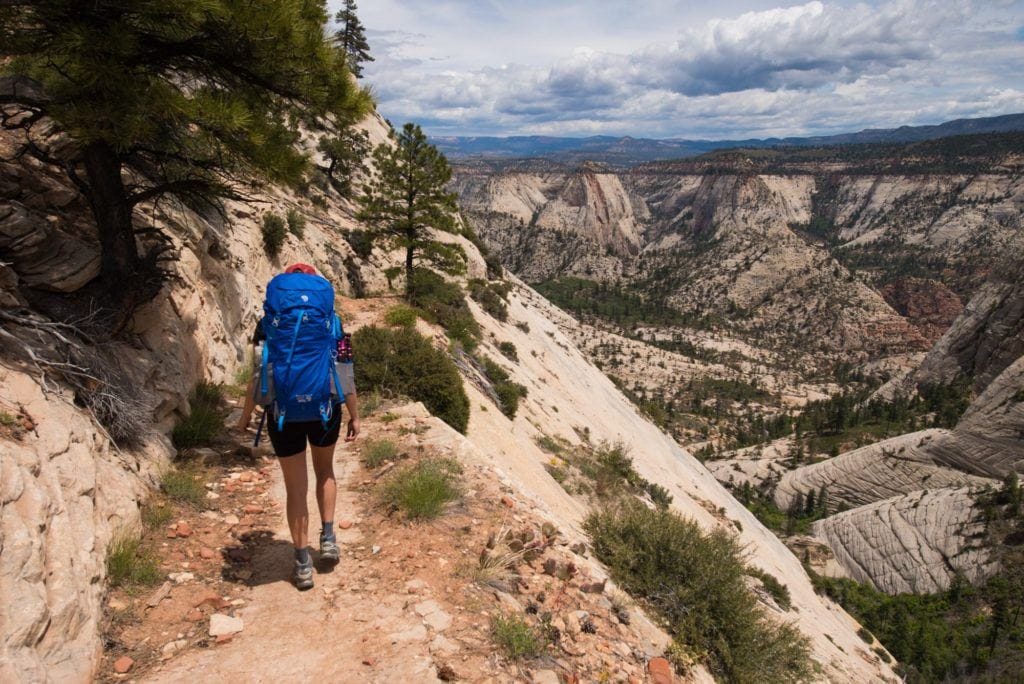
Whether you plan to do short backpacking trips or you’re a deep backcountry explorer, purchasing outdoor gear is an investment and you want it to last. It’s vital that your gear holds up to your needs on the trail, especially if you’ll be out in the backcountry. Plus, it’s more environmentally friendly to buy gear that will last for many years rather than purchasing new items year after year. Quality backpacking gear will ensure your adventures are a success, so look for quality-made products made with strong materials that can withstand wear and tear. Also, be sure to take proper care of the gear that you own to make it last as long as possible.
Check out our gear maintenance and cleaning tips to extend the life of your tent .
I’m sure you’ve seen backpacking gear within a wide range of prices, and you might be wondering if cheap price = cheap gear. Price matters, and if it didn’t you probably wouldn’t be reading this. But, that doesn’t mean that discounted or cheap backpacking gear is of poor quality. In other words, affordable backpacking gear doesn’t automatically mean low quality and high-cost gear doesn’t always equate to better quality. High-quality backpacking gear is more accessible than you might think.
First, I suggest you determine your budget for backpacking gear based on the basics you need to be safe, comfortable, hydrated, and warm. These are the basic essentials for the backcountry: a tent, sleeping bag, sleeping pad, stove, water filter, backpack, headlamp, and trekking poles (check out our complete 3-Day Backpacking Checklist for more). Eventually, you can integrate other items into your gear collection down the road. But for now, we’ll focus on the necessities that will get you where you want to go.
It’s important to note that buying new backpacking gear isn’t the only option. Buying used outdoor gear is a great way to save money on your backpacking setup, plus it’s more environmentally friendly. Nowadays, there are lots of great used gear shops that make sure products are still in good condition before they’re sold. Here are a few places that offer used outdoor gear:
- REI Used Gear Store
- Patagonia Worn Wear
- Outdoor Gear Exchange
Also, a lot of backpacking and camping gear often goes on sale. Figure out what items you need and which ones you’ve got your heart set on, then keep an eye out for sales so you can snag them when the time is right. You can save some major cash that way, especially on the bigger items like tents, sleeping pads, sleeping bags, and backpacks. Read our roundup of 17 Places to Buy Discounted Outdoor Gear for a complete list of places to search for discounted and used outdoor gear.
Another option is to rent backpacking gear from a local shop or REI. Renting backpacking gear is a smart move if you’re new to backpacking and aren’t sure you’re going to like it, or if you want to try out various items before making the investment.
With these recommendations for the best cheap backpacking gear, I hope you feel closer to hitting the trail on the backpacking trip of your dreams.
Looking for more backpacking advice and gear recommendations?
- 3-Day Backpacking Checklist
- Backpacking For Beginners: Wilderness 101 Tips
- Beginner Backpacking Mistakes to Avoid
- How To Pack A Backpacking Pack For A Multi-Day Hiking Trip
- Where To Find Discounted Outdoor Gear
Have you found any other good-quality, cheap backpacking gear that you’ve loved? What is your favorite budget backpacking gear item that you currently use? Share with us in the comments below!

With two decades of hiking and seven years of van life under her belt, Kristen has dedicated her life to helping people experience the positive effects of nature. As a pioneer in the outdoor blogging space, she founded Bearfoot Theory in 2014 and has since authored more than 350 blog posts about outdoor travel, hiking, camping, and van life. Her work has been featured in National Geographic, Outside Magazine, and Backpacker, and when she’s not on the road, she lives in Park City, Utah with her partner Ryan, their son, and two adventure pups.
Leave a Reply Cancel reply
Your email address will not be published. Required fields are marked *
Save my name, email, and website in this browser for the next time I comment.
Thanks – It’s been great to look through your lists, Love your work and guides!
Thanks Rahul! Glad you’ve found them helpful.
Great article. I found this much information, as to what I was looking for exactly. Thanks for such post and please keep it up. directions
You’re welcome. Thanks for reading!
I know I’m late to the party, but I’ve found Wal-Mart has headlamps for $1.00! They’re not very rugged, but they do the job!

Backpacking on a Budget: Top Tips and Debunked Myths
E ven within the outdoor community, backpacking is often characterized as a pursuit reserved for the privileged few. It’s easy to understand why — picturesque Instagram shots of colorful, top-of-the-line gear, stories of far-flung hiking destinations, and the illusion of endless time away from work all contribute to the perception that backpacking on a budget is challenging or impossible. In addition to affording that fancy DCF shelter and pack, affording the lost income can seem out of reach.
Am I guilty of spending far too much on a piece of gear I want but don’t need? Yeah, fine. You got me. However, I truly believe that backpacking can be accessible to anyone, regardless of their financial situation.
Throughout this article, we will delve into the world of budget-friendly backpacking, starting with debunking some myths about disposable income being a prerequisite for adventure and ending with some of my favorite budget-friendly backing gear.
READ NEXT —
- How to Afford a Thru-Hike
- How to Plan a Budget for Your Thru-Hike: A Step-by-Step Guide
- How to Hike The PCT on a Budget
Myth #1: You Need Expensive Gear
Let’s start by addressing one of the most persistent misconceptions: In order to be an accomplished backpacker, you need to have the latest and lightest gear.
While it’s true that high-quality gear can be costly, backpacking is about so much more than that. It’s about connecting with nature, testing your limits, and discovering the beauty of your own resilience . The fundamental essence of backpacking remains the same, regardless of your base weight and which brands you’re rocking.

Me on my very first backpacking trip. I had no trendy gear or fashionable clothes and had a wonderful time.
Here are two of my favorite ways to break down the cost barrier when it comes to gear:
1. Rent, Borrow, or Buy Used Gear
Instead of splurging on brand-new gear, consider renting, borrowing from friends, or buying used equipment. Many outdoor retailers offer rental services for essentials like backpacks and tents. You can also find economical options on online marketplaces and forums, like Facebook and Reddit, where seasoned backpackers often sell their gently used gear.
Finally, if you’re a student or live near a university, check and see if the school has an outdoor club. Some universities will allow you to rent gear from them, even if you are not a student or a member of the club itself.
Some Helpful Links:
- REI Rentals: REI Rental Gear: Tents, Bikes, SUPs & More
- REI Outlet/Sale: REI Outlet: Discount & Sale Outdoor Clothing & Gear
- Facebook Used Gear Group: Backpacking Gear Flea Market
- Facebook Marketplace: Facebook Marketplace
- Reddit Used Ultralight Gear Group: Ultralight Gear Trade
2. DIY Gear and Repairs
With proper care and maintenance, many backpacking items can last for years. The notion that gear must be constantly replaced can be a costly misconception. Regularly inspecting and maintaining your gear can extend its lifespan significantly. However, even with proper care, sometimes things just break.
Embrace the do-it-yourself spirit by creating your own gear or making simple repairs. YouTube and online forums are treasure troves of DIY backpacking hacks that can save you a significant amount of money.

While not the most complex DIY, I opted to cut my own groundsheet for my tent out of Tyvek instead of purchasing one. You can see it wrapped around my tent on the back of my pack. This saved me over $50!
Is it scary to take a pair of scissors to a piece of gear? Of course. Have I accidentally damaged something while trying to make a simple change? Absolutely. However, with a little patience and some trial and error, you’ll find that repairing your own gear not only saves you money in the long run, but teaches you a new skill every time.
And, in a pinch, there isn’t much that duct tape can’t make better.
- Learn to make your own gear: Ripstop By The Roll: Make Your Own Gear
- Make/Repair your own gear Reddit community: Make Your Own Gear
Myth #2: You Need to Travel to Find Good Backpacking
One of the largest expenses when it comes to backpacking can be wrapped up in the travel to where you’re going. However, I would argue that almost everyone has a place close to home to explore.
You don’t have to jet off to faraway destinations to experience the joy of backpacking. Start with local or regional trails, which require less travel and fewer expenses. Go with friends, if you can, to split any expenses like a rental car or gas. Find campsites that are free, and wilderness areas that don’t require a paid permit.
I know it can be hard to find people to go backpacking with if you are just breaking into the hobby yourself. Try searching for Facebook groups titled “’Your City’ Hiking Buddies” or “Women Who Hike ‘Your City’”. You may be surprised how many people you end up befriending!

When I lived in Chicago and didn’t have a car, I joined the ‘Chicago Backpacking Meet-Up’ Facebook group. Not only was I able to make friends, but I also got rides out to cool hikes!
- Find a backpacking trail near you: Outdoors Mobile Apps
- Find free campsites: iOverlander , The Dyrt
- Discover public land near you: BLM , U.S National Forest Service
Myth #3: You Need to Quit Your Job to Take Cool Trips
I don’t know about you, but it feels like every single person in my Instagram and TikTok feeds is taking months at a time away from work to thru-hike America’s longest trails. While that’s great for them, it sometimes gives the impression that you can’t break into backpacking if you have work or other obligations that take up a lot of your time.
The truth is, backpacking can be woven into the fabric of your life, even with a full-time job. Here are some practical tips to help you embrace backpacking without needing to drop everything:
Become a Weekend Warrior
Utilize vacation days, local trails.

This past year I was able to thru-hike the John Muir Trail by conserving my PTO days from work and utilizing Labor Day/weekends to get enough time off.
Remember, backpacking is about making the most of the opportunities available to you. It doesn’t require drastic lifestyle changes or long sabbaticals. You can immerse yourself in the backpacking experience while still managing your work and other responsibilities. The trails are there for you to explore at your own pace and on your own terms.
Budget-Friendly Gear Recommendations
I want to preface this section by saying that, if you have the power as a consumer to support local outfitters, please do so. A couple of dollars saved for you may not be a make-or-break situation like it could be for your local businesses.
However, backpacking should be accessible to people in all financial situations, so I will be sharing some of the most budget-friendly gear I can find from larger stores. Take stock of your own financial situation, and do what is needed within those constraints, but don’t forget about your local stores!
Durability disclaimer: While budget gear isn’t guaranteed to fall apart in a single weekend, durability is worth considering. There’s a lot of durable, cheap, quality gear out there, so look for the stuff that will last a while, especially if you’re planning a longer excursion. This will save you money in the long run, and keep a bunch of garbage out of the landfill.
Safety disclaimer: Also, don’t skimp on safety features, even if it means saving a few bucks. Be ruthless when sniffing out deals, but don’t leave safety out of the equation. Get stuff that works. Period.
While you do want your backpack to be comfortable and sturdy, this is a place where you don’t need to splurge on the top-of-the-line, lightest option. If it carries your gear from Point A to Point B, and doesn’t chafe you in the process, you’ve found a good backpack.
The first pack my partner ever took backpacking was a computer bag with things lashed to the outside with shoelaces. The dangling sleeping pad didn’t look pretty, but it worked. Would I recommend that for you? No. But, my point is that there is a lot of leeway with backpacks relative to other gear categories.

Could ‘gear tied to the outside of a laptop bag with shoelaces’ be the next big backpacking hack? (No. Don’t try this. It didn’t really work too well.)
Budget-Friendly Pack Recommendations:
- Forclaz Women’s MT100 Easyfit 50 L Backpacking Pack | Decathlon
- Scout 3400 | TETON Sports
- Budget Ultralight : G4-20 Ultralight Backpack | Gossamer Gear
I would recommend scooping up a backpack during a sale, at an REI Garage Sale, or used through a Facebook or Reddit group. Packs don’t need to be perfect, and are usually fully functional even with many miles on them.
I would argue that tent quality is slightly more essential than backpack quality, but you can still get away with quite a lot. For a backpacking tent, I would recommend trying to stay around six pounds or lighter. Any heavier, and you may find it hard to carry. That said, if you have a heavier tent and you want to give it a go, then please do and know that you are simply stronger than I am.
Budget-Friendly Tent Recommendations:
- Trail Hut 2 Tent with Footprint | REI Co-op
- Clostnaure Lightweight Tent | Clostnature
- Budget Ultralight : X-Mid 1 Ultralight Tent | Durston Gear

I believe the Durston Gear X-Mid 1 to be not only the best budget ultralight tent, but also one of the best ultralight tents out there, period.
Sleeping Pads
Now, we move into an essential and overlooked part of your sleep system. Maybe I’m just cranky when tired, but I tend to splurge a little more on anything that helps me get a good night’s sleep in the backcountry. However, there are plenty of warm, comfortable options out there that don’t break the bank.
If possible, try going to the store and lying down on a pad before buying it. Imagine replacing your bed with this pad because, essentially, that’s what you’re doing while sleeping outside. I would strongly recommend saving a little money in your backpack and tent selections and putting that towards a comfortable sleeping pad.
Budget-Friendly Sleeping Pad Recommendations:
- Klymit Static V2 Inflatable Sleeping Pad
- Big Agnes Air Core Ultra Sleeping Pad | REI Co-op
- Budget Ultralight : NEMO Switchback Sleeping Pad | REI Co-op

I use the NEMO Switchback when hiking out East, where it is typically a little warmer. In colder seasons, or on trips at higher elevations, I tend to lean towards an insulated inflatable sleeping pad.
Remember that a good night’s sleep is essential for an enjoyable backpacking trip, so invest in a sleeping pad that meets your comfort needs while still staying within your budget constraints.
Sleeping Bags
Just like your sleeping pad, your sleeping bag will have a major impact on your quality of sleep outside. Make sure you have a full understanding of your bag’s temperature rating, and if that rating is assigned for ‘comfort’, ‘limit’, or ‘survival’. Through trial and error (and several cold nights) I’ve found that I sleep rather cold. I will use a 20-degree bag year-round when I’m in the mountains, even if the forecasted low is a lot warmer.
When it comes to cost savings in a sleeping bag, consider using synthetic fill instead of down. These bags will typically be more affordable, while still offering excellent insulation.
Budget-Friendly Sleeping Bag Recommendations:
- Stoic 20F Synthetic Groundwork Sleeping Bag | Backcountry
- Kelty Cosmic 20 Degree Bag | REI Co-op
- Budget Ultralight: Economy Burrow quilt | Hammock Gear

Enjoying a backpacking trip in Colorado while staying warm in our Hammock Gear Quilts.
My best budget-friendly tip when it comes to clothes will disappoint those who get excited when buying new gear: just use what you already have! I know you have some moisture-wicking, athletic t-shirt in your closet from that one camp in high school. The same goes for any pair of quick-dry shorts. For layers to wear at night, I still just bring an old pair of sweatpants and a hoodie.
If you are looking for more clothes to wear while hiking, check out your local thrift store. Most have sections for athletic clothes. As long as you’re not wearing cotton, and what you wear can handle a bit of sweat, you’re good to go. Contrary to what many people will try to tell you, the trail is not a fashion show. What matters is getting out there, not what you wear while doing so.

I had a lovely time backpacking in Acadia National Park in a shirt from my high school swim team and shorts I’ve had since 2016.
The exception to this rule is your warm insulating layer, or coat. A good one can save your life if you get caught outside or in a situation that ends up being colder than you planned for. I personally prefer a hooded option to help conserve heat around my head, but you should feel free to wear a hoodless puffy and supplement it with a hat.
If you aren’t pressed for space in your bag, just bring your warm winter coat! On my first few backpacking trips I brought my bulky, city coat. It was sometimes too warm, but that’s better than being too cold, and I could always tie it around my waist. Who said this wasn’t a fashion show? It wasn’t the most comfortable or fashion-forward move, but I had no money to drop on a specialized, fancy, backpacking puffy.
Budget-Friendly Puffy Recommendations:
- ThermoLi Packable Down Jacket | wantdo.com
- Rokka&Rolla Lightweight Packable Down Jacket | Amazon
- Amazon Essentials Men’s Puffer Jacket | Amazon
- Budget Ultralight : Forclaz MT100 Down Puffer Jacket | Decathlon
There’s No Universal Solution
Perhaps this is obvious after reading this article, but I love everything gear-related. I get excited to try new things, read up on new advancements, and talk the ear off of anyone who will listen about the pros and cons of various brands, styles, colors, etc. If you have any gear-related questions, especially about finding good gear on a budget, leave them in the comments below! Nothing in backpacking is one-size-fits-all, and I would love to help you narrow down your choices to find the best thing for you, your body, and your budget.
Backpacking on a Budget: The Bottom Line
Backpacking need not be an activity reserved for the wealthy elite. It is a pursuit that should be available to everyone who craves adventure and a deeper connection with nature. There is a wide range of socio-economic factors that limit access to our shared outdoor spaces, and the underrepresentation of minorities in the backcountry runs rampant.
Budget is just one facet of this exclusionary web, and the larger issues are deeply seated and oftentimes self-perpetuating. However, if we are able to dispel the myth that backpacking requires limitless pockets and time away from work, we can chip away at this significant barrier and encourage a more diverse group of individuals to embrace this wonderful hobby.

The world we live in is so beautiful, and every single person should feel enabled and encouraged to explore it.
Whether you’re a student, a part-time worker, or someone with limited disposable income, I hope you are able to join the ranks of budget-conscious backpackers and discover the beauty of the great outdoors.
So, lace up those boots, pack up your (hopefully inexpensive) backpack, and head out on an adventure! The wilderness is waiting for you and is open to everyone willing to explore it!
Featured image: Katie Jackson photo. Graphic design by Zack Goldmann .

This website contains affiliate links, which means The Trek may receive a percentage of any product or service you purchase using the links in the articles or advertisements. The buyer pays the same price as they would otherwise, and your purchase helps to support The Trek's ongoing goal to serve you quality backpacking advice and information. Thanks for your support!
To learn more, please visit the About This Site page.

Howdy! I'm Katie, a thru-hiker and ultrarunner based in Colorado, who loves long walks, tall mountains, and steaming hot chai lattes. After hiking the Colorado Trail in 2022 and the John Muir Trail in 2023, I leave soon on a 2024 thru-hike of the Continental Divide Trail. Follow along on my journey with the articles below, or through my photography on Instagram (@k80.trail).
This is all so good to hear, I have never backpacked before, and I have a huge trip planned, but I always thought that money would be a huge problem. I am very glad I found this article.

I’m so glad to hear it! What’s your trip? Hopefully something fun!
+1 on the thrift store for hiking clothes. I’ve got several pairs of shorts bought recently at Goodwill for $5 each, good for running and hiking. Still hoping to score a lightweight puffy coat there someday…
Drew: Head to Sam’s Club and pick up either a Nautica or Eddie Bauer puffy down jacket for $29.99. They’re lighter weight which is perfect for layering and, at the lower price, you can beat the hell out of it without worrying about destroying an over-priced $300 jacket. My Nautica puffy is going in year four and still good.
I’m just tired of paying big prices for gear I can’t use for fear of destroying it.
I am in the process of buying gear to start backpacking. I have done day hikes for years but not actually done an overnight in the backcountry. I have bought most of what I have so far used from REI, (the $30 membership is well worth the money). All in for a Gregory pack, Big Agnes tent, MSR Pocket Rocket, and a cheap cook set with the REI membership I am just over $300. One thing that makes it easier to find deals on used gear is not being on a deadline to have it by. Take your time and do some research on what you are buying and you will save money, and potential headaches from gear failures.

Love seeing Decathalon getting a shout out! Especially the forclaz puffy. I bought one for my husband a few years ago partially for the price but mostly because it comes in a size and cut that fits his wide shoulders! Decathalon is a hugely underappreciated brand in the US but has some awesome gear! The jacket has lasted our whole AT thru hike + 2 winters of regular use at home and is still going strong.
Nice summary. Thanks for sharing.
You offer great ideas for any novice backpacker! As a semi-retired Scoutmaster, getting the scouts outside under budget is always a challenge, particularly when you have a boy who is only 80 pounds and we limit them to 25% of their body weight. Another idea that I would offer is to simply use a waterproofing spray on a hooded jacket or pair of nylon running pants. These obviously won’t perform as well as Goretex, but it has proven to be an inexpensive option for a short-trip rain suit.
I appreciate your realistic approach. Not everyone can take months off work for an extended hike. Your tips about being a “Weekend Warrior” and utilizing vacation days are practical and show that backpacking can be woven into our everyday lives.
The outdoors should be for all to enjoy. Thanks for this invitation to lace up my boots, grab an affordable backpack, and embark on an adventure.
Cheers, Femi.
What Do You Think? Cancel reply

Hiking Trails & Tips for Beginner & Expert Hikers
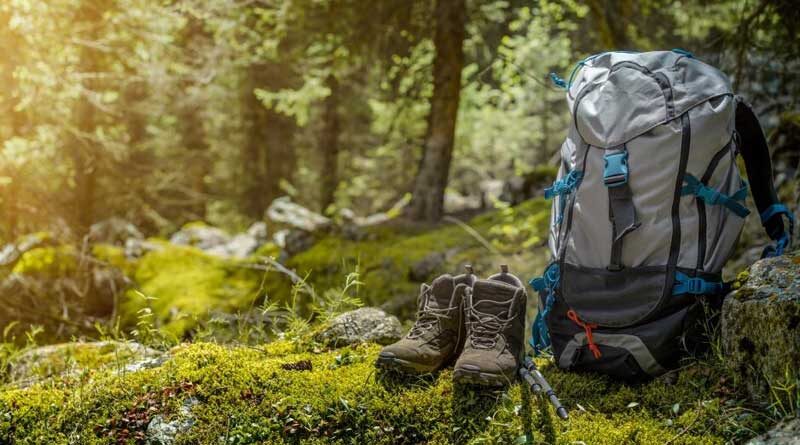
Best Budget Backpacking Packs of 2023
A good pack is an important piece of gear for any backpacking trip. If you think about it, a backpack can easily break your trip if it doesn’t fit you well. So I have tested and reviewed some of my favorite backpacks and rounded up a list. These packs will help you stay organized and make things much more quick and efficient while you’re on the trail. They are great for budget-conscious hikers on multi-day trips and are designed to haul big loads.
So here is the list of top budget-friendly packs that will help you carry heavy loads and organize your gear for your next big trip.
1. REI Co-op Trailmade

For those just getting into backpacking, the REI Co-op Trailmade is a good place to start. This pack doesn’t have any standout features in terms of performance or weight savings but for the price, it provides reasonable built quality and just enough features, which make this pack a good entry-level option. There’s simple padding on the back panel and the hip belt. The internal frame is made of steel, which gives the pack a solid structure and support. The maximum load capacity is 35 pounds which can work well for many overnight and multi-day hikes. This pack also comes in one size but it does have torso adjustment settings.
Being an entry-level option, this pack lacks back cushioning and ventilation. The suspension system is also not great and it can lead to an uncomfortable ride with a heavy load. However, the Trailmade is fairly comfortable under lighter loads. The padding is also stiff and it moves with the shoulder straps, which is uncomfortable against the back. One of the great features of this pack is the slanted water bottle pocket. It allows easy access to your water bottle when you are hiking on the trail.
What I like: Fairly inexpensive, comes with all essential features, adjustable fit
What I don’t like: Stiff padding digs in between shoulders and limited carrying comfort
See the REI Co-op Trailmade See the Women’s Trailmade
2. Osprey Rook

Osprey Rook offers you enough space to carry days’ worth of gear into the backcountry in addition to a breathable adjustable suspension system and tough trail-worthy construction. This full-featured pack is budget-friendly, which makes it a perfect choice for beginners taking a big trip. The pack’s AirSpeed suspension uses a 4mm light wire alloy frame and a high-tech plastic frame sheet to provide flexible but strong support for your load.
The tensioned mesh back panel, the mesh on the shoulder panels, and the hip belt help keep you drier and cooler during your hike. With a torso adjustability range of 17-22 inches, you can adjust the suspension system to fit. Load lifters and an adjustable sternum strap let you dial in for the best fit.
The Rook is a top-loading pack with an internal volume of over 3900 cubic inches. On the inside, you’ll find an integrated pocket, which allows the pack to accommodate any reservoir of your choice up to 3L. In terms of other storage options, the lid has a zippered pocket for things like GPS units or paper maps.
Side mesh pockets are great for bottles and there are loops on the front and lid providing all kinds of attachment opportunities. Upper and lower compression straps snug down the pack for a better ride but we all know that they can be used to lash stuff to the outside of the pack as well. In addition, there are two removable sleeping pad straps.
The hip belt has two zippered pockets for keeping small items secure. This pack has a horizontal zipper to access the lower portion of the pack. This is usually used for sleeping bags but you can use the divider to separate and organize your gear in any way you want.
The Rook is built for backcountry adventures. Being construed with tough 600-denier fabric, the bottom is reinforced with even tougher 1000-denier fabric. Osprey also included a rain cover so you’ll never find yourself without protection in bad weather. This pack offers Osprey’s adjustable comfortable frame, lots of storage space, abrasion-resistant construction, and pockets for gear big and small.
What I like: Bottom access, comes with a nice rain cover
What I don’t like: Access to the top lid is a little difficult and minimal features
See the Osprey Rook 65 See the Osprey Rook 50
3. REI Co-op Flash

REI Co-op Flash is a reliable and cheap hiking pack that provides good value for money. This pack features a competitively lighter weight and a bunch of useful features like large pockets, seam tapings, and convenient roll-top closure. With all of these features, this pack is still lightweight due to its thin fabric and lighter-duty suspension. These features are also customizable meaning that you can remove unnecessary straps, pockets, or hip belts according to your needs. So, depending on the trip, you can add or remove features, which make packing for any trip a breeze.
Keep in mind that this pack is not designed for super heavy loads but medium to moderate loads, it performs reasonably well and keeps your shoulders comfortable. The Flash 55 has a maximum recommended 30 pounds of load capacity. The pack also fits comfortably but there’s no torso adjustment and it needs to be purchased in a specific size for a better fit. The waist belt has padding and there’s enough room for adjustability so you will get a good fit even if you fall between sizes. Overall, the Flash 55 is one of the lightest packs on this list that is well-design and packed with features.
What I like: Lightweight, easily personalized, provides good value for money
What I don’t like: Not ideal for heavy loads and there’s no torso adjustability
See the REI Co-op Flash See the Women’s Flash
4. TETON Sports Scout 3400

TETON Sports Scout 3400 is a budget-friendly option for backpacking that offers a lot of features. This is an internal-framed pack that features two aluminum stays on the back. You can pull these out and adjust them to get a perfect fit if you need to. But for most people, you will not need to make any adjustments. There’s enough padding on the back and it is reasonably comfortable.
The design in the pack is streamlined and you can easily compare it with any high-end model. It is well-designed no matter how full you get inside this pack, the size of the side pockets stays the same. With some backpacks, when you stuff gear inside the pockets on the outside get stretched.
What I like: Great value for money, sturdy fabric, a lot of great features, good construction
What I don’t like: Not the lightest option out there.
See the TETON Sports Scout 3400
5. Loowoko 50L

Loowoko 55L is an internal framed and water-resistant backpack that is made of durable ripstop nylon. This pack features many pockets, some are small and some are quite large. There is a large pocket at the top and a few inner pockets. On the outside, this pack has two attachment points with gear loops at the bottom. You also benefit from heavy-duty Velcro at the sides to attach your trekking poles. If you want to hold your water bottle, you can use the side mesh pockets. These are secure mesh pockets with elastic collars.
On the bottom of the pack, there’s a big compartment that can be used to store your lightweight sleeping bag . This space is separated from the main compartment by a drawstring and toggle. Overall, Loowoko 55L is a perfect pack for day and weekend hikers (2-3 days long). The variety of different attachment points allows you to attach plenty of gear so you can even hike further with this pack. Also for the price, this pack is pretty hard to beat.
What I like: Plenty of adjustments and pockets, includes a rain cover, great value
What I don’t like: There are some unnecessary straps/buckles
See the Loowoko 50L
6. Granite Gear Crown 3

Granite Gear Crown 2 is an ultralight yet ultra-comfortable pack designed specifically for the minimalist thru-hiker. It’s got durable fabrics but a strippable construction that allows it to come in at an extremely low weight. With all of the included pieces, it’s just over 2 pounds but it can be stripped down to weigh just around 1.6 pounds without the lid and frame sheet.
The harness and suspension system on this pack is fairly minimal. You’re getting Granite Gear’s Vapor Current Mark 2 suspension system. This is an upgraded version of their tried-and-true VC system. You get dual-density foam minimalist shoulder straps and a minimalist hip belt. The massive benefit of this hip belt is the RE-FIT system. You can detach the belt and completely change the sizing. There are easy indicators for sizing based on your waist measurements. It ranges from 26 to 42 inches. The back panel itself is a molded plastic material with perforations for weight savings; it’s covered with foam to give you some padding and some comfort. You can even remove that frame sheet completely to reduce the pack weight as I mentioned before.
With the frame sheet installed, this pack has a max load rating of around 35 pounds. Finishing up on the back panel side you’ll get two large hip-belt pockets and a sliding sternum strap. I will say that the pack doesn’t have any torso ranges or true adjustment so pay close attention to the recommended torso length before jumping into this one. Granite Gear sizes it for users with torsos ranging from 18 to 21 inches.
What I really like about this pack is opening. You’ll get a traditional lid but it’s not necessary you can easily remove that and leave it behind for weight savings. Under that lid, the pack uses a roll-top design. This allows you to extend the bag to allow for extra gear or you can compress it down nice and small. With the use of all of these exterior compression straps, you can change how big or small the backpack is. Thru-hikers will definitely understand the need for a pack that gives you growth and shrinks when you deplete your food and resupply while hiking those long trails.
The majority of the pack is pretty simple and pared down. On the outside, you’ve got 100D and 210D high-tenacity nylon. You’ll get great abrasion resistance and durability considering the overall weight of the pack. There are a few lash points on the exterior of the pack as well as stretch side pockets for water bottles. The pack is hydration compatible and there’s an internal sleeve to hang your reservoir and a port at the top side to route that tube.
What I like: Super lightweight and streamlined
What I don’t like: Doesn’t perform well with heavy loads, less padding
See the Granite Gear Crown 3 See the Women’s Crown 3
7. Osprey Exos

If you’re looking for an ultralight minimalist pack but don’t want to sacrifice comfort, look no further. The Osprey Exos is the perfect option for you. These Exos packs have become favorites among the ultralight and thru-hiking community and for good reason. You’ll get an incredibly comfortable pack at a low weight that’s backed by Osprey’s incredible guarantee. The Exos gets its low weight from all of the different materials that make it. You’ll get a 100-denier fabric throughout the pack but a 210-denier bottom. This gives you a fabric that’s more durable than some of your other backpack options but not significantly heavier.
The framing is a thin 4mm aluminum that extends around the whole perimeter. Tensioned along that framing is this soft mesh material that’s so comfortable. Some other packs have a more abrasive mesh material along with the back panel but the Exos packs have this soft wide open mesh material. It wicks moisture and dries quickly.
The carry system uses Ospreys Exo form components. Basically, they’re fixed to the pack but they’re made with stretchy material so they conform to your shape while you move. The padding and mesh around the belt and shoulder straps are soft and mold and flex as well. The pack doesn’t have any adjustment, they do come in different sizes so make sure you get the one that best matches up with your torso length .
No matter what size you get, the pack weighs right around two and a half pounds. While Osprey did pair down this pack to minimize weight in bulk, they still include the Stow-on-the-Go trekking pole system on the shoulder strap. The access to the pack is only through the top. It’s fairly small so you don’t need much more. The lid has some storage but if you want to strip weight and minimize it, you can leave the lid at home. Osprey builds in a flap jacket cover with this pack to protect the opening.
Another way they shave weight is by thinning out the straps they use on the pack. The compression straps are minimal and they’re rooted in a way that minimizes the need for extra stitching you can also completely remove those straps if you don’t want or need them.
Some of the exterior features that you get are also pretty smart. You’ll get stretched side pockets that are really deep and a big front mesh dump pocket for rain gear or other stuff. What I like about these pockets is that you get a reinforced material not just mesh. I have a tendency to be a little rough with the stretch mesh pockets so by adding this reinforcement Osprey is giving me peace of mind in those more delicate areas. You’ll also find the loops placed throughout the front where you can lash additional gear if you need to.
What I like: Great pockets, comparatively lightweight
What I don’t like: Limited adjustability, average durability
See the Osprey Exos 58 See the Exos 55 See the Exos 48
8. Gregory Zulu

Gregory Zulu is ready for cold weather gear-intensive day hikes or summer overnights. This pack has more than 3000 cubic inches inside, an adaptable suspension, a flexible comfortable hip belt, and two entry points for grabbing your gear. The alloy perimeter frame has a fiberglass anti-barreling cross-stay, which means that it won’t puff out like a barrel when stuffed full. The free float suspension features a 3D comfort cradle hip belt with dynamic flex panels that move with you. The pull-forward hip belt design makes it easy to get a snug fit.
Gregory makes this pack in different sizes to suit different people. The pack suspension also is adjustable giving you 4 inches of built-in adaptability to achieve the best possible fit. To help you stay cool and dry on the trail, this pack has an open-air ventilated back panel with moisture-wicking mesh and die-cut shoulder straps. The sternum strap and the load lifters are adjustable to dial in the fit. The sternum strap also includes a whistle.
The main access is to the fixed lid under which is a protective spindrift collar. You can also easily reach the interior through a U-shaped zipper on the front of the pack. Inside, you’ll find the hydration pocket, hose port, and a clip design to fit quickly and easily onto Gregory’s 3D Hydro reservoir, which is available separately.
There is a pocket on the top of the lid for apps or gloves or other small stuff. A pocket on the bottom of the lid holds the included rain cover with some room left over. There is a stretch mesh pocket on the front for bulky or wet stuff. There are two side stretch mesh pockets with pass-through. This means that the compression strap runs behind the bottles which allow you to tighten the straps without squishing your bottles and also pull the bottles out easily when the compression straps are tightened down.
A strap and bungee on the shoulder strap hold your sunglasses securely. There are attachment points on the lid to lash extra stuff to the outside of the pack. A flexible hip belt and an adaptable suspension give this pack a comfortable ride. A complimentary rain cover keeps the contents dry when the weather isn’t.
What I like: Features and weight balance is very good, and a comfortable suspension
What I don’t like: Offers less gear capacity than some similar weight options the lid is not removable
See the Gregory Zulu 65 See the Zulu 45 See the Zulu 30
9. Kelty Coyote

Kelty has taken the tried-and-true Coyote pack and made it smaller and more versatile for backcountry outings. The Coyote is loaded with features from top to bottom that make this a great value pack for the traditional backpacker. One of the things that Kelty is known for is the reliable and durable construction they offer with their gear. These Coyote packs are no exception. They’re not the lightest weight materials out there today, but Kelty isn’t aiming for an ultralight pack here, they’re building reliable durability.
The framing is an HDPE frame sheet with a single aluminum stay that will help drive the weight down to your hips. The hip belt is also HDPE reinforced so it can handle heavier loads without buckling or folding. Throughout the entire back panel, Kelty is incorporating a large hex mesh material. Under that, there is ample padding to keep you comfortable even under heavier loads. That hex mesh helps to wick moisture and pulls the sweat away from your back to help you stay comfortable all day long.
Accessing the pack is pretty straightforward. You do have a traditional lid to the pack that’s going to provide extra storage as well for the top. That lid can even entirely be removed and left at home or brought along. It doubles as a sling pack so it’s great for taking on quick day trips away from the campsite. On top of the top access, you do get front panel access with this pack as well which lets you access your items without having to dump everything out of the top of the pack.
What I like: Many ways to access the pack, lots of adjustments
What I don’t like: Heavy and not very comfortable
See the Kelty Coyote
10. Gregory Stout

The stout has a nice flexible suspension system. Gregory calls this back system the Trailflex adjustable suspension system. It’s built on a sturdy spring steel frame and a cushioned ventilated back panel it effectively takes those lighter weight loads and transfers them right down to the lightly padded hip belt. The harness is highly adjustable and can fit a wide range of different torso sizes. The pack doesn’t come in different sizes so this is how you’re going to get that good fit. The hip belt is essentially fixed and it won’t adjust that much so unfortunately, it’s not going to fit everyone out there. The pack does, however, host a load of features for the day hiker or overnighter.
You’ve got lots of organizational pockets. Hip-belt pockets are a great place to throw some extra snacks or your cell phone. I like to keep snacks there because it’s nice and easy to access so you can eat while you keep hiking. On the lid, you’ve got some extra organizational options. The lid is fixed to the pack so it’s not floating and is removable. The sides of the pack both have a stretch pocket you can do the traditional thing and put a water bottle in there or you can store some other items.
The pockets are fairly deep and you’ve got compression there to hold things tight. You’ve also got a front stretch pocket with a buckle. This is great for that extra layer whether it’s an insulator a rain layer or something like that. There’s also another zippered pocket in here that holds an included rain cover. It’s tucked right behind there. This is an awesome added value to keep your gear protected when foul weather rolls in. What I think is pretty cool about that pocket is it’s pretty simple and it might seem silly where most rain cover pockets are in an inconvenient location. This one isn’t. It’s conveniently tucked right under a frequently used pocket and can be used for smaller items if you decide to leave that rain cover at home.
Access to the pack is fairly standard. You’ve got a top-loading design with a fixed lid. There’s also a bottom compartment as well so you do have lower access but there isn’t any divider. It is all access to the same pocket. There are sleeping pad straps down at the bottom so if you are taking this out on an overnighter you can lash your pad there or you can also use that to hold other items. You’ve also got two loops and bungee tie-offs. If you want to use this pack for some winter climbing you can lash some ice axes or tools to the outside.
What I like: The minimal design is very effective, has great value, good balance of weight and features
What I don’t like: Nothing stands out, and there are some unnecessary straps
See the Gregory Stout
11. Osprey Volt

Osprey Volt is the pack that you can take into the backcountry for a few days. Volt features an adjustable suspension system storage space for trekking poles , and an included rain cover. The pack has a lightweight frame and an HDPE frame sheet that provides support during a hike. The suspension system is adjustable and it allows adjustability ranging from 17 to 22 inches. This range can fit a wide variety of people. For ventilation, there’s a spacer mesh on the harness and the back panel, which help you keep cool and dry. The hip belt offers a Fit-on-the-Fly system with a dual-density construction. It provides extra comfort and a supportive fit.
The Volt 60 offers a volume of over 3,600 cubic inches in the main compartment. There are some other storage options that include 2 zippered pockets on the lid, a stretchy pocket on the front, and 2 zippered hip-belt pockets for small belongings such as your cell phone. The pack is also hydration compatible with up to a 3L reservoir. There are also two side pockets for water bottles. With this backpack, you also get a zippered sleeping bag compartment with a removable divider. On the outside, the pack features some attachment points and removable sleeping pad straps in addition to Osprey’s Stow-on-the-Go system, which allows you to put your trekking poles away without even slowing down.
What I like: Solid set of features, comfortable shoulder straps, versatile
What I don’t like: The main compartment is narrow, and side pockets are a little too tight for water bottles
See the Osprey Volt
12. Deuter Futura Vario

Some packs are focused primarily on weight savings and others concentrate on load support and stability. This pack strikes a nice balance between the two and is a great option for weekend outings or multi-day backpacking trips. The pack is equipped with Deuter’s AirComfort Sensing Vario suspension system. It has a flexible spring steel perimeter frame, strategically placed and supportive foam, and an embedded mesh back panel. This design maximizes support but it still allows ventilation so you stay dry and comfortable.
The pack’s VariFlex system offers adjustability for torso lengths ranging from 15 to 22 inches in length. Padded adjustable shoulder straps and a beefy pivoting hip belt enhance load stability. Load lifter straps and a sliding sternum strap help you dial in the fit. Standard storage is just over 3,000 cubic inches and an integrated spindrift collar expands so you can carry over 3,600 cubic inches of gear. The height of the lid can be adjusted to accommodate that expanded storage.
The pack has two compartments; the main pack bag can be accessed through the top or also in the front with a luggage-style opening. There’s also a separate front-accessed sleeping bag compartment. The pack has a large front stretch pocket, side bellows pockets, internal and external lid pockets, and zippered hip belt pockets. Other features include compression straps, ice ax, trekking pole loops, and an integrated rain cover. Two sides stretch pockets are ideal for carrying water bottles and an internal sleeve and tube exit ports make the pack hydration compatible. Note that a hydration system is not included.
What I like: Many useful pockets, great for heavy loads, easy access to the top lid
What I don’t like: The harness and belt are hard and not very comfortable
See the Deuter Futura Vario
Best Budget Backpacking Packs: Comparison Table
How to choose a backpacking pack.
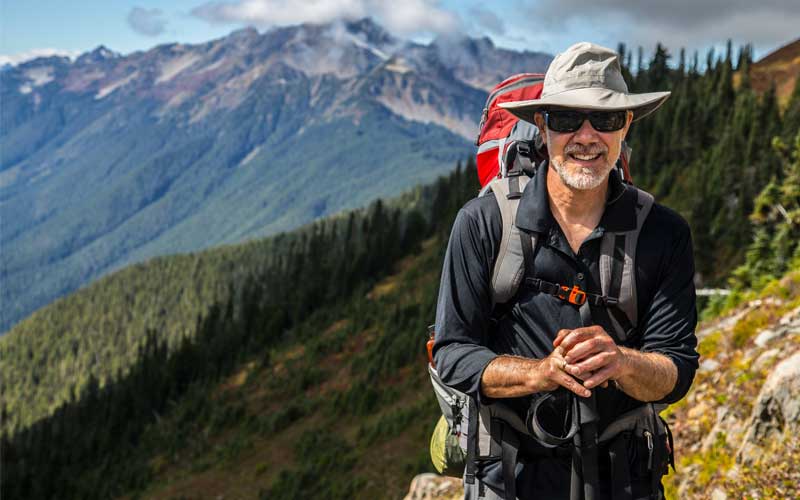
How to choose the right pack for backpacking? Basically, what I want to do in this section is give you an idea or some discussion points to consider when you’re purchasing your backpack. Whether it’s your first backpack or you’re looking to upgrade from something that might be a little bit older.
For me, the most important thing in choosing a backpack is how the pack fits your body. The torso length is the most important thing to consider when it comes to fit. How long is your torso and what pack is going to fit your torso length are key to getting the perfect fit. If you’re not paying attention to that aspect when you are looking for a packed purchase, you’re going to have a miserable experience.
When you go try on a pack at any store whether that’s REI, Cabela’s, or any other outdoor store, make sure that you get the ability to not only try the pack on to make sure that it fits your torso length but also carry the pack with some weight in it. I would suggest at least 30 pounds and that’s going to give you a good idea of what the pack is capable of carrying.
Gear Capacity
The gear capacity will depend on what type of backpacking will you be doing. Are you going to be doing a thru-hike or are you just doing the type of basecamp backpacking? Thru-hikers are going to use a lightweight frameless pack as opposed to a more robust type of pack because thru-hikers are trying to be more weight conscious and are trying to be more minimalist. A 60L Deuter pack is going to be way too excessive and bigger for an ultralight system like a 2 to 3 days hike. A lightweight frameless option is going to be a better choice for this application. With that said, you need to know what the gear you have is going to take up space-wise.
Framed Vs. Frameless Packs
There are two main categories of backpacking backpacks; i.e. framed and frameless. The framed category is further broken down into two sub-categories; i.e. internal and external frame backpacks. When we talk about framed packs for hiking, we usually mean internal framed packs because external frame backpacks are too heavy for backpacking purposes.
Osprey is super popular with this Exos series and a lot of thru-hikers are using this. This is just over a 2-pound pack at 38L and you can carry upwards of about 35-30 pounds without it starting to get uncomfortable. A frameless pack like a ULA or Gossamer Gear has a superior wilderness. These are trying to go as minimalist as possible and they’re usually a custom-made pack.
When it comes down to choosing a pack and what pack makes the most sense for you when you go backpacking, it’s not possible for me to go over every single factor in everything about how to choose the right backpack for you. Just make sure that the pack carries well under load, that it fits your torso, and that it fits you. For me, the Osprey Exos is the right backpack but it took a lot of backpacking experience to feel the comfort. This pack was kind of the introduction for me to going ultralight.
- ← How to Adjust the Backpack Torso Length?
- What to Wear Hiking in 70-Degree Weather? →
You May Also Like
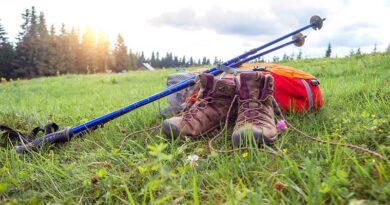
Best Budget Trekking Poles of 2024
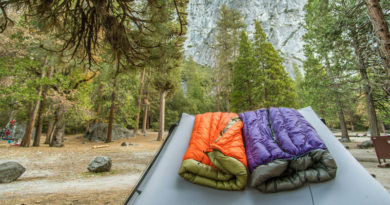
Best Budget Ultralight Sleeping Bags of 2023
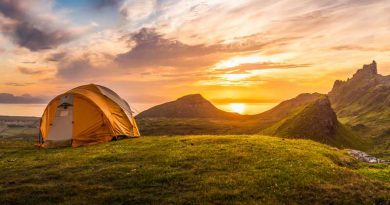
Best Tents for Queen Size Air Mattresses

Cheap 10-lb Budget Backpacking Gear Kit for $500

Quality backpacking gear has a reputation for being pricey, but I’m here to show you that it’s entirely possible to put together an affordable ultralight setup on a $500 budget.
That’s right; you can get your hands on a brand-new backpacking gear kit with a 10-pound base weight without having to max out your credit card.
I’ve spent over $3,200 on my current ultralight setup , so I know how expensive backpacking can be. Naturally, many of my readers have seen my kit and asked for more affordable recommendations. I can’t blame them, after all, because the gear on my backpacking list isn’t exactly cheap.
So, I scoured the internet for the best budget gear, tested a bunch of it in the field, and asked fellow backpackers for their favorite affordable recommendations. This article is the result of all my tedious research and gear nerdery.
Every piece of gear I recommend in this post is well-reviewed, widely-used in the backpacking community, and will help get you into the backcountry for a sliver of what you might pay otherwise.
Let’s dive in. It’s time to save some money.
Best Budget Backpacking Gear
- Backpack & Sleeping System
Carried Clothing
Cooking system.
- Water Filtration & Storage
Electronics/Technology
Miscellaneous items.
- First Aid Kit & Toiletries
- What About Worn Items/Consumables?
Budget Backpacking Advice
- Final Word: Budget Backpacking Gear
Backpack and Sleeping System

Backpack : Granite Gear Virga 2
Granite Gear backpacks are widely respected in the ultralight community, and the Virga 2 is one of their most affordable models. This no-frills pack — made from durable 100D waterproof nylon — is a minimalist trekker’s dream and will do everything you ask of it in the backcountry.
Weight : 20.1 oz | 570 grams

Shelter: River County Products Trekker 1
Most popular ultralight tents cost an arm and a leg, but the Trekker 2 comes in at only 50 bucks. This nylon two-person trekking pole tent is similar in design to the MLD Solomid but for 1/5th of the price. Tip: treat its seams with silicone sealant to ensure that it’s completely waterproof.
Weight : 41.0 oz | 1.16 kg

Sleeping Quilt : OneTigris Featherlite 40º
Quality, ultralight sleeping bags are nearly impossible to find for under $100, so the Featherlite is a great find for budget backpackers. Stuffed with 90% duck down/10% cotton, this quilt-style bag offers three-season warmth as temperatures drop towards freezing.
Weight : 35 oz | 1.00 kg

Sleeping Pad : Sleepingo
Weighing just a couple of ounces more than the ultra-popular NeoAir Xlite , this cheap, yet comfortable pad comes in at a quarter of the price . The tradeoff? It’s rated at an R-value of 2.1 (the Xlite is 4.2), meaning it’s not as warm as the Xlite and is meant for temperatures of 40ºF and above.
Weight : 14.5 oz | 411 grams

Pack Liner : Trash Bag
While the Virga 2 backpack on this list is waterproof, it’s smart to give your gear an inside layer of protection against liquid. To keep it budget-friendly, line your backpack with a cheap black trash bag that you can find underneath your kitchen sink or in the pantry.
Weight : 1.0 oz | 28 grams

Tent Stakes
The Trekker 2 tent mentioned earlier comes with nine of these ultralight stakes, making it even more of a bargain. These aren’t going to be the most durable stakes, however, so push or tap them gently into the ground while pitching your tent to avoid bending or breaking them.
Weight : 3.0 oz | 85 grams
Total Backpack and Sleep System Weight 118.0 oz | 7.38 lb | 3.35 kg

Puffy Jacket : Amazon Essentials ( Men’s | Women’s )
Packable down jackets are an essential part of any ultralight gear list, and they have a reputation for getting quite pricey. Not this jacket. Made with a water-resistant nylon shell and stuffed with durable polyester fill, the Amazon Essentials ultralight puffy is comfortable, warm, and easy on the wallet.
Weight : 13.2 oz | 374 grams

Thermal Top : TSLA Crew ( Men’s | Women’s )
Don’t tell Elon, but TSLA makes incredibly inexpensive backpacking gear, and their lightweight thermal top no exception. It’s cozy, warm, fits like a dream. I enjoy it so much, that it has also become a staple of my ultra-minimalist travel packing list .
Weight : 5.1 oz | 145 grams

Rain Jacket : Frog Toggs Ultra-Lite2 ( Men’s | Women’s )
The Frog Toggs Ultra-Lite2 rain jacket is not known for its durability, which is why it’s a polarizing piece of gear. It’s cheap, lightweight, and sheds water better than most other ultralight backpacking jackets, though. So, as long as you take care of it, you’ll be glad you brought it along.
Weight : 4.8 oz | 136 grams

Thermal Bottoms : TSLA
Staying warm during early mornings and chilly nights is a must when backpacking, and a solid pair of thermal leggings will help you do just that. Priced at under $15, these cozy TSLA bottoms are about as affordable as you can find on the market.
Weight : 5.8 oz | 164 grams

Gloves : Lethmik Touchscreen-Compatible
Though not essential on warm-weather backpacking trips, these gloves will keep your hands warm during cooler expeditions. They’re snug and comfortable, allow you to use your smartphone, and would make an affordable addition to any budget backpacking gear list.
Weight : 2.0 oz | 57 grams

Stuff Sack : Outdoor Products Dry Sack
Stuff sacks are essential for stashing clothes while backpacking and these are some of the cheapest and most well-reviewed options on the market. They’re waterproof, and I use mine for backcountry laundry and shower sessions as well. Grab a set and bring along the size that fits your needs.
Weight : 1.2 oz | 34 grams
Total Carried Clothing Weight 32.1 oz | 2.00 lb | 910 grams

Stove : BRS-3000T
The BRS-3000T is one of the most popular pieces of budget backpacking gear and has found a place in the packs of countless ultralight enthusiasts (including mine). It’s as lightweight as backpacking stoves come, cranks out a powerful flame, and can boil water in just a couple of minutes.
Weight : .9 oz | 26 grams

Pot : AliExpress 450ml Titanium
When preparing freeze-dried backcountry cuisine, all you need is a simple pot to boil water, and this affordable option will get the job done. At 450ml, it holds enough water for most dehydrated meals and works great as a coffee mug or scoop for hard-to-collect water sources.
Weight : 3.1 oz | 88 grams

Spork : Tito Titanium
If you paid $15 for a spork, you paid too much. This Tito titanium spork is durable, lightweight, and will get your food into your mouth for under five bucks. Looking for an even cheaper option? Grab a plastic to-go spoon from your favorite restaurant or fast food joint.
Weight : .5 oz | 14 grams
Total Cooking System Weight 4.5 oz | .28 lb | 128 grams
Water purification and storage.

Water Filter Kit : Sawyer Mini + Water Pouch
Water purification is essential in the backcountry, and the Sawyer Mini is one of the lightest and most affordable filters on the market. Simply fill your water bottle or pouch with dirty water, screw this filter on, and squeeze the water through to filter it flawlessly.
Weight : 2.5 oz | 71 grams

Water Bottle: One-Liter Smartwater
If you’ve spent much time backpacking, you’ve likely seen the Smartwater bottle in numerous ultralight backpacks. Why? Because it’s cheap, durable, and compatible with the Sawyer Mini water filter. So, head to the nearest gas station, grab a Smartwater, and you’re all set.
Weight : 1.6 oz | 45 grams
Total Water Filtration and Storage Weight 4.1 oz | .26 lb | 116 grams

Battery Bank : POWERADD Mini 5,000mAh
This power bank can recharge your smartphone up to two times on your next trek, which’ll allow you to access digital maps, take photos, and message loved ones for days on end. Coming in at around $10, this battery bank is an inexpensive piece of gear that should be on any budget backpacker’s list.

USB Cable : Startech 6″
Packing your unnecessarily long charging cable from home is inefficient. Instead, bring a mini USB cord that weighs nothing and won’t get tangled in your bag. Ultralight backpacking is about shedding unnecessary weight at every turn, and this six-inch cable will help you do just that.
Weight : .35 oz | 10 grams

Headlamp : Hatori Pocket Torch
This mini LED pocket torch will illuminate the night for ultralight backpackers with ease. Putting out a respectable 150 lumens on a single AAA battery, this versatile and portable little light can clip onto the bill of a hat for hands-free use.
Total Electronics Weight 4.7 oz | .29 lb | 133 grams

Compass/Thermometer : Coghlan’s Four Function
Costing a mere $4 and weighing an ounce, this handy tool is a no-brainer for any backpacker searching for affordable gear. It works as a powerful whistle, two-scale thermometer, minimalist compass, and magnifier, which can bail you out in numerous ways in the wilderness.

Micro Scissors : Tacony Super Shears
Knives aren’t essential pieces of backpacking gear, which is why I pack these cheap, lightweight mini scissors instead. They’re ultra-sharp and precise, making them the perfect tool for repairing gear, trimming fingernails, and cutting paracord.
Weight : .17 oz | 5 grams

Lighter : Bic Mini
The BRS-3000T stove I recommended earlier doesn’t have an ignitor, which is why it’s essential to bring a lighter and/or matches to get it started. The Bic Mini is the lighter of choice for ultralight backpackers because it’s small, cheap, reliable, and efficient.
Weight : .4 oz | 11 grams

Mini-Towel : Lightload Microfiber
I carry a Lightload Microfiber mini-towel on my backpacking trips to wipe down condensation inside my tent and dry out my cooking pot. It also can be used as a fire-starter, gauze, or mask filter if things go sideways in the unpredictable backcountry.
Total Miscellaneous Weight 2.1 oz | .13 lb | 60 grams
$10 first aid kit & toiletries.
Blister Pads
Hand Sanitizer
Liquid Soap
Contact Case
Contact Solution
Putting together an affordable backpacking first aid and toiletries kit shouldn’t be too difficult. Just poke around your medicine cabinet, scavenge the items that fit your needs, and put everything into a Ziploc bag.
Resist the urge to overpack your first-aid kit and think realistically about what you’ll actually need to stay safe in the backcountry. Keep it light and compact to save weight and space.
Carry your toiletries in mini containers to save weight and space inside your pack.
I consider some of the above items — Advil, hand sanitizer, toothpaste, contact solution, soap — to be ‘consumables’ since their weight isn’t fixed. Because of this, the weight listed below doesn’t account for them.
Total First Aid Kit & Toiletries Weight 3.0 oz | .19 lb | 85 grams
Total base weight 168.5 oz | 10.53 lb | 4.78 kg, what about worn/carried items & consumables.
This article aims to help readers achieve a 10-pound backpacking base weight for under $500. Base weight accounts for everything you carry in your backpack with a fixed weight that can’t be reduced.
So, what’s not included in a backpacker’s base weight?
- Worn clothing (shoes, pants, underwear , watch, etc.)
- Carried items (trekking poles)
- Food (2,000-4,000 calories a day)
- Water (one liter = two pounds)
- Fuel (iso-propane, denatured alcohol, Esbit tablets , etc.)
- Other Consumables (toothpaste, sunscreen, Advil, etc.)
Since the above gear, food, fuel, and supplies aren’t counted as base weight, I didn’t include any of these items earlier in this post. Don’t worry, though, as I’ve compiled a list of budget-friendly ‘non-base-weight’ backpacking items below:
- Hiking Shoes : Columbia Ivo Trail Breeze
- Athletic Hoodie : 32 Degrees Cool Long Sleeve Pullover
- Athletic Shorts : Little Donkey Andy
- Hiking Socks : Our Top Picks
- Trekking Poles : AIHOYE Aluminum
- Hat : Flexfit Athletic Fitted
- Sunglasses : Merry’s Vintage Aluminum
- DIY Backpacking Food : The Dehydrator Cookbook for Outdoor Adventurers
Are some of the pieces of gear or clothing on my list just not doing it for you? No worries. Here are some tips and tricks to help you put together an affordable backpacking kit of your own.
Do Your Research
When searching for that perfect piece of affordable backpacking gear, put in enough time to ensure that you make the right decision. Scour through reviews, ask fellow backpackers for recommendations, compare prices religiously, and be open to trying products from lesser-known brands.
Websites like GearTrade , Craigslist , LetGo , and eBay make it very easy to find used backpacking gear for a fraction of the original price. Patience and persistence is the name of the game when buying online, as good deals are usually scooped up quickly and quality second-hand gear is always in high demand.
Finding used backpacking gear in person is possible as well, but it’s more of a shot in the dark. Dig deep in your local thrift shops, garage sales, second-hand gear stores, and REI garage sales, and maybe, just maybe, you’ll find that highly discounted piece of gear you’ve been searching for.
Wait for Great Deals
If you’re a savvy gear hunter, you’ll likely be able to find some great deals during shopping holidays or seasonal sales. REI has a clearance section and an outlet store , both of which offer heavily discounted gear. Black Friday and Cyber Monday, though chaotic and sometimes ridiculous, can offer up great deals as well.
Outdoor gear companies often designate a section of their website to sell imperfect, lightly used, or outdated gear as well. Keep your eyes peeled while surfing your favorite gear companies’ websites for ‘bargain bin’ or ‘clearance’ sections.
Get Creative
If my previous tips aren’t helping you get your hands on cheap backpacking gear, then it might just be time to get creative.
Reach out to friends who have a surplus of gear and ask if they own any extra items they’d be willing to sell you. If they’re not ready to part with any of their beloved gear, ask if they’d feel comfortable loaning you some for your upcoming trip. A good friend should be more than willing to help you get on the trail.
Still no luck? Contact an outdoor gear company and offer an unbiased review in exchange for gear. Many companies are happy to give away gear in exchange for the exposure your review might bring. Keep in mind, those with a strong online presence are more likely to succeed with this option.
Backpacking doesn’t have to be expensive. Just be proactive, flexible, and creative, and you’ll eventually get your hands on some affordable gear.
Final Thoughts: Budget Backpacking Gear
Ultralight backpacking revolves around trimming the fat, lightening your load, and surviving with the bare essentials. There’s no reason it has to be expensive.
It’s entirely possible to hit the trail with a brand-new set of ultralight backpacking gear on a budget. Hell, I’ve just shown you exactly how to do so for $500 or less.
Now that you have a list of the most affordable backpacking gear at your fingertips, what’s stopping you from setting off on the trail, conquering the backcountry, and sleeping under the stars?
Last Updated on March 19, 2024

Noel Krasomil
Affiliate Disclosure : Some of the links in this post may be affiliate links. If you click an affiliate link and make a purchase, we may receive a small commission at no extra cost to you. Affiliate links help support this website and keep it 100% ad-free.

Best Budget Backpacking Tents of 2024
For casual backpackers and penny pinchers, the minor tradeoffs of a budget tent can be well worth the savings.
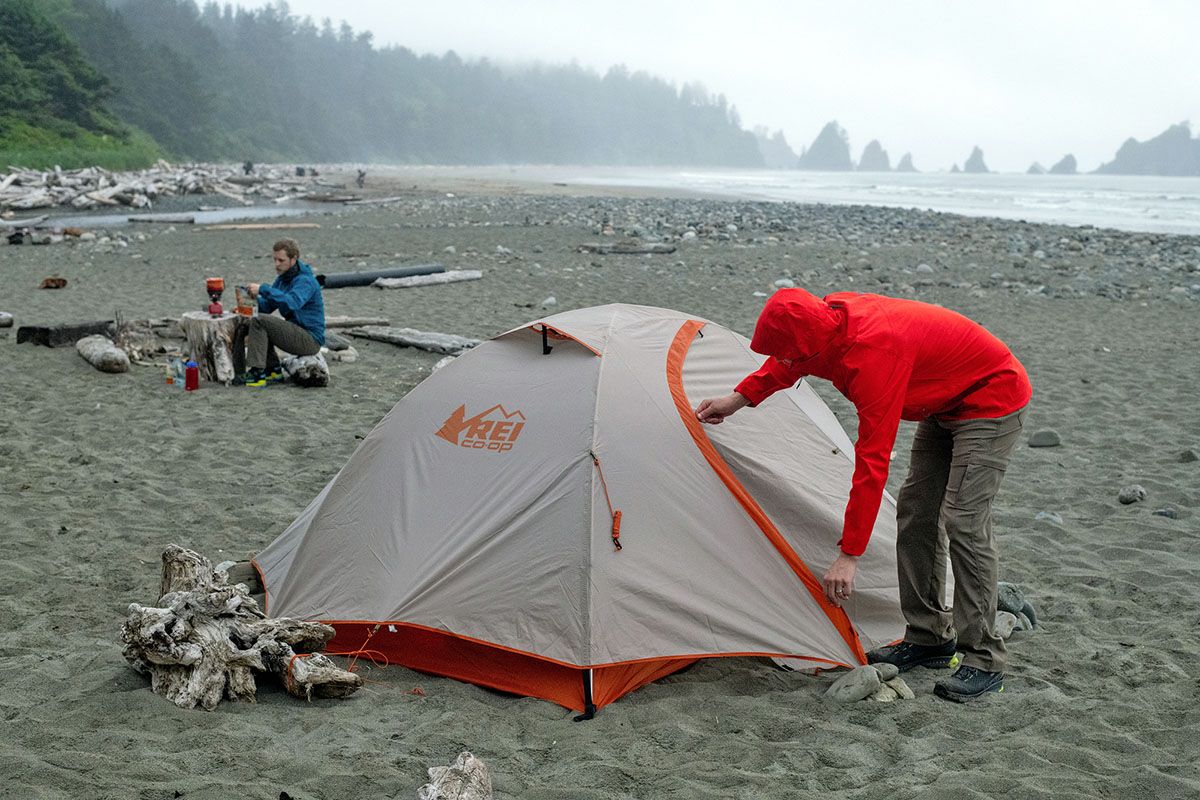
Switchback Travel ( Jason Hummel )
We use affiliate links and may receive a small commission on purchases. Read more about us .
A premium two-person backpacking tent can cost upwards of $500, but not everyone needs best-in-class performance. Casual weekenders and those just dipping their toes into backpacking can save a lot of money with a budget design. These tents are often heavier and less engineered than top-shelf models, but they’re nevertheless well built and will keep you protected in a storm. REI Co-op dominates the value scene, but our list also includes tents from brands like Nemo, Coleman, Big Agnes, The North Face, and more. Below are the best budget backpacking tents of 2024. For additional information, see the comparison table and buying advice below the picks.
Editor’s note: We updated our budget backpacking tents guide on April 24, 2024, to add information about our testing practices and ensure our product selection was up-to-date. This involved updating prices as well as adding the Tarptent Double Rainbow and Coleman Peak1 to the list.
Our Team's Budget Backpacking Tent Picks
- Best Overall Budget Backpacking Tent: REI Co-op Trail Hut 2
- A Premium Backpacking Tent for Under $350: REI Co-op Half Dome SL 2+
- Best Budget Tent for Families: Kelty Grand Mesa 4
- Best Budget Ultralight Backpacking Tent: Durston X-Mid 2
Best Overall Budget Backpacking Tent
1. rei co-op trail hut 2 ($229).
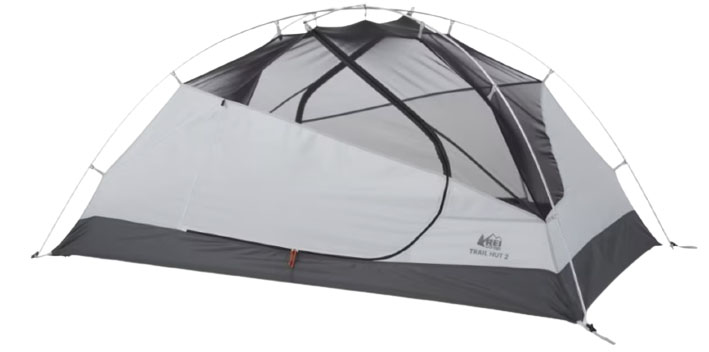
REI Co-op’s in-house brand offers great bang for your buck, and their lineup of backpacking tents is especially impressive. In short, no other tent manufacturer provides a better combination of price and performance—the holy grail for budget seekers. The Trail Hut 2 is one step up from their entry-level offering (the Trailmade below) and far and away their most balanced budget design. The tent keeps costs low with a material set that emphasizes durability over weight-savings, but adds a nice boost in livability with a headroom-expanding ridge pole. What’s more, its weather protection is on par with (or surpasses) tents three times the price: We brought the Trail Hut 2 backpacking in Patagonia, and its strong poles and thick fly deftly handled rain and strong wind throughout many nights in the mountains.
We’ve spent a lot of time in a tent—and a lot of time in $500 tents—and keep coming back to the Trail Hut as one of the best values on the market. If you’re a casual backpacker or only get out a few times a year, you really don’t need anything more. Sure, it’s relatively heavy and bulky, and thus not our first choice for serious hikers who like to cover a lot of miles (to keep your pack weight low, check out the Durston X-Mid or Tarptent Double Rainbow below). And despite the addition of the ridge pole, the Trail Hut is still not as spacious as designs with pre-bent poles (like the Half Dome SL or Aurora). But for the price, you won’t find a more comfortable, stormworthy, and well-built tent, making the Trail Hut 2 our runaway favorite for 2024... Read in-depth review See the REI Co-op Trail Hut 2
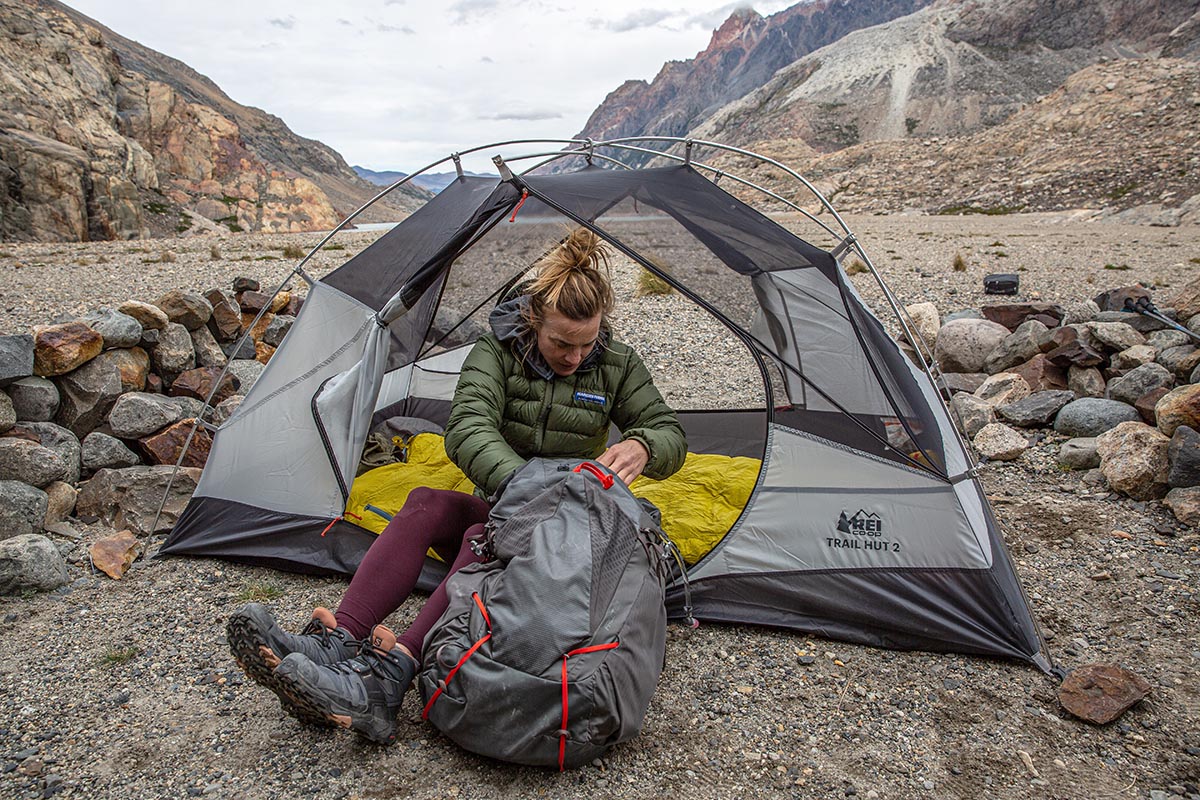
A Premium Backpacking Tent for Under $350
2. rei co-op half dome sl 2+ ($349).
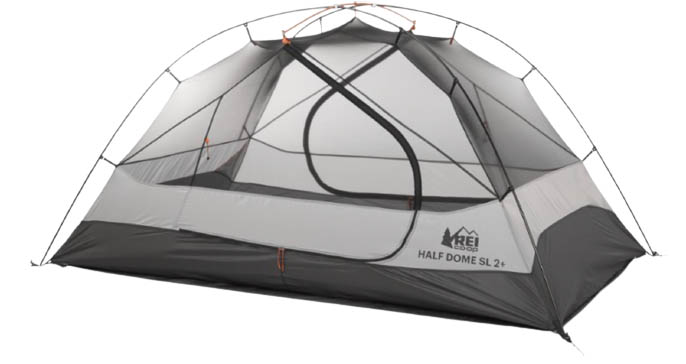
REI’s Trail Hut above is a function-first tent that will save you a lot of cash, but their mid-range Half Dome SL 2+ is the more well-rounded design. For $349, you get a sizable boost in livability thanks to roomier dimensions and modern features like pre-bent poles and a ridge-pole structure, both of which spread out the headroom and create steeper walls throughout. It all adds up to a nice amount of space for two adults, and with the "plus" designation, you’ve got room to squeeze in a smaller companion like a child or canine, too. Impressively, the Half Dome still manages to check in 1 pound 3.5 ounces lighter than the Trail Hut, and the whole package is noticeably more premium: finishes like a DAC-brand hubbed pole set and larger vents and vestibules give the tent a high-end feel that goes head to head with many of the top designs on the market.
The main reason the Half Dome SL dips into the budget category is weight: While it’s reasonably light compared to base models like the Trail Hut above, it can’t compete with top-tier tents like the Big Agnes Copper Spur ($530; 3 lb. 2 oz.). Simply put, if you’re headed out for weeks at a time or plan to cover a lot of ground each day, it might be worth spending up. But you can drop 8 ounces by leaving the included footprint behind, and the robust 40-denier floor should stand up well to rocks and branches. And if you’re looking to keep both weight and cost low, a tent like the Big Agnes C Bar is worth a look, but you’ll give up a good deal of livability with a tapered floor plan and single-door design. All told, for the best of all worlds at a sub-$350 price point, the Half Dome SL is without rival—in fact, it’s the tent we recommend most to family and friends... Read in-depth review See the REI Co-op Half Dome SL 2+
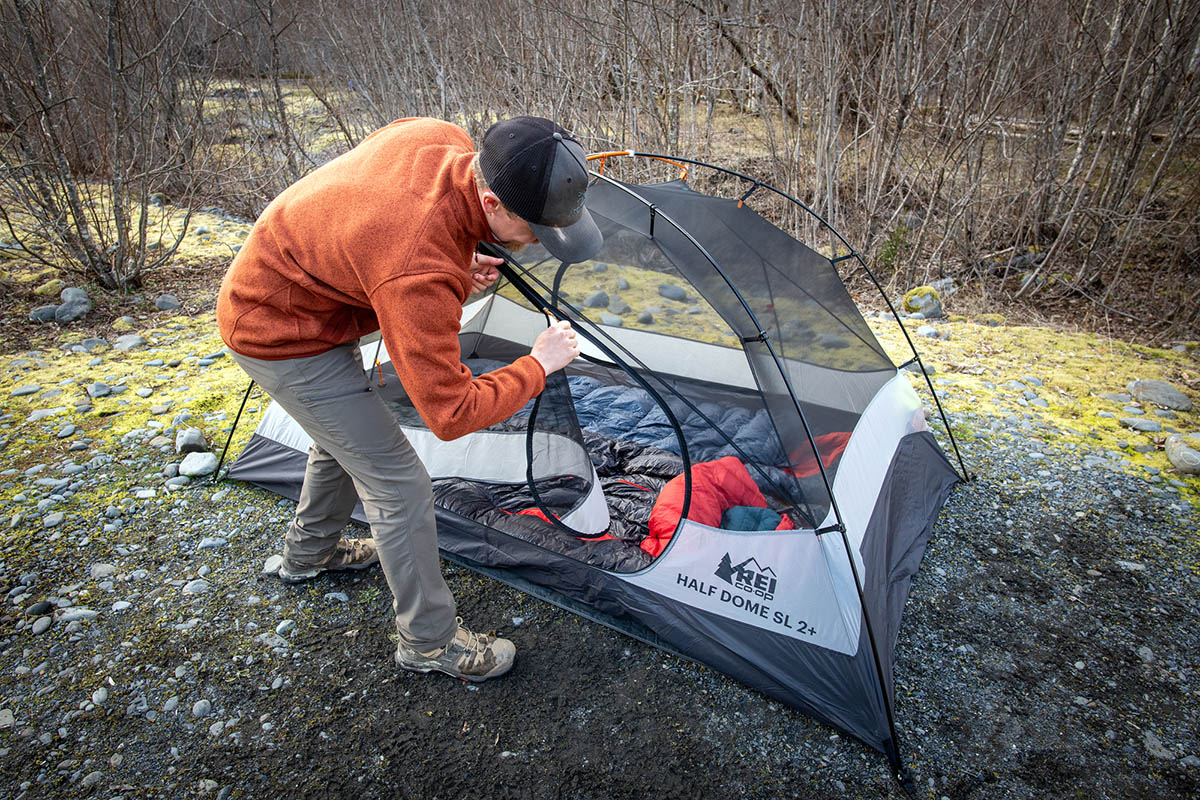
Best Budget Tent for Families
3. kelty grand mesa 4 ($220).
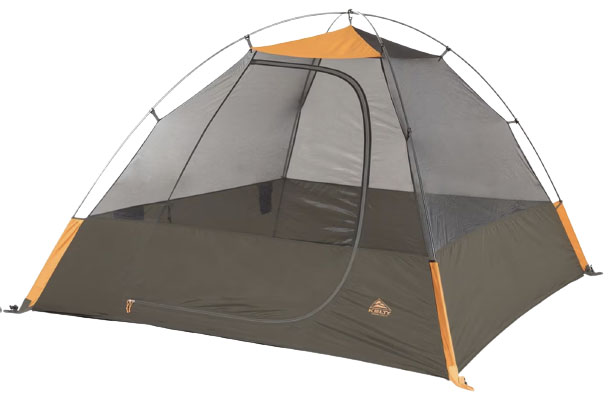
Most of the tents here are designed to fit two sleepers—we do this both for comparison’s sake and because two-person designs are the most common and versatile size among backpackers. But if you’re traveling with children, want to mix in some car camping, or are willing to bear the extra weight burden for a roomier shelter, a four-person tent is a great solution. Within this category, the Kelty Grand Mesa 4 is a reasonably lightweight and affordable choice: for just $220, you get sufficient room for four side-by-side sleeping pads, a generous 56-inch peak height, and durable materials throughout. And unlike the 90’s-era REI tent that we spent countless nights in as a kid, the Grand Mesa 4 only weighs 7 pounds 7 ounces, which is just a few pounds heavier than most two-person designs here (and pretty manageable if you split up the carrying responsibilities).
If you're considering a four-person tent, keep in mind that it’s not your only solution for family backpacking trips. Opting for two two-person tents offers more room overall (including vestibule space) and can result in a better night’s sleep for everyone. What’s more, finding two small flat spots is often easier than one large tent site, depending on your environs. And finally, with just one door, the Grand Mesa isn’t the most convenient option, and with a mesh-heavy design we don't recommend it for exposed areas or windy conditions. But for casual below-treeline adventures and smaller parties, it’s a roomy choice and lighter than much of the competition. And specs aside, we wouldn’t trade anything for the memories of waiting out a high-country storm with the whole family, complete with a deck of cards and a good book. See the Kelty Grand Mesa 4
Best Budget Ultralight Backpacking Tent
4. durston x-mid 2 ($280).
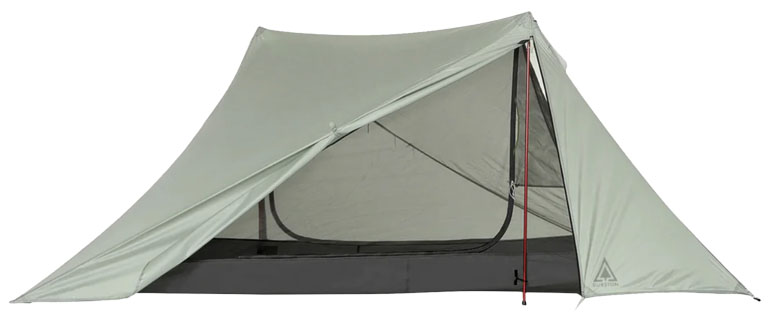
In 2024, the ultralight backpacking movement has gone fully mainstream, with hikers of all kinds embracing the freedom that comes with a lightweight load. An ultralight tent is a key part of every UL kit: They check in about 3 to 5 pounds lighter than traditional alternatives and have a much more streamlined packed size. Some UL tents save weight with ultra-thin materials and tapered floor plans, while others go light by using trekking poles rather than tent poles for structure. The Durston X-Mid 2 is one such trekking-pole shelter, combining a minimalist 2-pound 7.4-ounce weight with relatively durable materials and a spacious floor area. In a category where many shelters cost as much as $700, it’s a true steal at just $280.
But trekking-pole shelters certainly aren’t for everyone, and especially new backpackers: They require an extra dose of attention to get a taut pitch, and the A-frame shape (rather than an arched-pole design) can compromise interior space. But after taking the Durston X-Mid 2 backpacking in Washington’s Cascade range, we were really impressed with its performance. The shelter was relatively easy to set up, withstood strong winds, and its unique offset pole design offered more livable space than many standard backpacking tents we’ve tested. What’s more, like the other tents here, its double walls allow condensation to easily escape the inner tent (most trekking-pole shelters are single-wall). All told, if you’re looking to lighten your load and willing to try something different, the Durston X-Mid (which also comes in a 1P design for $240) is well worth a closer look. See the Durston X-Mid 2
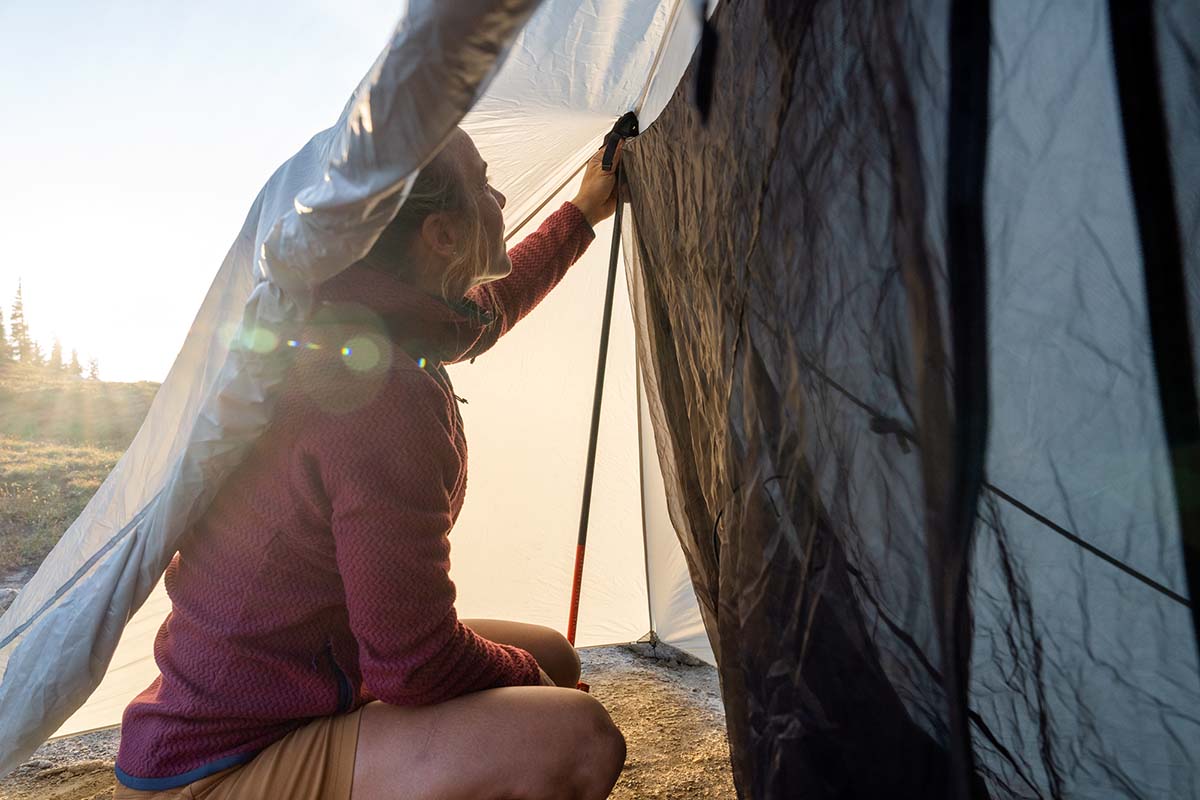
Best of the Rest
5. nemo aurora 2p ($300).
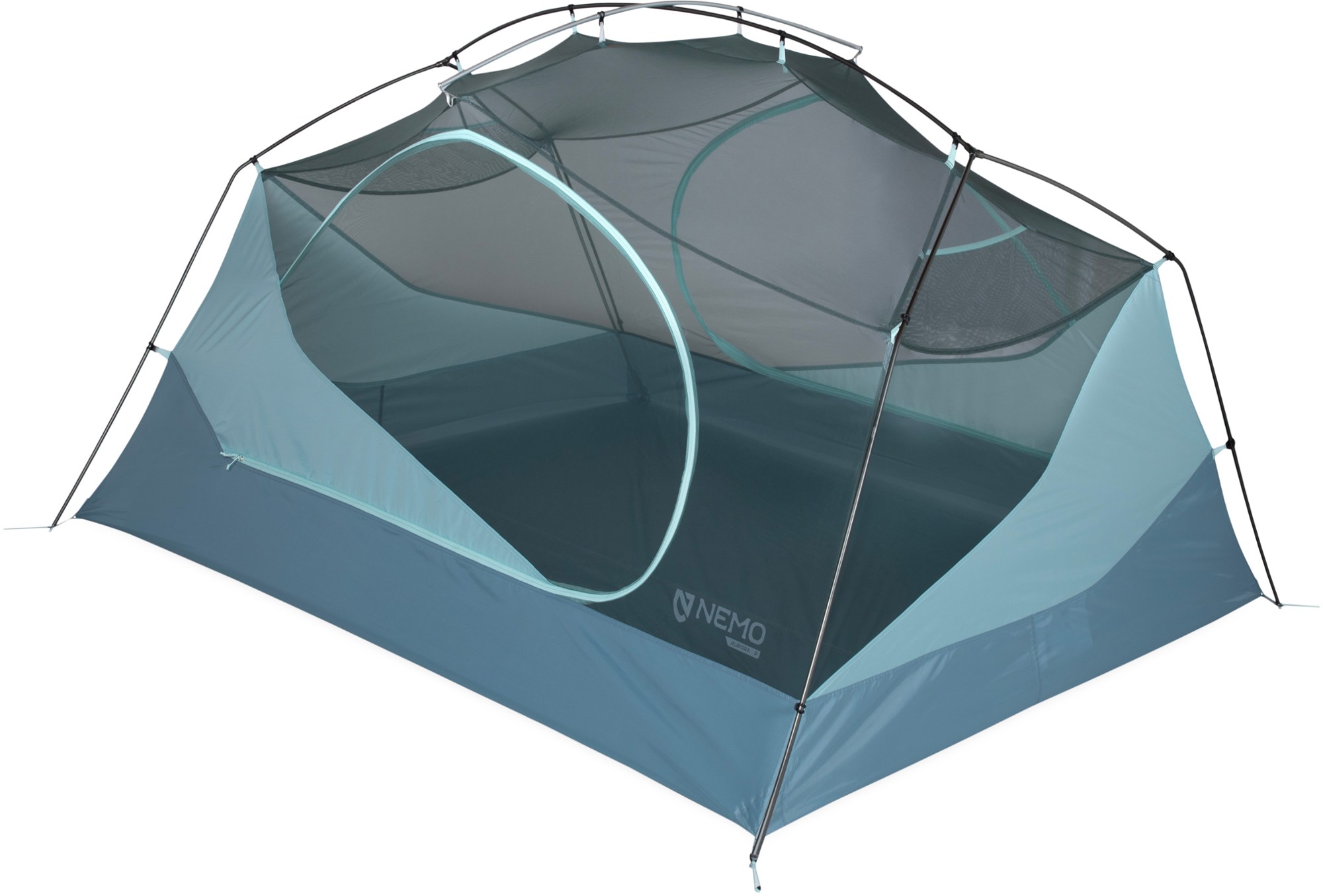
Nemo makes some of the best backpacking tents in the business, so the recent release of their budget-oriented Aurora certainly caught our attention. A modern take on the simple entry-level tent, the Aurora offers a large amount of livable space by way of prebent poles (the interior feels quite open with four near-vertical walls), hubs at both the head and foot ends, and a ridge pole at the center. A symmetrical design and Nemo’s intuitive hardware make set up a breeze, and you even get features like light-diffusing pockets and snaps for Nemo’s Pawprint liner (great for protecting the tent floor from your pup). For casual or penny-pinching backpackers who want a step up in interior space and quality from most budget tents, the Aurora is certainly worth a look. Plus, the newest iteration of the tent features a more sustainable build that’s free of per- and polyfluoroalkyl substances (PFAS for short), which are “forever chemicals” known to be harmful to both human health and the environment.
Priced at $300 (with an included footprint), the Aurora is on the spendy side of "budget." You do save $49 compared with the popular Half Dome above and get more durable materials (68D vs. 40D for the floor), but the REI is nearly a full pound lighter and a bit more spacious. We also found the REI gets the edge in wind protection—the very upright shape of the Nemo made it vulnerable to bowing in strong gusts on a trip in Colorado's San Juan Mountains. Weight-conscious hikers who get out a fair amount will likely opt for the Half Dome, but the Aurora is still a durable and affordable choice, and it’s hard to beat the premium feel and finishes of a Nemo design. For more space, you can bump up to the Aurora 3P (88 x 72 in.) for $360... Read in-depth Aurora 3P review See the Nemo Aurora 2P
6. REI Co-op Trailmade 2 ($199)
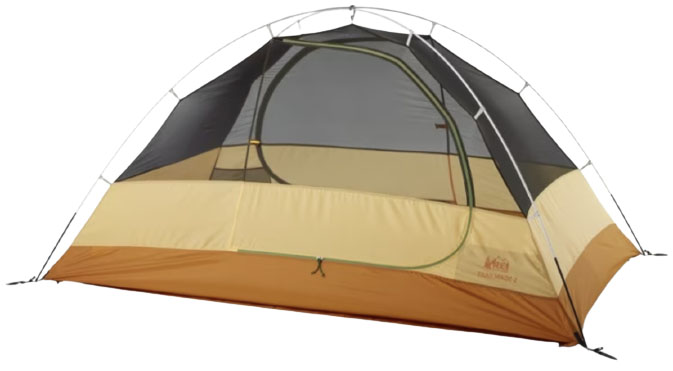
REI Co-op’s Trail Hut 2 above is our favorite all-around budget tent, but you can save even more with the Trailmade 2 here. Part of REI’s Trailmade line—a functional and fun collection aimed to help more people get outside—the Trailmade 2 is easy to set up (there are simple instructions on the stuff sack), comes with all the necessary accessories (footprint, guidelines, stakes, etc.) and has a bargain basement price. What’s more, with no ridge pole, it’s also a half-pound lighter than the Trail Hut, and you can shave even more weight by leaving the 6.8-ounce footprint at home, too. Tack on durable materials and beefy poles that can handle high winds, and the Trailmade 2 is a reliable tent that will get the job done for just $199.
The Trailmade features an identical floor area and roughly the same material weight as the Trail Hut (68D polyester), but it’s a far cry from our top pick in terms of build quality. On the model we tested, the rainfly didn’t properly fit the dimensions of the tent body—some sides were too long, others too short, and the seams never lined up perfectly. Combined with less guy-out points overall, and we were unable to get a taut pitch despite much tweaking. In addition, the Trailmade’s materials felt particularly cheap (most of all the coated polyester fly), the vestibule doors only offer a small opening to get in and out, and there’s very little interior storage (just one pocket beside each door). In the end, for just $30 more, the more spacious and premium-feeling Trail Hut is an easy choice for us. If you're building your kit from scratch, it's worth checking out REI's Trailmade 2 Backpacking Bundle , which features the tent, Trailmade 20 sleeping bag, and Trailmade sleeping pad for just $379... Read in-depth Trailmade 2 review See the REI Co-op Trailmade 2
7. Tarptent Double Rainbow 2P ($299)
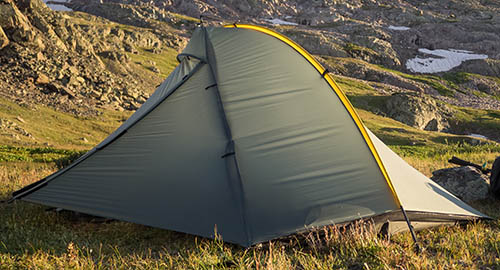
Packaged weight: 2 lb. 9.6 oz. Floor dimensions: 88 x 50 in. Capacities: 1P, 2P, 3P What we like: A terrific value for a sturdy and relatively approachable ultralight tent. What we don’t: Not freestanding and seam sealing costs extra.
California-based Tarptent isn’t a household name like REI or Nemo, but the cottage brand offers an inspiring ultralight lineup at reasonable price points. The Double Rainbow is our favorite model, featuring a unique hybrid single-wall design that keeps weight in check while maintaining impressive livability. For just 2 pounds 9.6 ounces, you get a reasonably thick 30-denier floor (15D is standard among UL tents), an aluminum arch pole to maximize headroom, a generous and symmetrical floor plan that easily fits two sleepers, and two doors and vestibules for convenient entry/exit and gear storage. Priced at just $299, it’s no wonder that the Double Rainbow has garnered a serious following among ultralighters and thru-hikers.
The Tarptent’s hybrid single-wall construction means setup is a breeze: Simply thread the main pole through the sleeve in the rainfly and stake everything out (the “tent body” is made of mesh and hangs from the bottom of the fly). This is particularly nice in wet conditions, as there’s no moment during the setup process when the inside of the tent is exposed to rain. That said, we give the slight edge to the Durston X-Mid 2 above as the better UL design. Comparing the two, the Durston is a bit roomier, a couple ounces lighter, and cheaper by about $20. On the flip side, the Tarptent is a cinch to set up and doesn’t require the same learning curve as a trekking pole-supported design like the Durston, although trekking poles are required to make it fully freestanding (otherwise, you’ll need soft ground or good anchors to get a taut pitch). Finally, the Double Rainbow doesn't come seam-sealed, but it’s a fairly simple DIY process, or you can add it onto your order for $35... Read in-depth review See the Tarptent Double Rainbow 2P
8. Coleman Peak1 2P ($270)
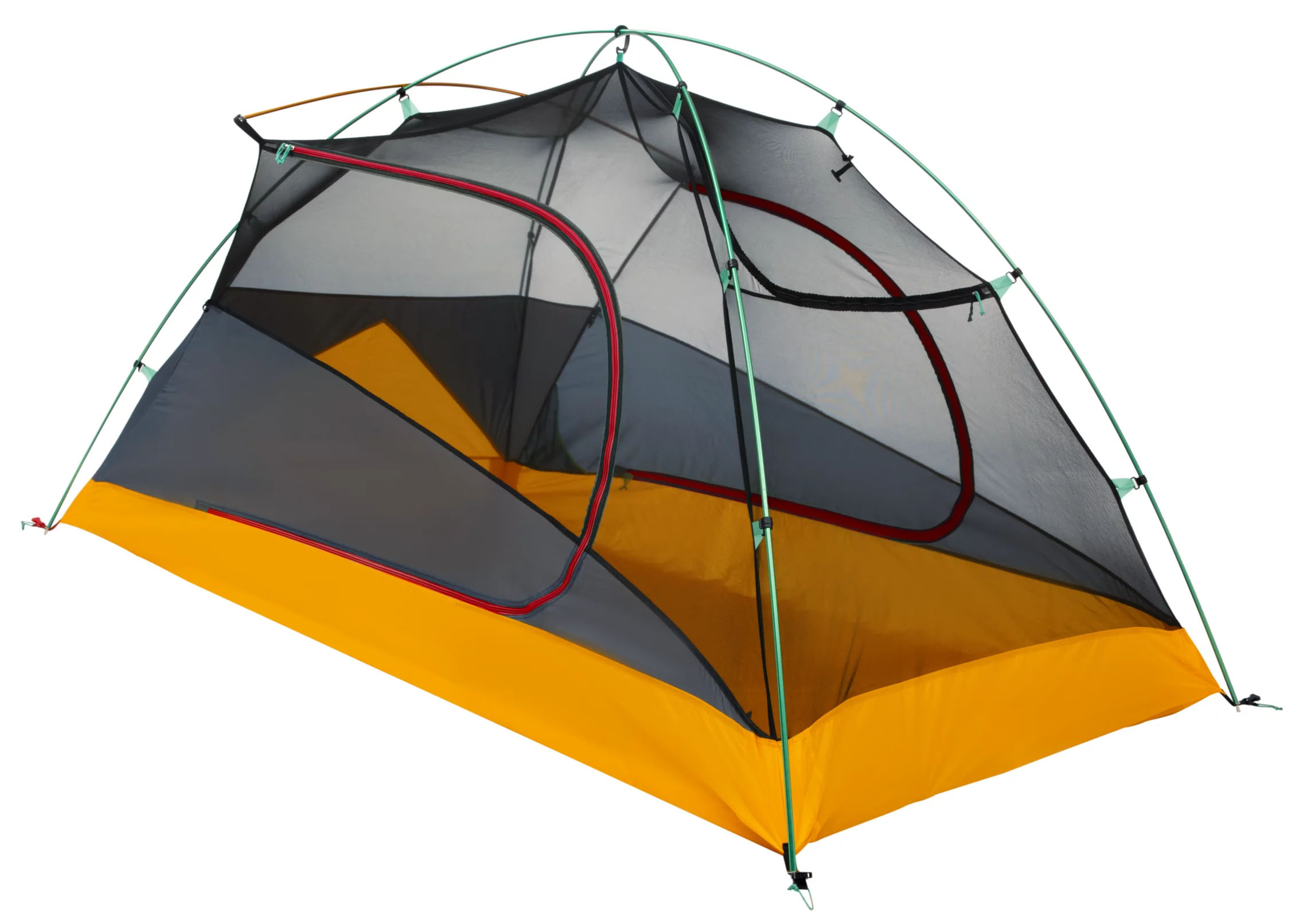
Coleman's name is synonymous with budget camping, but they're making a push into the modern era with collections like their backpacking-ready Peak1. While expensive by Coleman standards, the $270 Peak1 is still a steal in the wider backpacking tent market and stands out in a couple key areas. First is weather protection: The tent is rated to withstand heavy winds (up to 45 mph according to Coleman) thanks to its robust aluminum pole structure and features a full-coverage rainfly and taped seams to seal out moisture. Coleman also included nice touches like reflective detailing for visibility at night, a unique "star view" window that unzips from the inside for stargazing, and a footprint to maximize longevity. It's all wrapped up in an uncharacteristically modern package that competes closely with leading designs like REI's Trail Hut.
At 6 pounds 1 ounce for the two-person version, the Peak1 wouldn’t be our first choice for long and arduous backcountry trips, but it will certainly get the job done for most casual backpackers. Compared to the aforementioned Trail Hut, the Coleman is a couple ounces heavier and about $40 more expensive but gets the slight edge in durability with marginally thicker poles and fabrics (the difference is very minor). In terms of livability, both tents feature 88- by 52-inch footprints, although the Peak1 is 2 inches taller at its peak. The REI has a longer track record of success, but we're excited to see Coleman stepping up their game and look forward to testing the Peak1 this summer. See the Coleman Peak1 2P
9. Big Agnes Blacktail 2 ($250)
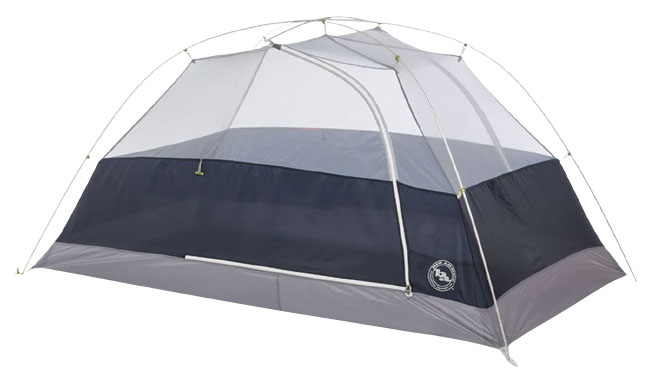
Big Agnes makes some of our favorite lightweight backpacking tents, which feature high-quality construction and a great balance of performance and weight-savings. In the budget category, the Blacktail is their best all-arounder. Essentially Big Agnes’ version of the REI Trail Hut 2, the Blacktail 2 offers a roomy floor plan and generous headroom by way of pre-bent poles and a ridge pole at the apex. Ventilation is high with a good amount of mesh in the body and two rainfly vents, and two doors and two vestibules make living easy for two. Finally, the Blacktail includes the same premium finishes we see in Big Agnes’ pricier designs, including details like a Quick Stash doorkeeper, media pockets with cord routing, and precut guylines.
At $250, the Blacktail 2 will cost you around $20 more than the Trail Hut 2, and unlike the REI design, it’s less likely to be found on sale. On the other hand, the Blacktail is a full pound lighter yet still features durable 68-denier fabrics for the floor and fly. But the Big Agnes does fall a bit in between categories: If we really want to save money, we’ll reach for a tent like the Trail Hut 2 above; if headroom is top priority, the Nemo Aurora is a better pick. But for a well-rounded tent that puts it all together, the Blacktail 2 is a great design with Big Agnes’ tried-and-true quality. See the Big Agnes Blacktail 2
10. The North Face Stormbreak 2 ($185)
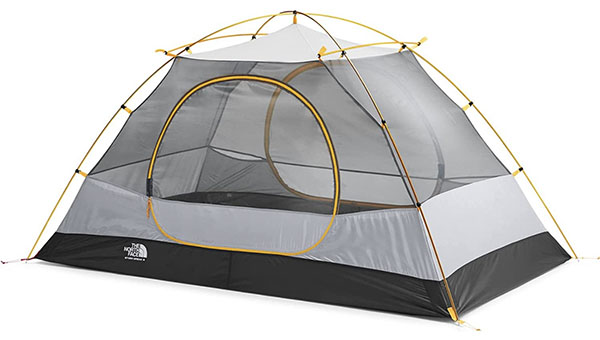
The North Face makes a lot of high-performance tents for expedition use, but their casual lineup also has a lot to offer. For just $185 at full retail price, the Stormbreak 2 is a great value in a two-person backpacking tent. All the elements are there: The Stormbreak is roomy with a non-tapered shape, 50 inches of width, and extended 43-inch peak height (thanks to two ridge poles). It also provides decent weather protection with a full-length fly and has two large doors and vestibules for storing your gear at night. In terms of durability, the TNF uses a burly 75-denier canopy and 68-denier floor, which means it's fully dog- and kid-friendly. All in all, that’s a lot of bang for your buck.
What are the downsides of the Stormbreak 2? With a packaged weight of 5 pounds 14 ounces, it’s among the heaviest two-person tents on this list, on par with the REI Trail Hut 2 and Coleman Peak1 above. It’s also important to note that the Stormbreak’s fly does not feature any venting, which means the tent can overheat quickly in a storm (on a dry night, you can open up your vestibule doors for airflow). Finally, TNF’s budget options don’t knock it out of the park quite like those from REI, and the Stormbreak feels a bit cheaper and less premium overall. But the price is right, and it’s a nice alternative to the Trailmade 2 above for budget shoppers who want a bit more interior space. For a step up in price, it’s also worth checking out TNF’s Trail Lite 2 ($300), which will save you 12.5 ounces. See The North Face Stormbreak 2
11. Big Agnes C Bar 2 ($250)
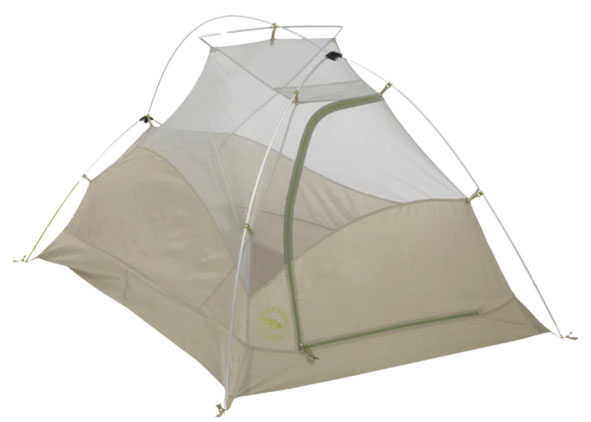
When you opt for a budget tent, there’s no escaping without a little compromise in terms of interior space or weight. But it’s a spectrum: Some tents tack on a few extra ounces for the sake of livability, while others streamline the build in order to keep weight low. Big Agnes’ C Bar 2 falls into the latter category, with a minimalist design reminiscent of their ultralight Fly Creek. You get just one door and vestibule, a mesh-heavy canopy, and a tapered roof and floor area that keep materials to a minimum. It’s a tight squeeze for two—you won’t be able to sit up at the same time as your tent mate and will practically have to crawl over them to get in and out—but at just 4 pounds, the C Bar 2 is the lightest freestanding design to make this list.
For solo hikers or those trying to shave weight from their pack, the C Bar 2 is a really nice budget offering. But the interior space is a far cry from models like the Nemo Aurora and Half Dome SL above, and you’ll have to ask yourself if it’s worth the sacrifice for one less pound. Further, the simplified pole structure (just one pole down the spine) and mesh-heavy design will suffer in heavy winds. If you’re truly serious about streamlining your load, it’s worth considering a more premium tent like the Big Agnes Fly Creek HV UL 2 ($400) or Tiger Wall UL 2 ($450) or opting for a trekking pole-supported shelter like the 2-pound-7.4-ounce Durston X-Mid above. But Big Agnes is one of the top manufacturers in the game, and you’d be hard-pressed to find a lighter freestanding tent at the $250 price point. See the Big Agnes C Bar 2
12. Eureka Midori 2 ($200)
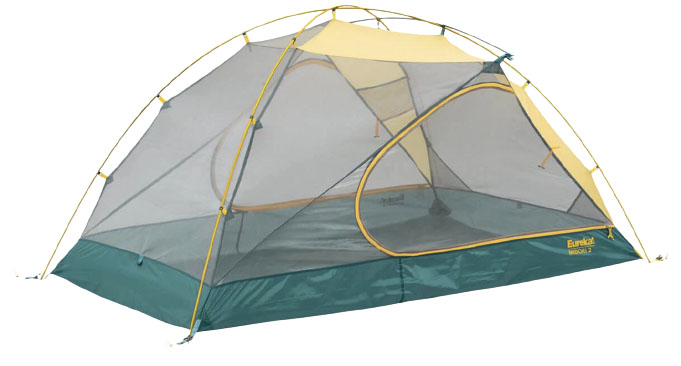
Eureka has been in the tent-making business since the late 1800s, with designs that have been used by the likes of Sir Edmund Hilary, the Boy Scouts of America, and WWII-era U.S. Armed Forces. In 2024, they’re known for budget-priced camping gear (their Ignite Plus is our top-ranked camping stove), and their lineup also includes a few well-priced backpacking tents. The Midori 2 is a great all-rounder for just $200 and features two doors and two vestibules, a relatively spacious interior with an X-shaped pole layout and center ridge pole to boost headroom, thoughtful venting, and easy setup thanks to color-coded components.
We don't usually recommend Eureka products to weight-conscious backpackers (you won’t find any of their tents in our standard backpacking tent round-up ), but the Midori 2 is a great pick for casual users who won’t be hauling their tent for long distances. For the same price as the REI Trail Hut 2 above, you get a bit more room (the Eureka is 3 in. wider) in a 12-ounce-lighter package, and the Midori’s materials are similarly durable at 68 denier. Do keep in mind that the Eureka does not include a footprint, but the hardwearing floor should be ample for most environments. Its build quality can’t quite match that of tents from Big Agnes, Nemo, and REI (the Trail Hut in particular), but the Midori is a viable alternative for those who get out just a few times a year. Note: Eureka's parent company recently announced they will stop selling Eureka products by the end of the year. While that's a loss to the camping industry, it also means it's a good time to keep an eye out for steep discounts in the coming months. See the Eureka Midori 2
13. Marmot Tungsten 2P ($249)
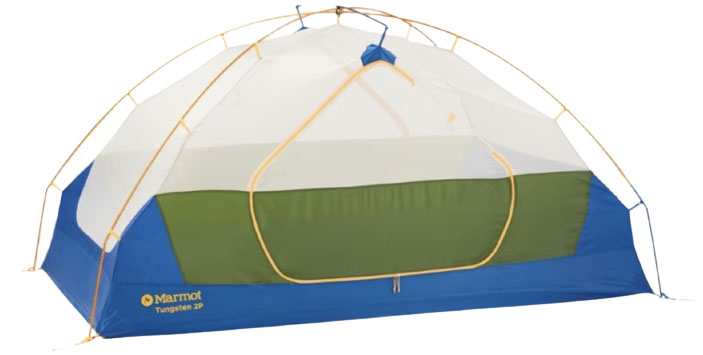
We’ve mentioned REI as a great one-stop-shop for value, but Marmot isn’t far behind. For a decently low price of $249, their recently updated Tungsten is a durable 3-season tent with all the features that most weekend backpackers need. Like the C Bar above, the Marmot features a tapered floor plan (8 in. narrower at the feet), which saves you weight while still offering ample room for two side-by-side sleepers. On the tent body, the mix of solid nylon and mesh provides good ventilation alongside privacy and weather protection, and the updated colorways add a nice amount of flair.
While tents like the Half Dome SL above devote precious ounces to an oversized floor plan, the Tungsten here places a premium on durability above all else. For comparison’s sake, the Marmot’s floor and fly fabric are 70- and 68-denier respectively, while the REI checks in at 40- and 30-denier. But the tapered design isn’t for everyone: You’ll have to sleep shoulder-to-shoulder with your tent mate (some prefer a head-to-toe arrangement for more space), and there’s not a lot of room to sit up side by side. In the end, the REI’s durability is serviceable for most, although the Tungsten makes for a nice hybrid backpacking and car camping option and will save you $100. It’s also worth noting that Marmot makes another well-priced tent in their Limelight 2P ($299), which offers more room at the cost of some added weight. See the Marmot Tungsten 2P
14. Kelty Late Start 2 ($160)
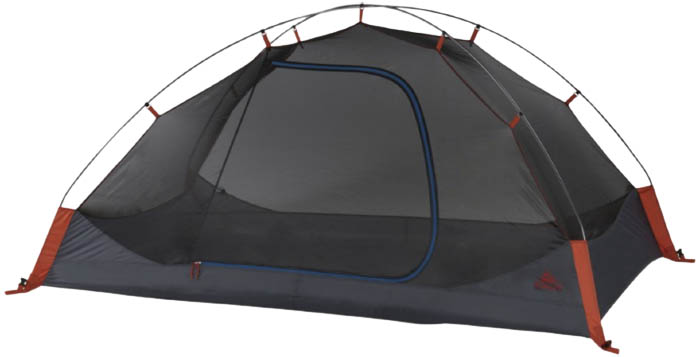
For the true budget seekers among us, Kelty’s Late Start is another decent backpacking tent at a very low price point. This tent is about as simple as they come, with an all-mesh body and bathtub floor, simple crisscrossing pole structure, and one door and vestibule. Set up is a breeze with pole sleeves at each corner (this is a bit archaic, but it still gets the job done), and despite the robust 68-denier fly and floor, the Late Start is competitively lightweight at just 4.5 pounds. For summer backpackers who want to keep their pack weight in check, it’s a roomy alternative to the cramped C Bar 2 above.
That said, the Late Start slots in toward the bottom of our rankings for a few reasons. First off, unlike designs like the Trail Hut and Aurora above, the Kelty is not sold with a footprint. In most cases, we’d have no qualms pitching this tent directly on the ground (the 68D floor is thick enough to withstand contact with sharp rocks and branches), but it’s still a noteworthy omission. Further, the Late Start features a tapered floor, limiting interior space and forcing you to sleep shoulder-to-shoulder with your partner. And finally, the all-mesh canopy is not ideal in high winds. But for a low-cost backpacking tent that’s lighter than most, the Late Start earns a spot on our list. And if you’re in search of even more savings, it’s also worth checking out Kelty’s 2-person Ashcroft ($125) and Tanglewood ($90) tents. See the Kelty Late Start 2
15. Alps Mountaineering Lynx 1 ($120)
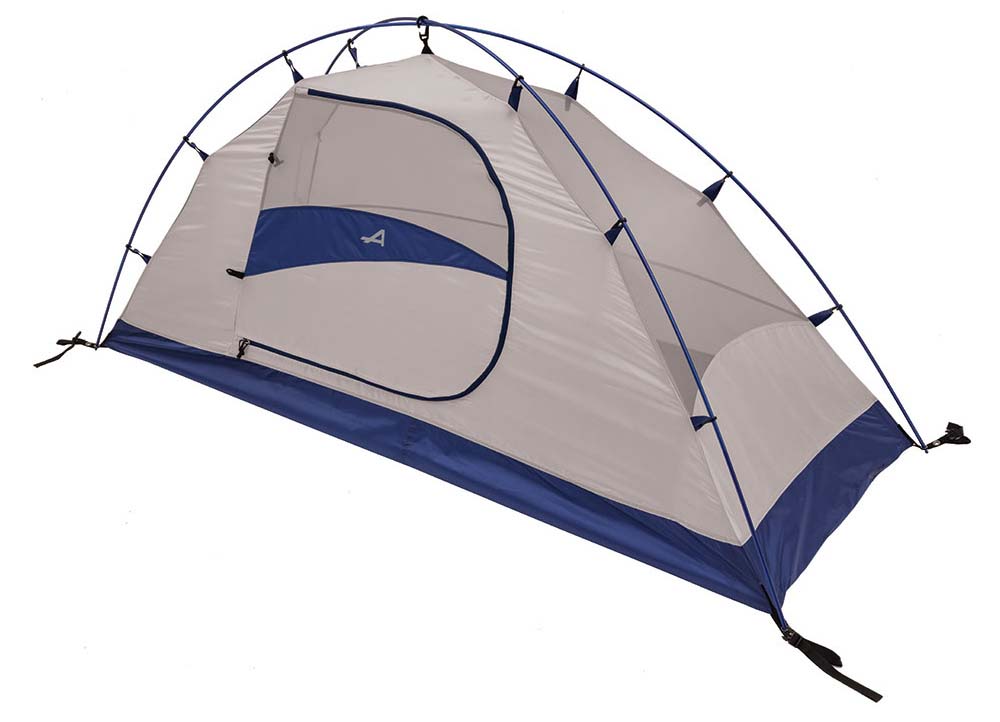
Alps Mountaineering is not at the forefront of innovation, but they certainly win out in terms of price. For just $120—and commonly found on Amazon for less than $100—the Lynx 1 is a great value for solo backpackers. It’s roomy for one, offers good weather protection and ventilation including two vents up top, and has a large door and vestibule for storing your gear at night. The Lynx is also pretty tough with a burly 75-denier floor and substantial zippers, which is great for those who are hard on their gear.
For folks that consistently travel alone in the backcountry, a one-person tent is a really good option to consider. You obviously lose the versatility of a 2P model, but otherwise there aren’t a whole lot of downsides to the streamlined floor plan, and you even get enough room for a canine companion. Within the one-person tent market, it's also worth checking out the REI Co-op Trailmade 1 ($179) and Kelty Late Start 1 ($140), but the Lynx wins out in price and weather protection (thanks to more solid fabric in the tent body), and is a half-pound lighter than the Trailmade to boot. It’s for good reason that Alps has carved out a following among beginner backpackers and those on a tight budget. Just be sure to set reasonable expectations in terms of material and build quality. See the Alps Mountaineering Lynx 1
Budget Backpacking Tent Comparison Table
About our testing process.
As longtime gear testers and reviewers, the Switchback Travel staff has watched tents soar in price over the years, so we’re intimately familiar with the plight that new backpackers face. Former senior editor Jenny Abegg compiled our initial list of 10 wallet-friendly picks in 2022. An avid mountain runner and rock climber, Jenny has spent countless nights outside and is always on the hunt for a good value. Contributing editor Nick Mott took over the guide in 2024. Nick’s time spent hauling heavy loads deep into wilderness areas all over the West has given him a keen eye for the weight, durability, and performance required of a quality backpacking tent.
Our collective experience in the backcountry—along with feedback from contributors and the online backpacking community—helped us whittle down our list to the 15 picks you see above. When we put backpacking tents to the test, our primary considerations are weight and livability (our favorites strike a nice balance between the two). At the same time, we also take into account weather-worthiness, ease of setup, and storage (both internal and external). Of course, price is a big factor for many, and it’s a critical ranking criteria for our budget picks above. Since the market is constantly evolving, we continue to put new and noteworthy designs to the test, making changes to the list above based on our experiences.
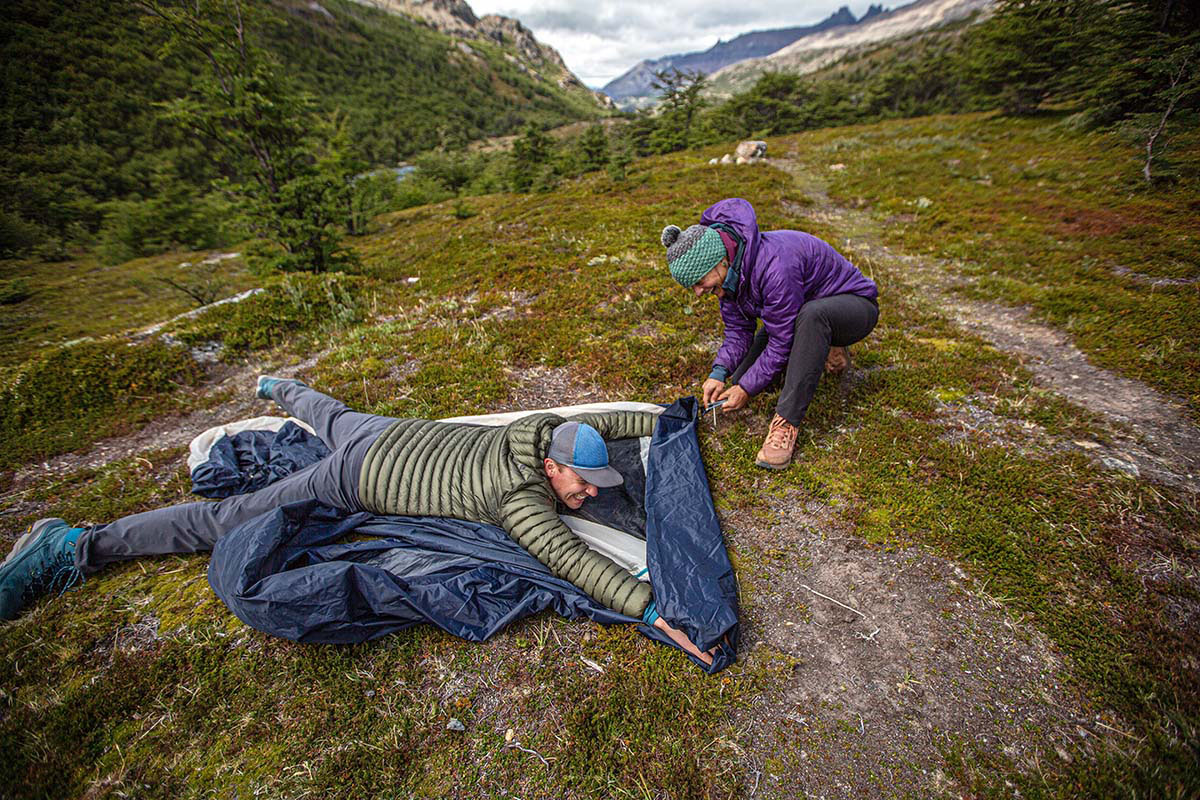
Budget Backpacking Tents Buying Advice
How we define a "budget" backpacking tent.
- Weight and Packed Size
- Interior Space
Packaged Weight vs. Trail Weight
Fabric durability (denier), weather protection, ventilation, storage: vestibules and interior pockets, backpacking tent capacities, set up and take down, tent poles and stakes, do you need a footprint.
By our own definition, a budget backpacking tent checks in for $300 or less, with some priced as low as around $100 (the one exception above is REI's $349 Half Dome SL 2+ ). Given that you can spend upwards of $500 on a backpacking tent, there’s no denying that the models here will save you a lot of cash. Of course, it goes without saying that budget tents have their fair share of tradeoffs, especially in terms of weight, packed size, and interior space. But if you’re willing to compromise a little in those areas, the tents here are great and functional low-cost additions to any backpacking kit.
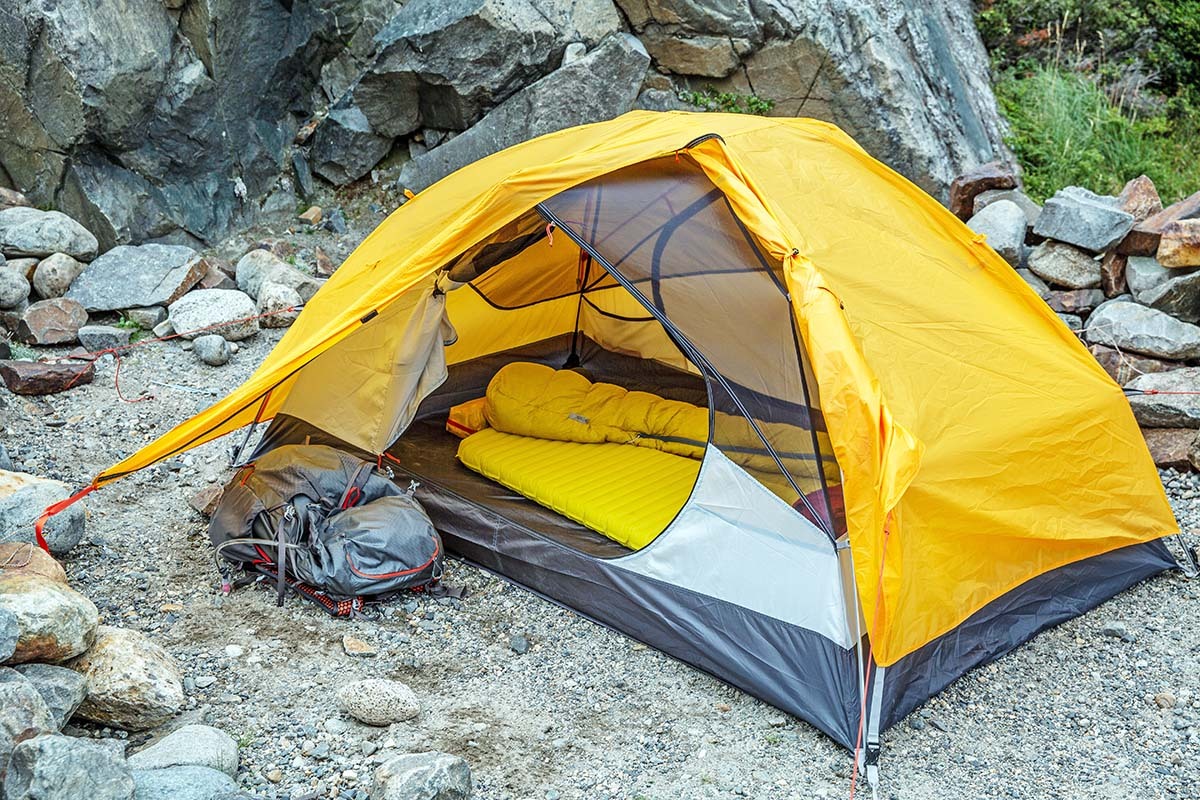

Budget Backpacking Tent Considerations
Weight and Packed Size While premium backpacking tents typically clock in between 2 and 4 pounds for two-person designs, the majority of budget tents hover around 4 to 6 pounds all in (by "all in" we mean the packaged weight, which we explain in more detail below). The reason for this is that manufacturers are able to cut costs considerably by using thicker fabrics, heavier components, and less innovative engineering practices. For casual backpackers who aren’t covering too much ground or only get out a few times a year, the added 1 to 4 pounds shouldn’t be too big of a downside (plus, all of the tents above include a separate tent body and rainfly, meaning you can easily split up the various components with your tent mate). However, if you’re looking to log some serious mileage or want to keep your backpack weight low, it may be worth investing in a lighter and more premium option.
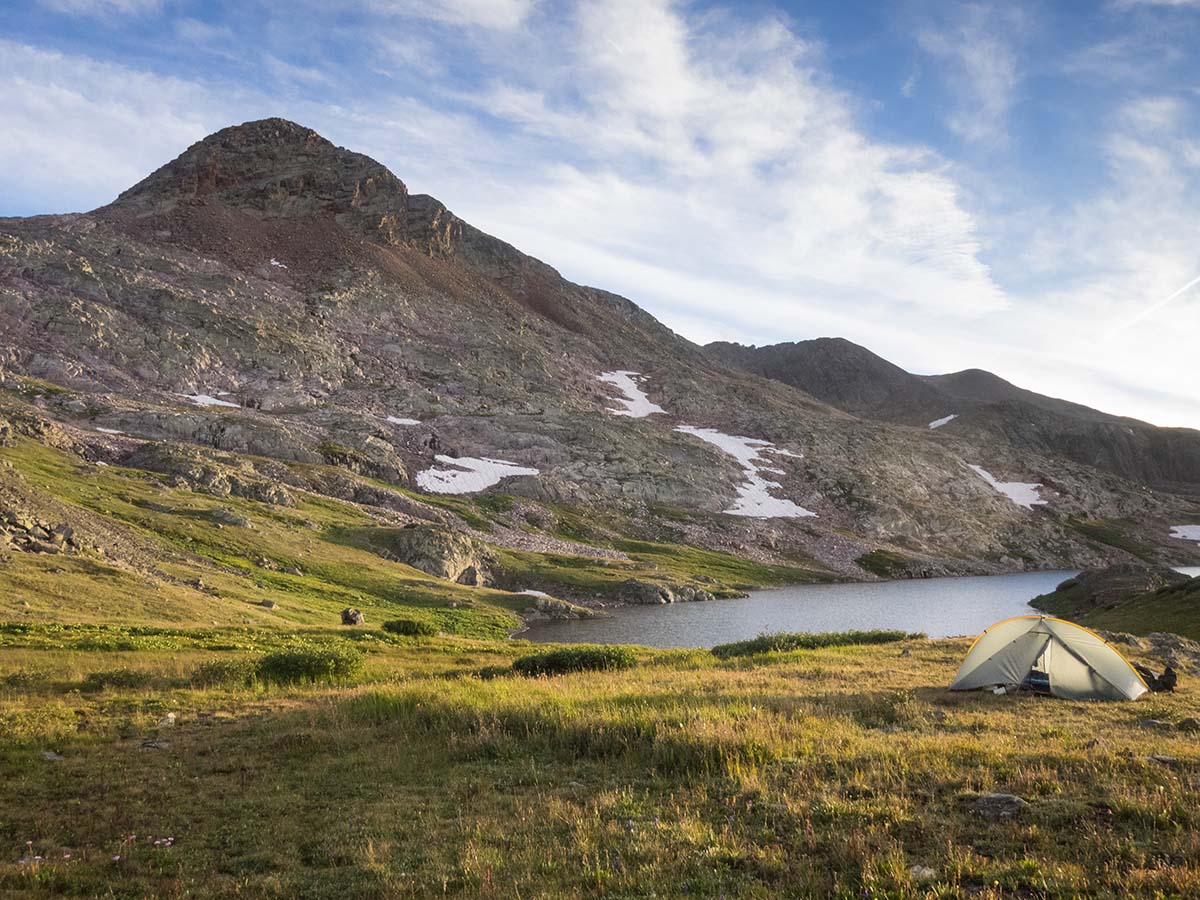
In the majority of cases, packed size also increases with weight, meaning that most budget tents will take up more space in your backpack than premium models. This isn’t great news for those who like to keep a streamlined load, but most entry-level backpackers aren’t carrying sub-50-liter ultralight packs to begin with.
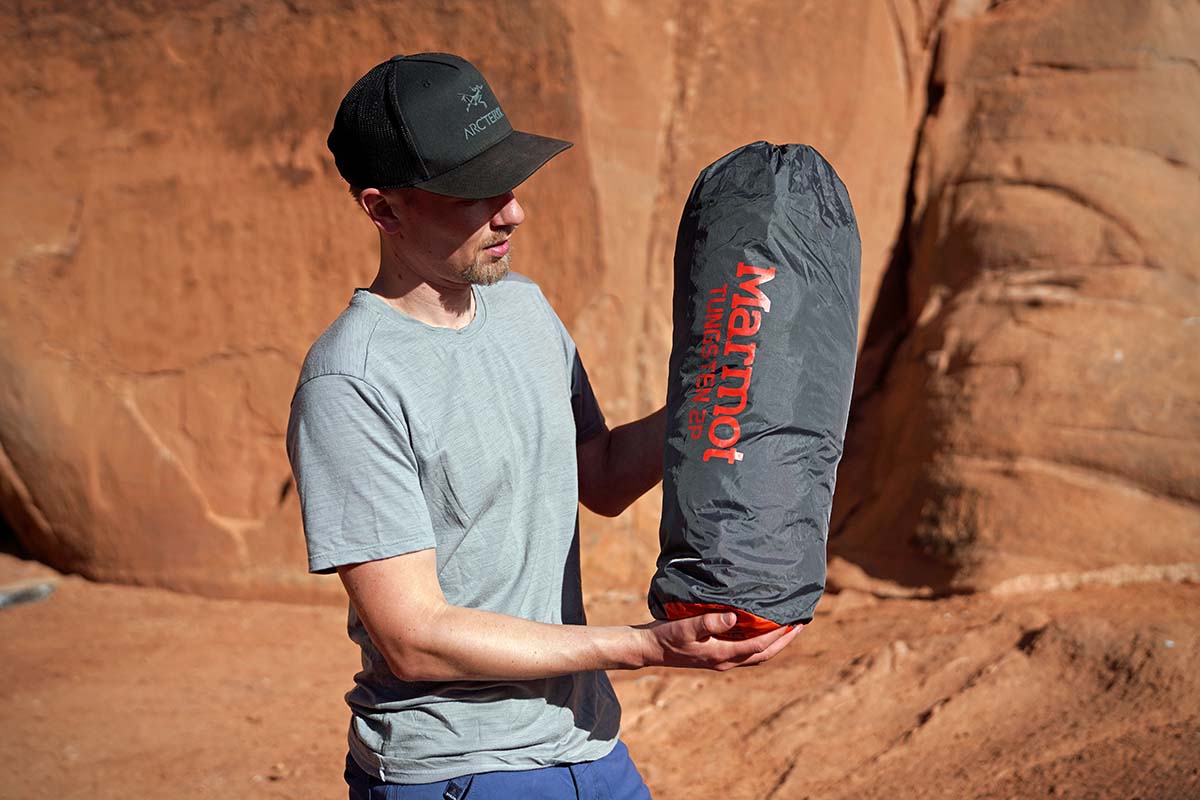
Finally, if you’re not keen to compromise on weight and packed size, there are a few other options for staying within a budget. Solo hikers can opt for a one-person tent, which will generally save you about a pound. For example, the REI Trailmade 2 clocks in at 5 pounds 7 ounces, while the one-person version weighs 4 pounds 9 ounces. Alternatively, it may be worth considering a more affordable ultralight design like the Durston X-Mid 2 ($280) or Tarptent Double Rainbow ($299) mentioned above, which weigh just 2 pounds 7.4 ounces and 2 pounds 9.6 ounces respectively. Trekking-pole shelters require a little extra care to set up—and they’re generally pricier than true “budget” options—but the weight savings will be well worth it for some. If you're looking to shed weight from your pack, check out our article on the best ultralight tents .
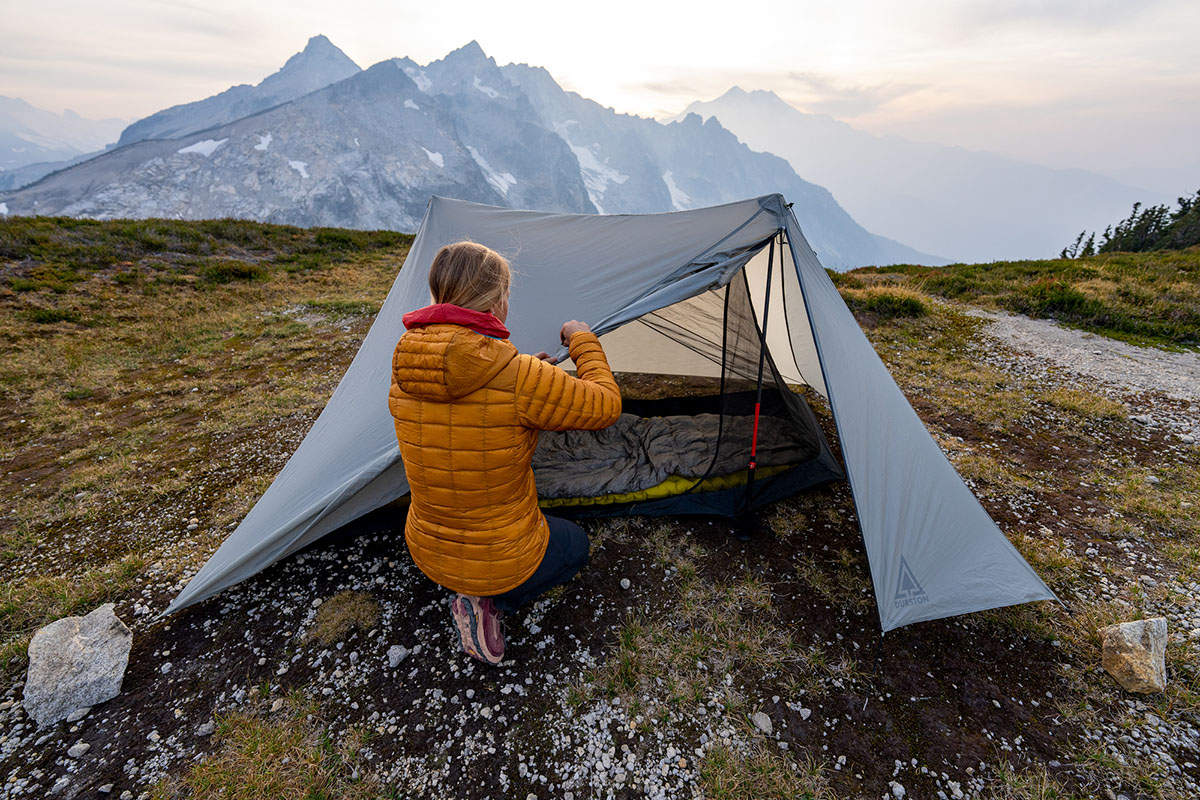
Interior Space Livability is another place where budget backpacking tents take a real hit compared to the pricier and more premium models. Most two-person tents have similar floor dimensions regardless of their price (and tapered designs exist in both the premium and budget worlds), but the real difference comes in terms of headroom. Tent designers have found a lot of ways to increase a tent’s peak height throughout—including pre-bent poles, ridge poles, and steep walls—creating a lot more space to move around and sit up side-by-side with your tent mate. However, all of these tweaks cost money, so we don’t see them all too often in the budget market.
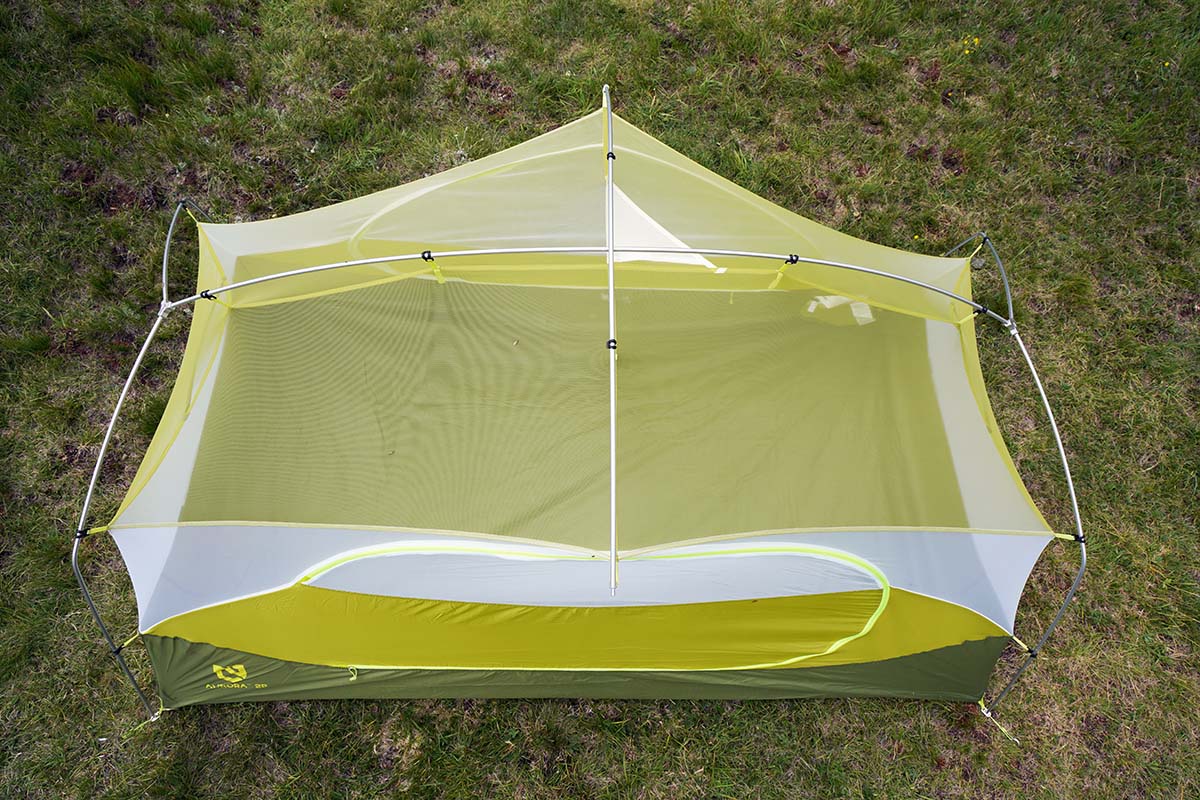
For those looking to maximize livability while staying within a budget, there are a few models to consider, including REI Co-op’s Half Dome SL 2+ and the Nemo Aurora 2P . These tents use the components mentioned above to maximize interior volume and provide considerably more interior space than the more simplistic bargain-basement designs. It’s true that both the Half Dome and Aurora are on the pricier end of the spectrum at $349 and $300 respectively, but the extra investment may be worth it for the boost in comfort—especially for those that anticipate hunkering down in inclement weather or contending with pesky mosquitos.
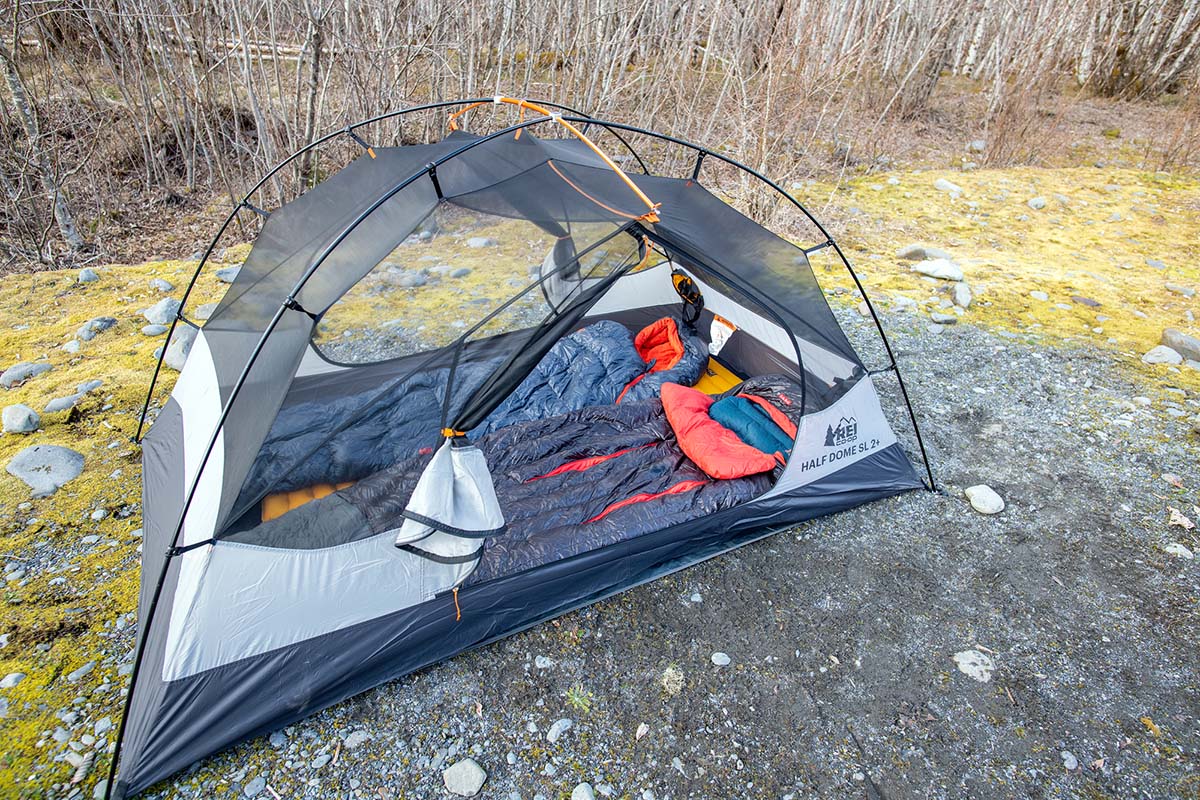
When researching tent weight, you’ll commonly see manufacturers and retailers list two specs: packaged weight and trail weight (also sometimes referred to as "minimum weight"). The former includes everything that comes with the purchase of the tent, including the tent body, rainfly, poles, stakes, guylines, stuff sacks, and footprint (when applicable). The trail weight, on the other hand, only covers the tent body, rainfly, and poles. We’ve chosen to list packaged weight in the specs above—it’s closer to what most folks realistically bring—but keep in mind that you can trim ounces from there.
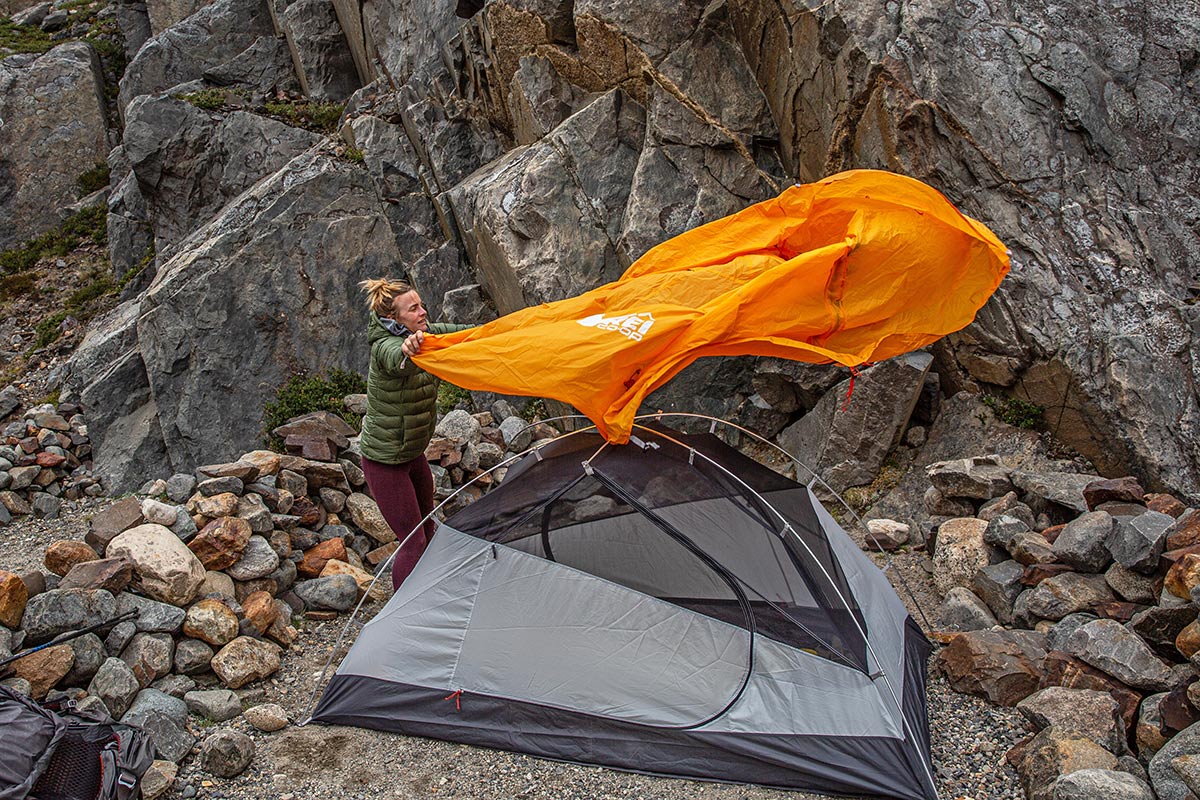
One of the easiest ways to think about tent durability is to consider the thickness of the fabric, which is measured in terms of denier (technically speaking, the weight of the yarn). The higher the denier—of the floor, canopy, and rainfly—the more durable the tent. Logically, denier lines up with weight, which is great news for budget tents (as we mentioned above, a hallmark of budget tents is their heft). For example, the premium Big Agnes Tiger Wall ($450; 2 lb. 8 oz.) has a thin 15-denier floor, while the 5-pound-14-ounce TNF Stormbreak 2 ($185) uses a robust 68-denier fabric. Because the area most vulnerable to punctures or tears is the floor, this is the number we list in the specs and comparison table above.
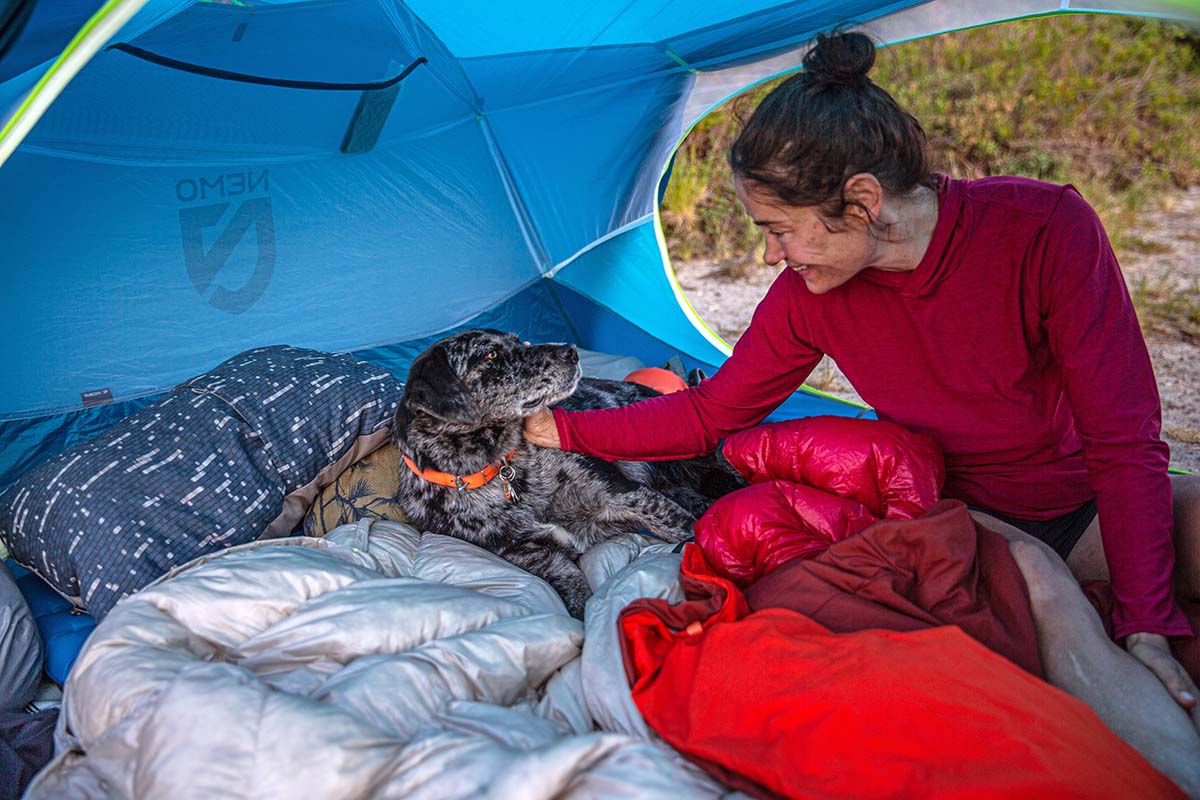
While fabric thickness is a large factor in determining a tent’s durability, it’s not the only one. The quality of the rest of the materials (poles, zippers, etc.) also plays a part, as does the attention to detail. And while premium tents will often add a silicone coating (also referred to as “silnylon”) to their thin fabrics for additional tear strength and longevity, we don’t see this technology on budget designs. We’ve learned to trust the build quality of budget tents from leading manufacturers like REI, Nemo, and Big Agnes, but you’ll want to be a bit more careful with dedicated budget brands like Alps Mountaineering and Eureka, which specialize in the entry-level market. All that said, in most cases, increased durability is a significant and surprising benefit of opting for a budget model.
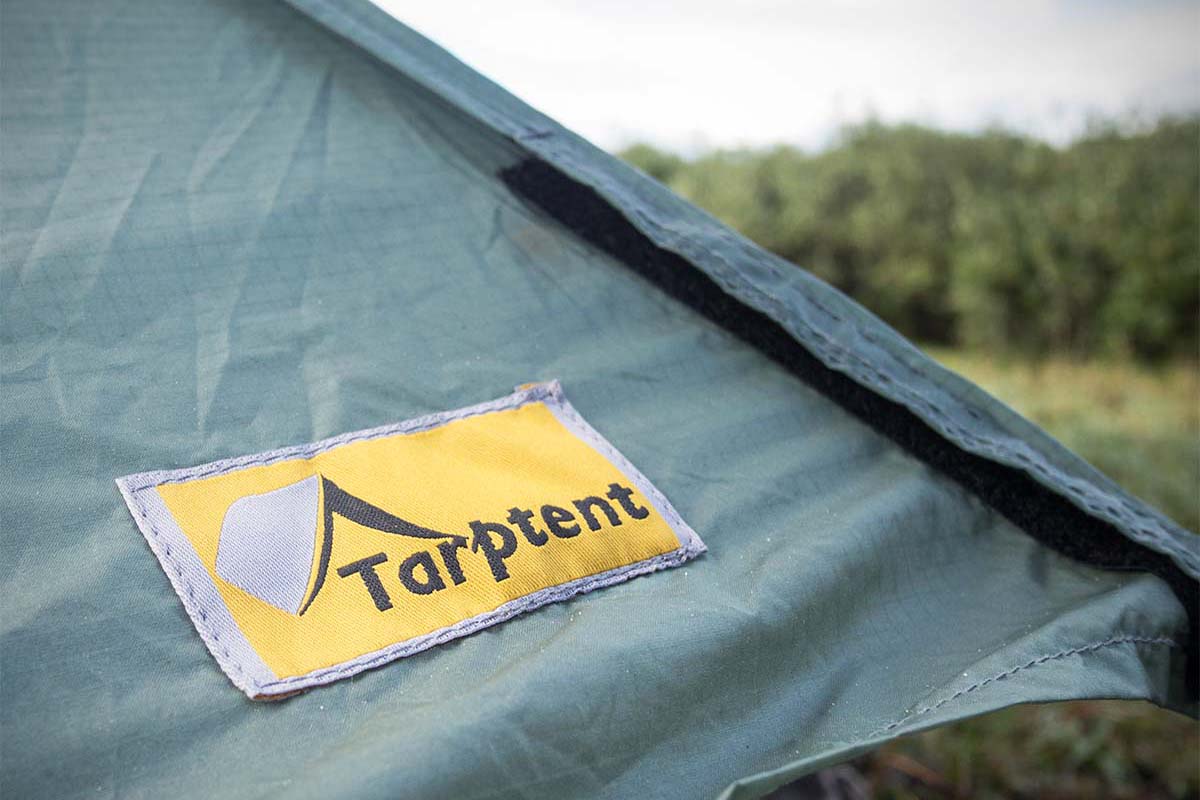
Protection from the elements is one of the primary functions of a backpacking tent . In general, budget tents do a respectable job keeping out wind and rain and perform on par with much of the more premium competition. Your first line of defense is a rainfly, and you’ll want to look for coverage extending below the bathtub floor of the tent body to maximize weather protection (manufacturers sometimes shorten the length of parts of the fly to save weight). A generous bathtub floor is also important for guarding against splashes and puddles. Finally, it’s important to evaluate the tent’s overall structure, including strong poles and lots of exterior ties to anchor it down in heavy winds.
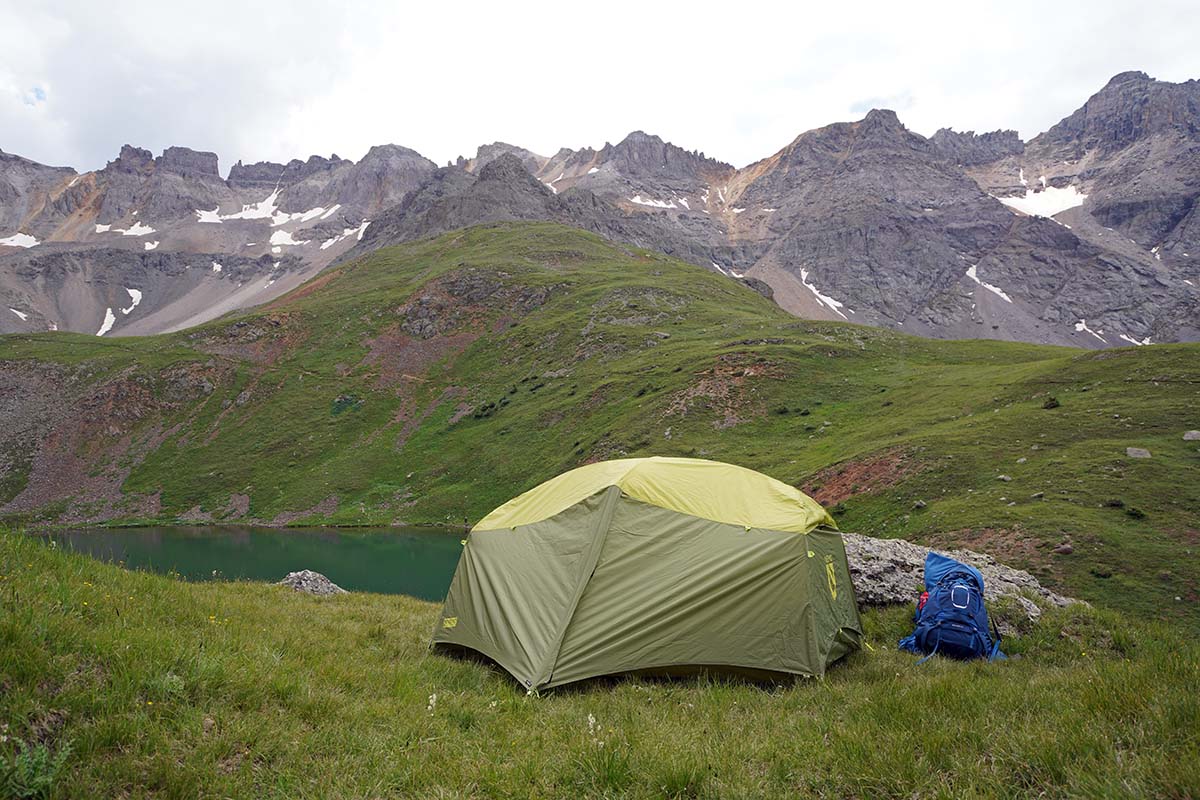
If you’re like most backpackers and get up into the mountains just a few weekends a year during the summer months, you shouldn’t have any issue with the tents above. A full-mesh tent like the Kelty Late Start will offer the least amount of protection, while a design with more solid materials in the canopy (like the Trail Hut or Lynx) will be a better match for bad weather. However, you’ll want to be careful not to push any of these tents too hard in extreme conditions. If heavy winds or snow are in the forecast, a true four-season tent will be much more capable and confidence-inspiring. We don’t see a lot of budget designs in the four-season category—these tents are highly engineered for tackling bad weather—but there are some more affordable options to consider, including the Alps Mountaineering Tasmanian 2 ($250).
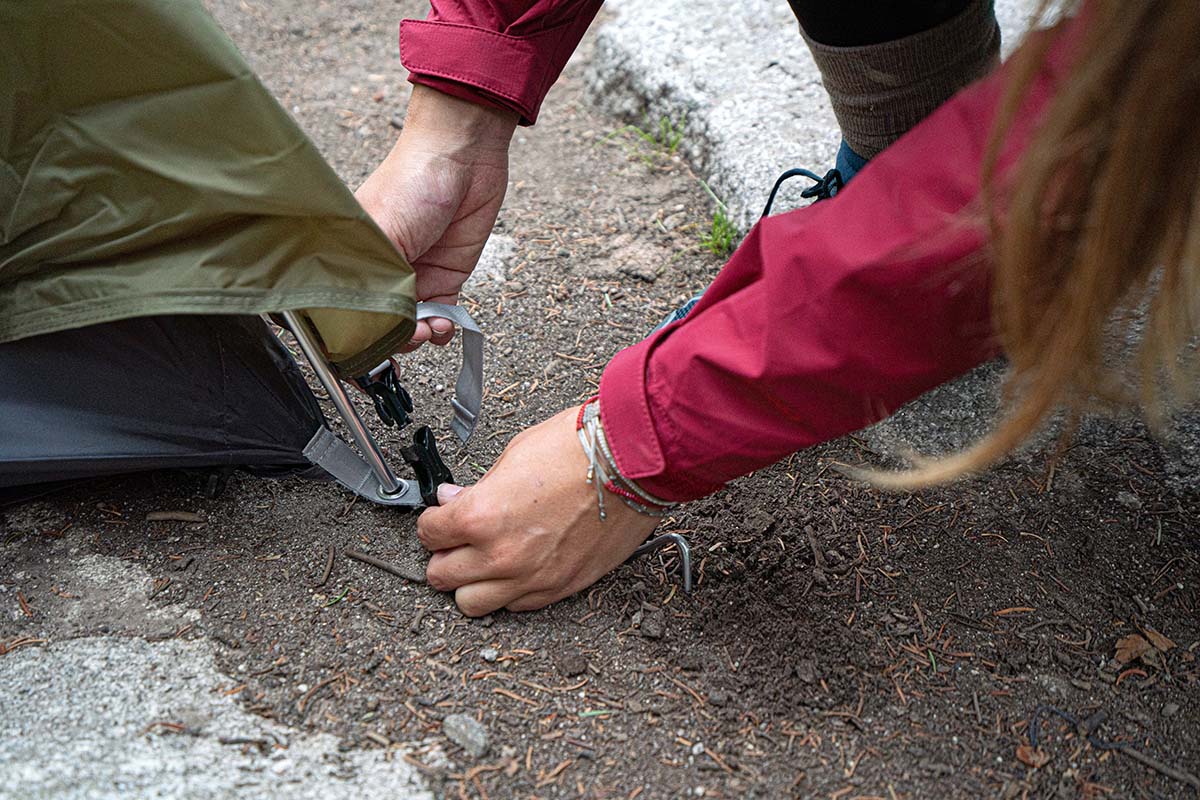
Like weather protection, ventilation doesn’t take too big of a hit in the budget market. Ventilation depends on two main factors: the amount of mesh on the tent body and the quality and quantity of vents in the fly. Most budget tents have generous mesh panels, which are great for keeping air circulating—in good weather, you can even leave the rainfly off for unmitigated airflow. With the rainfly on, things get a bit trickier: Given the waterproof fabrics and sealed seams, breathability is inherently compromised. For this reason, fly vents are vital, and in general are fairly well-executed in the designs above (although they're notable omissions on the TNF Stormbreak 2 and Kelty Late Start). For more on tent ventilation, see the buying advice section in our article on the best backpacking tents .
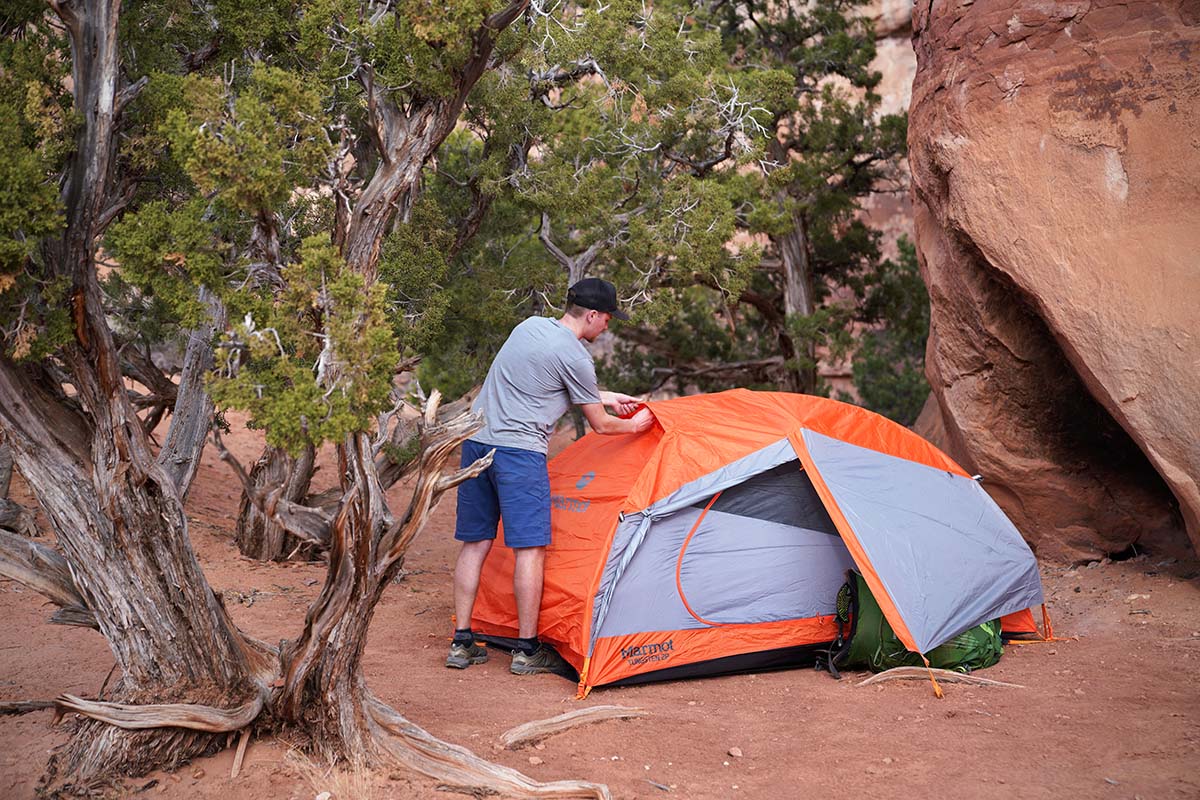
Like the higher-end competition, budget backpacking tents feature a range of storage options, including vestibules and both interior pockets and gear loops. Vestibules are indispensable for organizing your gear at camp: They cover the tent’s door while leaving enough space for items you don’t want in your sleeping area, including your backpacking pack and hiking shoes. In general, budget designs stack up very well to their pricier counterparts in vestibule space: For example, the REI Co-op Trailmade 2 ($199) boasts 19 square feet split between the two sides, while a premium option like the Big Agnes Copper Spur HV UL2 ($530) has a comparable 18 square feet of space. However, be on the lookout for tents that feature just one vestibule (and door), including the Kelty Late Start and Big Agnes C Bar, as these are far less convenient for two campers to stash gear and move around in comfortably (more on this below).
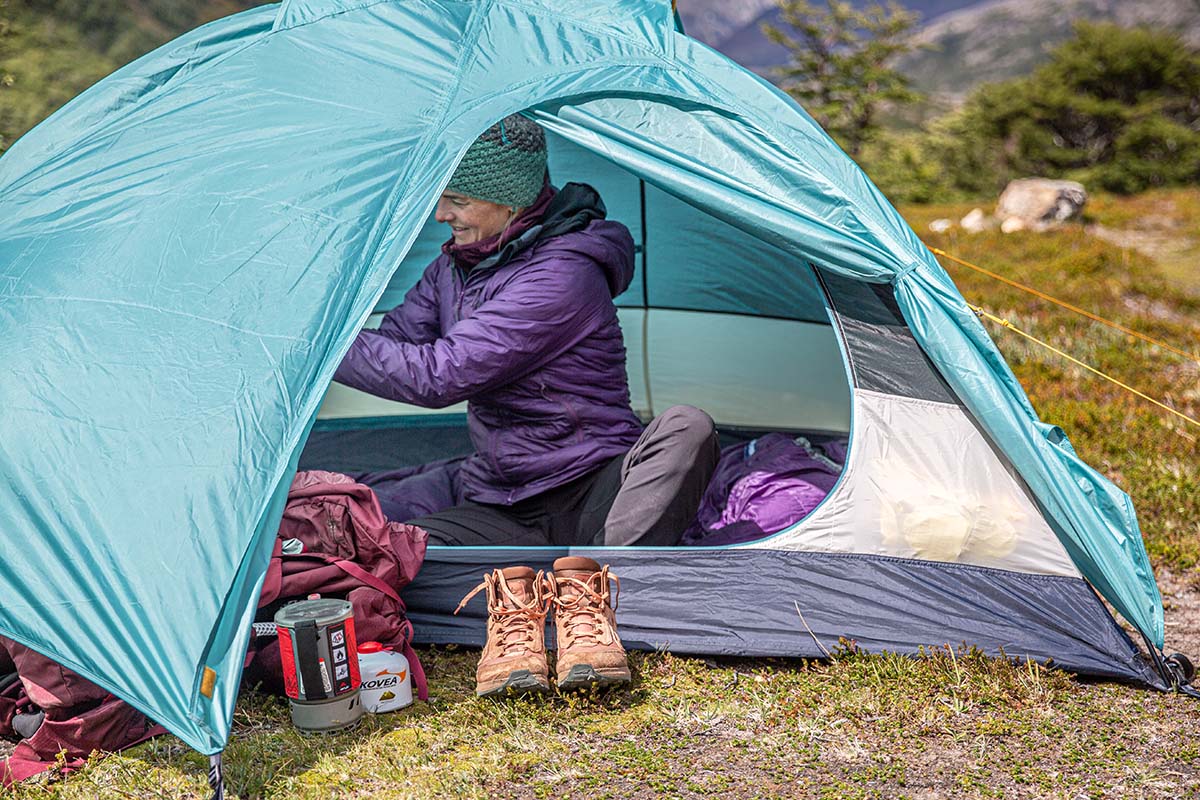
When it comes to interior storage, the budget market often has a bit less to offer. It’s standard to see fairly streamlined feature sets, including just a few pockets and gear loops. On the other hand, pricier tents might have a larger variety of stash pockets, light-diffusing pockets or built-in light strips, thoughtfully placed gear loops, and more. In general, higher-end budget designs are a great middle ground between those two extremes, including the Nemo Aurora and REI Half Dome SL. If you spend a lot of time basecamping or delight in keeping the interior of your tent organized, you'll want to opt for one of these more featured options.
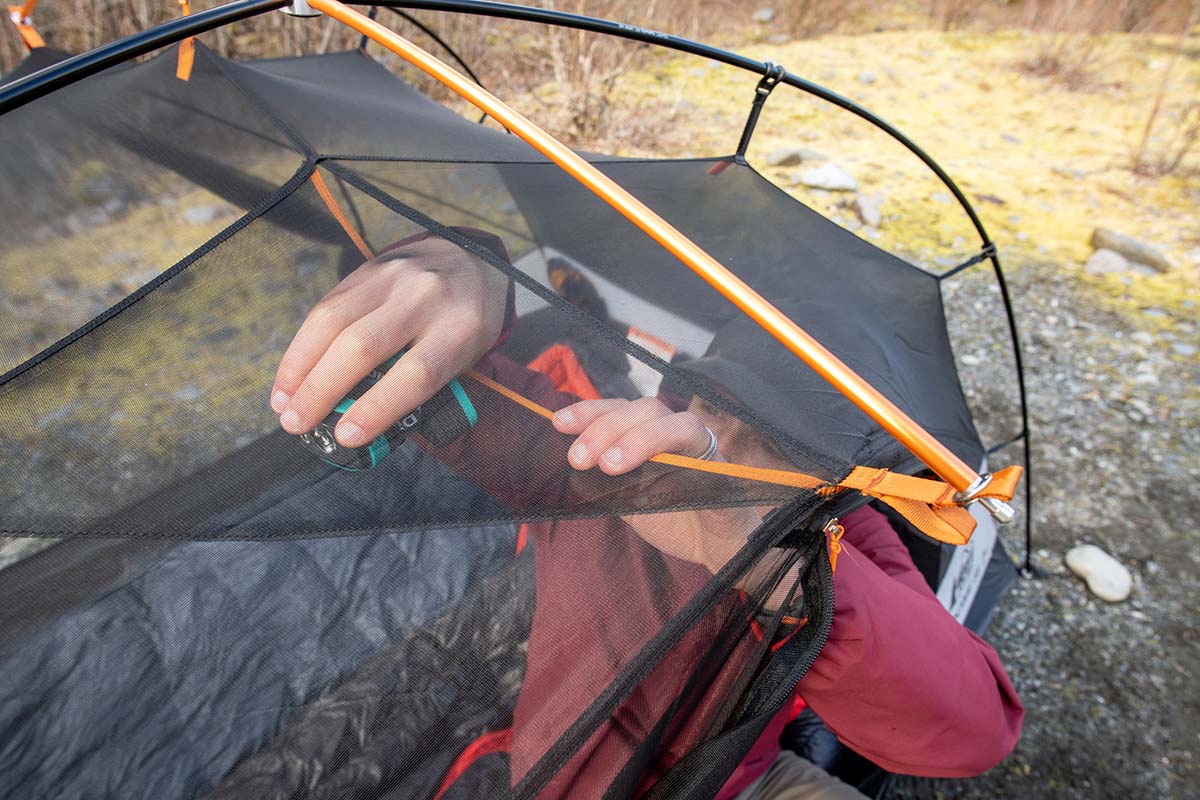
The majority of tents above feature two doors, which is by far our favorite configuration. If you plan to consistently camp with a partner, it’ll likely be your preferred setup too. For reference, a few models above use just one door to save weight—the Big Agnes C Bar 2 has one on its end, while the Kelty Late Start puts its entry on the side. If you’re sharing the tent with a partner, this can be a major downside—you’ll be crawling over your tent mate to get in and out and will be limited to one vestibule for exterior storage. In the end, unless you’re traveling alone or pulling out all the stops to save weight, we recommend a tent with two doors.
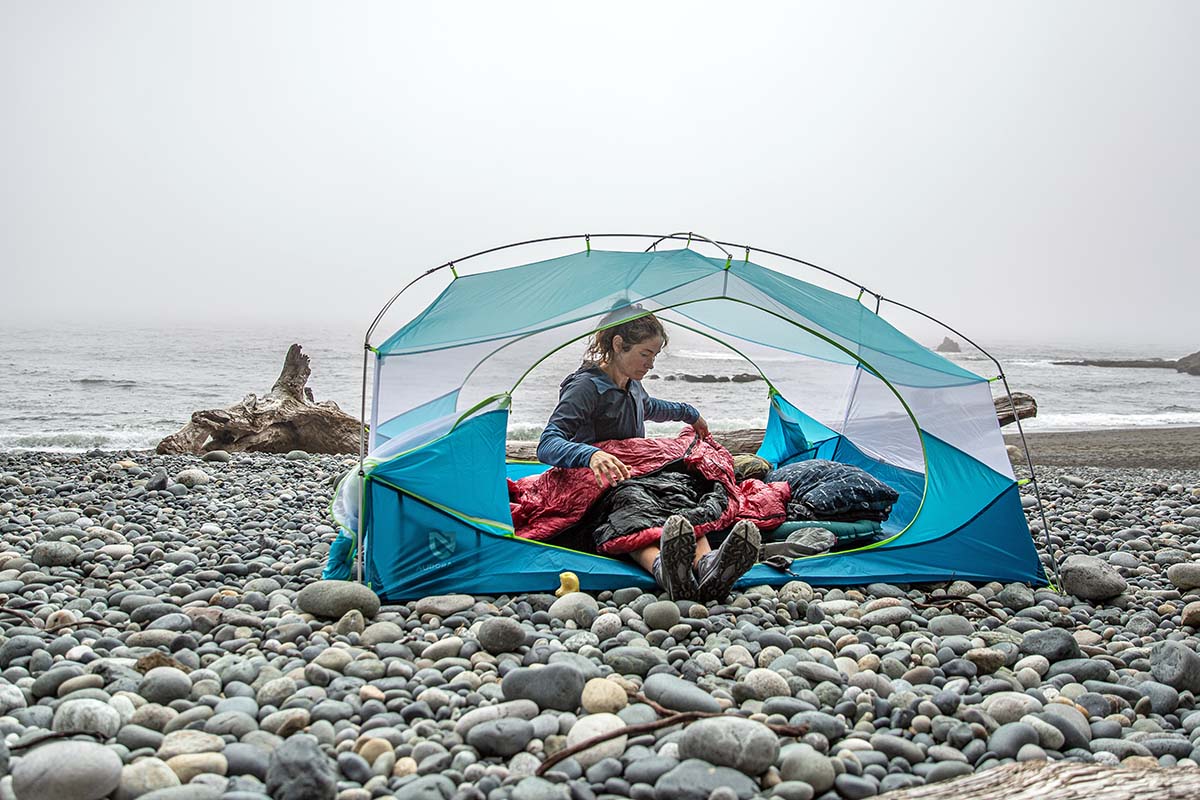
Most of the backpacking tents above are of the two-person variety, with floor plans that can accommodate two 20-inch sleeping pads side-by-side. The two-person tent is the most popular capacity, but many backpacking models also come in one, three, and four-person designs. Solo travelers can save some weight by opting for a one-person option (like the Alps Mountaineering Lynx 1), while families or couples traveling with a dog can bump up to a three- or four-person model. It almost goes without saying that weight and packed size will increase alongside capacity, but it is worth noting that, in general, one four-person tent will be lighter than two two-person models. For example, the Marmot Tungsten 4 checks in at 9 pounds 3.8 ounces, while the two-person version weighs 5 pounds 14.2 ounces.
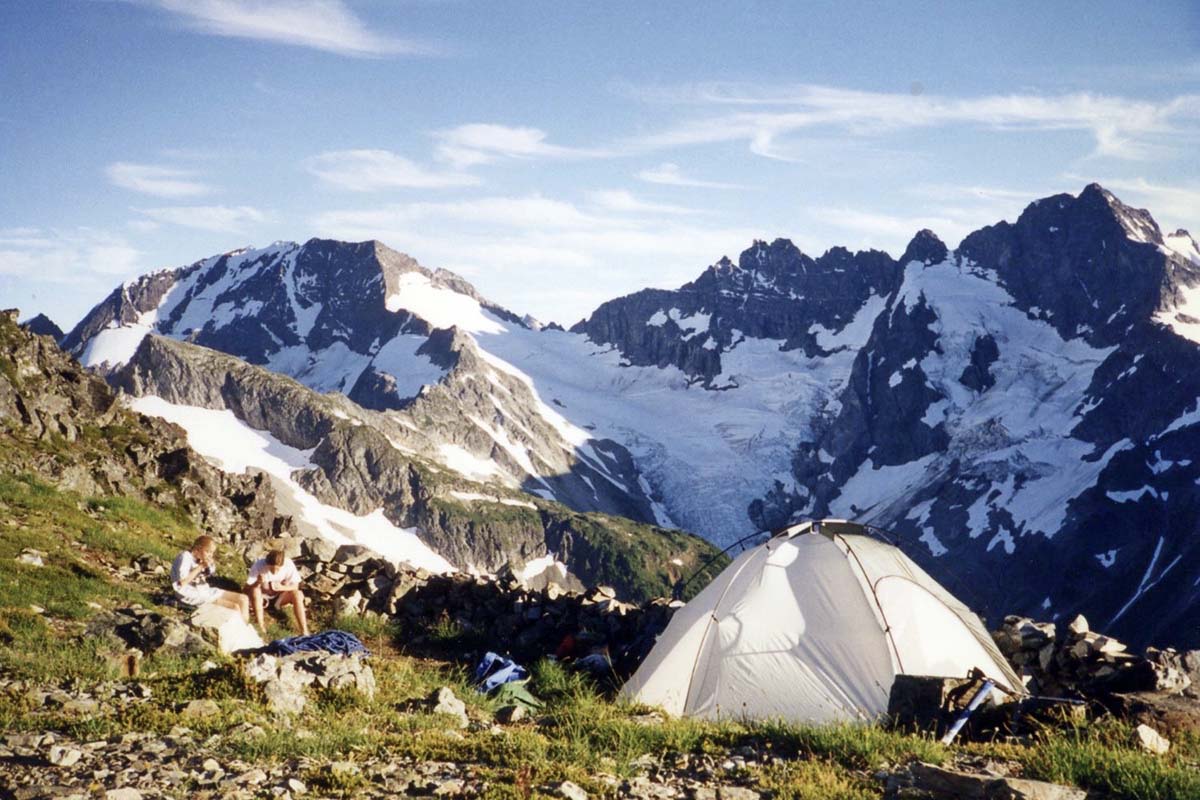
Setting up a modern tent has become surprisingly easy, with simple clips and grommets that take a matter of seconds to attach and streamlined poles that come together with ease. Some budget tents even feature sleek additions more commonly seen in the premium market, including color-coded components, hubbed pole structures, and clip attachments to secure the rainfly. On the flip side, some of the more basic models forgo most of these features, and tents like the Kelty Late Start have kept things pretty old-school with sleeves to run the poles through. Gripes aside, all of the tents above are fairly quick and intuitive to pitch, even for the greenest of backpackers. The whole process usually takes just a few minutes from start to finish, which is fantastic.
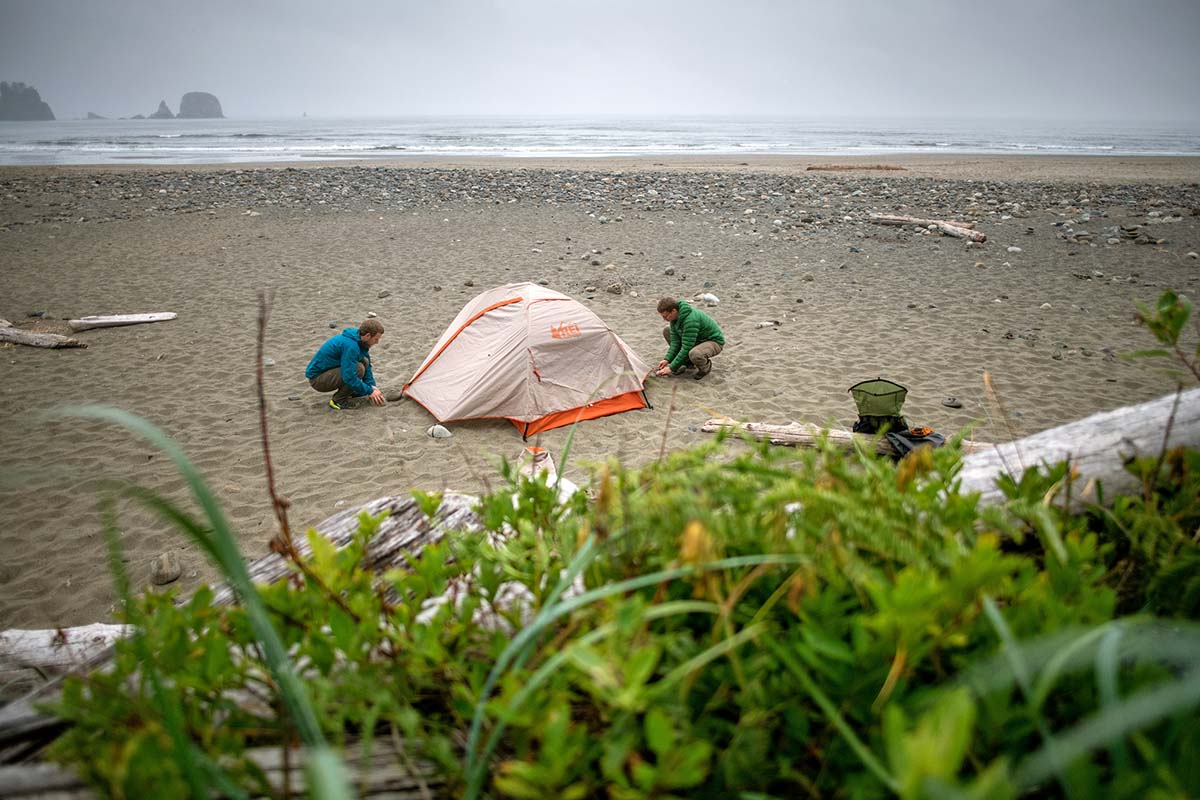
Without getting too into the nitty gritty on tent poles and stakes, there are a few things we want to mention with respect to budget tents. In terms of poles, most are made with simple aluminum, which is decently durable but heavier than the premium aluminum and carbon fiber found in pricier designs. We also see a lot of simple pole layouts in the budget world: For example, the REI Co-op Trailmade 2 features two poles of identical length that crisscross at the apex of the tent and are held secure by a large clip attached to the tent body. Getting into the more premium side of the budget market (including models like the Half Dome SL 2+ and Nemo Aurora 2P), we start to see more complex pole structures, including the addition of a ridge pole at the apex and hubbed poles, which offer more rigidity and easier setup.
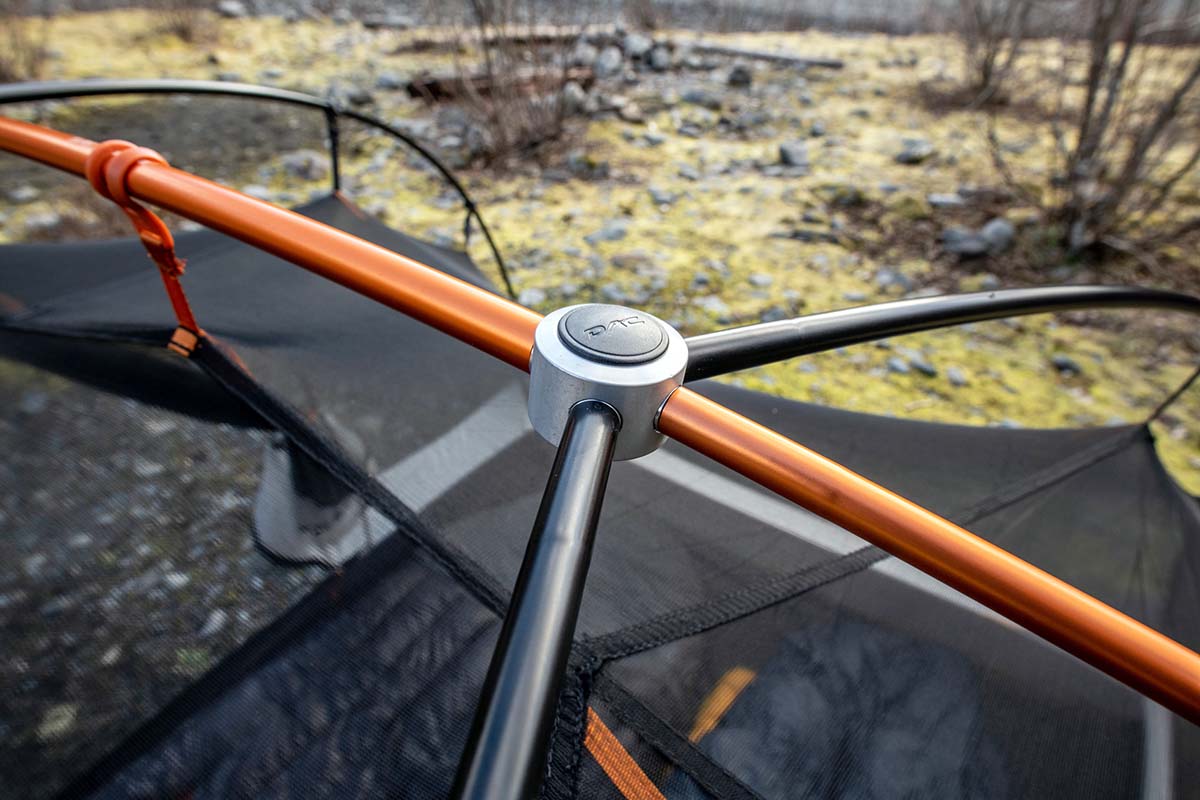
Most two-person budget tents will come with about six stakes: one for each corner and one for each side of the vestibule. In general, these stakes are of the hook-style aluminum variety, which are heavy and can be a pain to use: They're often too thick and round to sink easily into the ground and have a tendency to bend when being hammered in. To be sure, they'll do the trick for most, but upgrading isn’t very expensive. We especially like the MSR Groundhog Stakes : They are light, tough, and easy to pound reliably into the ground.
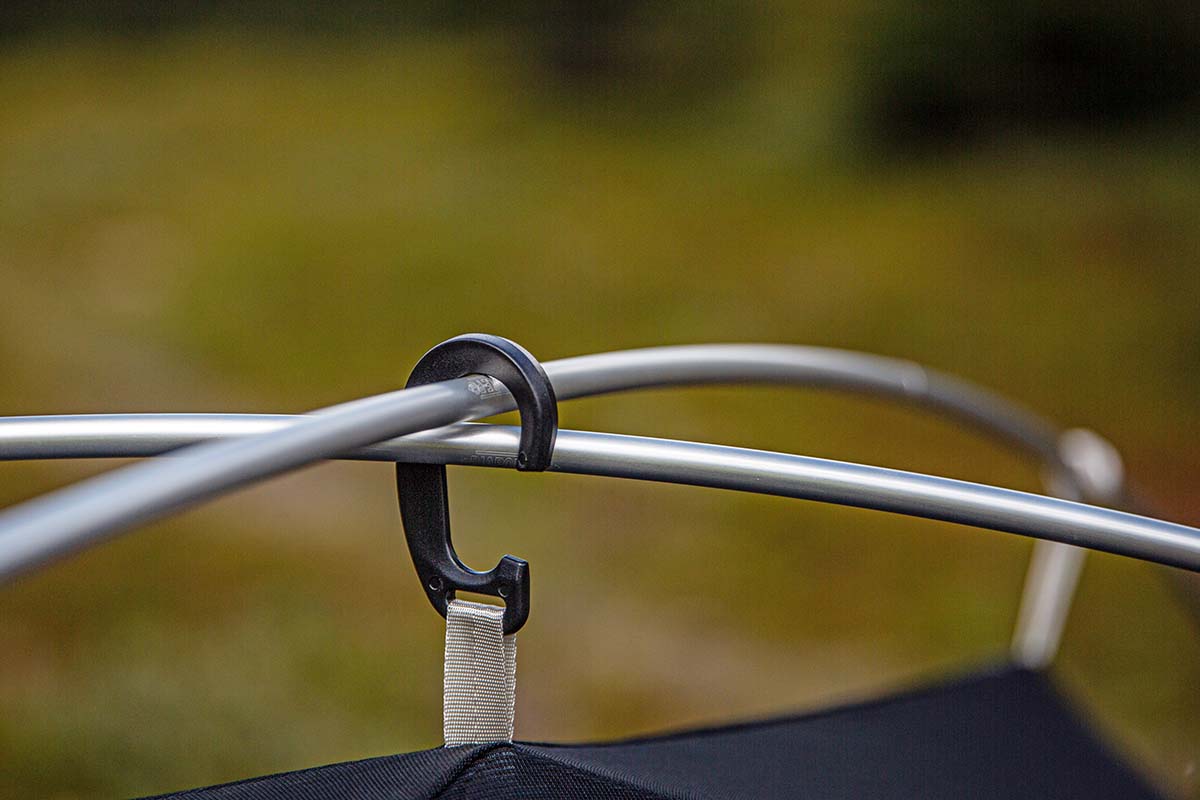
We’ll start by noting that a footprint is optional—some of the tents above come with an included footprint, while others do not. These simple tarps go beneath your tent (usually attaching to the pole in each corner) to provide an extra layer of protection underneath. They’re a nice added bit of assurance to have when it’s wet (make sure to tuck them under the tent to avoid pooling, as that can have the opposite effect) or when you’re camped on rough surfaces like granite or sharp plants. That said, they do add an additional cost (a $40 footprint would increase the price of a $200 tent by a whopping 20%) and 5 to 10 ounces of weight to your pack.
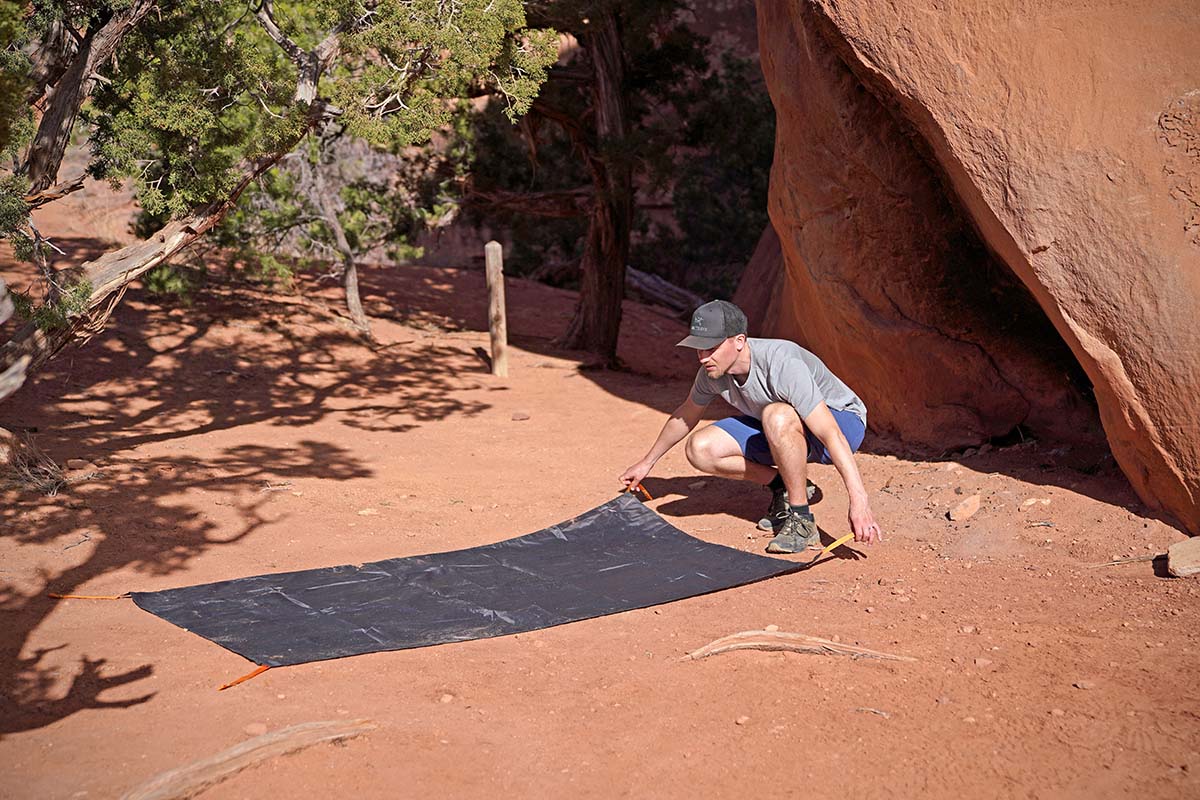
Here’s our take: For the majority of budget tents, a footprint is not really necessary. As we covered above, the tents listed here have fairly robust floors, ranging from 40 to 75 denier. Compared to more premium tents (which usually clock in between 15 and 30D), they’re pretty darn durable on their own. If you plan on camping on rough surfaces, tend to be careless with your gear, or you don’t have the risk tolerance for a torn floor (and the subsequent repair), it might be worth taking a footprint along. But in most cases, it’s highly unlikely that your tent's floor will rip. For more information on this topic, see our article: Does Your Backpacking Tent Need a Footprint? Back to Our Top Budget Tent Picks Back to Our Budget Tent Comparison Table
Learn More About Outdoor Gear
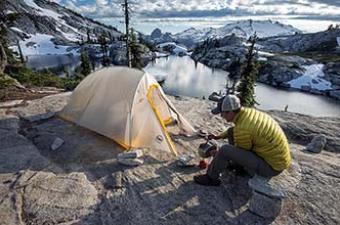
Backpacking Gear Reviews
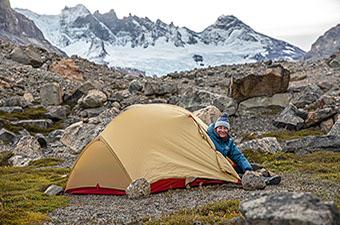
Best Backpacking Tents of 2024
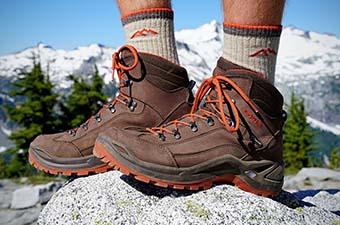
Best Hiking Boots of 2024
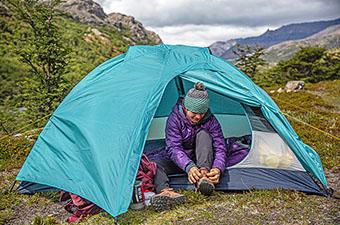
REI Co-op Trailmade 2 Tent Review
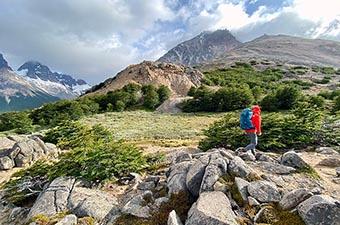
Good Backpacking Gear on a Budget
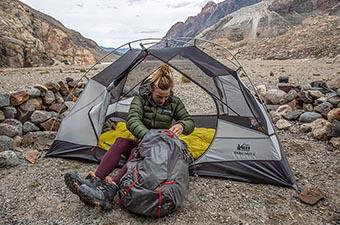
REI Co-op Trail Hut 2 Tent Review
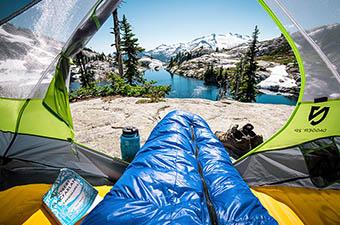
Best Backpacking Sleeping Bags of 2024
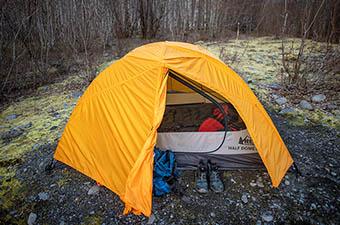
REI Co-op Half Dome SL 2+ Tent Review
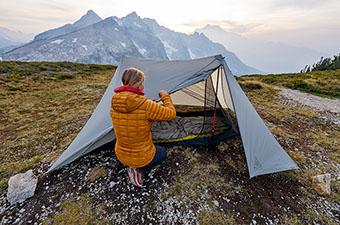
Best Ultralight Tents of 2024

Mobile Menu
Megamenu - desktop hamburger menu.
- Hiking Gear
- Backpacking Gear
- Biking Gear
- Camping Gear
- Footwear Reviews
- Climbing Gear
- Skiing Gear
- Winter Gear Reviews
- In-Depth Gear Reviews
- Hiking Shoes
- Hiking Boots
- Trail Running Shoes
- Mountain Bike Shoes
- Approach Shoes
- Climbing Shoes
- Beginner Climbing Shoes
- Mountaineering Boots
- Winter Boots
- Rain Jackets
- Down Jackets
- Synthetic Jackets
- Fleece Jackets
- Hardshell Jackets
- Softshell Jackets
- Windbreaker Jackets
- Ski Jackets
- Winter Jackets
- Hiking Pants
- Hiking Socks
- Trekking Poles
- Baby Carriers
- Running Vests
- Backpacking Tents
- Backpacking Packs
- Backpacking Sleeping Bags
- Backpacking Sleeping Pads
- Backpacking Stoves
- Backpacking Food
- Water Filters
- Altimeter Watches
- Handheld GPS
- Mountain Bike Helmets
- Mountain Bikes
- Mountain Bikes Under $1,000
- Mountain Bikes Under $2,000
- Gravel Bikes
- Bike Brands
- Kids' Bikes
- Hitch Bike Racks
- Camping Tents
- Rooftop Tents
- Camping Sleeping Bags
- Camping Mattresses
- Camping Chairs
- Camping Stoves
- Duffel Bags
- Rock Climbing Shoes
- Climbing Helmets
- Climbing Harnesses
- Climbing Quickdraws
- Belay Devices
- Climbing Ropes
- Climbing Backpacks
- Winter Gloves
- 4-Season Tents
- Ski Helmets
- Ski Goggles
- Ski Backpacks
- All-Mountain Skis
- Ski Bindings
- Backcountry Skis
- Backcountry Ski Boots
- Skis for Beginners
- Hardpack Skis
- Mirrorless Cameras
- Full-Frame Cameras
- DSLR Cameras
- Point-and-Shoot Cameras
- Travel Cameras
- DSLR Lenses
- Mirrorless Lenses
- Lofoten Islands
- Lofoten Hiking
- Hardangervidda
- Jotunheimen
- 10 Great Norway Hikes
- Public Huts
- Torres del Paine
- Chalten and Glaciares
- Lake District
- Patagonia National Park
- Milford Sound
- Abel Tasman
- Marlborough
- Great Walks
- Adventure Towns
Add adventure to your inbox
- Privacy Policy
- Terms of Service
© 2024 Switchback Travel. All Rights Reserved. No part of this site may be reproduced without our written permission.

Passing Thru Travel
Thrilling Adventures on a Budget: Backpacking Journey in Central America
Posted: March 16, 2024 | Last updated: March 16, 2024
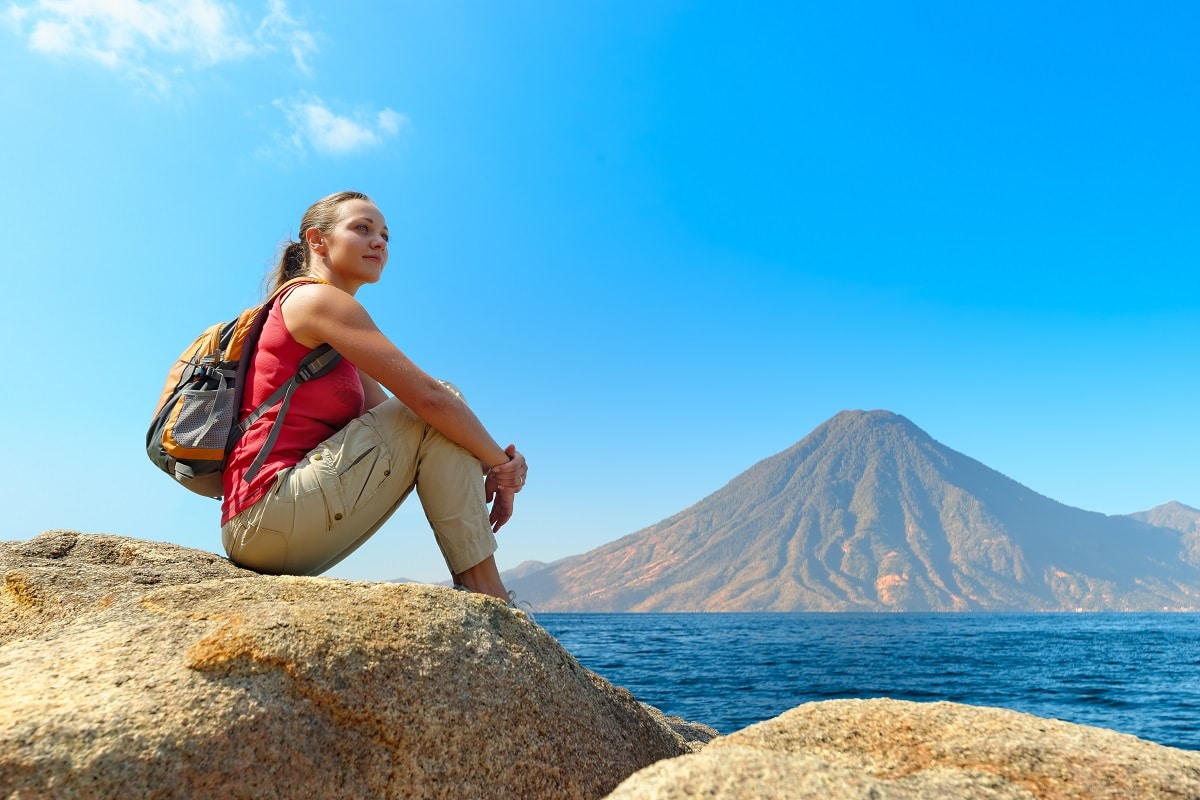
Central America, a land bridging North and South America, is a paradise for backpackers seeking adventure on a budget. This guide offers an in-depth look at 12 must-visit destinations, each promising a unique experience, from ancient ruins to vibrant cities and pristine natural reserves. We’ll provide practical tips, optimal travel times, and access routes to help you navigate this diverse and culturally rich region.

1. Antigua, Guatemala
Antigua, a UNESCO World Heritage site, is a window into Spanish colonial history with its well-preserved architecture and cobblestone streets. The city is surrounded by volcanoes, offering hiking opportunities with breathtaking views.
Antigua is also a hub for learning Spanish, with numerous language schools offering affordable courses. The city’s vibrant market is a must-visit, where you can immerse yourself in local culture and cuisine. Antigua is an excellent base for exploring nearby attractions like Lake Atitlán and the Pacaya Volcano.
Insider’s Tip: Explore the city on foot to appreciate its colonial architecture.
When to Travel: November to April for dry weather.
How to Get There: Fly into Guatemala City and take a bus or shuttle to Antigua.
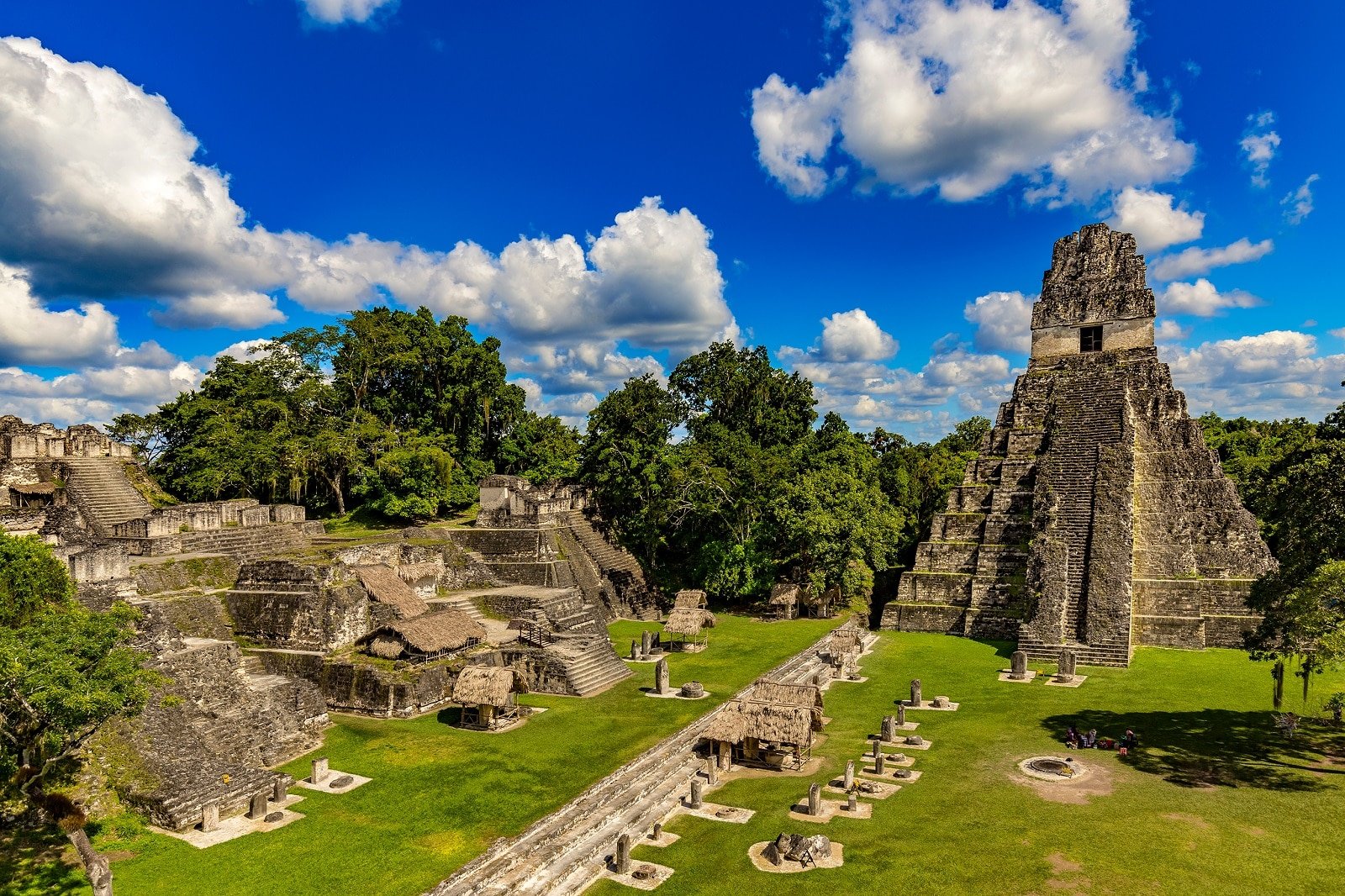
2. Tikal, Guatemala
Tikal, set in the heart of the Guatemalan jungle, is one of the largest archaeological sites of the ancient Maya civilization. Exploring these majestic ruins, you’ll feel a deep connection to history as you wander through temples and plazas.
The site is also a haven for wildlife enthusiasts, with opportunities to spot monkeys, toucans, and other native species. Tikal is an immersive experience in a rich, biodiverse ecosystem.
Insider’s Tip: Stay overnight in the park to experience the sunrise from the ruins.
When to Travel: November to April for cooler temperatures and less rain.
How to Get There: Fly to Flores and take a bus or tour to Tikal.
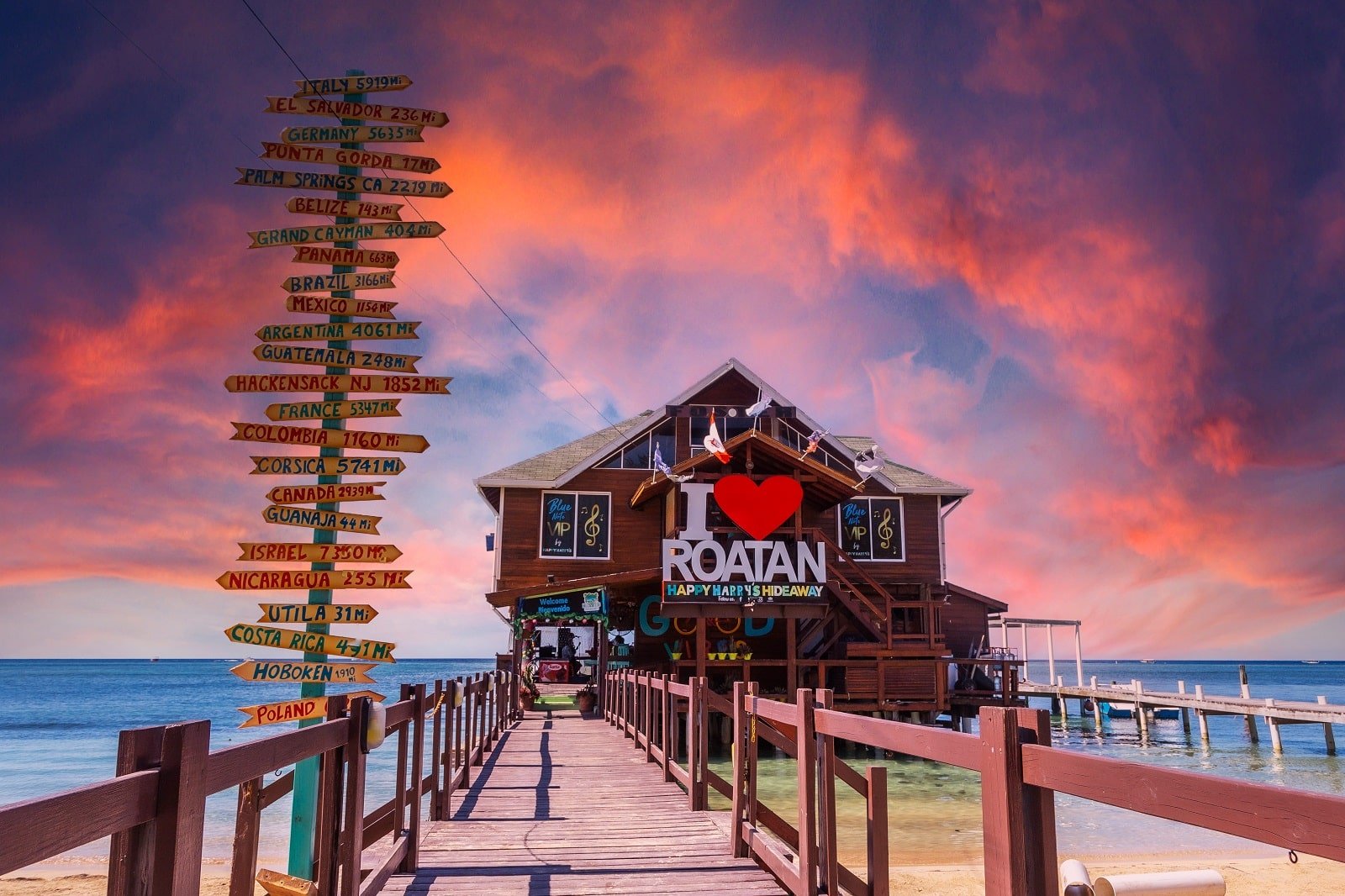
3. Roatán, Honduras
Roatán, an island in the Caribbean, is known for its stunning beaches, clear waters, and vibrant coral reefs. It’s a popular destination for water sports, especially scuba diving and snorkeling.
The island also offers a chance to experience Garifuna culture, known for its unique music and dance. Roatán is more than a beach destination; it’s a cultural and ecological treasure trove.
Insider’s Tip: Try scuba diving or snorkeling to explore the Mesoamerican Barrier Reef.
When to Travel: Dry season from March to September.
How to Get There: Fly directly to Roatán or take a ferry from the mainland.

4. Granada, Nicaragua
Granada, one of the oldest cities in the Americas, is a blend of colonial history and natural beauty. The city’s colorful architecture and historical churches are best explored on foot. Nearby, Lake Nicaragua and the Mombacho Volcano offer outdoor adventures, from kayaking to hiking. Granada is a gateway to some of Nicaragua’s most stunning natural landscapes.
Insider’s Tip: Take a boat tour of the Isletas de Granada in Lake Nicaragua.
How to Get There: Fly into Managua and take a bus or taxi to Granada.
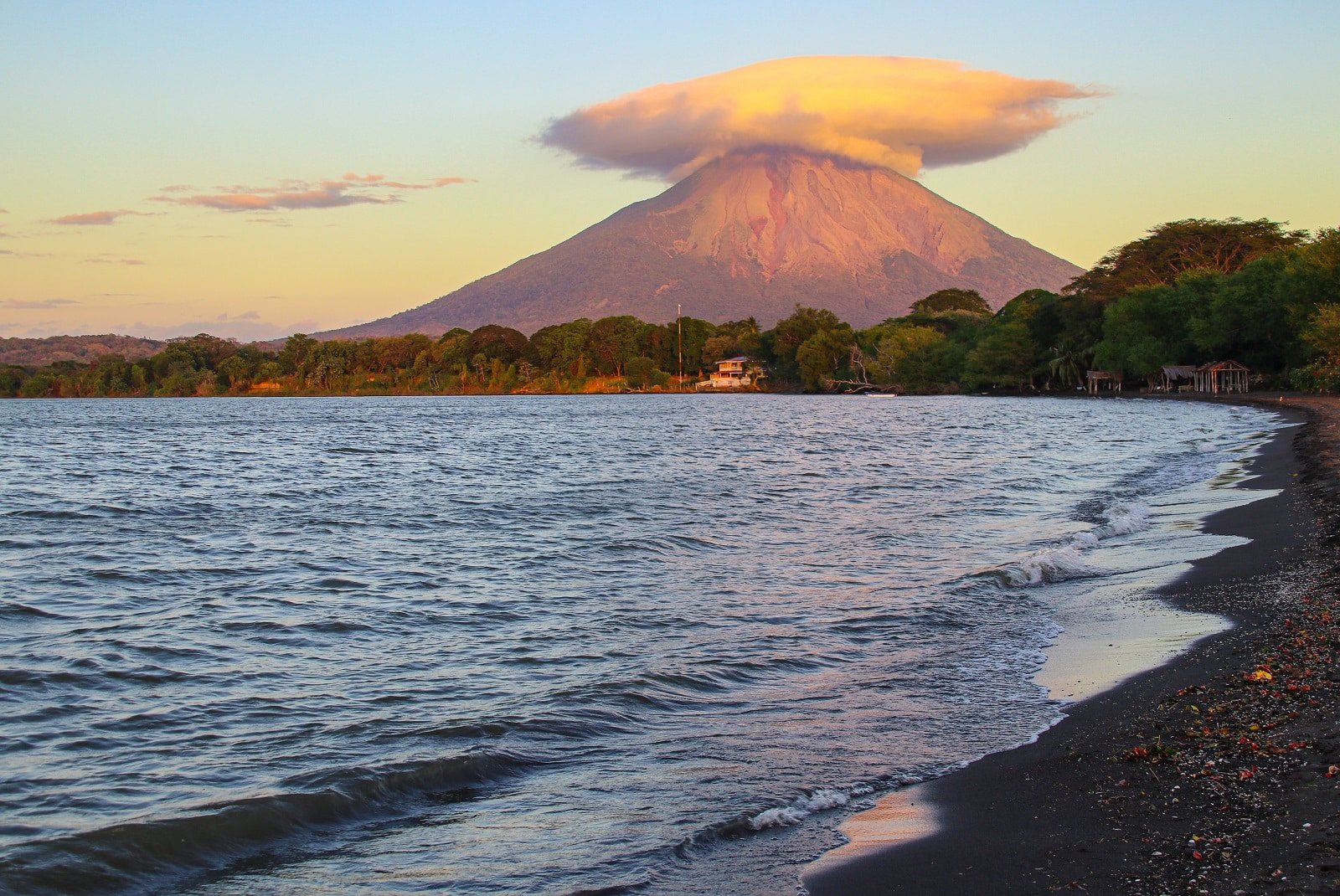
5. Ometepe Island, Nicaragua
Ometepe Island, formed by two volcanoes rising from Lake Nicaragua, is a unique destination for nature lovers and adventure seekers. The island offers hiking, kayaking, and wildlife viewing.
The pre-Columbian petroglyphs scattered across the island add a historical dimension to its natural beauty. Ometepe is a place of tranquility and adventure where you can connect with nature and local culture.
Insider’s Tip: Rent a scooter or bike to explore the island’s diverse landscapes.
When to Travel: November to April for the best weather.
How to Get There: Take a ferry from San Jorge on the mainland.

6. Monteverde Cloud Forest, Costa Rica
Monteverde Cloud Forest, a biodiversity hotspot in Costa Rica, is a haven for nature enthusiasts. The forest is home to thousands of plant species, hundreds of bird species, and a variety of mammals. Walking through the misty forest, you’ll encounter a world teeming with life.
Activities like zip-lining and canopy tours offer a different perspective on this unique ecosystem. Monteverde is more than a forest; it’s a living, breathing ecosystem waiting to be explored.
Insider’s Tip: Take a guided night tour to see nocturnal wildlife.
When to Travel: December to April for the best chance of clear skies.
How to Get There: Fly to San José and take a bus or shuttle to Monteverde.
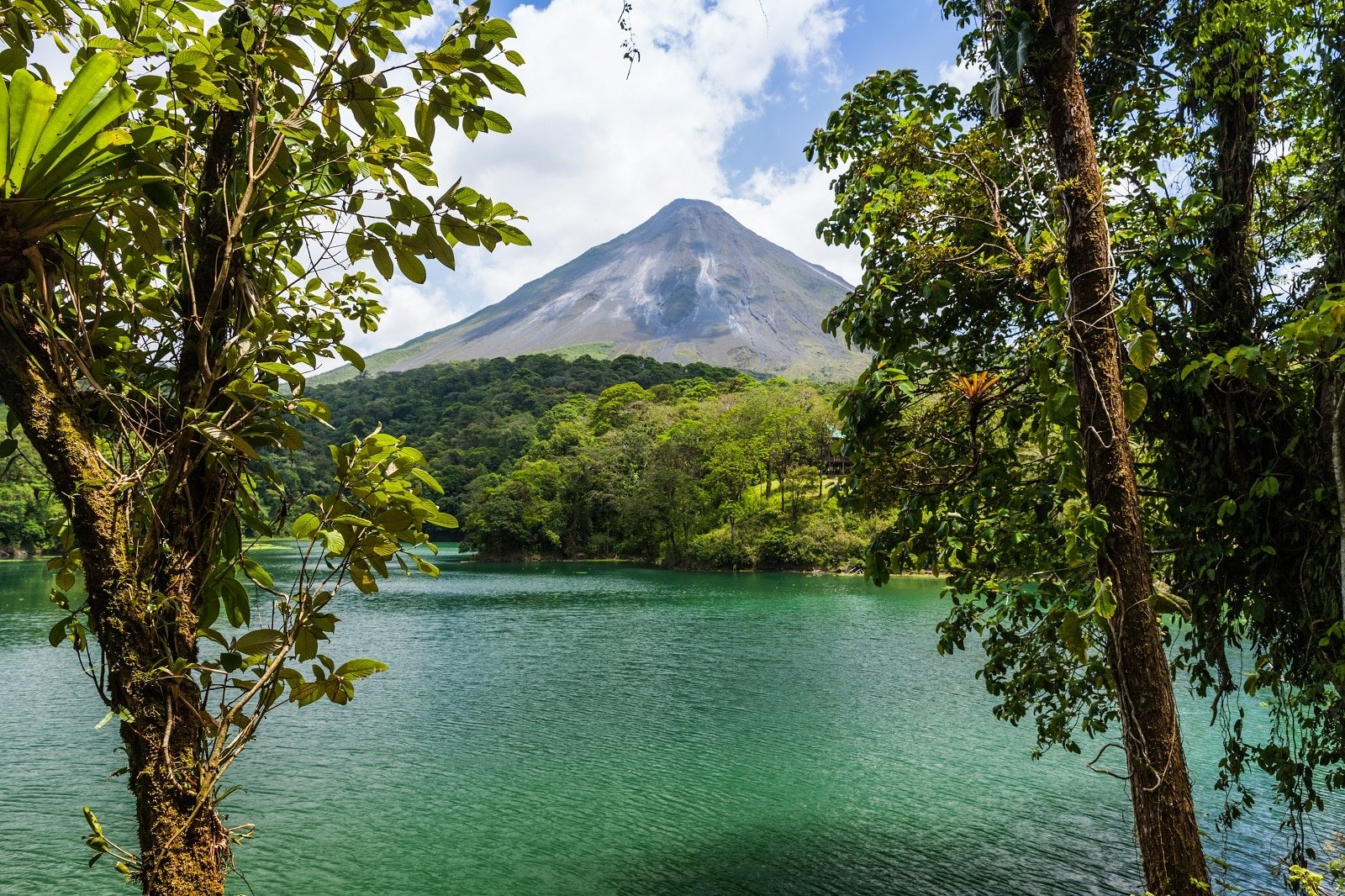
7. Arenal Volcano, Costa Rica
Arenal Volcano, one of Costa Rica’s most iconic landmarks, offers a mix of adventure and relaxation. The area around the volcano is known for its hot springs, waterfalls, and hiking trails.
The nearby town of La Fortuna is a hub for activities like rafting, zip-lining, and wildlife tours. Arenal is not just a volcano; it’s a destination that offers a range of experiences in a stunning natural setting.
Insider’s Tip: Relax in the natural hot springs around the volcano.
When to Travel: May to November for lush landscapes and fewer tourists.
How to Get There: Fly to San José and take a bus or shuttle to La Fortuna.
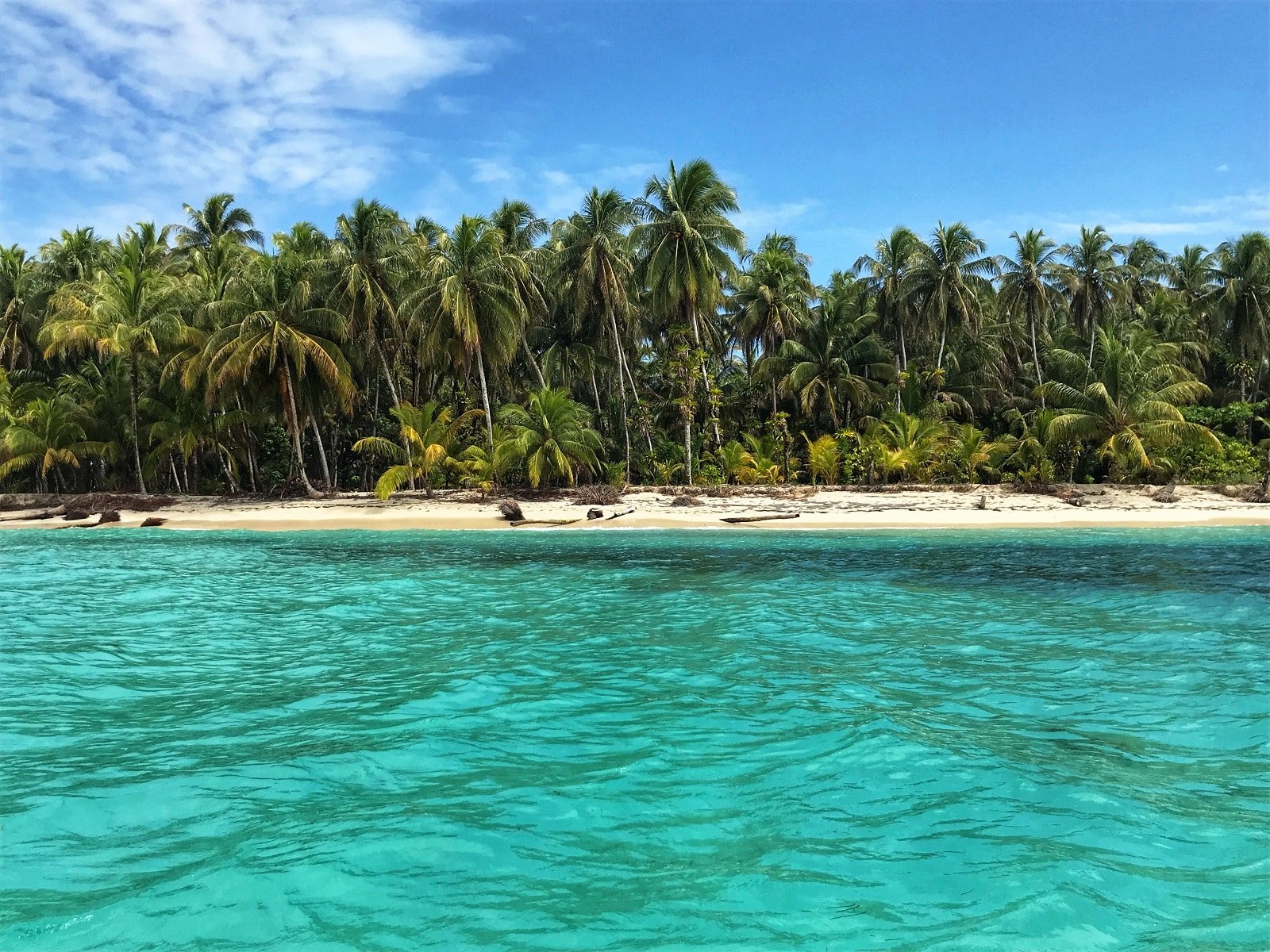
8. Bocas del Toro, Panama
Bocas del Toro, an archipelago off Panama’s Caribbean coast, is known for its beautiful beaches, lush rainforests, and vibrant nightlife. The islands offer a variety of activities, from surfing and snorkeling to exploring indigenous communities. Bocas del Toro is more than a beach destination; it’s a diverse region where you can immerse yourself in nature and local culture.
Insider’s Tip: Explore the less-visited islands for a more authentic experience.
When to Travel: February to April and September to November for good weather and fewer tourists.
How to Get There: Fly to Panama City and then to Bocas del Toro, or take a bus and boat from the mainland.

9. Panama City, Panama
Panama City, a cosmopolitan hub in Central America, offers a blend of modernity and history. The city’s skyline is a testament to its economic growth, while areas like Casco Viejo showcase its colonial past.
The Panama Canal, a short drive from the city, is a must-visit for its historical significance and engineering feat. Panama City is a destination that combines urban experiences with historical exploration.
Insider’s Tip: Visit the Panama Canal’s Miraflores Locks for an insight into this engineering marvel.
When to Travel: Mid-December to April for dry weather.
How to Get There: Fly directly to Panama City.
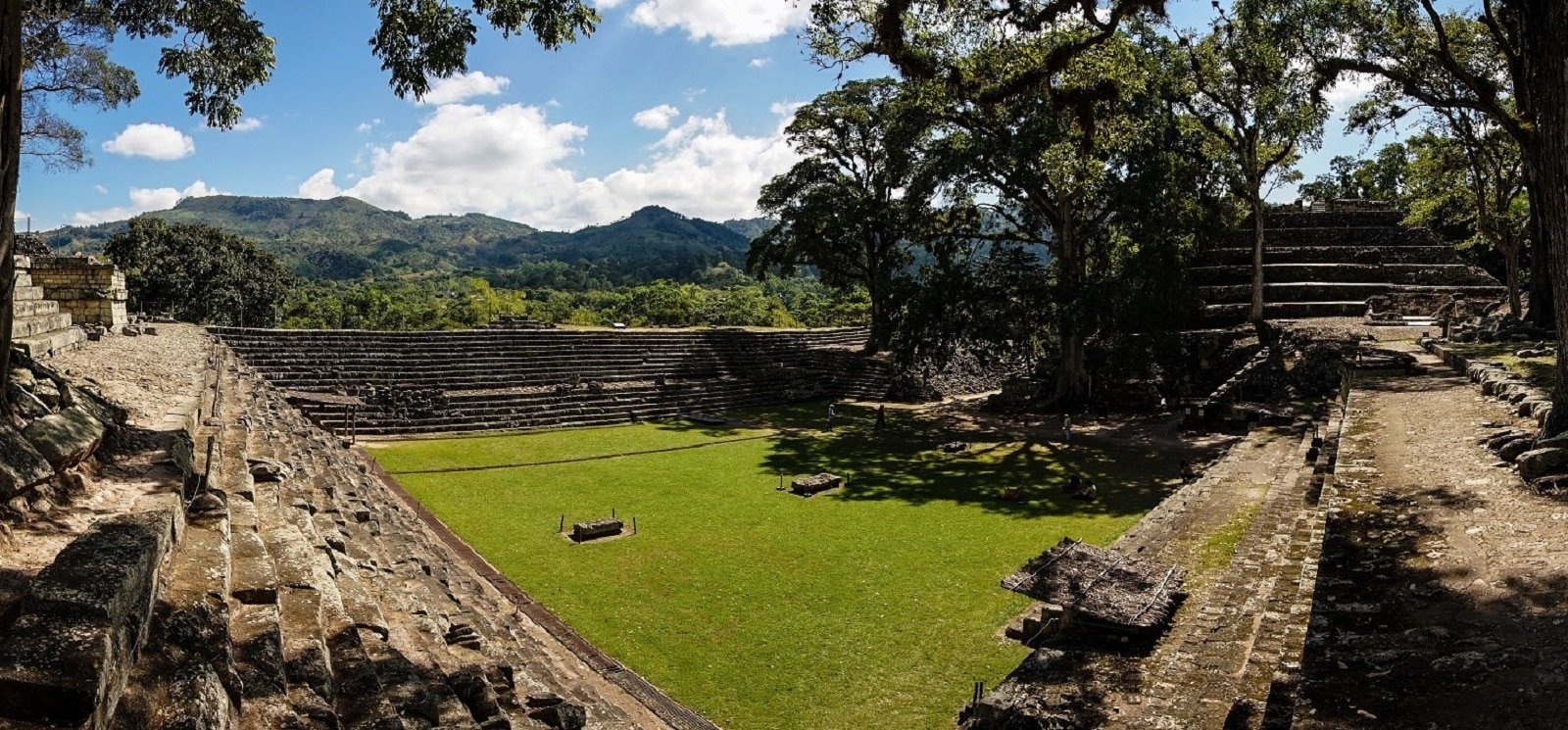
10. Copán Ruinas, Honduras
Copán Ruinas, home to the ancient Maya city of Copán, is a site of significant archaeological importance. The ruins, known for their intricate sculptures and hieroglyphics, offer a glimpse into the Maya civilization.
The town of Copán Ruinas, with its cobblestone streets and relaxed atmosphere, is a pleasant place to unwind after exploring the site. Copán is not just an archaeological site; it’s a window into the past and a peaceful retreat in the present.
Insider’s Tip: Visit the nearby bird park for a unique wildlife experience.
When to Travel: January to April for dry weather.
How to Get There: Fly to San Pedro Sula and take a bus to Copán.
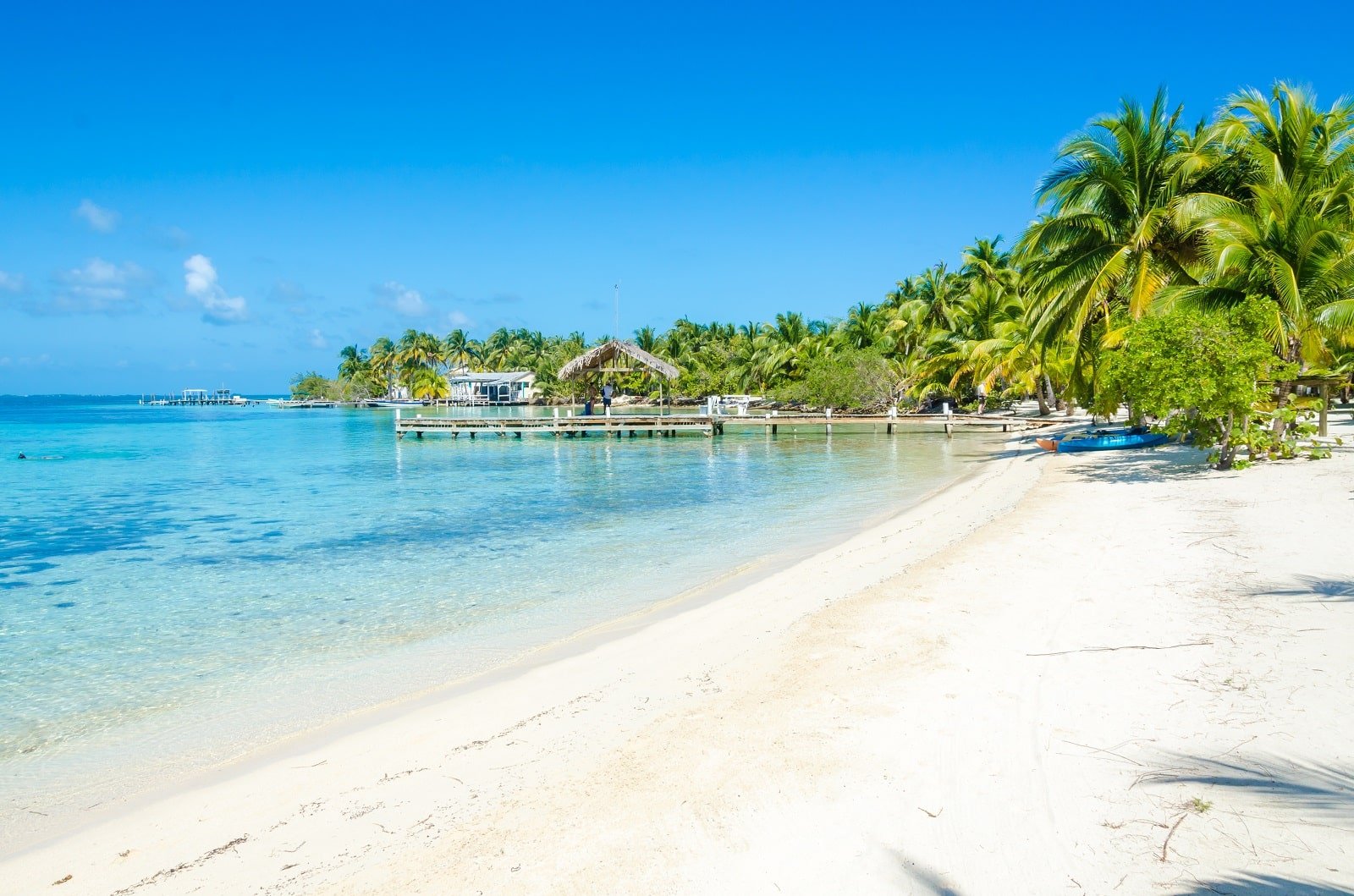
11. Caye Caulker, Belize
Caye Caulker, a small island off the coast of Belize, is known for its laid-back atmosphere and beautiful marine life. The island is a popular spot for snorkeling and diving, with easy access to the Belize Barrier Reef.
The motto “Go Slow” encapsulates the island’s relaxed vibe, making it a perfect destination for travelers looking to unwind. Caye Caulker is more than an island; it’s a state of mind.
Insider’s Tip: Try the local seafood, especially the lobster, during the season.
How to Get There: Fly to Belize City and take a water taxi to the island.
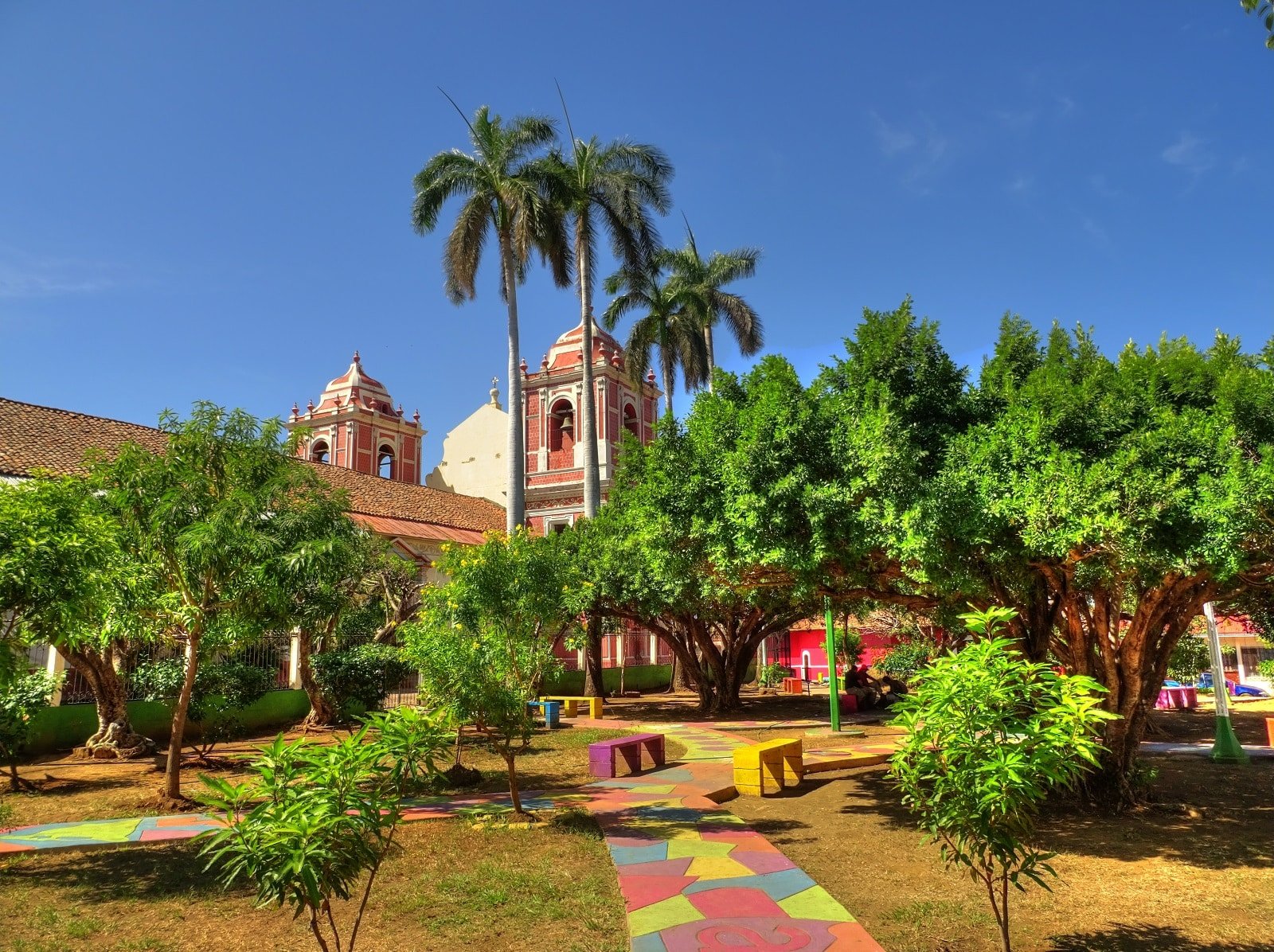
12. Leon, Nicaragua
Leon, a city in western Nicaragua, is a blend of history, culture, and adventure. Known for its colonial architecture and vibrant art scene, the city offers a rich cultural experience. Nearby, the Cerro Negro volcano provides a unique opportunity for volcano boarding, a must-try for adventure seekers. Leon offers cultural immersion and outdoor adventure.
Insider’s Tip: Try volcano boarding on Cerro Negro for an adrenaline rush.
How to Get There: Fly into Managua and take a bus or shuttle to Leon.
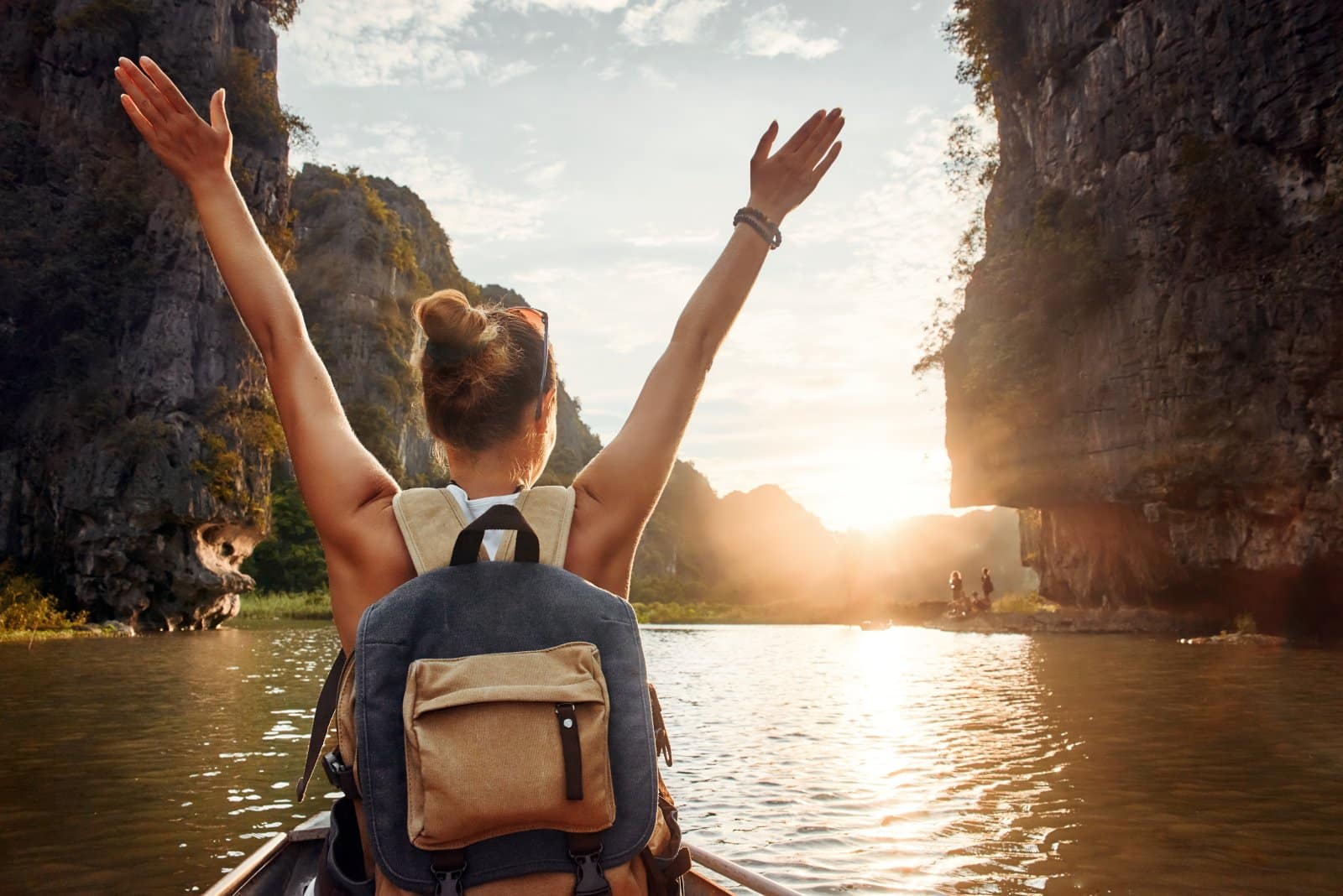
The Bottom Line
As you embark on your backpacking journey through Central America, remember that this region offers a wealth of experiences, from ancient ruins and lush rainforests to vibrant cities and tranquil islands. Each destination allows you to immerse yourself in local cultures, connect with nature, and create lasting memories.
Travel responsibly, respect local communities, and embrace the diverse beauty of Central America. Your adventure awaits, filled with discoveries and budget-friendly experiences that will enrich your understanding of this captivating region.
More Articles Like This…
Barcelona: Discover the Top 10 Beach Clubs
2024 Global City Travel Guide – Your Passport to the World’s Top Destination Cities
Exploring Khao Yai 2024 – A Hidden Gem of Thailand
The post Thrilling Adventures on a Budget: Backpacking Journey in Central America republished on Passing Thru with permission from The Green Voyage .
Featured Image Credit: Shutterstock / soft_light.
For transparency, this content was partly developed with AI assistance and carefully curated by an experienced editor to be informative and ensure accuracy.
More for You
CNN political commentator Alice Stewart dies
Beyoncé Is a Total Bombshell in a Ruched Dress With a Gaping Bust Cutout
It’s time to bring back the world’s greatest fighter jet – from the 1990s
I’m a Real Estate Investor: 10 Places I Would Never Buy Property
Alvin Bragg Case Against Trump 'Proved Beyond a Reasonable Doubt': Attorney
Here’s the retirement savings that put you with the richest 10% of Americans — it’s a much smaller number than you may think
Map reveals best places to live in the US if nuclear war breaks out
Officer involved in incident that led to Scottie Scheffler's arrest 'did not have body cam footage turned on'
Dad who sacrificed his savings to pay for son's college calls student loan forgiveness a 'bitter pill'
Taylor Sheridan Says Farewell To Dabney Coleman, Explains Why He Gave Mentor Unforgettable Turn As Dutton Family Patriarch In ‘Yellowstone'
What Is the Anduril Roadrunner? America's Latest Game-Changing Weapon
‘The American Dream is dead’: Virginia man makes three times the federal minimum wage, but can’t afford to live. Here are 3 ways to stretch your money, even when it feels impossible
Kikkoman Finally Settles the Debate: This Is Where You Should Store Your Soy Sauce
12 Expert Landscaping Ideas for the Front of the House
U.S. military commander in S. Korea during Gwangju uprising dies
Kelsey Plum's reaction to Kate Martin's block is the WNBA highlight of the week
For the first time, I see why reasonable people will vote for Donald Trump
Here is the true value of having a fully paid-off home in America — especially when you're heading into retirement
Kevin O'Leary warns latest CPI increase is a 'nasty report'
Kale had its moment. Its leafy cousin has more protein and fewer calories
Flying budget airlines might not be as cheap as it seems
Cost-conscious airlines are not always a good deal after you weigh luggage fees and the price of getting to remote airports.

Some flight deals seem too good to be true. $26 for a one-way ticket from London to Rome? $29 from Boston to Miami? $44 from Denver to New York?
Such flights, all on budget airlines , are popular because they offer fast travel to in-demand locations at a lower price point.
But between the extra baggage and seat fees, the limited flight options and the lack of amenities, the costs of flying budget can become much more than expected. Tom Varghese, owner of the travel agency Travel Tom, said he tries not to book budget airlines for his clients for that reason.
“Sometimes it can work out, if the cost differential can be dramatic, but these days that’s not the case,” Varghese said. “When things go wrong, it can go really really wrong.”
That’s not to say budget airlines are always a bad option. Here’s what travelers should keep in mind when deciding whether to book a budget-airline flight.
What is a budget airline?
According to travel experts, airlines fall into one of three rough categories. Legacy carriers, like American Airlines, Delta and United, offer more varieties of ticket and seat options, and are often higher-end. Low-cost carriers (think Southwest and JetBlue) still provide competitive amenities like WiFi or better legroom.
Budget airlines are the cheapest of the three, offering savings that typically accompany little to none of the usual free flight perks, such as carry-on bags or refreshments. Often, budget carriers also will have less legroom and more limited routes and flight times.
In the United States, popular budget airline options include Spirit and Frontier. In Europe, customers can book EasyJet, Ryanair, Vueling, Wizz Air and a host of other carriers. And in Latin America, travelers can look at Sky Airline and Amaszonas, among others.
How fees can ‘really, really quickly’ add up
While budget airlines can offer flights with 50 percent savings on a ticket, those sticker prices aren’t the whole story.
Budget carriers almost always charge travelers extra to pick seats, get a drink or snack on the plane, or print their boarding pass in the airport. In addition, virtually all budget airlines require passengers to pay extra for their checked luggage and carry-on, regardless of the length of the flight.
These luggage charges can sometimes cost more than the flight itself. Charges can get even more dramatic if travelers don’t conform to the often smaller bag-size standards that budget airlines set. On Spirit, for example, checked bags that weigh more than 40 pounds can cost up to $125 — and oversize bags are an additional $150. And on Frontier, bags between 41 and 100 pounds come with a charge of $75 to $100.
“These things add up really, really quickly,” Varghese said.
Budget airlines can also cause problems in the case of canceled or delayed flights. Because these carriers have fewer flights per day and more limited routes, getting on a new flight in the case of a cancellation can take a day or more during busy season.
“If you’re going during peak weeks … you better pray that everything goes well, because there’s not a chance in heck that you’re going to get your issue resolved in a timely manner,” Varghese said. It’s almost like “canceling your whole vacation.”
You should also consider that many budget airlines, especially in Europe, service airports that are far from the city center. In London, for example, EasyJet and Ryanair often use Gatwick and Stansted airports rather than the much larger Heathrow. The cost of taxis or other transit from these airports can be high, in some cases outweighing the money saved by booking a budget flight.
Are budget flights right for you?
Budget airlines can be a sound financial choice for a specific traveler. Betsy Ball, co-owner of the Wisconsin-based agency Euro Travel Coach, said she often uses Ryanair and EasyJet to hop between European cities, since these flights can sometimes be faster and cheaper even than other forms of transportation.
“Depending on what it is you’re trying to do, you can save a lot of time by getting a flight,” she said.
While that may not work as well for families or couples traveling with luggage and trying to sit together, budget airlines may make sense for the lone backpacker wanting to save. Mike Heck, a vice president at Fox World Travel, where he’s responsible for liaising between Fox and its travel partners, said it comes down to the type of traveler and the trip they have in mind.
“If you’re looking for the absolutely lowest ticket price — no seat assignment, no baggage, no amenities, no food or beverage — budget is a good thing to do,” he said. “It’s when you start to upgrade things — getting baggage, seat assignment, a snack on board, access to WiFi — that’s when it starts to increase the cost and it isn’t as affordable as people think when buying the ticket.”
It helps if you’re flexible, too. Budget flights, Heck said, are “generally not for business travelers and generally not for people who don’t want to have the inconvenience” of having to reschedule a flight.
Double-check the airline rules, and do your math
Travel experts agreed that the key when booking is to compare entire flight packages. Ball recommends using websites like Skyscanner or Google Flights, and then taking your search to the specific websites for each airline.
“I’ll narrow it down to two or three and then, it’s a pain, but go through the process of getting a ticket” on the airline’s website, she said. “That’s when you see how much is going to cost and can look at the luggage requirement.”
Fliers may find in their searching that there are other options available that offer close to the price of a budget airline with the protections of a low-cost or legacy carrier. Some standard carriers, for instance, now feature basic or reduced-amenity fares.
If you decide on a budget carrier after doing your calculations, experts recommend that you check whether you need to print your boarding pass. If you need to purchase a bag, make sure to do it well in advance, since some airlines like EasyJet have a limited amount of bag space that they sell, and missing that window can mean additional fees.
“Just read all the fine print so you know what you’re getting into,” Ball said.
More travel tips
Vacation planning: Start with a strategy to maximize days off by taking PTO around holidays. Experts recommend taking multiple short trips for peak happiness . Want to take an ambitious trip? Here are 12 destinations to try this year — without crowds.
Cheap flights: Follow our best advice for scoring low airfare , including setting flight price alerts and subscribing to deal newsletters. If you’re set on an expensive getaway, here’s a plan to save up without straining your credit limit.
Airport chaos: We’ve got advice for every scenario , from canceled flights to lost luggage . Stuck at the rental car counter? These tips can speed up the process. And following these 52 rules of flying should make the experience better for everyone.
Expert advice: Our By The Way Concierge solves readers’ dilemmas , including whether it’s okay to ditch a partner at security, or what happens if you get caught flying with weed . Submit your question here . Or you could look to the gurus: Lonely Planet and Rick Steves .

- Meet the Team
- Work with Us
- Czech Republic
- Netherlands
- Switzerland
- Scandinavia
- Philippines
- South Korea
- New Zealand
- South Africa
- Budget Travel
- Work & Travel
- The Broke Backpacker Manifesto
- Travel Resources
- How to Travel on $10/day
Home » Middle East » Turkey » Backpacking Guide
Backpacking Turkey Travel Guide (2024)
There are some places in this world that are just too grand to be conquered. No matter how long you stay or how often you go, be it two days or two decades, some places just always leave you wanting more.
Perhaps one of the most incredibly varied countries to go backpacking in is Turkey. Turkey is, in my opinion, one of the most alluring countries to travel to because, no matter how many times you’ve been there, you keep finding more to do.
Let me tell you all about this amazing country. Get lost in the ever-exciting and mysterious Istanbul. Go for a ride above the fairy chimneys of Cappadocia in a hot air balloon or wild camp in abandoned hermits caves. Smoke shisha whilst watching fishermen bring in the day’s catch or mingle with gorgeous Turkish ladies in 70s themed discos…
With this travel guide for Turkey, you’ll have everything that you could need to start your trip. We’ll cover topics ranging from “Turkey’s famous food” to “backpacking Turkey on a budget.” Everything and then some is covered in this guide; with it, you’ll be more than prepared to go galavanting in this amazing country.
Why Go Backpacking in Turkey?
Turkey is one of the most unique, most endearing, and most special countries that I’ve ever traveled to. Few other nations on this planet can offer the sheer amount that Turkey can.
More than just Istanbul or Cappadocia, Turkey is full of unique areas , stunning landscapes, and interesting archaeological sites. Those backpacking Turkey simply have to see more than just the usual tourist attractions.
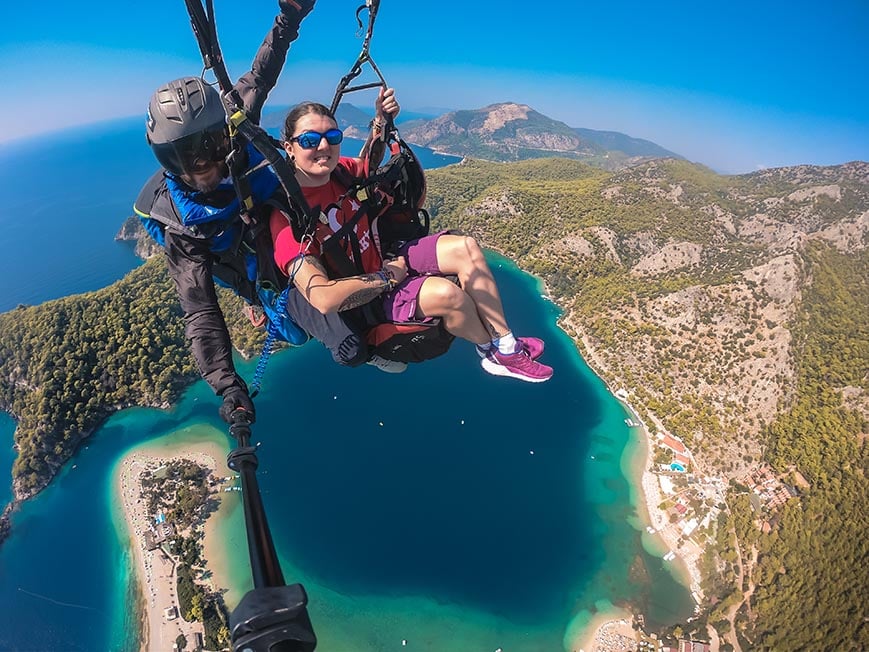
The Broke Backpacker is supported by you . Clicking through our links may earn us a small affiliate commission, and that's what allows us to keep producing free content 🙂 Learn more .
Although – I’m going to throw this out there right now – Turkey is currently run by a brutal motherfucker dictator and the Turkish army frequently commits war crimes against the Kurds, some of the most hospitable people I’ve ever met. I’ll talk more about this later but I just wanted to get that off my chest first.
Back to the topic at hand, we’re going to outline the best itineraries for how to go backpacking in Turkey. Each one is specially crafted to give you the best possible experience.
Afterward, we’re going jump into the meat of the article – the destinations – and then follow with some more specific information e.g. Costs, Food, and Trekking , etc. By the end of this guide, you’ll be equipped with all of the necessary tools to go backpacking around Turkey and on a budget!
Best Itineraries for Backpacking Turkey
Below is a list of four travel itineraries for backpacking Turkey. They vary from 1 to 4 weeks in length and cover the majority of the must-see places in Turkey.
Backpacking Turkey 7-Day Itinerary: From Istanbul to Cappadocia
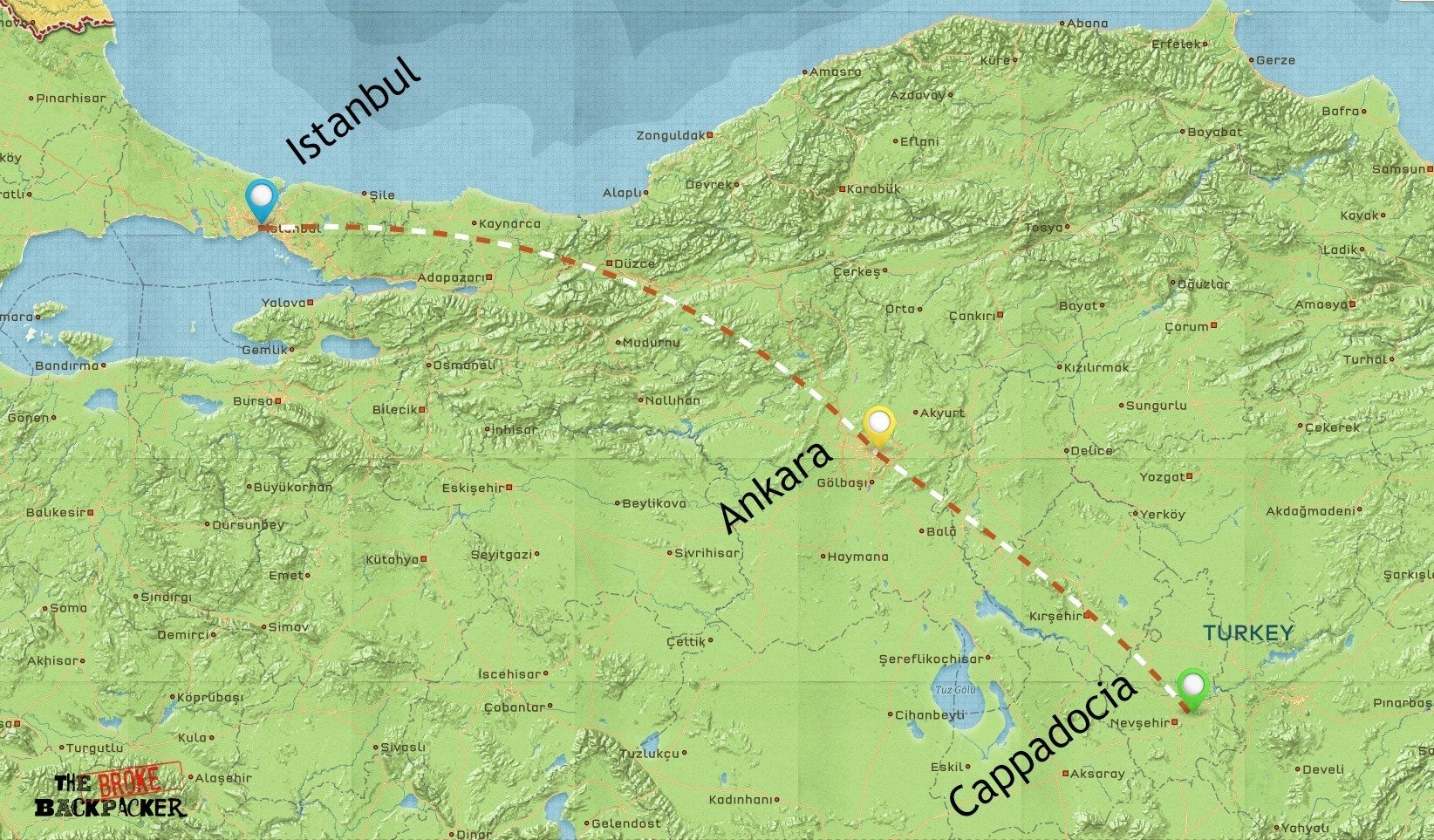
Visit the two largest cities in Turkey in addition to its most beloved desert getaway! Over the course of this 7-day itinerary for backpacking around Turkey, you’ll see Istanbul , Ankara , and Cappadocia .
Spend 2-3 days exploring the eclectic areas of Istanbul , which is one of the most interesting cities in the world. Stare in awe at the Hagia Sophia, wander around the Grand Bazaar, and then head north along the Bosphorus for a real taste of local Istanbul.
There are so many epic Airbnbs in Istanbul to choose from that won’t break the bank.
Wrapping up Istanbul, grab a bus or high-speed train to Ankara. This is Turkey’s federal capital and quite different from Istanbul in many ways. Spend a day exploring the city and be sure to note all the differences: its flavors, its people, their daily lives, and so on.
After this brief stop in Ankara, continue on to Cappadocia, which is probably the most famous destination in Turkey. This is an absolutely enchanting place, with natural stone towers and a dizzying amount of underground structures. Sleep in one of the many (accommodating) cave lodges here and then poke your head out to explore the landscape.
Backpacking Turkey 10-Day Itinerary: The Turquoise Coast
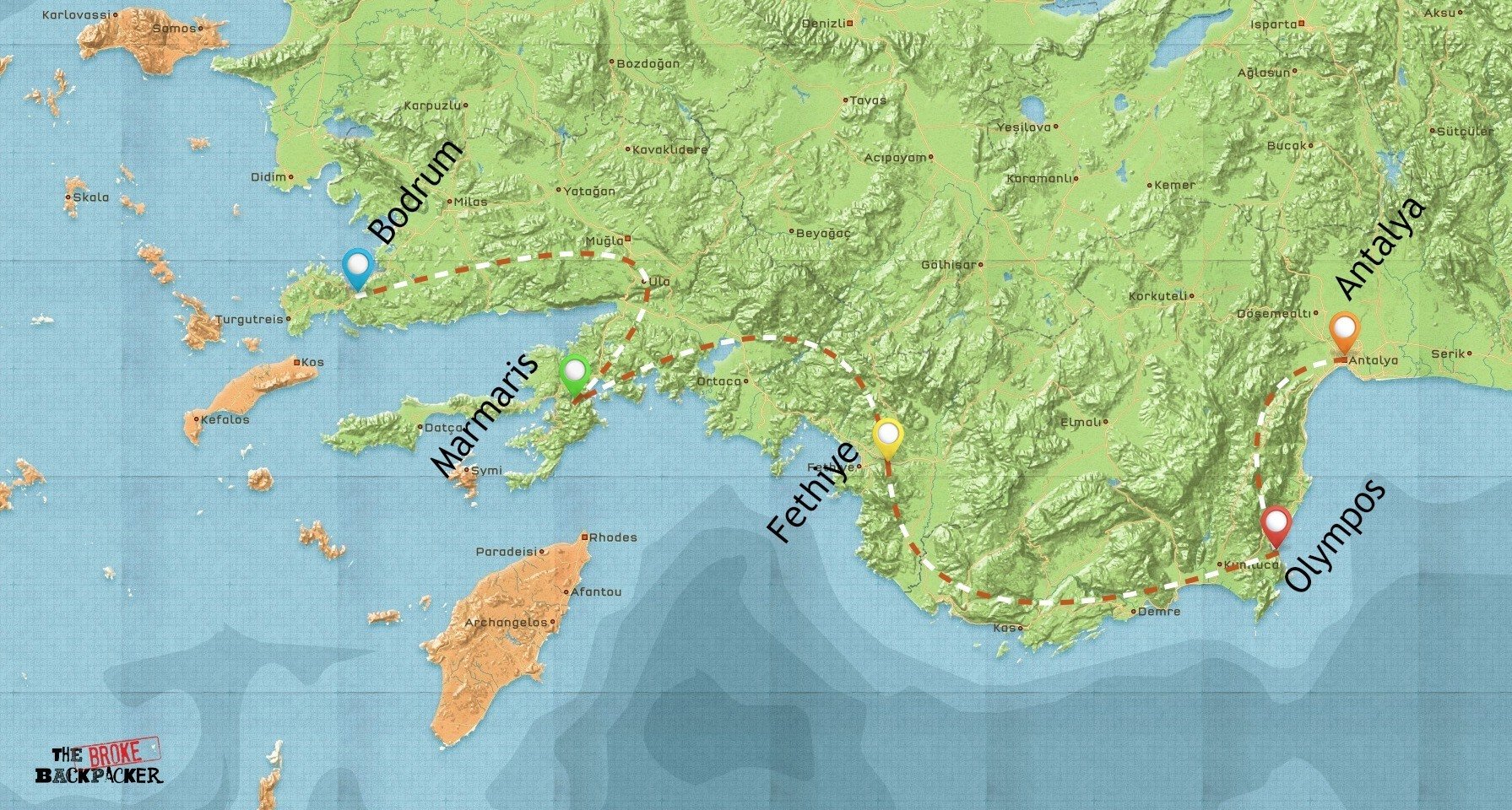
Spend 10 days on the Turkish Riviera moving along the coas t with this itinerary for backpack Turkey! Fly into any one of the major cities ( Antalya, Izmir, Bodrum or Dalaman [for Marmaris and Fethiye ]), pick up a rental car, and start driving!
Hit up as many beach towns as you can along the Turquoise Coast. Visit the amazing ruins of Ephesus . Watch baby turtles hatch in Olympos . Go paragliding above the Blue Lagoon. Rent a private yacht . Get crazy in Bodrum or Marmaris. There’s so much to do here! 10 days may not even be enough…
Backpacking Turkey 2-Week Itinerary: Highlights of Turkey
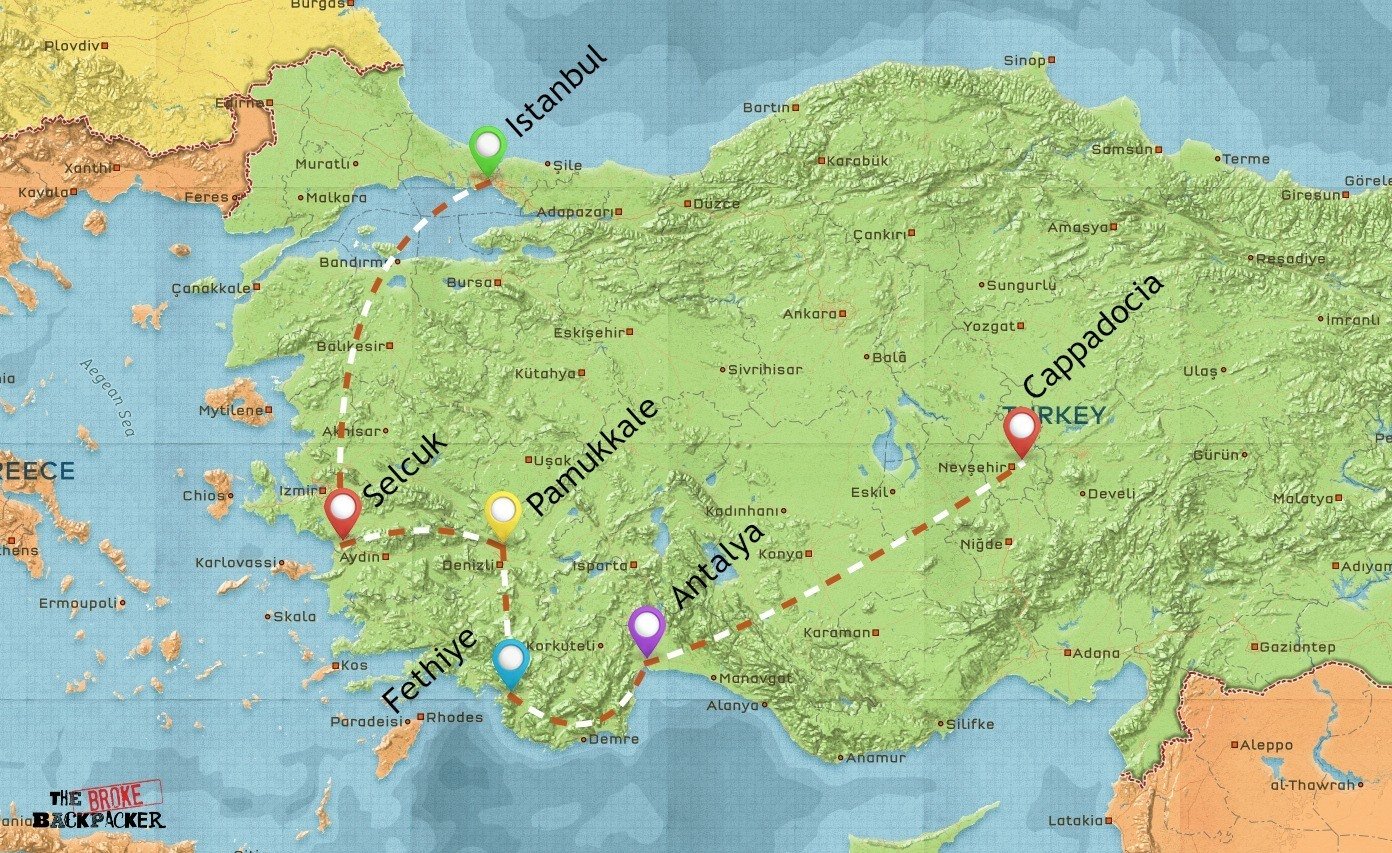
See a little bit of everything on this Turkish itinerary! Get a taste of city living in Istanbul. Visit the mighty ruins of Ephesus or Aphrodisias , stopping at Pamukkale along the way. Spend some time on the beach in the Turkish Riviera. Finally, go for a hot air balloon ride in Cappadocia.
This itinerary will involve many forms of transport. Flying from Istanbul to and perhaps within Anatolia/the Turkish Riviera will be necessary. Most flights are cheap in Turkey though. For all other routes, grab a bus or rent a car. If you rent a car, make sure you purchase a RentalCover.com policy to cover your vehicle against any common damages such as tires, windscreens, theft, and more at a fraction of the price you would pay at the rental desk.
Backpacking Turkey 1-Month Itinerary: The Whole Damn Thing!
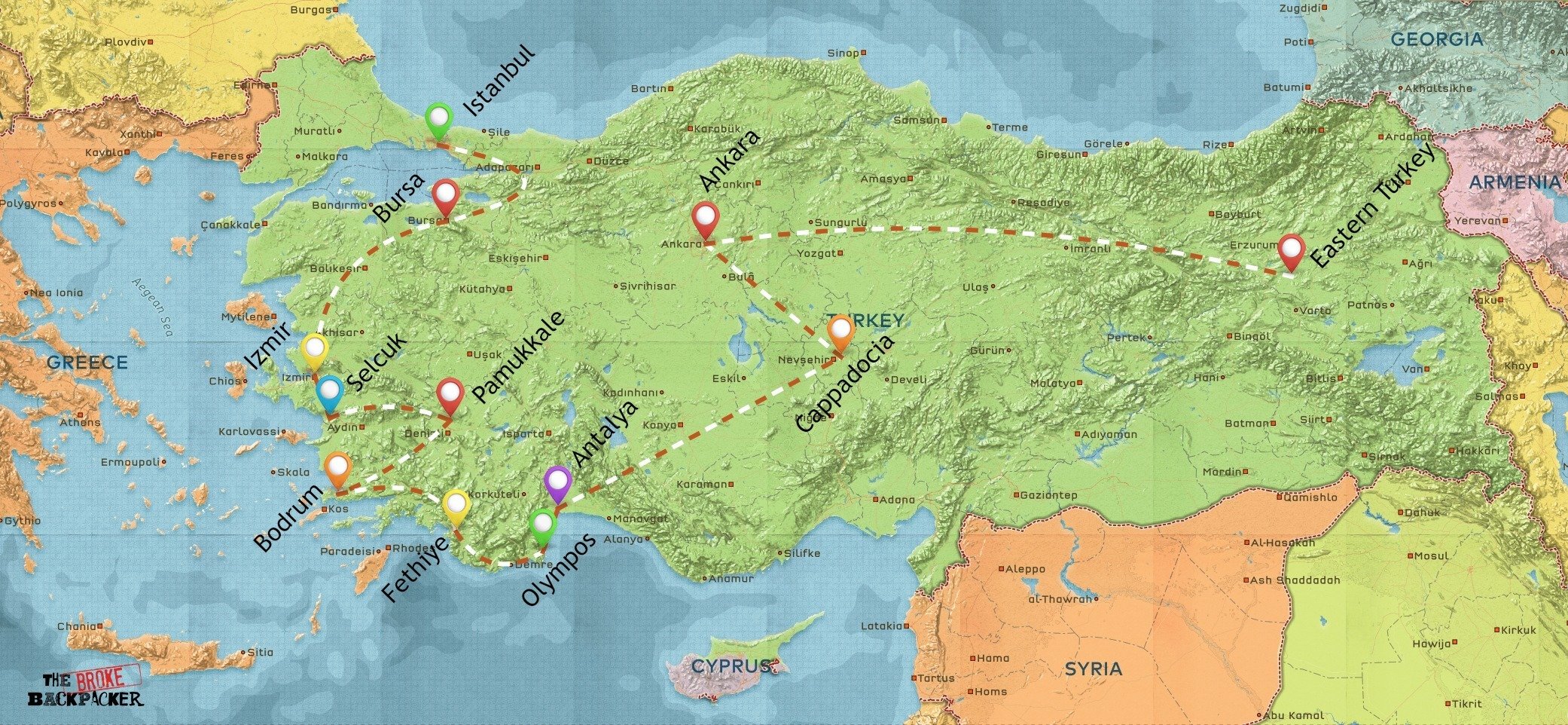
Did the last itinerary make you feel wanting? Well just spend some more time backpacking in Turkey then! With a full month, you’re sure to have plenty of time to see all the best that Turkey has to offer. Who knows; maybe you’ll even make it to some of Turkey’s unexplored places, like the Kaçkar Mountains or Van Lake . See how far you can go on this adventure!
Places to Visit in Turkey
The absolute best places to visit in Turkey starts here…
Backpacking Istanbul
Where does one even begin with a trip to Istanbul ? I’ll simply start by saying this is one of the most thrilling cities that I have ever been to. Istanbul offers an overwhelming amount of things to do, so much so that no amount of time here seems to be enough. Those wanting to backpack through Turkey will love Istanbul and will be thinking about it long after they leave.
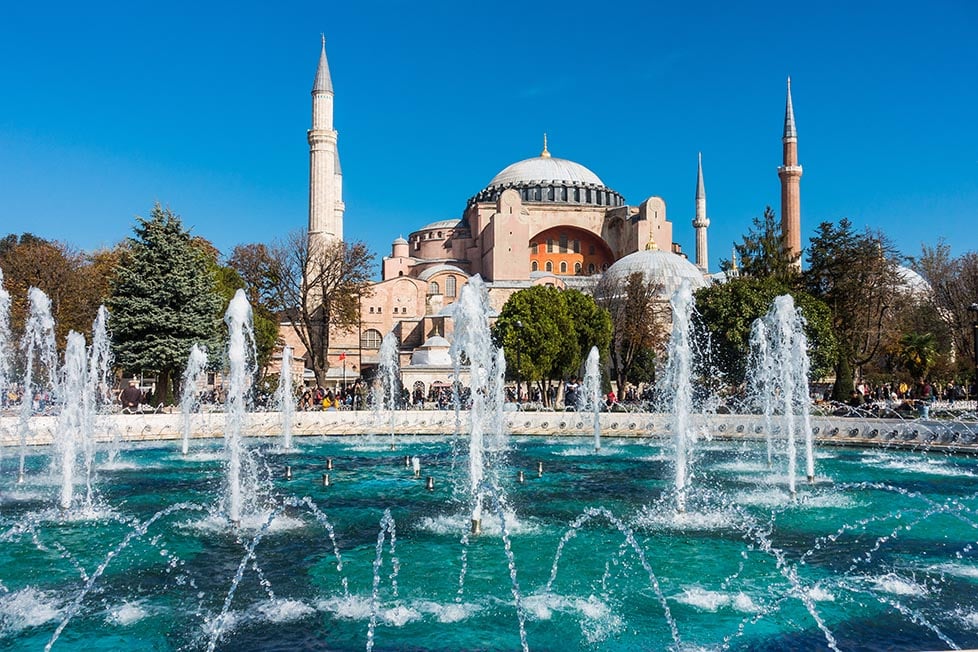
Istanbul is a huge city with many, many districts. We begin in the Old City , officially referred to as Sultanahmet , where you’ll find most of Istanbul’s top tourist attractions . Many of Turkey’s most famous landmarks are found in this area and all are within walking distance of each other. Examples include Hagia Sophia, Blue Mosque, Topkapi Palace, and the Basilica Cistern. Be aware that these locations attract massive amounts of tourists and that crowds will be an issue.
If you’d like to go shopping, be sure to visit the Grand Bazaar, which has over 4400 different shops. Many shops do, unfortunately, appear to sell the same touristy wares. Explore a little bit though and you’re sure to find some odd stuff.
Other points of interest in Sultanahmet are the Old City Walls, the Chora Church, Süleymaniye Mosque, the Patriarchate of Constantinople, and the Greek College in Fener. Be sure to check out the secret viewpoint at Büyük Valide Han as well – for a small fee, you can have one of best vistas of the whole city.
Backpacking Galata and the Bosphorus
On the other side of the Golden Horn from Sultanahmet is Galata and eventually the New City of Istanbul. Crowned by the prominent Galata Tower, Galata is generally considered the city center of Istanbul. Here you’ll find the best nightlife in the city and a chance to experience some of Turkey’s most famous traditions like the Whirling Dervishes of the Galata Convent.
Beyond Galata is the New City, which is, honestly, just a collection of boring skyscrapers and high rise buildings.
Continuing even further past the New City, you’ll arrive at the Bosphorus. This is one of the most underrated places to stay in Istanbul as it’s full of wonderful buildings and mostly devoid of tourists. In this part of Istanbul, the tourist attractions are generally regal or garden-like.
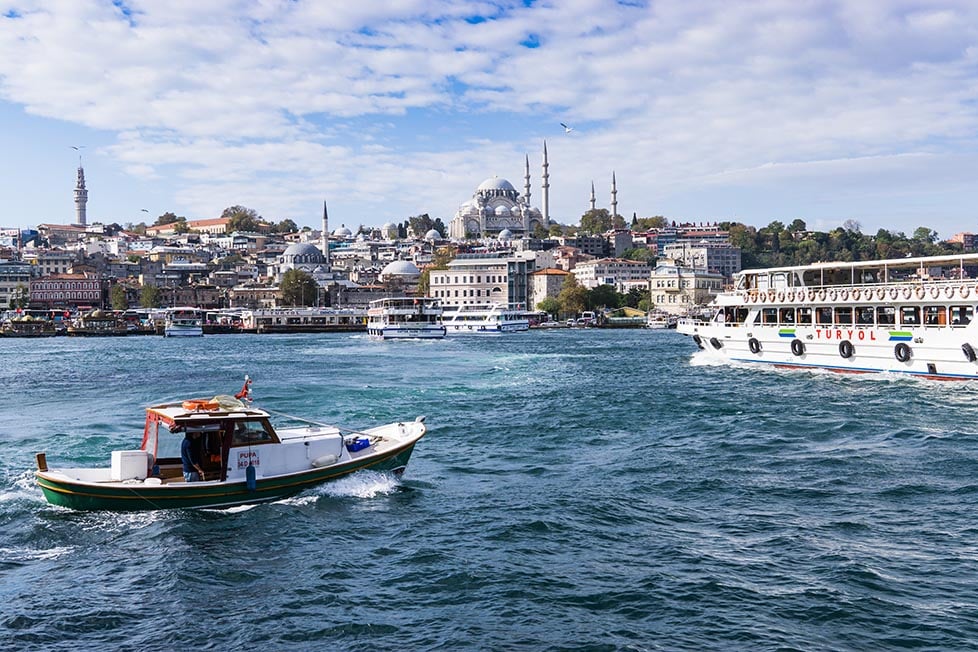
There are many mansions along the water that are worth seeing, the most grand of which is Dolmabahçe Palace. After touring the palace, grab some lunch and relax in one of the parks; Emirgan and Maçka are the two of the loveliest.
Finally, across the iconic Bosphorus Bridge is the Asian Istanbul . As we venture this far from the city center, the featureless suburbs begin. There are still some noteworthy locations worth visiting around here though.
At the base of the Bosphorus Bridge is Beylerbeyi Palace, which is predictably elegant. Further south, the Maiden’s Tower stands in the middle of the bay. In my opinion, the best part about the Asian side of Istanbul is Çamlica Hill – one of the highest points in the area, this hill probably has the most expansive views of the city. You can easily spot the hill in the distance by its many radio towers.

Backpacking Ankara
Ankara is the federal capital of Turkey and acts as a bit of foil to Istanbul. Where Istanbul shines as the cultural and historical apex of the nation, Ankara represents the future: a modern, secular community that is racing forward faster than any other Turkish city.
Ankara is a huge, bustling metropolis of 4.5 million people. The appearance of the city is very different from Istanbul – sleek, efficient, contemporary, functional. You won’t find many grand relics from the former Ottomans or Seljuks, the likes of which Istanbul is famous for. Here, you’ll have to dig deeper into corners and cracks of the city.
Most of Ankara’s top attractions are found in the city center ( Kizilay ) and around the Ulus district. Most prolific of these sites is the neo-classical mausoleum Anitkabir, which is dedicated to Turkey’s first president, Ataturk. This is a very nationalistic building and Turks visit from all over the world to pay their respects here.
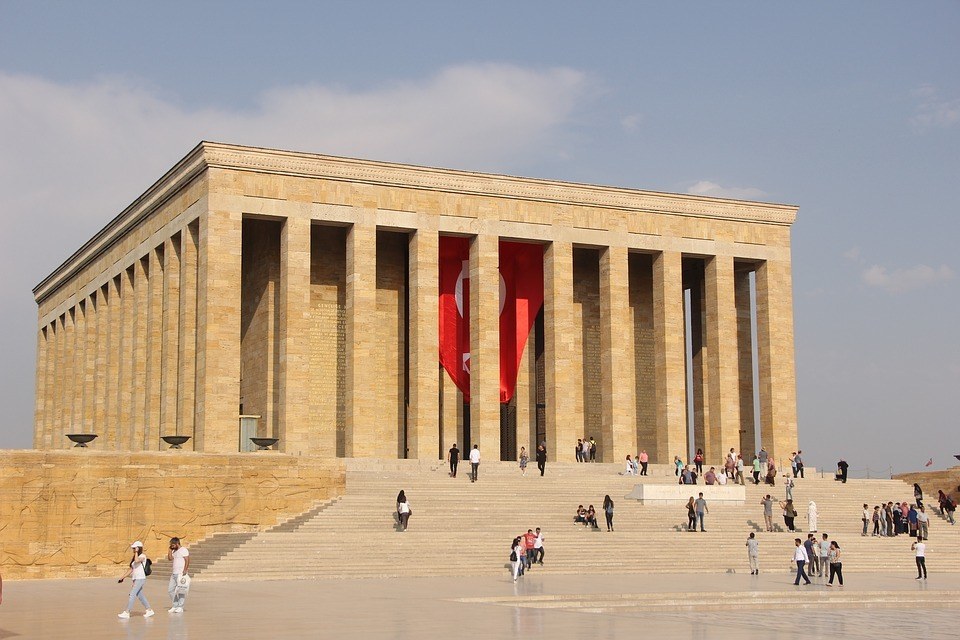
Also worth seeing are the Kocatepe Mosque, which could rival the Blue Mosque in Istanbul, the Museum of Anatolian Civilizations, and Ankara Castle, which is perched up on a hill overlooking the central districts. Also worth seeing in Ankara is the newly renovated Hacettepe neighborhood as it contains some significant Ottoman architecture.
Since Ankara is one of the most important economic centers in all of Turkey, it has an amazing food and drink scene. Restaurants here are particularly impressive no matter where you look – a good place to start would probably be this Ankara food guide .
There are many bars south of the city center around Tunali , Tunus , and Kennedy streets. Most are very lively and go strong until closing at 4am. Expect to see all sorts of locals at these establishments when going out yourself.
Backpacking Bursa
Bursa was the original capital of the Ottoman Empire and, as such, hosts some of the most brilliant historical places in Turkey. It is also conveniently located next to Uludag mountain, which is one of the best places to ski in Turkey!
Bursa’s greatest attractions are its mosques and tombs. The aptly named Grand Mosque of Bursa is (appropriately) the best one to visit. This mosque is famous for its 20 domes and 192 inscribed panels, which, collectively, form one of the finest calligraphic accomplishments in the Muslim world.
Other notable mosques in Bursa are the Green Mosque, the Emir Sultan Mosque, the Orphan Mosque, and the Muradiye Complex. Most of these have equally impressive tombs that host several key figures from Turkish history.
Also worth seeing in Bursa is the Koza Han Silk Market, the 600-year-old Inkaya tree, and the Darüzziyafe, an old poorhouse turned restaurant that serves up some of the most authentic Ottoman cuisine in all of Turkey.
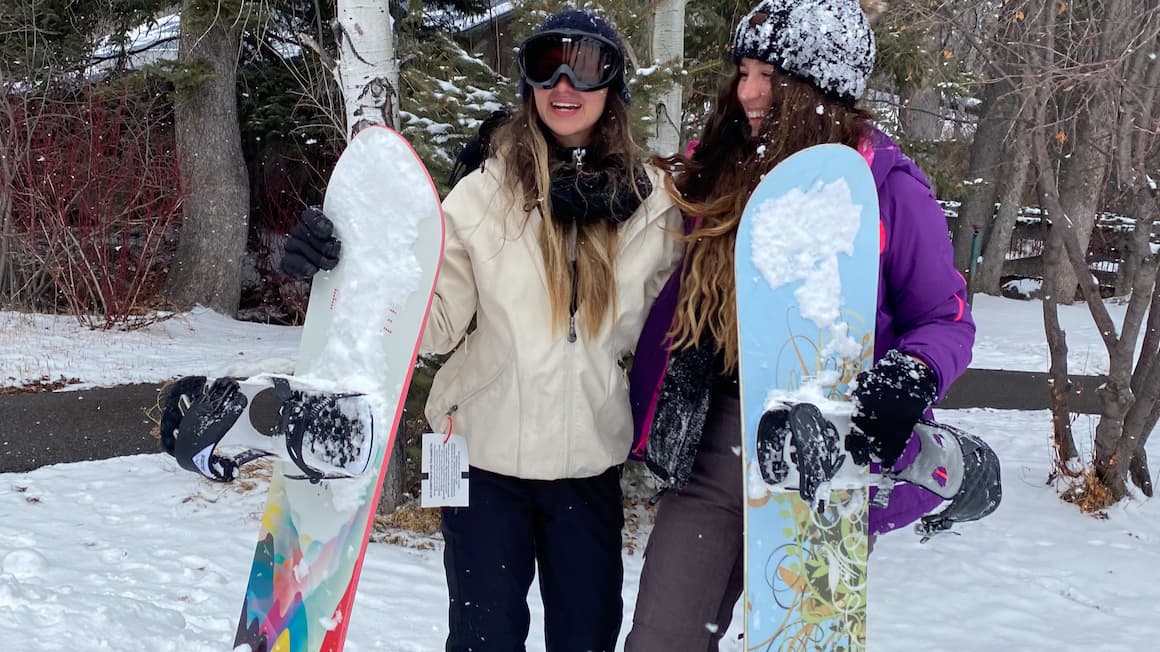
Just outside of Bursa is Uluda? , the highest mountain in Northwestern Turkey and home to the nation’s top winter resort. Skiing here is one of the best things to in Turkey in the winter!
Skiers can easily access this mountain via a 20 mile or so road or by a cable car that departs from Bursa’s Teferrüç neighborhood. Most people will opt to take the road as the cable car is frequently shut down by poor weather and usually too crowded to allow people to bring ski or snowboarding equipment.
Note that the road is unpaved following the gate at Karabelen and that driving conditions may be sketchy. Be sure to carry tire chains at all times during the winter. Hesitant drivers can grab a dolmus in Tophane .
Backpacking Izmir
Izmir holds many distinctions: it’s the third largest city in Turkey, the second busiest port in the country, and one of the largest metropolitan areas in the entire Aegean Sea – second only to Athens, Greece. The city has prospered like this for a good 4000 years, in fact, thanks in part to its favorable location. Long story short: Izmir is one of the most important urban areas in the entire Aegean region.
Konak Square is the city’s central hub. Around here you can spot the famous Clock Tower as well as several mosques including Yali Mosque and Kemeralti Mosque. Next to Kemeralti is a market where you can find a nice cup of tea or whatever you want really. If you’re looking for some sweeping views, you should check out the Asansör (meaning elevator in Turkish) located south of Konak.
Those looking for more antique attractions should best head to the old remains of Smyrna , where some of the original Roman structures can still be seen, or to Kadifekale , which is where you’ll find an old castle among some ramshackle houses.
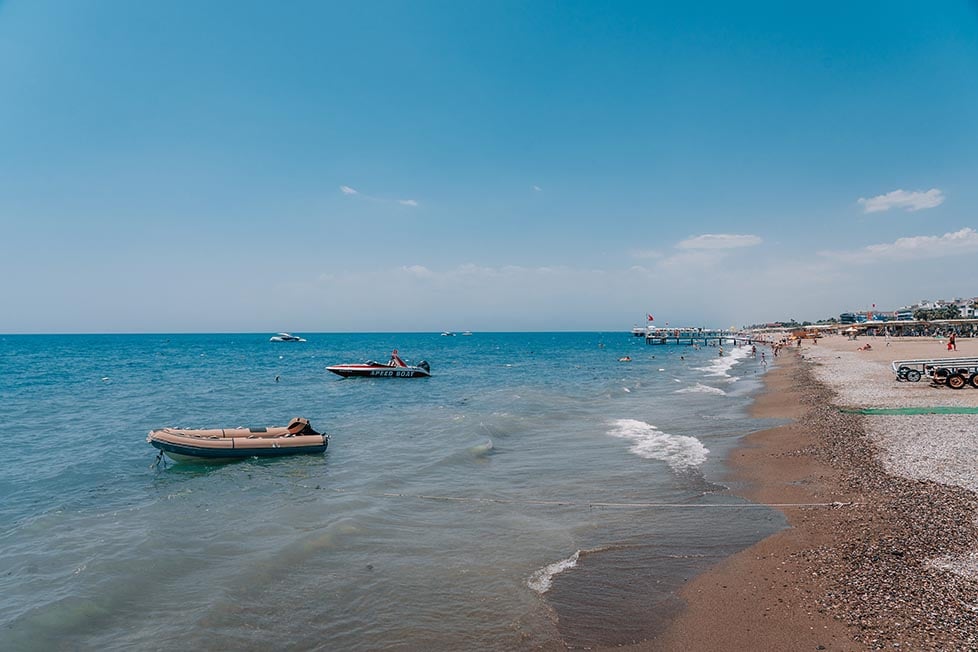
Izmir marks the official beginning for the Turkish Riviera aka Turquoise Coast ! Running all the way to Antalya, the Turkish Riviera is one of the best parts of Turkey. The Turkish Riviera is full of interesting archaeological sites in addition to, most importantly, the best beaches in Turkey.
Çesme is the most popular beach town near Izmir and loved by many Turks. Greece – specifically the island of Chios – is literally right there across the straight as well – you can take a short ferry to visit it.
There are several more picturesque villages besides Çesme that are worthy of visiting. Some notable ones include Ilica, Foça, Alaçati, Bademli, and Bergama .
Backpacking Selçuk
Just a little south and more inland of Izmir is the town of Selçuk. The town itself is not much to speak of as there not so many significant attractions. The lone pillar of the once wonderous Temple of Artemis is certainly noteworthy if not underwhelming, while the Basilica of St. John, House of Saint Mary, and the Cave of Seven Sleepers are a bit more exciting to theological buffs.
What Selçuk does have going for it is a ruined city that is among the most magnificent in the entire world – Ephesus . Ephesus was, at one point, one of the most important Roman cities in the Aegean. Deprived after its port silted-up and sacked by the Goths in the 3rd century AD, Ephesus fell into obscurity. After its rediscovery in the 19th century, Ephesus has since become one the largest excavated areas on the planet and one the best preserved.
Getting to Ephesus from Selçuk is very easy. Many people simply walk to the ruins or rent bikes from their respective lodging. Once at Ephesus, you literally walk around the grounds like it was still an active city.
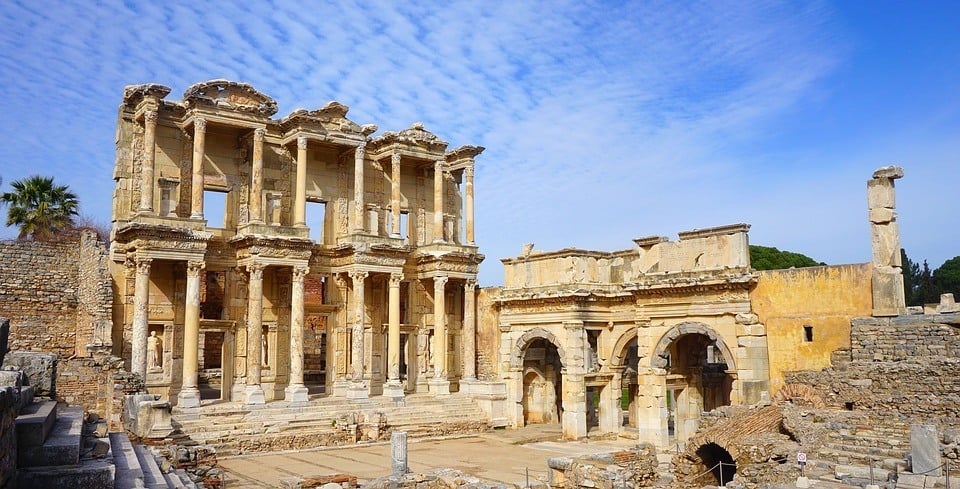
The most arresting sight in Ephesus is the Library of Celsus, once the third largest in the whole classical world. This columned, two-storied building is extremely impressive and arguably the most beautiful singular Roman building in the world. Another equally impressive site is the Great Theater, the largest Roman theater still in existence whose capacity tops 24,000 people.
In addition to these two superlative places, there is so much to see in Ephesus. The Temple of Hadrian, the Terrace Houses, the Temple of Serapis; all are totally worth seeing. Best advice is to grab a map and just start walking around.
Backpacking Pamukkale
Pamukkale is one of the best places in Turkey to visit! These natural travertines are among the nation’s most interesting natural landmarks and need to be seen in person.
Pamukkale’s distinct appearance comes from the interaction of various minerals that are dredged up at the hot springs. As they react and combine with one another, calcium carbonate is formed, which appears as a brilliant shade of white when hardened. As the calcium carbonate flows down the hillside from the springs, hundreds of little pools are created as well, resulting in a honeycomb-like arrangement of perfectly still ponds.
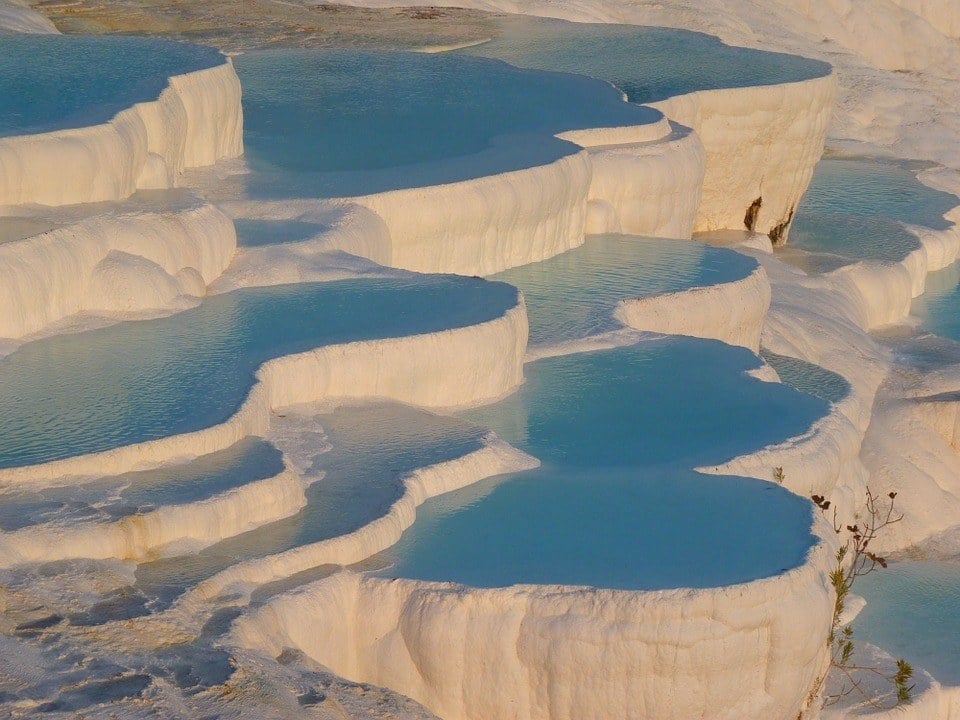
These days, Pamukkale is a huge attraction. To preserve what remains of it, the park wardens require visitors to remove their shoes and to refrain from bathing in the natural pools. Several man-made swimming holes have been erected along the boardwalks in order to appease bathers though these are far less attractive as the real ones. Don’t forget to check out the ruins of Hierapolis on the other side of the hill – once an ancient resort for Romans, the only thing that remains of it is an impressive amphitheater.
I will admit that Pamukkale feels a bit like a tourist trap at the moment, complete with a water park at its base. The site is certainly something to behold and still totally worth visiting though it’s not as pure as the photos make it out to be.
Those visiting Pamukkale should definitely consider making a day trip out to the ruins of Aphrodisias . Though not the most famous landmark in Turkey, Aphrodisias is still very impressive. Those who want to get away from the crowds and pay less ought to consider Aphrodisias over Ephesus.
Backpacking Bodrum and Marmaris
Bodrum and Marmaris are two of Turkey’s top coastal resort towns. Both offer near identical attractions for those visiting the Turkish Riviera. You’ll find beaches, nightclubs, boutique shops, and plenty of rich holidaymakers in both of these getaways.
In Bodrum, there are several beaches spread throughout the city – choosing where to stay in Bodrum is therefore important. The water is a lovely temperature and quite clear so long as you’re away from the marinas. Most beaches are belong to some resort, whom can provide refreshments at the bar and sunbeds for lounging.
In the evening, the beach clubs explode with people who are looking to party. The nightlife in Bodrum is among the best in Turkey! Refer to this Bodrum club list for some of the most chique clubs in Bodrum.
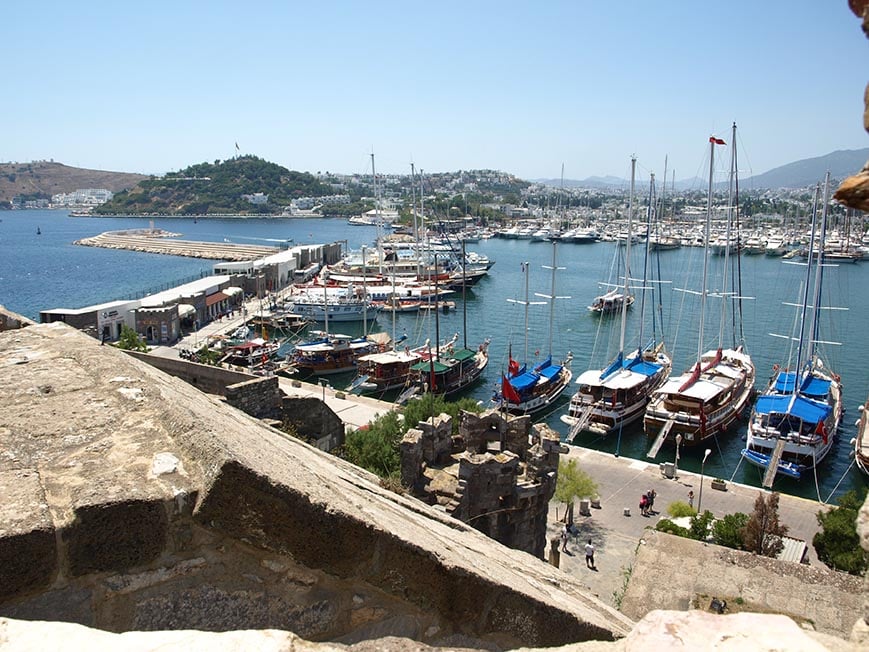
Partying and beaches aside, there are several noteworthy archaeological sites in Bodrum. The ruined Mausoleum of Halicarnassus, once one of the Seven Wonders of the World, is conveniently located near the center of the city. The impressive Bodrum Castle, which once served as a headquarters for the Hospitaller Order, is at the head of the Bodrum Marina. Aside from its impeccable condition, the castle also serves as the Museum for Underwater Archeology, renowned for its collection of unique aquatic relics.
About 2 hours drive from Bodrum is Marmaris, which, as I already mentioned, is pretty similar to Bodrum. Marmaris does offer a little more in the way of scenery as it lies within the mountainous Marmaris National Park and at the head of a beautiful bay. This bay, framed by two peninsulas, is full of little towns and secret beaches.
You can visit these peninsulas either by car or boat. If you choose the latter, you will always be joined by a dozen or so other people though the yachts are usually really kush.
Backpacking Fethiye
Fethiye is one of the most popular destinations on the Turquoise Coast. In its vicinity are some of the best beaches in Turkey as well as some very unique Lycian ruins .
Fethiye, at the end of the day, is just a city and most will simply use it as a base for making day trips. There is a city beach, called Çalis Plaji, but, compared to the beaches outside of Fethiye, it’s a little uninspiring.
The nearby village of Ölüdeniz is perhaps the most alluring spot near Fethiye. Known primarily for its “Blue Lagoon,” Ölüdeniz is immensely popular with tourists. Many just enjoy chilling on the lagoon’s pristine beaches; others prefer taking to the skies with one of the many paragliding companies where the views of the Blue Lagoon are astounding.
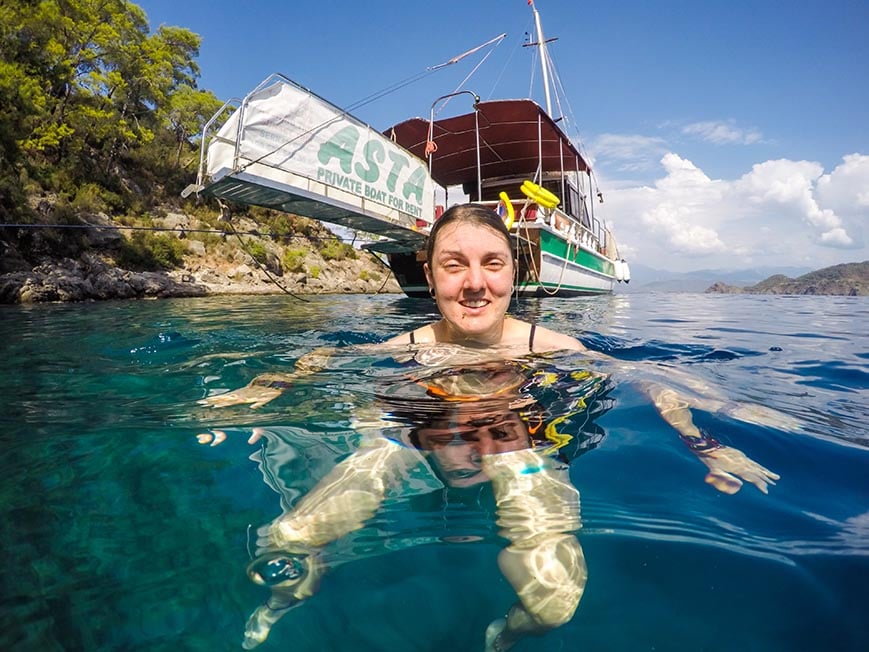
Just as impressive as the Blue Lagoon are nearby Gemilar Island , Kelebekler Vadisi, and Kabak Plaji. Meaning “Butterfly Valley,” Kelebekler Vadisi makes for a wonderful hike that includes, as the name suggests, lots of butterflies in addition to a hidden beach. Backpackers should also head inland towards Tlos and Xanthos for some awesome Lycian ruins as well as Saklikent Gorge for some amazing hikes.
Once you have seen all that Fethiye and the surrounding area offers, head southeast towards Kalkan and Kas . These towns are a little more down-tempo than Fethiye, which can seem hectic at times. The beaches around these towns are just as splendid as anything around Fethiye.
Patara Plaji is a huge stretch of sand located near the ruins of Patara . Of great renown, Kaputas Plaji maybe the most stunning beach on the Turkish Riviera. With a bleached, pebbled shore that is touched by the most brilliant aquamarine water, the photo opps at Kaputas are irresistible.
Backpacking Olympos/Cirali
Olympos is a bit of a legend among those backpacking Turkey for several reasons: 1) it has a very hippy sort of vibe 2) offers some unique accommodation in the form of treehouses and 3) is surrounded by lots of nature. Nearby Cirali is more for families though it still has some spunk. Both are right next to each other – they form, essentially, a single community with only a little gap in between.
The little villages of Olympos and Cirali are right next to the beach. Olympos is where you’ll find the majority of backpackers lodges, usually in the form of treehouses. These are a very popular way of staying in Olympos and there are several lodges offering this form of accommodation. Ciriali offers more conventional lodgings like pensions and bungalows.
There are several things to do while staying in Olympos. One of the most popular is trekking to the nearby ruins from which Olympos takes its name. Hidden in a grove and slightly overgrown, the ruins have a very ethereal feel to them though they are from far grandiose.
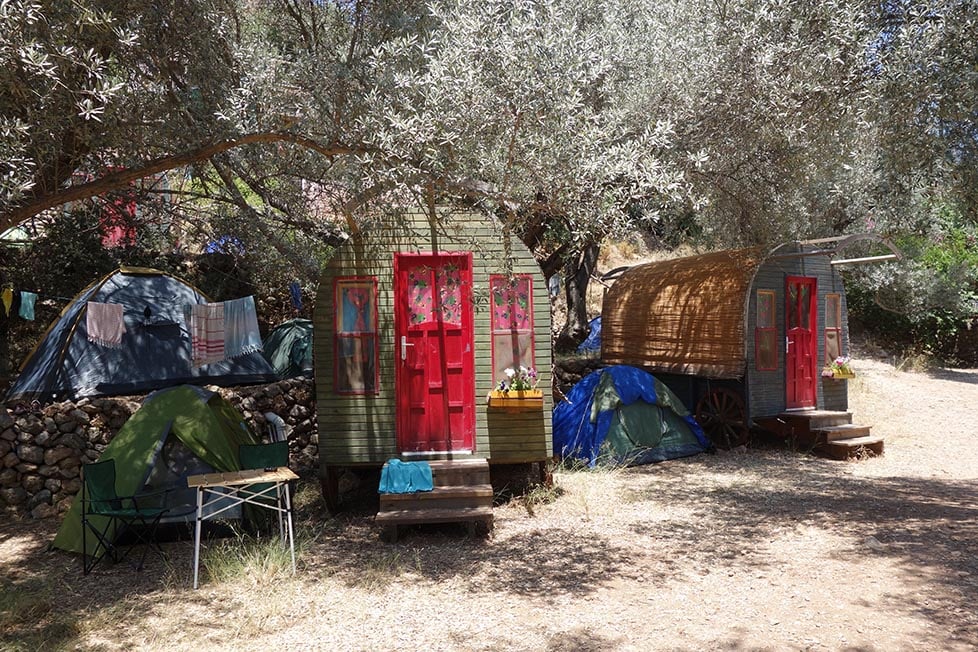
Olympos’ beach is somewhat pretty but its beauty is not its main attraction. If you are visiting between July and October, you’ll have the chance to witness hatching Caretta Caretta sea turtles! The best time to see them hatch is during the cool mornings. Once free, they will make a quick dash for the ocean. Be careful not to step on one!
Other fun activities include visiting the eternally burning Chimera Flames at the top of Yanar Mountain and rock climbing. The sea cliffs around Olympos are touted for the quality of their rock and climbers love to tackle them without any gear – this form of climbing is called deep water soloing .
Backpacking Antalya
Antalya officially marks the end of the Turkish Riviera. Lying at the mouth of a tranquil harbor and the beginnings of the stunning Taurus Mountains, Antalya may have earned the right to say “saving the best for last.” Aside from the usual beaches and historical sites, Antalya offers much more and does a great job of rounding at an already perfect trip.
Within the city are several fascinating points of interest. The Kaleiçi is the old quarter of the city and is characterized by its narrow alleys and eclectic buildings that were built by numerous civilizations from numerous eras. Here you’ll find Hadrian’s Gate, a Roman-era fortification that separates Kaleiçi from the equally charming Kilinçarslan.
Also worth seeing are the various mosques and towers spread throughout Antalya. Yivli Minare is perhaps the most prominent of the bunch. Hidirlik Tower and Tekeli Mehmet Pasa Mosque are also impressive – the former offers great views of the city.
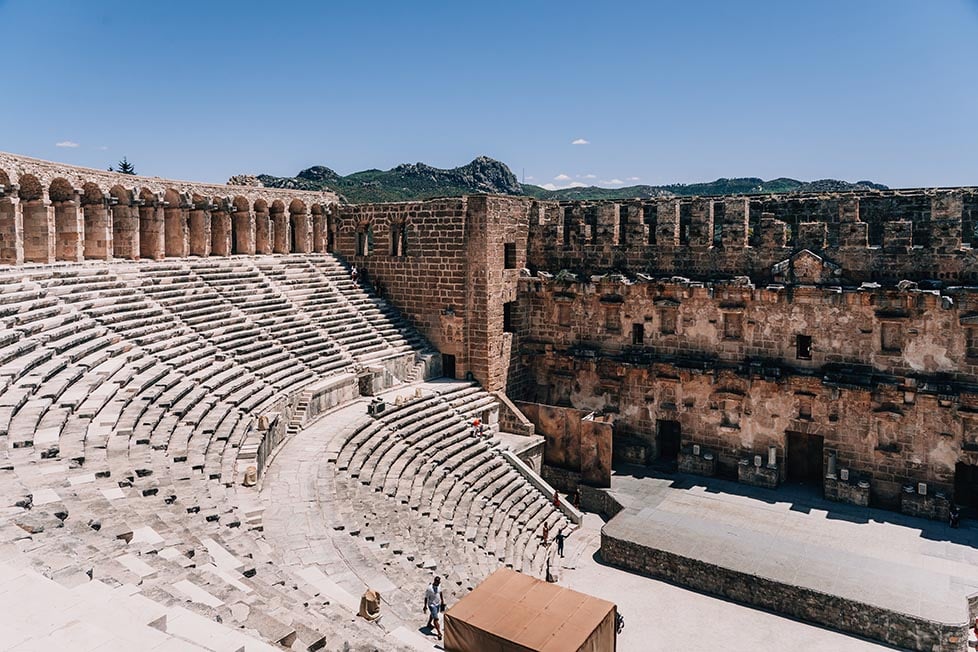
The local beaches are Lara and Konyaalti. Both are fairly good beaches to lounge on but are best experienced at sunset when the sun dips behinds the mountains – the scene is quite spectacular.
Outside of Antalya are a number of excellent natural parks. Kursunlu Waterfall is a whimsical cascade located in a lush basin. The water here flows in the most delicate of ways though it’s reduced to a mere trickle in the summer months. Be sure to visit Köprülü Canyon , a deep, rugged ravine that is very popular with white water rafters.
Finally, you simply have to stop by the ruins of Termessos . Situated on a flat section of the 5,500 ft high Güllük Dagi , Termessos is an extremely arresting site; it is the Machu Picchu of the Mediterranean, if you will.
Our Where To Stay in Antalya guide will help you get started.
Backpacking Cappadocia
Cappadocia is one of the most beautiful places in Turkey and is one of my favourite places in the world. I’ve spent nearly three weeks traveling in Cappadocia, over two trips, and have camped out in many of the abandoned hermits caves and churches.
The geography here is utterly stunning, having a character and appearance that is found nowhere else on the planet. Over eons, the landscape has been carved by the elements into delicate towers or “fairy chimneys.” From the ground, humans have had their own way with the rock, creating caves, intricate tunnel systems and even massive churches to escape the oppressive heat and freezing cold of the winter.
The most-visited village in Cappadocia is Göreme . Here you can stay in a cave hostel or hotel for a very reasonable price. These underground lodges are surprisingly comfortable and actually quite spacious, if not dim near constantly. Urgup and Uchisar are also good places to stay in Cappadocia; the latter has a pretty cool castle.
There is so much to do in Cappadocia! Visit its subterranean labyrinths including the mind-bogglingly cool Kaymakli and Derinkuyu as well as the Open Air Museum at Göreme. Definitely pay a visit to a subterranean monastery as well, the most impressive of which is Gümüler with it elegant frescos. I strongly recommend hiring a car to get around Cappadocia – it’s a really big, sprawling area. I hired a car for under 30 euros a day.
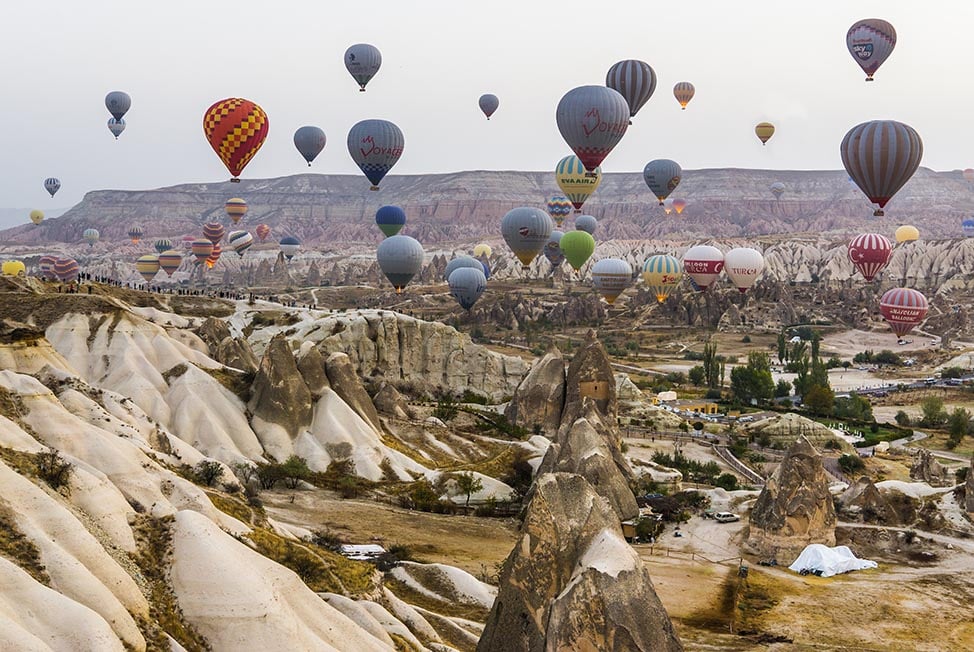
Above ground, you must go for a hike in and around one of the many valleys. There are plenty of trails, most of which are heavily trafficked by hikers, though you could very easily get away from them. I myself did an offshoot of the Rose Valley trail and never saw a single person along the way. Aside from the Rose, be sure to check out the Love, Pigeon, and Red Valleys .
Finally, no trip to Cappadocia would be complete without a hot air balloon ride. There are several companies around Göreme that will take you up in the air for some amazing views. Fair warning though: these tours can be quite expensive and most are fairly brief (30-60 minutes in length). If you don’t want to bother, at least wake for sunrise to see the many airborne balloons – the sight of them from the ground is arguably more enchanting than actually being in them.
I strongly recommend camping out (tidy up all your stuff and leave no trace!) whilst in Cappadocia. Also, check out our ultimate guide on where to stay in Cappadocia .
Wanna Go On a Treasure Hunt?
There are so many little hidden gems spread throughout the Cappadocian countryside: age-old dwellings, forgotten pathways, buried secrets. One such treasure is a hidden geocache arranged and stashed away by me! The time capsule was found (and swiped away) by some (un)fortunate soul but that doesn’t mean that finding the cave still can’t be an adventure!
Off the Beaten Path in Turkey
Turkey is a huge country and most only manage to see the western half of it. Little do they that some of the most spectacular sights in the whole country are in eastern Turkey! Here are Turkey’s real treasures – ancient ruins from before the Greeks, epic mountains that rise like bulwarks, and some of the cleanest, freshest lakes in the whole country. Those who intend on visiting the unexplored places of Turkey must make an effort to visit this part of the country!
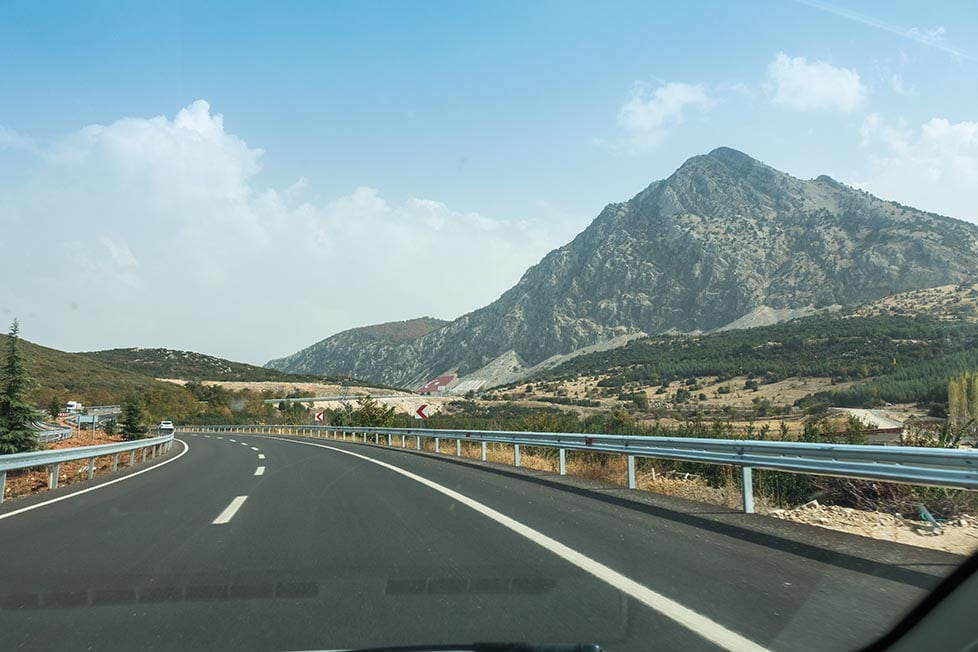
The Southern and Eastern Turkey provinces are currently subject to much civil unrest. On the borders of Syria, refugees are pouring into the country in disheartening numbers, resulting in violent crackdowns by the government. In the Kurdish controlled areas, many are calling for insurrection against the oppressive Turkish government. Riots, protests, and militant reactions are all very common in this part of the country. The following extract is an informative map of the conflict.
AS OF JUNE 2018 , we at the Broke Backpacker strongly advise travelers to be extremely careful when visiting these off-the-beaten-places. Though many areas are safe (particularly those farther north and around the Black Sea) and tourists are mostly left alone, there is always a chance of being caught in a conflict. Keep your head on a swivel and don’t do anything rash.
Backpacking Eastern Anatolia
Eastern Anatolia is where Turkey begins to change. To the northeast, the Caucasus Mountains rise; to the far east, the ancestral land of the Kurdish people spreads before you. This is a very exotic and lesser-visited part of Turkey, one that is defined by soaring mountains, pristine lakes, and misty coastlines.
Traveling along the Black Sea due east, the first city that you’ll encounter is Trabzon . Trabzon is a very historically significant city, having served as the capital for many medieval kingdoms and as a vital trading post on the Silk Road. Some remnants of its former glory are still evident in the city but, nowadays, Trabzon mostly serves as a base for seeing the surrounding countryside.
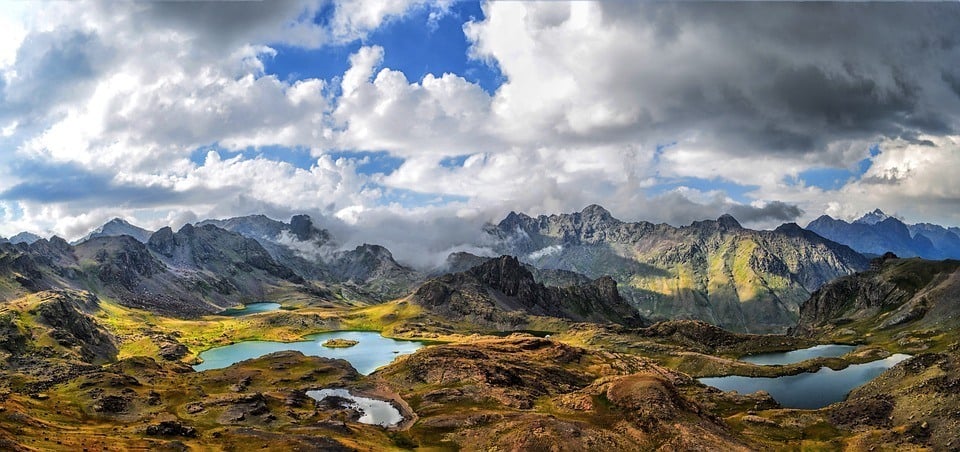
From Trabzon, you can access several superlative locations. The Sumela Monastery, perched precariously upon a cliffside, is the most popular attraction in the area and one Turkey’s greatest historical places. Uzungöl Lake and Hidirnebi Plateau are also within a few hours drive from Trabzon – both are stunning locations that make for lovely day trips. Finally, Trabzon makes for an excellent jumping-off point into the awe-inspiring Kaçkar Mountains – these mountains are among the most beautiful places in Turkey.
Further east towards the border of Armenia and Iran is Dogubeyazit . This is the best spot for crossing the border as well as beginning the long climb up Mt. Ararat . The ancient Ishak Pasa Sarayi and nearby Muradiye Waterfalls are also worth seeing.
A little south of Dogubeyazit is Van and its claim to fame, Van Lake , which is one of the most beautiful lakes in all of Turkey. Several castles and monasteries dot the lake’s shore – of particular beauty is Akdamar . Swimming in Van Lake is possible but know that it’s composed of soda-salt water – swallowing some may be an uncomfortable experience.
Backpacking Southeastern Turkey
Southeastern Turkey is an ancient land that has seen the rise and fall of many civilizations from Mesopotamians to Levantines to Persians. Visiting here will afford travelers the opportunities to see some of the most significant historical places in Turkey.
There are a couple of large cities that will serve as brief layovers. Diyarbakir is the largest in the region and has a few interesting churches in addition to some impressive medieval walls. Gaziantep is pretty much only known for its castle. Urfa , though not the largest metropolis, is certainly the most beautiful as its full elegant Middle Eastern architecture and juxtaposing high rise buildings.

Hasankeyf and Mardin are the two most wonderful villages in Southeastern Turkey. Mardin is a gorgeous hilltop village that is characterized by its stone houses and imposing, crowning citadel. Seriously, this village looks straight out of the Old Testament or maybe some sword-and-sandal movie. Hasankeyf is an odd little city straddling the Tigris River that looks a little bit like Göreme; here, there are lots of little hovels built into the cliffs that resemble the cave dwellings of Cappadocia.
Göbekli Tepe and Harran are too very important archaeological sites in Southeastern Turkey . Göbekli Tepe is an ancient complex dating back to some of the first known Mesopotamian people; its very existence is turning heads in the historical community. Harran is the remnants of an ancient community and its most noticeable feature is its “beehive houses.”
The most famous site in Southeastern Turkey has to be Mount Nemrut and its colossal busts. At the top of the mountain, you’ll find a field full of enormous severed stone heads. Once attached to bodies, these heads guarded the tomb of an ancient king; at some point, they were removed and scattered on the ground.

We’ve tested countless backpacks over the years, but there’s one that has always been the best and remains the best buy for adventurers: the broke backpacker-approved Osprey Aether and Ariel series.
Want more deetz on why these packs are so damn perfect? Then read our comprehensive review for the inside scoop!
Top Things to Do in Turkey
1. drive along the turquoise coast.
See the finest coastline in Turkey! Visit one of the many villages and resort towns along the way and be sure to keep your eyes open for hidden beaches. Don’t surprised if you stumble upon some ruins as well – this is one of the most significant archaeological areas in the whole country.
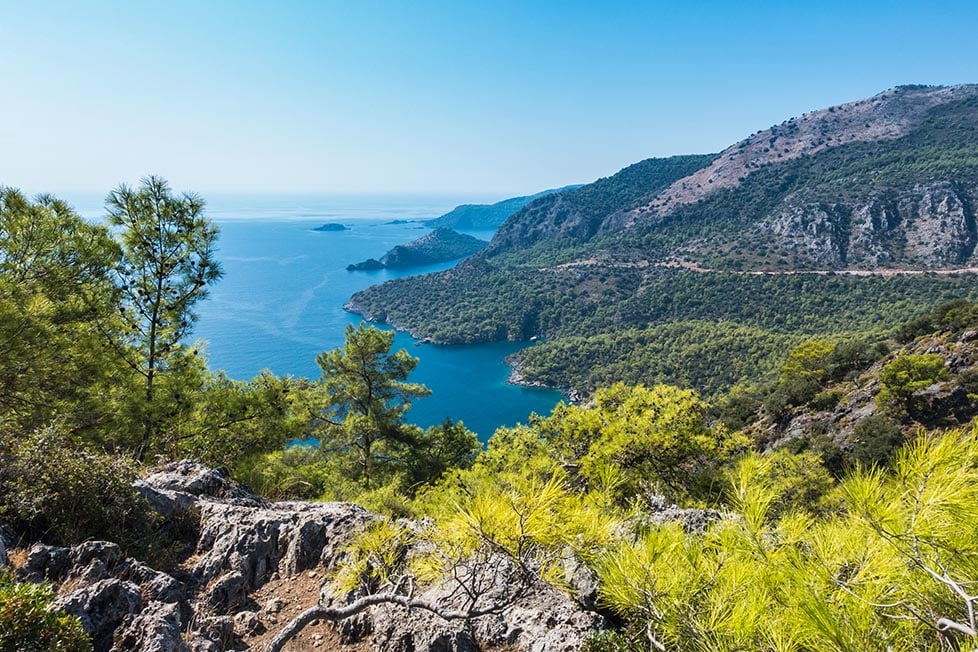
2. Visit the travertines of Pamukkale
The travertines of Pamukkale are absolutely heavenly, fit only to bathed in by gods and goddesses. 4. Appropriately, no one is allowed in the pools anymore for preservation reasons. They still make a pretty sight though!
3. Get lost in Istanbul
Istanbul is certainly the best city in Turkey, not to mention one of the coolest in the world! Get lost in its many neighborhoods. Wander around the Old City or along the banks of the Bosphorus. Step inside the Hagia Sophia and try to not let your jaw hit the floor.
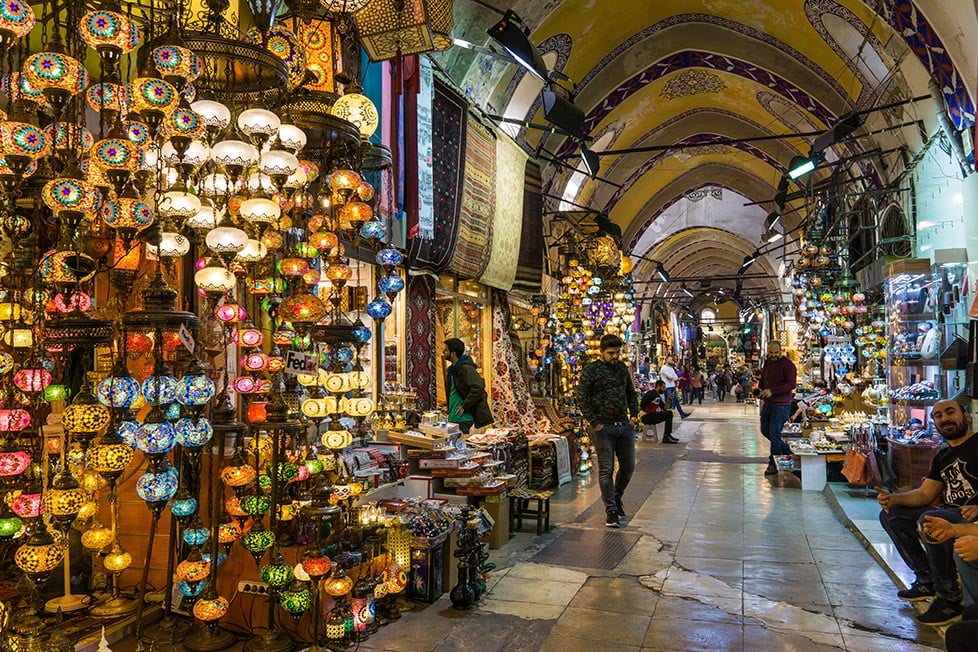
4. Find the hidden treasures of the Eastern provinces
Some of Turkey’s best places are really out of the way! Try and take time out of your trip to visit one of the unexplored places of Turkey, like Mardin or Mount Nemrut. Many of these locations possess histories that are older than most modern nations.
5. Stay in a cave in Cappadocia
The landscape here is out-of-this-world! You’ll find some really strange, perhaps even “arousing” sites, like the Valley of Love. Consider taking a hot air balloon ride in Cappadocia for some stunning views.
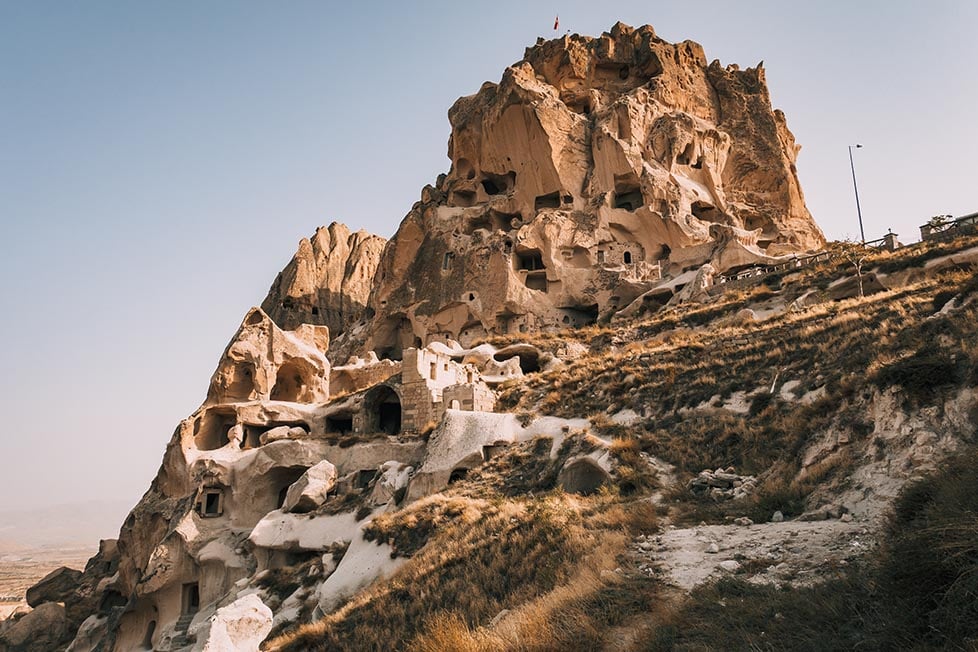
6. Play in the snow
Skiing and snowboarding are among the best things to do in Turkey in the winter! Few realize that Turkey receives a solid amount of snow and that some of its ski resorts are actually world class. Grab your poles and hit the slopes!
7. Go on one of the many world-class treks
Between the deserts of Cappadocia, the coastal paths of Lycia, and the mountains of Kaçkar, Turkey is not lacking at all in natural beauty. Go hiking around anyone of these locals for some really inspiring views.
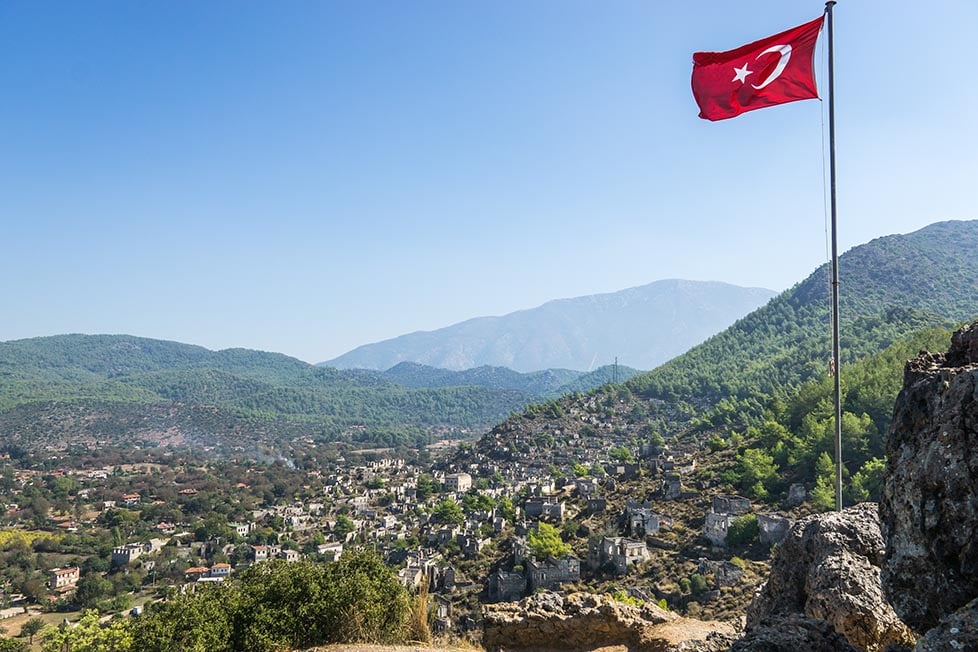
8. Partake in a Turkish feast
Kebabs, mezzes, karniyarik, baklava, oh my! Turkey has some of the best food around and trying some of it is absolutely mandatory. Drop by a little cafe for a sampling or go all out at restaurant and feast like royalty.
9. Visit Ephesus and/or the many other classical ruins
Turkey hosts some of the world’s most impressive classical ruins. Visit the like of Emphasis, Aphrodisias, Termossess, plus many, many more for a taste of the ancient world.
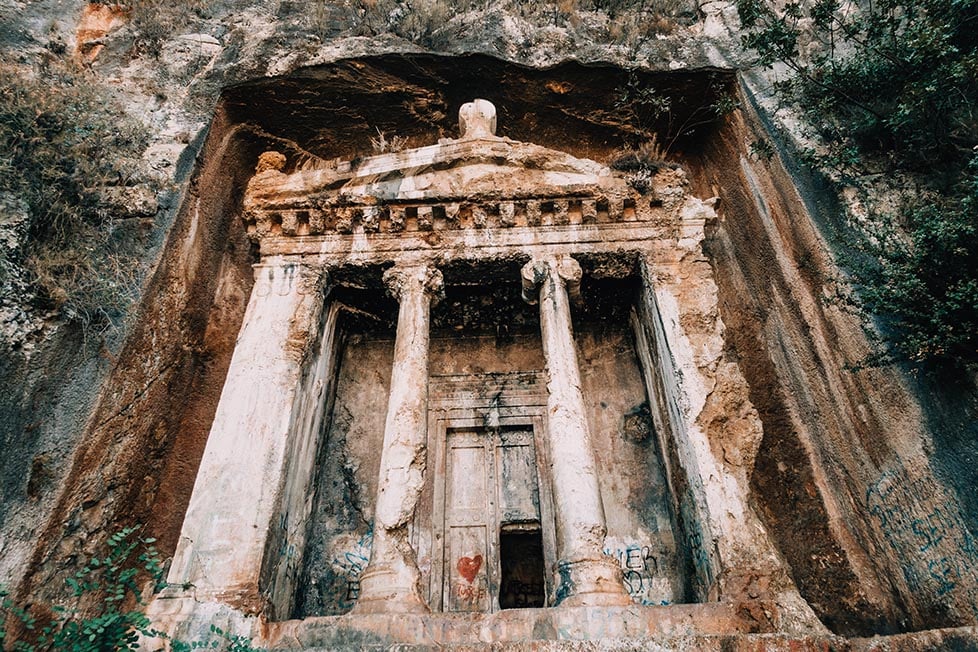
10. Experience a Turkish Bath
Turkish spas or hamams are great places for several reasons: 1) the architecture is beautiful 2) the conversations are amazing and 3) it can be very relaxing. Visit any one of the ubiquitous bathes to get a feel for Turkish life. Be careful with the messages though – they can be quite rough.

Wanna know how to pack like a pro? Well for a start you need the right gear….
These are packing cubes for the globetrotters and compression sacks for the real adventurers – these babies are a traveller’s best kept secret. They organise yo’ packing and minimise volume too so you can pack MORE.
Or, y’know… you can stick to just chucking it all in your backpack…
Backpacker Accommodation in Turkey
Turkey has a ton of convenient backpacker lodges to choose from! These come in the form of hostels, hotels, apartments, camps, and even caves!
Much like Europe, hostels are a very popular form of backpacker accommodation in Turkey. Compared to their European counterparts, most Turkish hostels are a screaming deal as well, offering excellent amenities and at a great price. Those backpacking around Turkey should definitely take advantage of these lodges!
Unfortunately, there are a limited number of hostels in some destinations and many book up fast. Some places won’t even have a hostel available. In these cases you’re best bets will either be hotels, campgrounds or an apartment.
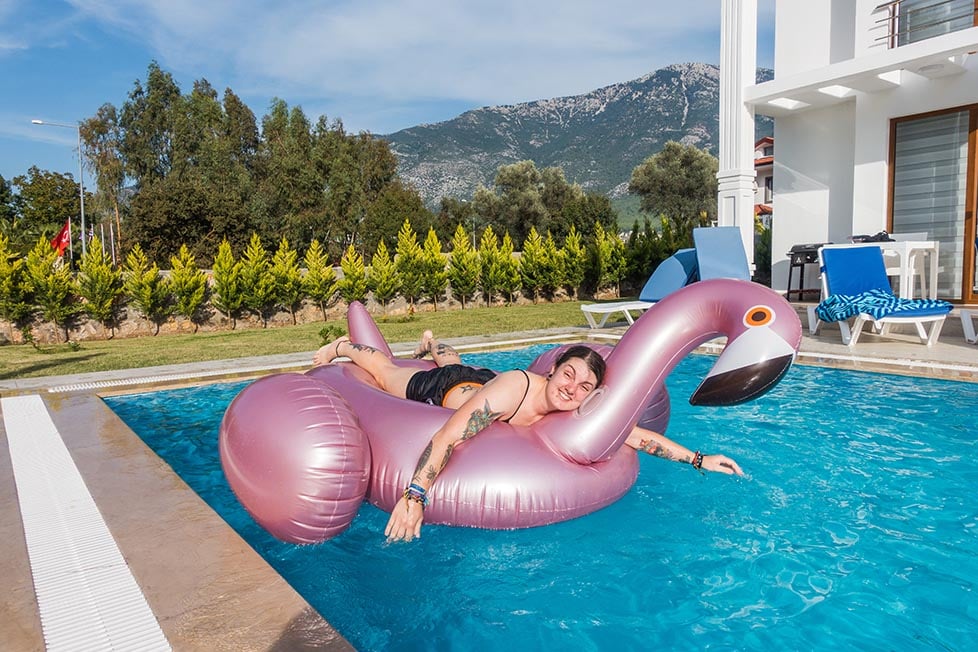
Though pricier than a dormitory, hotels in Turkey are still very well-priced. Offering slightly better digs for slightly more money, hotels will sometimes be your only option in the more remote parts of the country.
There are lots of campgrounds spread throughout Turkey. Many are fully equipped with bathrooms, running water, and electricity, while others are quite primitive. The more primitive ones can be very cheap (even free sometimes) but make sure that it’s okay to crash there – some campgrounds are unofficial and may illegally lie on private or government property.
The Best Places to Stay in Turkey
Backpacking turkey costs.
Backpacking in Turkey on a budget is very doable these days. Backpackers could easily get by on $25-$40 per day with decent spending habits. More militant budgeters could even spend as little as $10/day if they tried to!
The average hostel dormitory will cost around $5-$15 per night. Some more luxurious locations may cost more than $20 but that’s pushing it in Turkey. Camping, of course, will be your cheapest means of accommodation while backpacking Turkey. If you’re into wild camping, you may even be able to set up shop for free in the woods, so long as it isn’t on someone’s property or in a park.
We at Broke Backpackers always recommend couchsurfing to travelers as it’s usually a great way to meet locals and save some cash. Turkish people are quite hospitable and take hosting very seriously – staying with a Turk could end up being a grand ol’ time.
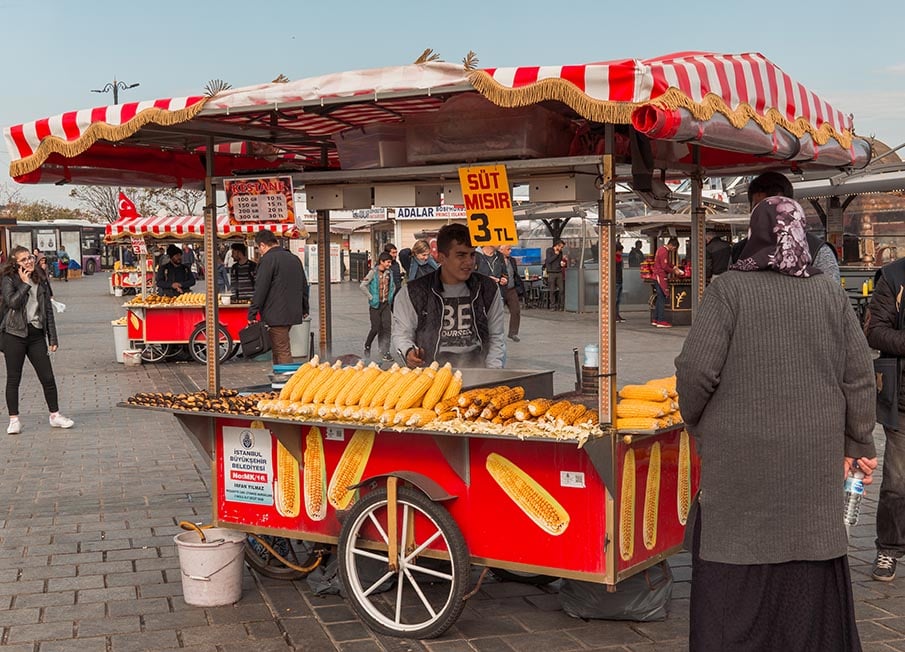
Food and drink in Turkey should never cost too much money, especially if you like street food dishes! A decent meal will cost $5-$8 at a cafe or cheap restaurant. Drinks should cost between $2-$4 depending on their strength and preparation. If you wanted to feast, you could definitely find a great big meal in a nice restaurant for $10-$15, which is a steal given the fact that Turkish food is amazing.
Most of the expenses that you’ll wrack up while backpacking Turkey involve transportation and tours. Turkey is a big country and distances can be quite long; the farther you travel, the pricier the ticket. Likewise, participating in some of Turkey’s greatest experiences can be quite expensive as well. Booking a place on one of Cappadocia’s infamous hot air balloons will easily run you $200-$300. Moral of the story: choose your activities and destinations wisely.
Turkey Daily Budget
Money in turkey.
The official currency of Turkey is the Turkish lira . As of June 2018, the Turkish lira’s official conversion rate is 1 lira=0.22 USD.
You can easily change money one of the many exchange offices or banks found around the Turkish urban areas. USD and Euros demand the best conversion rates at these establishments. ATMs are widely available as well and withdrawing money is an effortless affair. Some ATMs may charge a withdrawal fee on top of whatever your bank charges for foreign transactions.
Bargaining is practically ingrained in the Turkish culture and is absolutely mandatory while shopping in Turkey. Nearly every shopkeeper that you meet will give you an initial price that is above the actual value of the product. When bargaining, be patient and respectful and know that the price will eventually fall. Don’t try to bargain in restaurants or cafes – prices here are usually set in stone.
Top Tips for Broke Backpackers
- Camp : There are lots of opportunities to camp in Turkey! Check out this post for a breakdown of the best tents to take backpacking. If you’re feeling real adventurous and want to save some cash, consider picking up a backpacking hammock.
- Cook your own food: If you are on a tight budget, you can save money by cooking your own food – I recommend bringing a portable backpacking stove.
- Book your transportation early: Both plane and train tickets are much cheaper if you purchase them in advance. This rule does not apply to buses, which you can often book within the day or even hour.
- Couchsurf: Turkish people are awesome, but I would be cautious if you are a woman travelling alone. Check for reviews. That being said, Couchsurfing to make some real friendships and see this country from the perspective of locals.
- Pack a travel water bottle and save money every day!
Why Should You Travel to Turkey with a Water Bottle?
Plastic washes up on even the most pristine beaches… so do your part and keep the Big Blue beautiful!
You aren’t going to save the world overnight, but you might as well be part of the solution and not the problem. When you travel to some of the world’s most remote places, you come to realise the full extent of the plastic problem. And I hope you become more inspired to continue being a responsible traveller.
STOP USING SINGLE-USE PLASTIC! If you’d like some more tips on how to save the world .
Plus, now you won’t be buying overpriced bottles of water from the supermarkets either! Travel with a filtered water bottle instead and never waste a cent nor a turtle’s life again.

Drink water from ANYWHERE. The Grayl Geopress is the worlds leading filtered water bottle protecting you from all manner of waterborne nasties.
Single-use plastic bottles are a MASSIVE threat to marine life. Be a part of the solution and travel with a filter water bottle. Save money and the environment!
We’ve tested the Geopress rigorously from the icy heights of Pakistan to the tropical jungles of Bali, and can confirm: it’s the best water bottle you’ll ever buy!
When to Visit Turkey
Depending on your itinerary and desired activities, travelers can visit Turkey pretty much year-round.
Turkey is subject to four distinct seasons – it has cold, damp winters and hot, dry summers. Spring and Autumn are generally thought to be the best times to visit Turkey as the weather is more pleasant and there are fewer tourists around during both.
Summers in Turkey can be oppressively hot and quite hazy at times, especially towards the end of the high season. Many Europeans take holidays in Turkey during the summer months as well – high season resulting in overcrowded beaches and inflated prices.
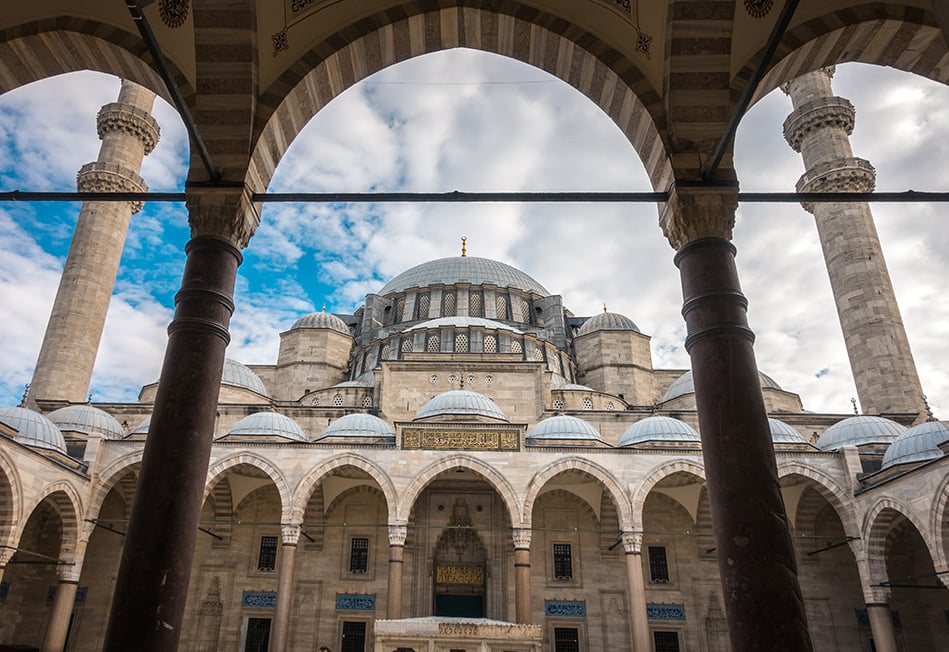
Winters in Turkey can range from dreary to pleasant to harsh depending on the location. Istanbul receives a fair bit of rain and cloud during the winter. The southern, more coastal parts of Turkey are pretty temperate year-round and can be a nice vacation spot no matter when you visit.
Note that the central reaches of Turkey can be very different environmentally from the coastal portions. Most of the interior of Turkey is highlands and plateaus, which means that temperatures fluctuate much more widely. Summers are very, very hot and winters are quite cold in Anatolia and the Eastern provinces. Snow is very common in these places, so much so that skiing and other winter sports are actually quite doable.
Should you want to see a different side of Turkey, then try visiting one of the many mountain resorts in the winter for some great powder.
Festivals in Turkey
Turkey has all kinds of festivals celebrating everything from the arts to music to cultural traditions. Some celebrations are fairly fresh on the scene, having only been founded within the last decade or so, while others have been going for well over 500 years. Regardless of when, where or how the festival started, you’re sure to have a blast though!
To get you going, I’ve included a list of some of Turkey’s most important festival. Give em’ a look!
- Camel Wrestling Festival (January) – One of the oldest traditional festivals in Turkey. Has received criticism from animal rights group in recent years. Organizers are quick to respond to and oblige concerns.
- Izmir European Jazz Festival (March) – Large Jazz festival featuring artists from Turkey and Europe.
- Oil Wrestling Championship (July) – Final competitions for one of Turkey’s oldest and most traditional sports. Been going for over 650 years.
- Neon Festival (July) – A large festival that features psychedelic, reggae, trance, and other mind-bending music genres. Held in Bursa.
- Zeytinli Rock Festival (August) – The “Woodstock” of Turkey. Largest alternative rock music festival in Turkey. Held near the coastal village of Zeytinli.
- Rock n’ Coke (August/September) – The largest rock festival in Turkey. Often compared to Hungary’s Sziget Festival. Held at Hezarfen Airfield in Istanbul.
- Mevlana Whirling Dervishes Festival (December) – Grand exhibition of Turkey’s most well-known folk dance.
What to Pack for Turkey
On every adventure, there are six things I never go traveling without:

Snoring dorm-mates can ruin your nights rest and seriously damage the hostel experience. This is why I always travel with a pack of decent ear plugs.

Hanging Laundry Bag
Trust us, this is an absolute game changer. Super compact, a hanging mesh laundry bag stops your dirty clothes from stinking, you don’t know how much you need one of these… so just get it, thank us later.

Sea To Summit Micro Towel
Hostel towels are scummy and take forever to dry. Microfibre towels dry quickly, are compact, lightweight, and can be used as a blanket or yoga mat if need be.

Monopoly Deal
Forget about Poker! Monopoly Deal is the single best travel card game that we have ever played. Works with 2-5 players and guarantees happy days.

Grayl Geopress Water Bottle
Always travel with a water bottle! They save you money and reduce your plastic footprint on our planet. The Grayl Geopress acts as a purifier AND temperature regulator. Boom!
Staying Safe in Turkey
Safety in Turkey is a complicated issue, one that needs to be taken with both the utmost seriousness and a little grain of salt at times.
Over the past few years, Turkey has been the subject of several unfortunate incidents , not to mention an increasingly totalitarian government. As a result, many who go backpacking in Turkey fear that they may be the victim of a bombing or some protest gone wrong. Let’s get into this.
Terrorism is probably everyone’s biggest concern when traveling to Turkey. While it’s true that terrorism is a very serious and legitimate issue in Turkey, travelers must reassure themselves that the odds of being a victim are very low. Most attacks occur in very isolated incidences and are usually made grander by the media (that’s how terrorism works). Those who have been backpacking in Europe or the UK are probably just as likely as becoming a casualty as those backpacking through Turkey.
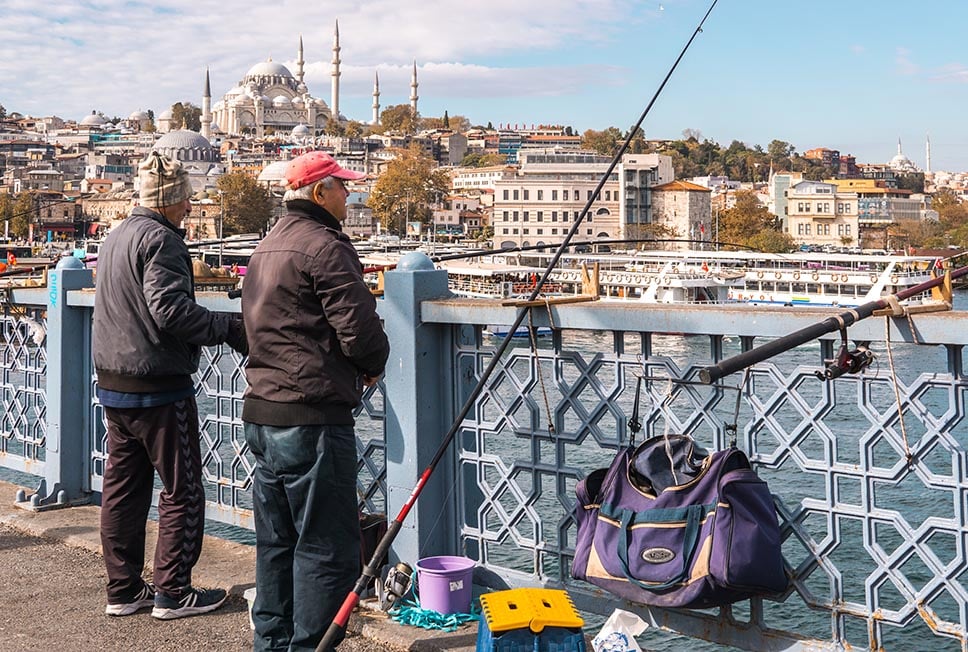
All of this being said, travelers should definitely take extra precautions if they’re planning on traveling to Turkey’s remote Southeastern region. This part of Turkey does suffer from some ethnic strife – specifically with the Kurds – and so getting around may be a problem. Turkey’s involvement with the Syrian War has also resulted in some spillover at the Turkish-Syrian border, which has lead to some escalating violence.
At the end of the day, I have no problem saying that Turkey is a safe place to travel to. Aside from the issues previously discussed, there’s still some petty crime, like pickpocketing, to be aware of. Be sure to have common sense and to practice all of the usual security measures – don’t exhibit overly expensive items, don’t whip out stacks of cash, and be mindful of scams.
Sex, Drugs, and Rock ‘n’ Roll in Turkey
Though the population of Turkey is primarily Muslim, the country is not, which means that alcohol is widely available and well priced. Most of the locals tend to share in the country’s progressive view of consumption as well and will partake (often) in drinking booze.
The best parties in Turkey will be found in Istanbul and around the beach resorts that dot the Turkish Riviera.
Istanbul is widely thought of as one of the top party destinations in the world and offers lots of opportunities to all types of partygoers. Popular nightlife neighborhoods in Istanbul include Beyoglu, Nisantasi, and Kadiköy. Beyoglu is the most famous of drinking districts in Istanbul and so attracts the largest crowds. Nisantasi is where more affluent folks like to enjoy overpriced spirits. Finally, Kadiköy is a local hangout spot and is usually the most laidback of the three.
Outside of Istanbul, the best parties are on the beach! Popular resort towns, like Bodrum and Fethiye, usually have the best parties. Regional hubs like Antalya and Izmir are sure to have their fair share of drinking holes as well.
Turkey’s national spirit is raki , an anise-flavored liquor that is usually drunk as a shot or mixed with water. Be careful when drinking this stuff – it’s quite potent and doesn’t get along with other spirits!
Due in part to its position as a crossroads, quite a lot of drugs pass in and out of Turkey on their way to other places. All of the usual suspects are here – coke, speed, weed, etc. – and nearly all of these substances are illegal. Should you be caught with any one of them you could face serious punishment. Should wish to partake anyway, I’ll give my usual advice: know where you are, who you’re buying from, and what you’re buying .
Travel Insurance for Turkey
Traveling without insurance would be risky so do consider getting good backpacker insurance sorted before you head off on an adventure.
ALWAYS sort out your backpacker insurance before your trip. There’s plenty to choose from in that department, but a good place to start is Safety Wing .
They offer month-to-month payments, no lock-in contracts, and require absolutely no itineraries: that’s the exact kind of insurance long-term travellers and digital nomads need.

SafetyWing is cheap, easy, and admin-free: just sign up lickety-split so you can get back to it!
Click the button below to learn more about SafetyWing’s setup or read our insider review for the full tasty scoop.
How to Get into Turkey
Though entering the country may be a slightly complicated process for some nationalities, getting around Turkey should pose little problem. Once inside, those backpacking Turkey will have a plethora of transportation options from flying to renting a car to grabbing a cheap and comfortable bus. Choose your preferred mode of transport and get going!
Entry Requirements for Turkey
Foreign nationals who wish to enter Turkey will fall under two categories:
- those who can enter visa-free
- those who must apply for a visa, which usually comes in the form of an eVisa.
What follows is a brief summary of these visas and the process of obtaining them. For a more detailed explanation, be sure to check the official Turkish website here . You can also refer to the map below for a more visual explanation.
A large number of nationalities can enter Turkey visa-free for a period ranging from 30 to 90 days. Most of these countries must still bring a passport while many only need to present a national ID card. For a list of countries that only need an ID or an expired passport, refer to this webpage .
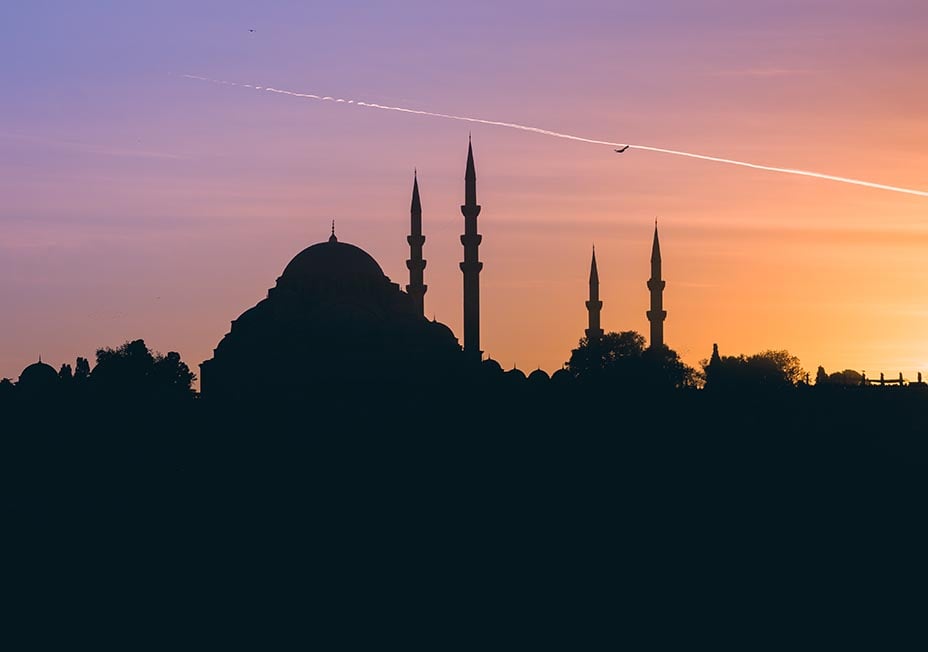
All remaining nationalities must qualify for a visa to enter Turkey. The overwhelming majority of these nations can obtain an eVisa upon arrival. eVisas range from 30 to 90 days. Some who qualify for an eVisa must meet certain additional criteria as well such as providing hotel reservations, outbound tickets, or an approved visa from a specific European country. Be sure to check the official Turkish website under “conditional visas” for more on this.
A limited number of countries must apply for a visa beforehand at their nearest Turkish consulate. Again, refer to official Turkish visa website to see if you’re country falls under this category.

Get 15% OFF when you book through our link — and support the site you love so dearly 😉
Booking.com is quickly becoming our go-to for accommodation. From cheap hostels to stylish homestays and nice hotels, they’ve got it all!
How to Get Around Turkey
Traveling within Turkey is super easy! Between the many bus, train, car rental, and airline companies, you will have plenty of ways of getting around this country. Most are very affordable as well!
Buses are the most convenient means of getting around Turkey. There are several bus companies and most of their fleets are modern and comfortable. Because there are so many bus companies with so many routes in Turkey, you should have little problem getting to where you need to go and paying little in the process.
When traveling to a remote location by bus, don’t surprise if an official asks you to transfer to another bus. Many Turkish companies “consolidate” passengers to save money. Be ready to jump on a minibus or dolmus as well if your destination is really out there.
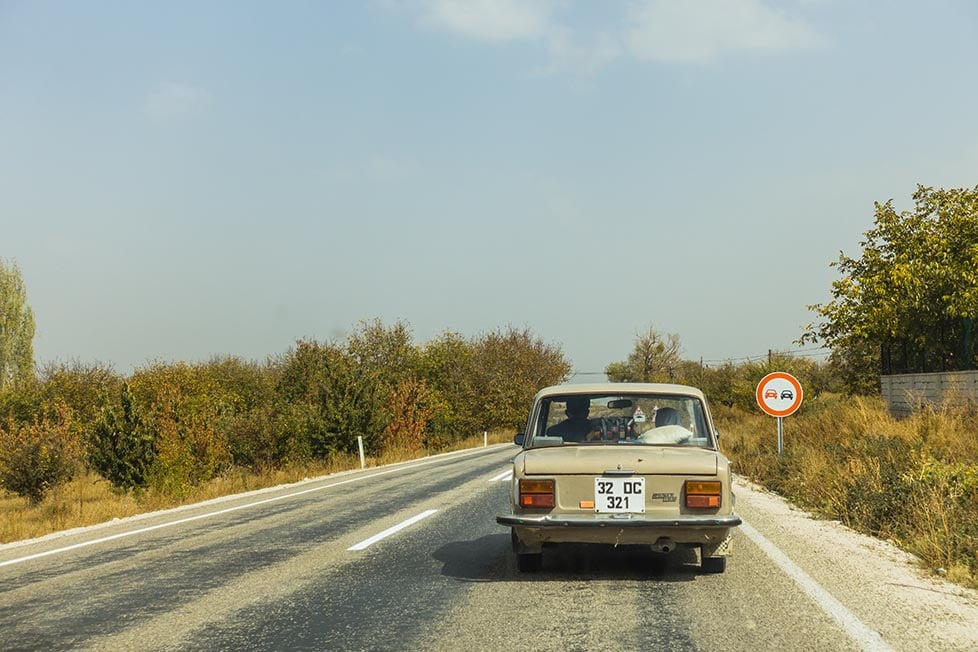
Train travel in Turkey is possible but the problem is that Turkey’s rail network is somewhat inefficient. Aside from a handful of streamlined rail routes, most trains will take a long time to arrive somewhere. Unless you’re really keen on riding the train, you’d be better off just sticking to the bus.
Flying can be just as convenient as taking a bus in Turkey. There are several budget airlines with routes all over Turkey. Pegasus Air and Onur Air are two popular low-cost airlines.
Should you need to travel long distances, flying may be a better option. Though slightly more expensive than traveling by land, the cost is still reasonably low and justifiable.
Renting a car could be an awesome idea while backpacking in Turkey! With your own vehicle, you will have greater freedom and the ability to go car camping as well.
Hitchhiking in Turkey
Hitchhiking is a very reasonable means of getting around Turkey! All of the usual practices apply and there’s nothing too out of the ordinary when throwing your thumb up in this country.
For the best chances of finding a ride, hang out on the outskirts and at the ring-roads that circle around the cities. Try not to hitchhike directly within a city as it’ll take a while to get out. Don’t hitchhike on the main highways as no one’s going to slow down. Having a sign is always a good idea to give drivers a sense of where you’re going.
Always be prepared when hitchhiking; as I like to say: “treat it like a wilderness experience.” Have plenty of water on you (especially in the summer high season) and snacks just in case. If you are marooned somewhere, you may have to find a place to sleep last second.
As always, there are some drivers you will ask for a little cash. If you don’t have any on you, politely refuse and ask to be let out.
Onwards Travel from Turkey
Being the epic crossroads that it is, there are many countries near Turkey to visit, should you decide to move one.
To the west of Turkey are Greece and Bulgaria . Entering either will be a painless affair. Choose one of several land crossings between the three countries or travel by sea via ferry to Greece! Most ferries traveling to Greece from Turkey take only a few hours and you’ll always end up on some idyllic island.
To the east are the Caucasus nations of Georgia , Azerbaijan, and Armenia . I personally suggest backpacking in Georgia, which is one of Europe’s last hidden gems! Turkey shares friendly relations with Georgia so crossing the border should pose little problem.
Turkey and Armenia, on the other hand, are not on good terms – there have been many conflicts between these two nations in recent years and, for this reason, the border between the two is currently closed .
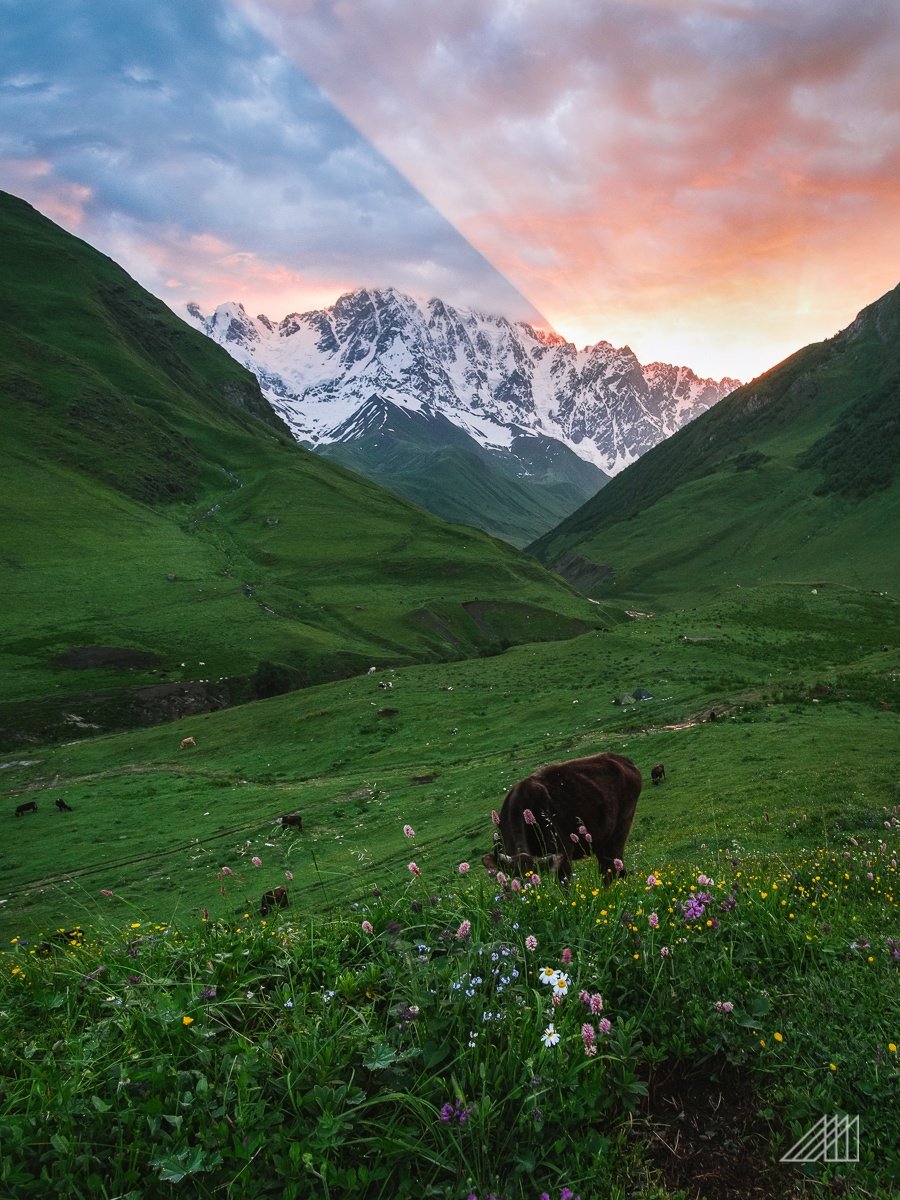
Note that entering into Azerbaijan puts you in the remote and contested Nakhchivan province, which isn’t connected to the rest of the country. From here, you can fly to the main body of Azerbaijan or cross into Iran.
To the south of Turkey are the Middle Eastern nations of Syria , Iraq , and Iran ; some of these countries will be very difficult to enter.
Though the Syrian-Turkish border is technically still open, traveling here is extremely ill advised – refugees are constantly spilling over the border and much violence has broken out as such.
Turkey shares several crossings with Iraq, though only one at Habur-Zakho is open to foreign tourists.
Traveling to Iran from Turkey is very doable as there is little strife between the two nations. Daily bus routes connect Turkey and Iran via several border crossings.
Working in Turkey
History, gorgeous landscapes, weekends at the beach, solid Wifi; sounds right up a digital nomads alley, right?
Yes, Turkey ticks a lot of the boxes for digital nomads in search of their next squat. The cost of living is relatively low and the standard of living is on par with Europe (in the cities).
In terms of visas, most digital nomads settle for the 90-day tourist ones. Whilst it is possible to apply for a temporary residency visa as a foreigner, the bureaucracy in Turkey is a bit of a headache.
Internet is easily found in Turkey and is fairly quick. Most cafes or lodges will have free WiFi for customers. If you find yourself in need of faster speeds, internet cafes are ubiquitous in Turkey, and most rent out computers for reasonable rates.
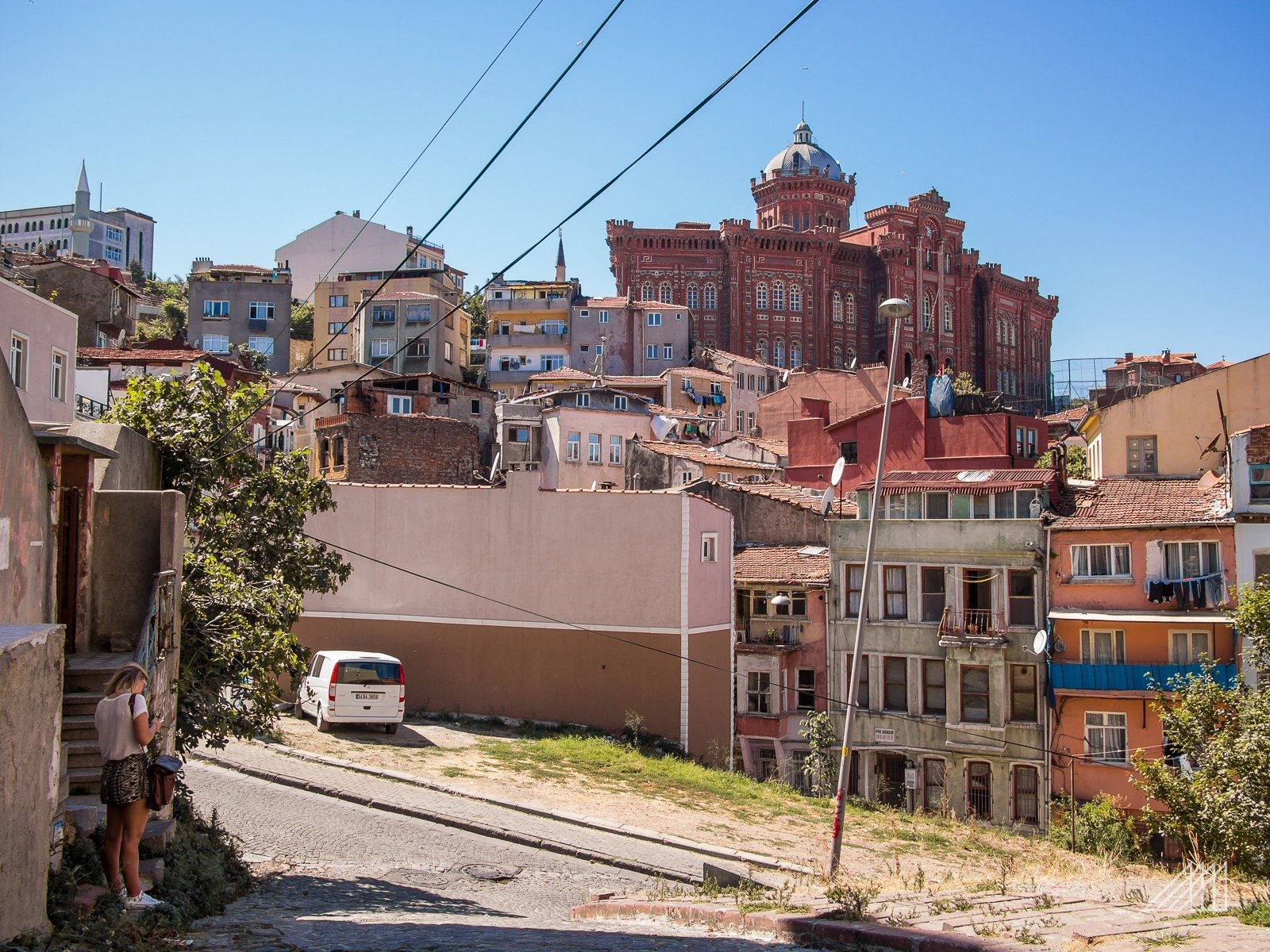
Consider buying a local SIM card with data coverage when backpacking around Turkey – data is sometimes more reliable and you may save some money. I bought a SIM card in Ataturk Airport and easily integrated with my phone (after some tinkering, of course).
If you haven’t broken into the digital nomad lifestyle yet (you still can!), there are other ways of prolonging your travels. One way is by volunteering .

A new country, a new contract, a new piece of plastic – booooring. Instead, buy an eSIM!
An eSIM works just like an app: you buy it, you download it, and BOOM! You’re connected the minute you land. It’s that easy.
Is your phone eSIM ready? Read about how e-Sims work or click below to see one of the top eSIM providers on the market and ditch the plastic .
Volunteering in Turkey
Volunteering abroad is an amazing way to experience a culture whilst giving something back. There are loads of different volunteer projects in Turkey ranging from teaching, to animal care, to agriculture to pretty much everything!
Turkey has developed a lot over the last few years, but still has very rural areas which can benefit from volunteers. You’ll find loads of opportunities in hostels, farming, and English teaching, among others. Note that you may require a work permit in order to volunteer in Turkey, and you’ll need to provide evidence that the work is unpaid.
Want to find some awesome volunteering opportunities in Turkey? Then signup for Worldpackers , a platform that connects local hosts with volunteer travelers. As a Broke Backpacker reader, you’ll also get a special discount of $10. Just use the discount code BROKEBACKPACKER and your membership is discounted from $49 a year to only $39.
Programs run through reputable work exchange programs , like Worldpackers, are generally very well-managed and highly reputable. However, whenever you are volunteering do stay vigilant especially when working with animals or children.
Teaching English in Turkey
If you’re a traveling English teacher, there are jobs to be found in Turkey. Granted, the wage is relatively low against the cost of living, especially if you’re working in Istanbul. You could of course work in the wilds of Anatolia but that would be a whole other level of culture shock.
Regardless, you’ll need a TEFL certificate to teach anywhere in Turkey. We suggest getting yours with MyTEFL as Broke Backpacker readers get a 50% discount on courses. Simply enter the code PACK50 when checking out.
For tips on how to score a gig, please read my in-depth report on teaching English abroad.
What to Eat in Turkey
Turkish food is some of the best that I’ve had while traveling the world! The flavors are rich and the dishes are very diverse. Carnivores, vegetarians, Muslims, everyone can enjoy Turkish food without struggling to find a dish that best suits them.
Because it sits at such a vital crossroads, Turkey has benefited from being exposed to multiple culinary traditions and a huge array of ingredients. Many cultures, from Arabic to Mediterranean to Balkan to Caucasian, have left their mark on Turkish cuisine. For these reasons, Turkish food is a sort of fusion of cooking styles.
The Turkish diet consists heavily of red meats, rice, and vegetables including tomatoes, eggplant, onions, and cucumbers. Spices are used liberally in almost every Turkish dish though they’re never overpowering. Pork is not very common considering the large Muslim population.
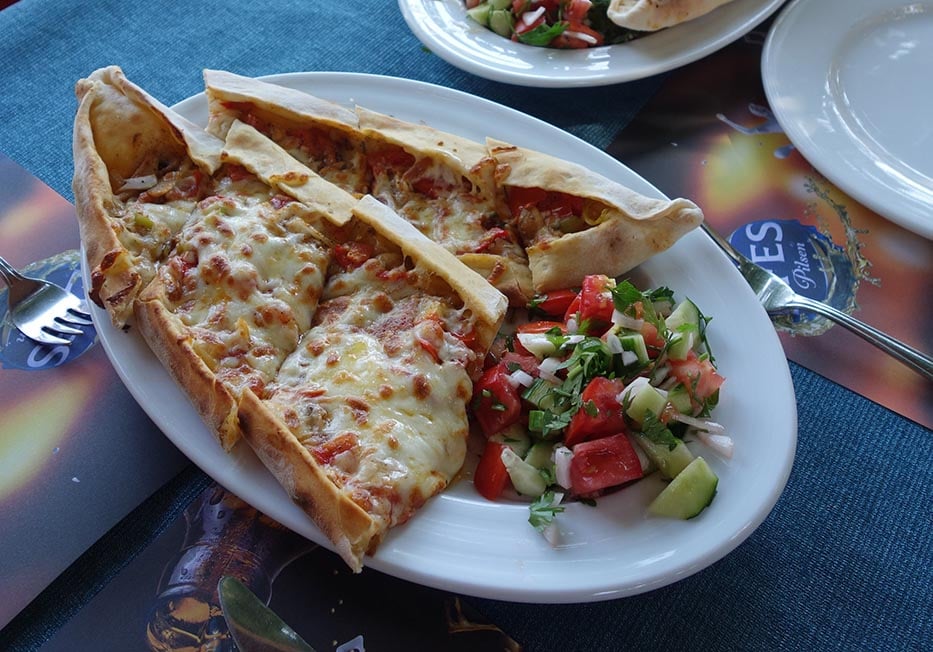
Note that, given its size, food varies greatly depending on what part of Turkey you’re in. The Western Turkish diet consists heavily of seafood, olive oil, and fresh herbs, and bears a great resemblance to other Mediterranean regimens. The regions around the Black Sea rely heavily upon seafood, as well as corn and more rustic vegetables like kale. The food of Southeastern Turkey is the most Levantine – here, you’ll find lots of kebabs and mezes.
You should no problem finding any type of Turkish cooking in larger cities, especially so in Istanbul. There’s a lot to choose from so I’ve created a list of the most famous foods in Turkey to try while visiting.
Popular Turkish Dishes
- Köfte – Turkish meatball
- Baklava – sweet pastry made w/ hazelnuts
- Dolmas – rice wrapped in grape leaves
- Mezze – large assortment of small appetizers
- Iskender Kebab – shaved meats
- Sis Kebab – skewered meats
- Lokum – “Turkish Delight:” gelatinous dessert
- Manti – Turkish ravioli
- Karniyarik – stuffed eggplant
- Börek – savory pastries
Turkish Culture
Turkish people are of a very distinct ethnicity that can be traced back thousands of years to the steppes of Asia. For much of the 2nd Millennium, the Turks were one of the dominant powers of the region and contributed quite a lot to human civilization. Perhaps because of this, Turkish people are very proud of their heritage.
Turks are a fairly accepting and open minded bunch that tend to observe foreign behavior optimistically. When someone comes into their country and behaves in a manner that is inappropriate – whether subtly or implicitly – Turkish people will usually forgive them for the digressions.
Regardless of their hospitality, it’s always a good idea to try your best and observe the local customs when backpacking through Turkey. Doing so will unlock many more opportunities and the locals will be much more receptive.

Religion and politics can be touchy subjects in Turkey, especially in regards to current events. Avoid as best you can topics pertaining to the Kurdish conflict , Cyprus, Russia, or, in particular, the Armenian Genocide.
Understand too that even though Turkey is a secular country, religion is an important part of their cultural identity. Islam was a major player in the rise of the Ottoman Empire and is seen in a similar light to national heroes. (Remember that that crescent moon and star is on the flag for a reason.) Tread lightly when discussing or criticizing religion in Turkey.
Turkish behavior and courtesy are somewhat broad but in no way demanding. Many common Western practices, like hand-shaking, eye contact, and physical contact, are present in the Turkish lifestyle. Knowing that whispering at a party or being late is considered rude may be beneficial though. For a great list of Turkish etiquettes, refer to this article here .
Turkish Travel Phrases
The official language of Turkey is Turkish . Turkish is its own language and, contrary to popular belief, has very few grammatical similarities with other Arabic or European languages. The language of Turkey is Altaic in origin, meaning that is actually more similar to some Central Asian ones.
The structure of the Turkish language is actually quite logical due in part to Ottoman’s successful attempt of standardizing it. The central Ottoman government wanted a uniform language, one that could be understood by the vast majority of the population and, at the same time, be resistant to foreign influence and vernacular. For these reasons, the rules of modern Turkish are very rigid and, thus, easy to understand (if you actually try to learn it).
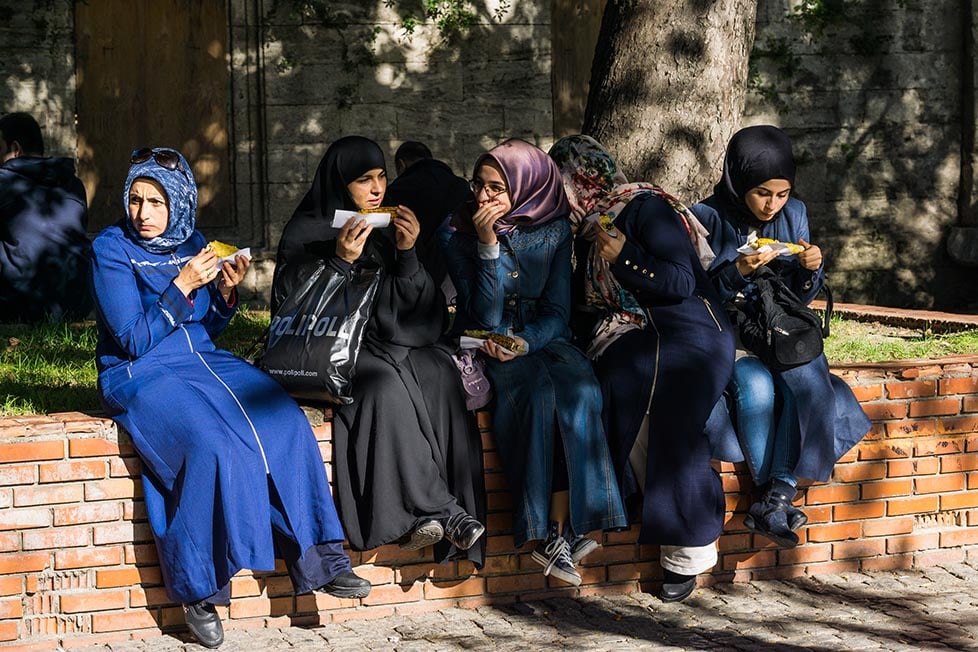
Kurdish is another prominent language found in Turkey though it’s mostly localized to the far Eastern edges where the Kurds live. Kurdish is an Indo-European language and very distinct from Turkish.
English, in addition to many other popular international languages, are becoming more common in Turkey. Most of the younger generations speak at least a moderate amount of English. Many other Turks who are in contact regularly with English speakers will know a little of the language as well. Due in part to Turkey’s economic and historical relationship with Germany, German is also widely spoken, in addition to Dutch and French .
Learning a few local expressions is always a good idea. So to make your life easier, I have written the pronunciations for a few helpful Turkish phrases with English translations.
- Merhaba – hello
- evet/Hayir – yes/no
- hos bulduk – it’s nice
- Hosçakal – goodbye
- Nasilsin – how are you?
- Ismim … – my name is…
- lutfen – please
- Plastik torba yok – No plastic bag
- Hiçbir saman lütfen – No straw please
- Hiçbir plastik çatal lütfen – No plastic cutlery please
- Buyurun – (multi-purpose word; used like bitte in German or prego in Italian)
- tesekkür ederim – thank you
- serefe – cheers
Books to Read While Traveling in Turkey
There are many great books about Turkey , but here are a few of our personal favourites:
- Memed, My Hawk – A young boy, abused and tortured in a small Anatolian village, escapes from his landlord and joins a group of brigands in order to enact revenge.
- The Architect’s Apprentice – An exceptional animal tamer joins the inner Ottoman courts and takes an apprenticeship under the Sultan’s top architect.
- The Time Regulation Institute – A surreal and somewhat dystopian commentary on the bureaucratic state of modern Turkey. Told from the perspective of Hayri Irdal as he interacts with the various characters that work at the Time Regulation Institute.
- My Name is Red – A group of artists get caught up in a mystery as the work that they are producing begins to cause trouble. Written by Orhan Pamuk, who is one of the most popular writers in Turkey.
- The Janissary Tree – The first novel in Jason Goodwin’s Investigator Yashim series. This is Sherlock Holmes in Ottoman Istanbul.
Brief History of Turkey
Throughout history, Turkey has been a very important place. It has either hosted some of the world’s most successful civilizations or itself been the dominant power of the region. To this day, Turkey still remains an influential and undeniable sovereignty.
Starting in antiquity, Turkey was the bridge that connected Europe and the Middle East. The Greeks, Romans, Byzantines, Persians, and other kingdoms all vied for control of this land, and each left their mark. Know that the peoples that gave rise to the modern Turkish gene pool had not even arrived at their current dominion yet.
The Turks were actually a part of the many invasions and migrations initiated by the steppe people of Central Asia. Hailing from the same regions as the Mongols and Huns, the Turks often followed in their steps. It wasn’t until the 11th century AD that the Turks were able to establish their own realm – the Suljek Kingdom – in Anatolia.
The Seljuks were decently successful as rulers, having contributed to the Muslim world in many ways. In the late 12th century though, the kingdom was destabilized by rival powers and eventually consumed by the Mongol Empire in the 13th century. From the wreckage of the Mongol invasion, came perhaps Turkey’s most triumvirate chapter.
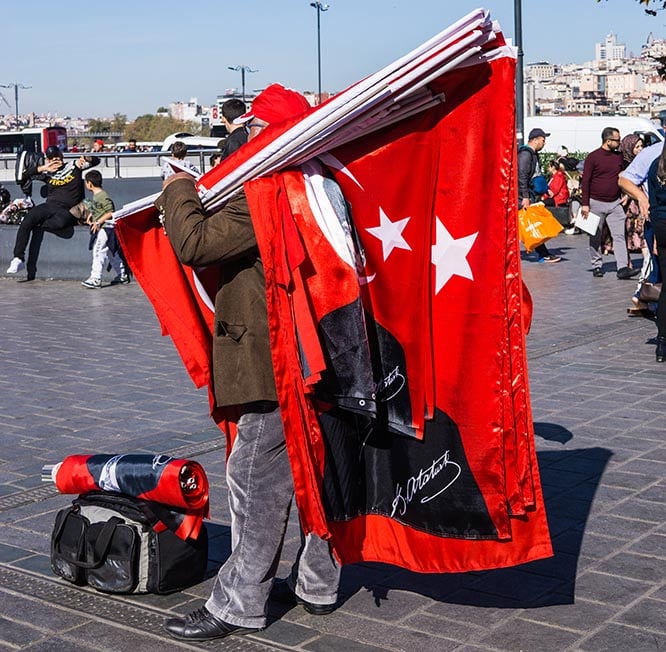
After Anatolia was partitioned by the Mongols, the Ottomans began to rise. Starting in the 14th century, the Ottomans were only a minor principality but soon conquered everything – the Byzantines, the Balkans, the Persians, the Syrians; everyone fell to the Ottomans. For 600 years, the Ottomans kicked ass. They contributed much to the world, though they took part in a fair share of crimes as well.
The Ottoman Empire collapsed following its defeat in World War I. The current state of Turkey, the Republic of Turkey, came about following the separation of the empire. Since then, Turkey has undergone many transitions: from monarchy to democracy, socialist to capitalist, and much, much more.
It hasn’t been easy for Turkey, especially in recent years with political oppression and upheaval becoming the norm. The Turkish people have a voice though and it’s never been stronger. Many fight back against the powers that threaten them. Only time will tell if this is enough.
Unique Experiences in Turkey

Things go wrong on the road ALL THE TIME. Be prepared for what life throws at you.
Buy an AMK Travel Medical Kit before you head out on your next adventure – don’t be daft!
Visiting a Turkish Bath
Turkish baths or hamams are not just spas; they’re a way of life for many. More than a means to clean oneself, hamams are a great place for Turkish people discuss their daily lives as well get in touch with their roots. If you’re backpacking in Turkey, you need to visit a hamam at least once if only to see why these have become so ingrained in the culture.
When visiting a Turkish bath, there are a couple of etiquettes:
Firstly, there’s absolutely no mixing of the genders – men and women are segregated.
Second, it’s usually traditional to wear nothing but a pestamal, a sarong-like towel that you wrap around your waist. Women may wear underwear under these while men are nude. Men: the occasional dick slip is ok but try not to wave that thing around.
Thirdly, be sure to tip your attendant and don’t ask for lewd services.
The process of a Turkish bath usually involves moving between hot and cold rooms. Unlike saunas, hamams don’t rely upon moist heat but instead dry heat. You’ll need to loosen up a bit in the hot room and sweat a little before the washing begins. Take note of the elegant architecture while waiting.
There are two ways of being washed: 1) by yourself and 2) by an attendant. If you choose option 1, then you’ll be given the usual devices and sent on your way. This choice is obviously the cheapest.
If you choose option 2, then you will be met by a masseuse about 15 minutes after you enter the hot room whereupon they will begin the treatment. Be fair warned: Turkish massages can be quite painful as the masseuse will contort your body in many ways.
Trekking in Turkey
Trekking is one of the most underappreciated activities in Turkey! This country offers a myriad of hiking options from coastal walks to mountain climbs to wilderness backpacking trips to Turkey. Honestly, there is a surprisingly amount of variety of trekking in Turkey.
Most people just think of Cappadocia when they plan on going trekking in Turkey. Few realize that are some truly stunning landscapes to explore throughout the remainder of Turkey.
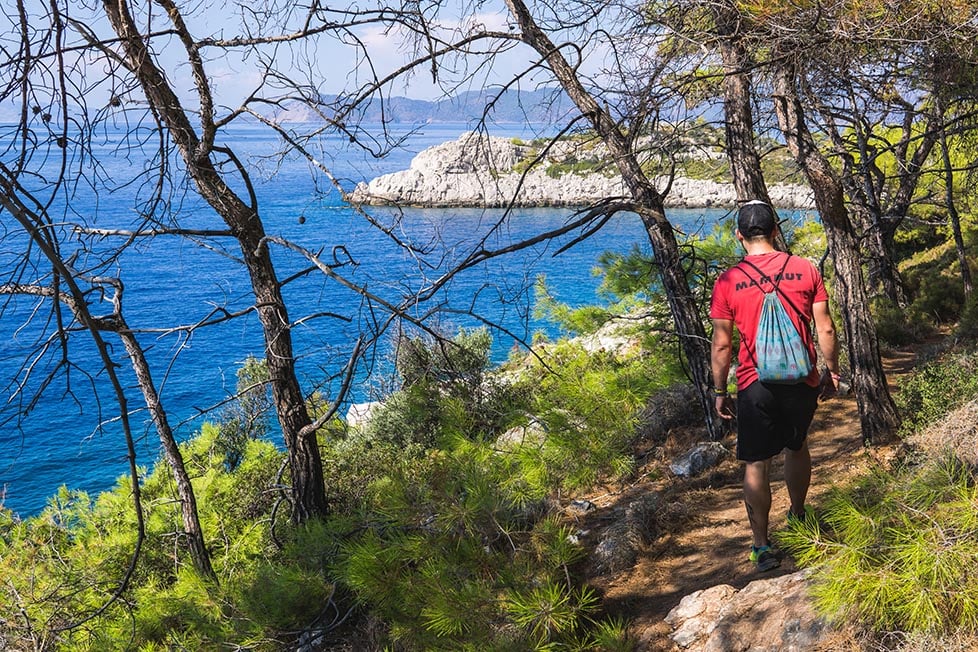
If you plan on venturing out into the wilder parts of Turkey, then I suggest buying all of the necessary camping gear. You’ll save some money that way and avoid paying for rentals via tour operators. Be sure to bring plenty of water as well – Turkey can get really, really hot.
Below is a list of some of Turkey’s best hiking areas.
The Best Treks in Turkey
- The Lycian Way (30 days, 335 miles) – One of the all-time classic hikes in Turkey. Walk from Ölüdeniz to Antalya along the coastline, discovering hidden villages and ruins along the way. Includes an ascension of Mt Olympos. Don’t walk this during the peak summer heats.
- The St. Paul Trail (30 days, 310 miles) – Second most popular long-distance trail in Turkey. Follows the path of Saint Paul the Apostle from Perge to Yalvaç. Passes through some spectacular scenery including the imposing Taurus Mountains and the “Lakes District” around Egirdir. Don’t walk this during the peak summer heats.
- The Kaçkar Mountains (varies) – Turkey’s very own “Middle Earth.” These mountains, located in the east of Turkey, are strikingly beautiful and surprisingly lush. The alpine lakes and meadows here are far-cry from the arid landscapes that most people expect when backpacking Turkey.
- The Aladaglar Mountains (varies) – A remote section of the Taurus Mountains. Extremely rugged and somewhat inhospitable.
- Climbing Mt Ararat (5-7 days) – Long but fairly straight forward climb that only requires proper knowledge of ice axes and crampons. At 16,850 ft high though, acclimation will be necessary though.
Final Advice Before Visiting Turkey
Don’t let the stories of civil unrest and terrorism dissuade you from visiting Turkey. This is one of the coolest nations in the world and an extremely enjoyable place to go backpacking.
In my experience, Turkish people rank pretty high up on the hospitality scale. They cater to everyone’s needs and usually stop at nothing to appease their guests. When you go backpacking in Turkey, expect to pampered, even obsessed over sometimes by the locals.
Turkey has everything that a traveler could want: culture, majesty, history, cuisine, and much more. The best part is that everything is also so damn affordable! No trip to Europe, the Middle East, the Caucasus or any neighboring region is complete without at least dropping by for a trip to Turkey.
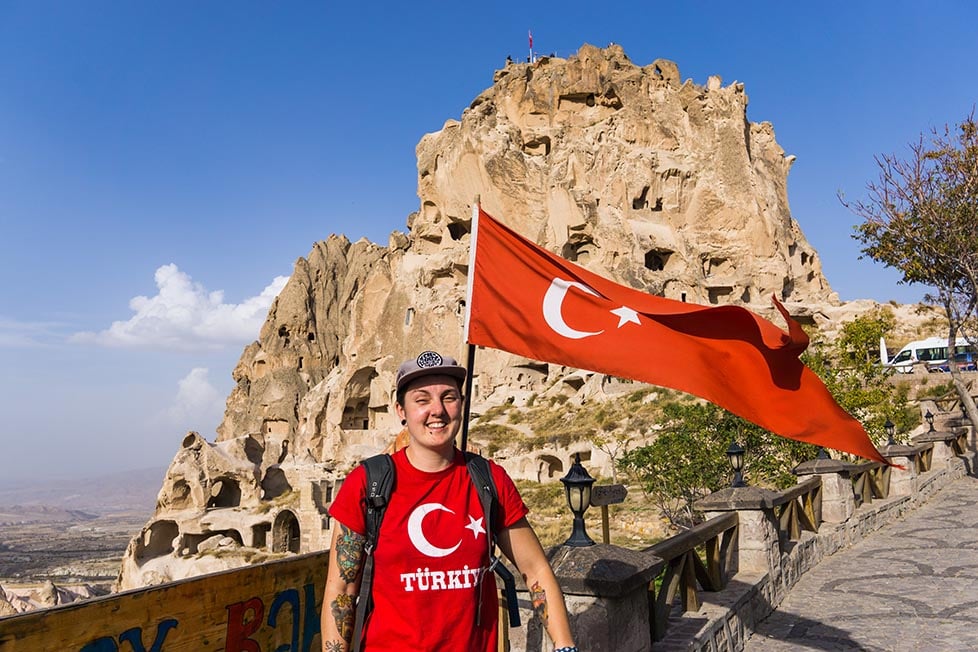
Because of its size and number of activities, backpacking Turkey can be an intimidating endeavor – doing so can be a very enriching experience though. You’ll eat some of the best food ever , walk through the ruins of many civilizations, and have the chance to explore landscapes that you didn’t think were possible.
Just follow the travel tips for Turkey that have been outlined in this guide, my fellow broke backpackers, and you’ll no doubt have a good time in this fascinating country.
- Where to stay in Turkey
- The best hostels in Turkey
- Beautiful places to visit in Turkey
- Istanbul travel guide
Updated April 2023

Will Hatton
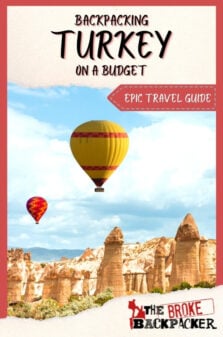
Share or save this post

Interested in recommendations for Christmas / New Year, looking for cool vibes/ party . Flying into Antalya on Christmas Eve.
Hey Will, just wanted to thank you for all the time and effort you put in this post. Its incredibly complete (Its the first time I visit your site, I’ll check now wich more places you explored!), and you can tell you put your soul on it to actually make it easier for us to plan our trip. Im going to Turkey in a few weeks for 18 days and Im overly excited about all the things Ill discover there and reading you is helping me to structure the trip without too much hasle. We are usually too lazy to stop by and say thank you, but Im sure this post helped A LOT of people out there, so again: MUCHAS GRACIAS!! 🙂
Welcome buddy! 🙂
Well narrated about the fascinated cultured country. It really gives deep insights. Your way of presenting article makes me more inspiring. Especially the collection of photographs are very nice. Article is very help full for who visits turky first time.
Thanks for this post. Recently spent 3 weeks in Turkey and used so many of your tips, especially around Cappadocia the coast line.
How about going to Istanbul (and other places) in December for 6 days?
We are a french couple and we have been hiking and hitchhiking in Turkey in July 2018 and we definitely agree with this article. Turkish are really helpful and hospitable people and they do have many gorgeous places to visit.
To read more about our experience in French, you can checkout our article : http://www.apprentis-vagabonds.fr/2018/08/01/la-turquie-guides-par-la-mer-noire/
Go in turkey and enjoy 🙂
Leave a Reply Cancel reply
Your email address will not be published. Required fields are marked *
Save my name, email, and website in this browser for the next time I comment.
Notify me of followup comments via e-mail.
What is in the 2024 federal budget for age pensioners?
The 2024 federal budget has been handed down, with Treasurer Jim Chalmers spruiking cost-of-living relief measures.
Here's what the budget means for seniors on the age pension.
What's in the budget for pensioners?
In his speech, Mr Chalmers made few mentions of pensioners.
He didn't call out any budget measures that were specifically for people on the age pension.
However, here are three key items that could have an impact:
Deeming freeze
There will be a freeze on social security deeming rates for another financial year — that's just extending a freeze that was already in effect.
Explain deeming rates to me
You might remember that both parties pledged to halt deeming rates back in 2022 as they were heading into the federal election.
Mr Chalmers said this extension of the freeze would benefit 450,000 aged pensioners.
But this is something that will only benefit pensioners who get income from deemed financial investments.
There will also be a freeze on the cost of medications on the Pharmaceutical Benefits Scheme (PBS) for the next five years.
So that means that medications will continue to cost $7.70.
Changing Medicare levy thresholds
The government will increase the Medicare levy low-income thresholds.
The goal of this is to ensure "low-income individuals continue to be exempt from paying the Medicare levy or pay a reduced levy rate," the budget papers say .
For single seniors and pensioners, the threshold has been increased from $38,365 to $41,089 The family threshold for seniors and pensioners has been increased from $53,406 to $57,198
But they're only being increased to keep up with inflation — not as a major policy change.
Is there a special payment for pensioners?
No, there was no announcement about a specific payment for pensioners.
Pensioners will benefit from a $300 reduction in power bills, but this is something every household will get.
The energy rebates are not payments — they'll be deducted from power bills.
And keep in mind that they'll be applied in quarterly instalments, not all in one hit.
So your next quarterly power bill will likely be $75 cheaper, not $300 cheaper.
Will the age pension be increased?
There was no announcement about increasing the age pension.
Pensions are typically increased twice a year to reflect changes in pensioners' costs of living and wage increases.
The last increase was in March , when age pensions were increased by $19.60 a fortnight for singles and $29.40 a fortnight for couples.
What is deeming?
It's part of the income test for Centrelink payments, including the age pension.
Deeming is a set of rules the government uses to work out how much income people earn from their financial assets — things like shares, superannuation and bank accounts.
It assumes people receive a set income from the interest on those investments, whether they actually get that much or not.
But here's the kicker: if your investment return is higher than the deemed rate, the government doesn't count that extra money as part of your income.
That means anything you earn above that rate isn't counted in the income test for the age pension.
So, the lower the deeming rate, the more people can earn from their investments without it affecting their pension payments.
Editor's note (15/05/2024): An earlier version of this story incorrectly stated that pensions are typically increased four times a year. Pensions are indexed twice a year — in March and September. The article has been updated to reflect this.
Take me back to the top of the article
- X (formerly Twitter)
Related Stories
Every household to get $300 credit for energy bills as government vows move will reduce inflation.
Stage 3 tax cut changes come into effect on July 1. Use our calculator to see how much you'll save
Much of Chalmers's success will rest on just one budget measure that economists will hate
- Cost of Living
- Search Please fill out this field.
- Manage Your Subscription
- Give a Gift Subscription
- Newsletters
- Sweepstakes
- Budget Travel
How to Plan a Trip to Italy on a Budget, According to a Local
A dream vacation to "il bel paese" doesn’t have to break the bank.
Laura Itzkowitz is a freelance writer and editor based in Rome. She has been contributing to Travel + Leisure since 2014, when she started as a fact checker before becoming a contributing digital editor in 2015 and going freelance in 2016. She has also held positions as a contributing editor at The Points Guy and the NYC cities editor at DuJour Magazine. In addition to Travel + Leisure , her writing has appeared in Architectural Digest , Surface Magazine , Brooklyn Magazine , T Magazine , The Wall Street Journal , Vogue, GQ, Departures, Afar, Fodor's, Town & Country , Condé Nast Traveler , Robb Report , Hemispheres, and others. When she's not jetsetting around Italy and beyond, she can be found in Rome, enjoying some cacio e pepe or relaxing at home with her husband and two dogs. Originally from the Boston area, Laura moved to New York City in 2011 to pursue a master's degree in creative writing and translation at Columbia University. She also holds a bachelor's degree in French from Smith College. * 10+ years of experience writing and editing * Co-wrote "New York: Hidden Bars & Restaurants," an award-winning guide to New York City's speakeasy scene published by Jonglez Editions in 2015 * Contributed to "Fodor's Brooklyn," published by Penguin Random House in 2015, which won silver in the Lowell Thomas Travel Journalism competition * Contributed an essay to "Epic Hikes of Europe," published by Lonely Planet in 2021 * Updated the 2022 edition of "Fodor's Essential Italy"
:max_bytes(150000):strip_icc():format(webp)/Laura-Itzkowitz-7768a0f140c54a79a100af7f9a83e829.jpg)
Planning Your Trip
How to save money on flights, how to find an affordable hotel, transportation in italy, eating on a budget, free and low-cost activities, more money-saving tips.
Evgeniya Vlasova/Travel + Leisure
For many, visiting Italy is a dream trip — one that’s worth saving up for. There are certainly plenty of glamorous resorts, Michelin-starred restaurants, and exclusive experiences that you might want to splurge on, but a trip to Italy doesn’t have to break the bank. In fact, according to Numbeo , the cost of living is, on average, 19.8 percent lower in Italy than in the U.S.
I’ve been living in Rome for nearly five years and visited Italy many times before that, so I’ve found some strategies for traveling around the country without overspending. Here's how to plan a trip to Italy on a budget.
Want to visit Italy in the summer? So does everyone else — and increased demand drives up the prices on flights, hotels, and even tours. If you want to save some money, plan your trip for the low season (November through March), when you’ll find better rates and fewer crowds. Just keep in mind that while cities like Rome, Florence, Venice, and Milan are year-round destinations, coastal destinations like the Amalfi Coast all but shut down in the winter.
It’s a good idea to start planning your trip to Italy about three to six months in advance, or even longer if you’re planning a trip in the high season and want to be sure you’ll have plenty of options. According to Attilia Avino, who together with her sister Mariella runs Palazzo Avino , a member of the Leading Hotels of the World on the Amalfi Coast, they’re already getting bookings for 2025.
Daniel Gorostieta/Travel + Leisure
There’s no denying that flights are more expensive now than they were in the past — and flights to Italy are no exception. According to Priceline , the average cost of a round-trip flight to Rome in May 2024 is $1,183, while in May 2023 it was $977. That’s an increase of 21 percent in the span of a year.
“The two months with by far the highest number of cheap flights to Italy are January and February,” Scott Keyes, founder and chief flight officer of Going.com , told Travel + Leisure . “Aside from winter travel, shoulder season (March through May and September through November) is known for cheap Italy deals,” he said.
When looking for ways to save money on flights to Italy, it’s important to be flexible. Try using the “anywhere” feature on Google Flights to compare flight costs to different cities in Italy. If, for example, you want to visit Rome but find that the cheapest flight is to Florence, you could save hundreds of dollars by flying to Florence and then taking the train to Rome.
Amanda Blackard/Travel + Leisure
According to Priceline, the average price of a hotel room in Rome rose from $180 in spring 2023 to $301 in May 2024 (that’s a whopping 67 percent increase), but there are still deals to be found. Accommodations in Italy run the gamut from historic grand dames with white glove service to spartan bed-and-breakfasts or hostels with shared dorms. And in many Italian cities, monasteries run guest houses that offer affordable rooms but might have a curfew. Sites like Booking.com will give you plenty of options that will likely fit your budget.
If you want to stay in the countryside, consider booking a room at an agriturismo . The word comes from " agri" for agriculture and " turismo" for tourism, so staying at one is essentially a form of agricultural tourism. Some have working farms that provide fresh fruit and vegetables and produce cheese or charcuterie, which they serve at their restaurant or sell at local markets. Better yet, they’re often more affordable than hotels or resorts.
Airbnb is an obvious choice, but it isn’t always more affordable than staying at a hotel, especially in in-demand neighborhoods in major cities like Rome, Florence, and Venice. It’s a good idea to compare the prices of Airbnbs with budget hotels or hostels when deciding where to stay. And consider that accommodations in neighborhoods outside the historic center will usually cost less than staying near the major monuments.
Michela Sieman/Travel + Leisure
Italy has an extensive network of trains and buses that transport people around the country, and most cities have public transit (metros, buses, and/or trams) to move around within them. The key to saving money when traveling between cities is figuring out which train you need to book and booking it at the right time.
High-speed trains like the Frecciarossa travel at speeds up to 300 kilometers per hour. From Rome, you can be in Naples in 70 minutes, Florence in 90 minutes, Milan in three hours, and Venice in four hours. Tickets on the high-speed trains should be booked in advance because the longer you wait to book, the higher the price will rise. There are also intercity trains and regional trains, which cost less but take longer than high-speed trains. If you want to visit small cities such as Parma or Tropea, you might need to transfer from a high-speed train to a slower intercity or regional train. Use Trenitalia.com or Italiarail.com to search for and book the best train routes.
To get around cities like Rome, Milan, and Bologna, the metro is often the cheapest and fastest way to go. In Rome, for example, a single ticket costs €1.50 and is valid on the metro, buses, and trams for 100 minutes. (The price is set to rise to €2 in July.) For €7, you can buy a 24-hour pass that grants you unlimited rides. Tickets can be purchased at ticket booths in some metro stations, at the automatic machines in all metro stations, or at a tabaccaio (look for a sign with the letter T) or at some newsstands. You can use Google Maps to plan your route or download the app Moovit , which has updated information about metro, bus, and tram lines and will warn you about service changes and strikes.
In Venice, the vaporetto is the name for the public water buses that ply the Grand Canal and ferry passengers to the outer islands — and they are significantly cheaper than taking a water taxi. If you just want to cross the Grand Canal, look for the gondola traghetto . These gondolas operate in points where there isn’t a bridge nearby — like between Piazza San Marco and Punta della Dogana — and cost €2 to ride.
Eating out in Italy can put a dent in your wallet, but it doesn’t have to. There are many different types of restaurants in Italy , ranging from casual take-out spots to fine dining restaurants with elaborate tasting menus. According to Numbeo , the average cost of a three-course meal for two people at a mid-range restaurant in Italy is €60, while the average cost of a meal at an inexpensive restaurant is €15.
When I want to sit down for a casual meal of local specialties with affordable prices, I book a table at a trattoria or an osteria . Eating at a pizzeria is also a good option that’s usually more affordable than eating at a restaurant. Sit-down pizzerias are usually only open for dinner, but sometimes I like to get pizza al taglio (by the slice) for a quick lunch. Popping into a friggitoria (a place that specializes in fried food) is also a good option for a quick bite. And most bars have a selection of pastries and sandwiches.
To save a bit of money, join the locals eating and drinking their espresso standing up at the bar counter instead of sitting down and getting table service. In my experience, an espresso taken standing at a bar usually costs around €1.20, while a cappuccino and cornetto might cost €3 or €4.
Visiting museums, archeological sites, and other cultural attractions in Italy is generally quite affordable. Tickets sometimes cost just a few euros or at most about €25. For popular attractions like the Colosseum, Vatican Museums, and Galleria Borghese in Rome, the Uffizi Galleries and Pitti Palace in Florence, and the Doge’s Palace and Galleria dell’Accademia in Venice, it’s best to book tickets in advance. At the Colosseum, for example, tickets might sell out, forcing you to fork over a lot more money to join a guided tour. If you want to save money, book a basic entry ticket in advance and listen to one of Rick Steve’s free audio tours .
State-run museums throughout Italy are free on the first Sunday of every month and on some holidays, like the Festa della Liberazione (Liberation Day) on April 25, but in some cases, you’ll still need to book tickets online in advance.
There are also lots of things to do in Italy that are totally free all year. Most churches are free to enter — and some of the most incredible Renaissance and Baroque art you’ll see in Italy is inside them. I have found that Italy’s churches can also be a cool, quiet place to rest my feet if I’ve been walking around for hours. Public parks such as Villa Borghese in Rome are also free. And of course, strolling around and simply admiring the beautiful piazzas, fountains, and monuments doesn’t cost a cent.
If you’re visiting Italy in the summer, you’ll probably want to soak up the sun on the beach, but prices at the beach clubs range wildly from about €15 to upwards of €100 for a sunbed and umbrella — not including food and drinks. While prices tend to be higher in touristy areas like Capri, Positano, the Italian Riviera, and the Costa Smeralda, you don’t have to fork over a fortune to enjoy the beach. Instead seek out free public beaches (called spiaggia libera ) — just make sure to bring your own towel.
You might also want to consider visiting secondary cities, such as Parma, Modena, Siena, Perugia, Orvieto, Tropea, and Lecce, where accommodations, experiences, and even meals are often less expensive than in major cities.
Related Articles

IMAGES
VIDEO
COMMENTS
2. Score free transport! Number two in my budget backpacking tips for beginners is to get your ass on the (side of the) road and start hitchhiking; you can travel huge distances for free - it's easy. Even in a cheap country like India, a bus from Delhi to Manali will set you back at least $20 if you want air-con.
The Appalachian Trail Conservancy estimates that a new set of backpacking gear runs $1,200 to $2,000 or more, and for a thru-hike, that's on top of an average of $1,200 per month in trip expenses. Most respondents to our 2023 Appalachian Trail thru-hiker survey reported spending between $1,000 and $3,000 on gear. So many gear choices….
The adjustable one-size-fits-all packs in this review are the Osprey Rook 65, Teton Sports Scout 3400, Decathlon Forclaz MT500 Air 50+10, Mountainsmith Scream 55, and High Sierra Pathway 2.0 60L. These packs have a sliding or Velcro adjustment system that allows you to change the pack to fit a range of torso sizes.
Bolivia - the cheapest backpacking country in South America. Bolivia is one of the cheapest backpacking destinations in the world and is very popular with adventurers. Here, it is possible to get a 3-course meal for less than $2. Accommodation in a hostel dorm room costs between $8-$12 a night, and local and long-distance buses are a cheap ...
Decathlon Forclaz Women's MT500 Air 45 + 10 Backpacking Pack. Decathlon. A fan of Decathlon's affordable camping products, CNN Underscored contributor Heather Balogh Rochfort says that the ...
Backpacking Pack. The REI Co-op Trailmade 60 is a solid budget backpacking pack that offers a great combination of functionality, durability, and affordability. This pack has a streamlined design with plenty of pockets and compartments for storing all of your gear and includes a built-in rain cover, making it perfect for all-weather adventures.
Here are two of my favorite ways to break down the cost barrier when it comes to gear: 1. Rent, Borrow, or Buy Used Gear. Instead of splurging on brand-new gear, consider renting, borrowing from friends, or buying used equipment. Many outdoor retailers offer rental services for essentials like backpacks and tents.
Kelty Cosmic 20 Synthetic. At less than 3 pounds, this synthetic fill sleeping bag is a steal at just over $100. Any bags we found around this price range were at or over 5 pounds (!!) which might work for car camping, but is very heavy for backpacking. SHOP NOW.
19. While You're at it, Make Your Own Stove. We prefer to use canister stoves for our backpacking trips. They're quicker, easier to use, and offer more control over the flame size. However, if you're really trying to hit the trail on the cheap, you can make an alcohol stove out of a standard 12 oz. soda can.
Typical backpacking packs range from 50 to 70 liters. If you're a light packer, you might be able to make a weeklong trip in a 50-liter pack. If you're going on a one-night trip but you want to bring all of your warmest gear, a bulky camera, and a hefty book, then you might need a little bigger pack.
Our top recommendations for backpacking Europe are the Czech Republic and Hungary (in Central Europe), Romania, Bulgaria, Slovakia, Albania and Georgia. 7. India. A room costs on average $2 - $5 and a street food meal from $1 - $3, if you eat veg options. Transportation can be a little more expensive, but still relatively cheap, especially ...
Backpacking Stove: GSI Glacier Camp Stove ($30) There's nothing quite like a hot meal at the end of a long day on the trail, which is why most backpackers carry a compact camp stove. Feature-rich models can cost upwards of $150, but our budget option here is the GSI Glacier Camp Stove, which retails for just $30.
1. SwissGear 1900 (click for more details) See on Amazon.com. A cheap backpack for everyone traveling with a laptop. As well as for those, who like to keep things as organized as possible. One of my personal favorites among the best cheap travel backpacks. Being 37 liters big, the SwissGear 1900 is an average-sized backpack.
They are great for budget-conscious hikers on multi-day trips and are designed to haul big loads. So here is the list of top budget-friendly packs that will help you carry heavy loads and organize your gear for your next big trip. 1. REI Co-op Trailmade. Weight: 3 lbs. 6 oz. Gear Capacity: 60L. Fabric: Recycled nylon.
Here's a high-level look at our list of the best budget backpacking packs this year: REI Co-op Flash 55 - TWE Recommendation #1. Mountaintop - Adventure 55 Liter. Teton Sports Scout 3400. REI Co-Op Trailmade 60. Kelty Coyote 65 - TWE Recommendation # 2. Mountain Warehouse Carrion 65 Liter. Amazon Basics 75 Liter.
Cheap 10-lb Budget Backpacking Gear Kit for $500. Quality backpacking gear has a reputation for being pricey, but I'm here to show you that it's entirely possible to put together an affordable ultralight setup on a $500 budget. That's right; you can get your hands on a brand-new backpacking gear kit with a 10-pound base weight without ...
Best Backpacking Backpack for Carrying 35+ lb.: Osprey Atmos AG 65 - Men's / Aura AG 65 - Women's ($340) Jump to Review. Lightweight Backpack with the Best Ventilation: Osprey Exos 58 - Men's / Eja 58 - Women's ($260) Jump to Review. Most Comfortable Ultralight Backpack: Gossamer Gear Mariposa 60 ($285) Jump to Review.
Best travel backpack overall: Cotopaxi Allpa ($200) Best budget travel backpack: Ebags Mother Lode ($100) Most organized travel backpack for one-bag trips: Tortuga Outbreaker ($350) Best travel backpack for photographers: Peak Design Travel Backpack ($300)
Best Overall Budget Backpacking Tent 1. REI Co-op Trail Hut 2 ($229) Packaged weight: 5 lb. 15 oz. Floor dimensions: 88 x 52 in. Capacity: 2P What we like: All the tent that most backpackers need for just $229. What we don't: You can spend up for more interior space and a lighter, more packable design. REI Co-op's in-house brand offers great bang for your buck, and their lineup of ...
1. Plan Your Route Wisely. Efficient route planning is a cornerstone of budget backpacking in Europe. You can minimize travel distances and costs by focusing on regions where countries are ...
Backpacking in the Dominican Republic offers an unparalleled opportunity to experience the Caribbean's beauty, culture, and adventure on a budget. With its diverse landscapes, rich history, and ...
Central America, a land bridging North and South America, is a paradise for backpackers seeking adventure on a budget. This guide offers an in-depth look at 12 must-visit destinations, each ...
Cost-conscious airlines are not always a good deal after you weigh luggage fees and the price of getting to remote airports. Advice by Sofia Andrade. Features intern. May 15, 2024 at 12:17 p.m ...
Spacious budget tent: Mountainsmith Morrison 2 ($200) Roomy budget tent with a simple design: ALPS Mountaineering Lynx 2 ($150) Budget tent with a good balance of price, weight & interior space: Marmot Catalyst 2P ($229) Durable budget tent with ample headroom: North Face Stormbreak 2 ($185)
Lucas Venner entered his 20s with a common ambition: to travel the world. He has succeeded by hitchhiking the entire way. The Frenchman left his home country in early 2023 to embark on a 15-month ...
The ULTIMATE backpacking Turkey travel guide t help you plan your low budget adventure throughout the country! ... Backpacking in Turkey on a budget is very doable these days. Backpackers could easily get by on $25-$40 per day with decent spending habits. ... there are jobs to be found in Turkey. Granted, the wage is relatively low against the ...
The goal of this is to ensure "low-income individuals continue to be exempt from paying the Medicare levy or pay a reduced levy rate," the budget papers say . For single seniors and pensioners ...
Use Trenitalia.com or Italiarail.com to search for and book the best train routes. To get around cities like Rome, Milan, and Bologna, the metro is often the cheapest and fastest way to go. In ...